Jim – Botched go-arounds Cape Winelands – Big Plans
Mission Aviation Fellowship: A Pilot’s Long Journey
Commercial Aviation
FLIGHT TEST: VL-3
Aero Expo Germany – Full Report
John Bassi – Listen to your Engine Guy – CAA messes with ‘Conversions’

FlightCm
ican
Afr
Edition 326 May 2023 Cover: Garth Calitz
EVOLUTION –
RAND AIRPORT AVIATION COMPANIES GUIDE
HOW ITS EVOLVED!
DESIGNED FOR THOSE WHO REFUSE TO TRAVEL LIGHT
Big things should be expected from such a big door. The PC-12 NGX is the only single-engine turboprop to provide a pallet-sized cargo door as standard. So, when packing for your next trip in the PC-12 NGX, you won’t have to choose between which pair of shoes to bring. Bring them all. You may even decide to bring your favourite surfboard, motorbike, or mountain bike. Yes, we’ve carried them all, and so can you in the PC-12 NGX.

pilatus-aircraft.com
Contact Pilatus PC-12 Centre Southern Africa, your nearest Authorised Pilatus PC-12 NGX Sales Centre for further information on Tel: +27 11 383 0800, Cell +27 82 511 7312 or Email: aircraftsales@pilatuscentre.co.za
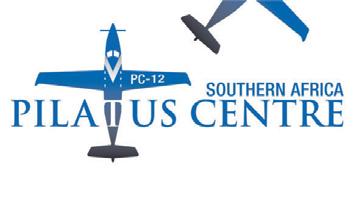
p

















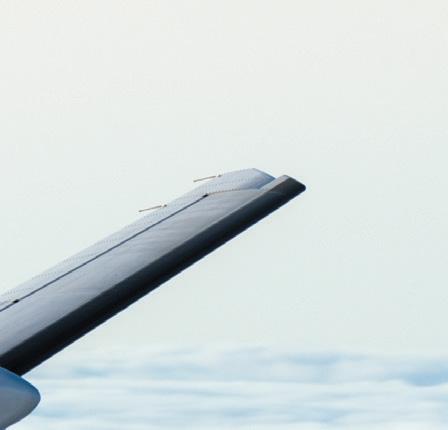



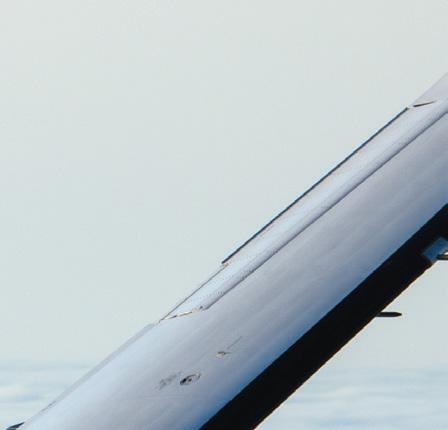


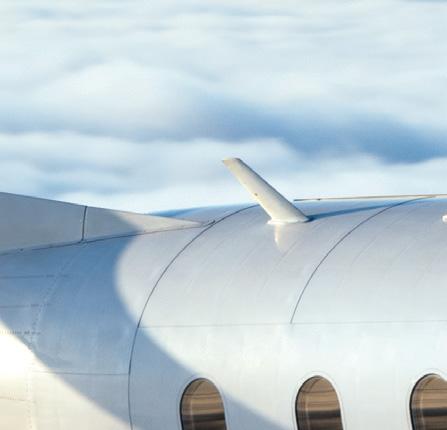
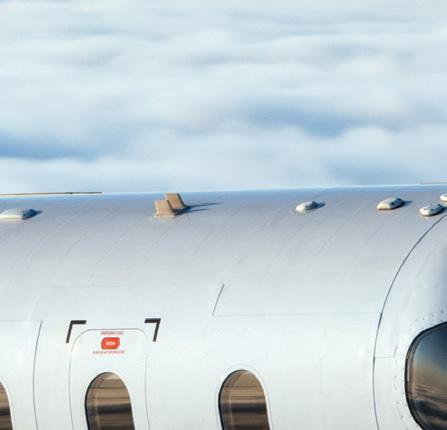

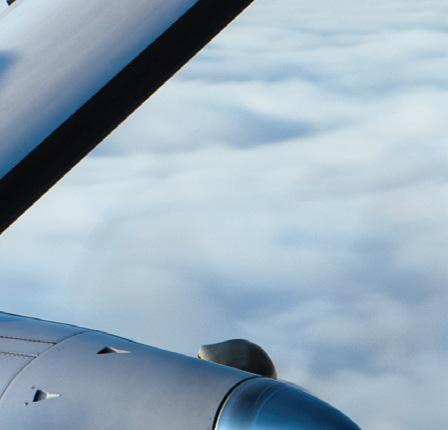

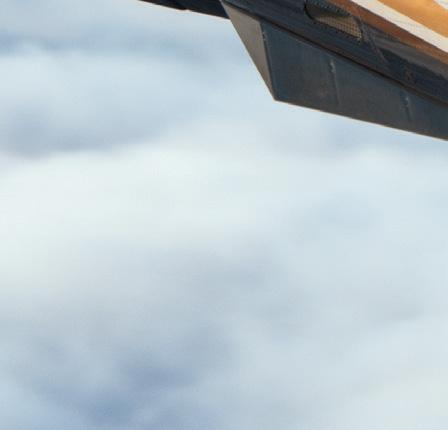
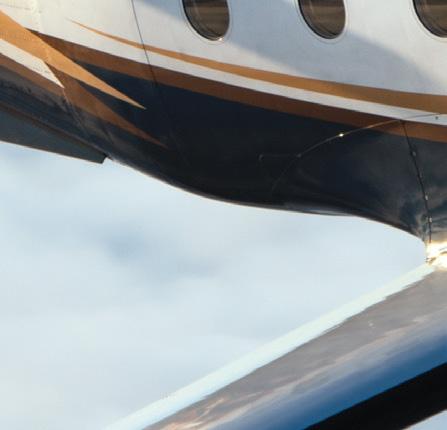
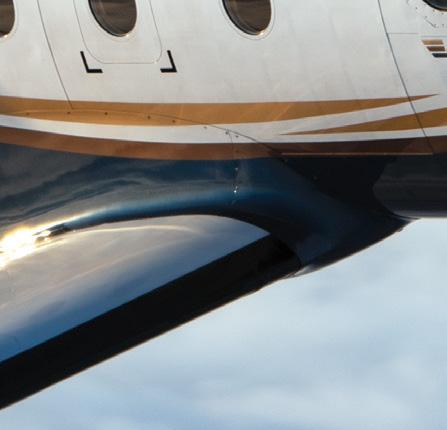



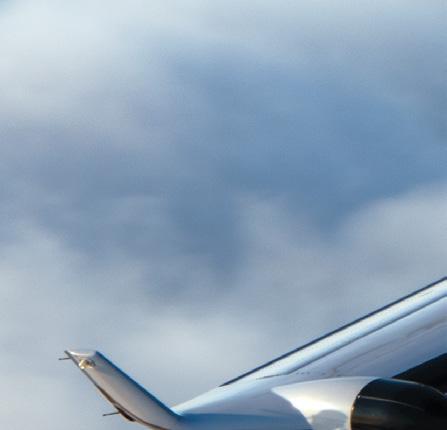
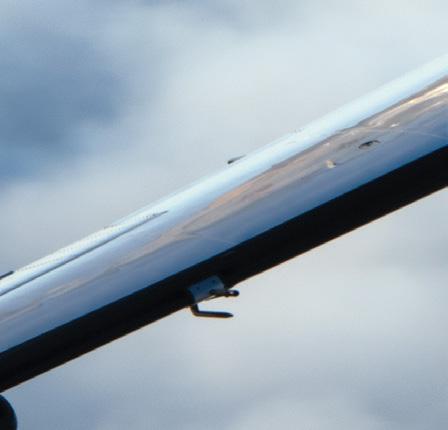



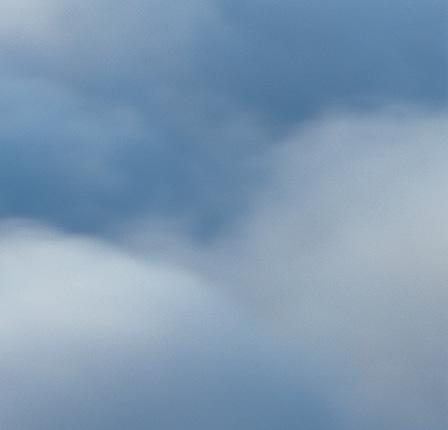
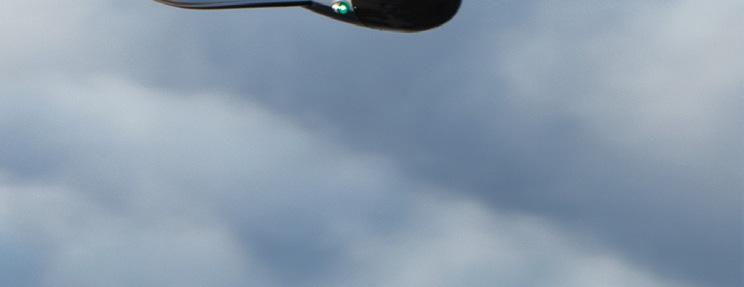
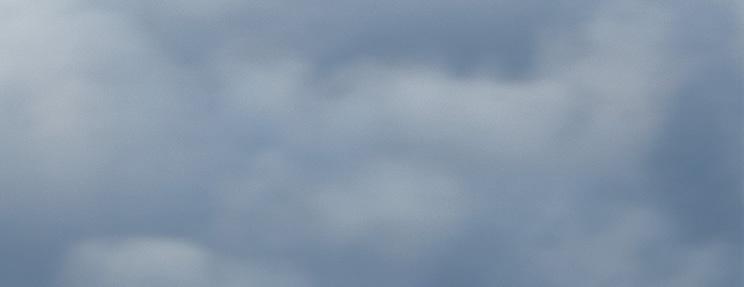






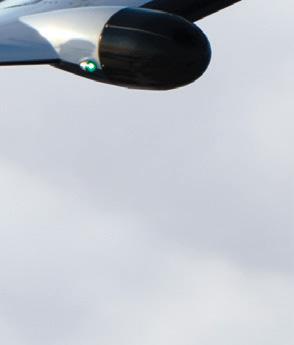




POSITION REPORT
Felix Gosher is unique in his passion and commitment to giving back to aviation. This month Felix has again given an extraordinary gift to flying by arranging one of his biggest ever events – The Elders Flight at Brakpan on 22 April. We provide an in-depth report in this issue.
FELIX HAS TOUCHED the lives of thousands of children and veterans. He has put on more than ten Childrens and Elders Flights, not just in South Africa, but as far afield as Lusaka, Zambia and the Central African Republic.
It is in giving of what we have, and then a little bit more, that we grow. Felix is one of those diamond-rare individuals who remain hugely passionate about flying, despite spirit quenching setbacks from small-minded opposition. His cup overflows. He may not have the poise of the classic super-cool airline pilot, or the insouciance of a fighter pilot, yet he has what it takes to be 120% committed to giving back to flying.
Felix’s background laid the foundations for the truly extraordinary impact he has made on so many young and old lives. He is the scion of an irrigation entrepreneur who had the flying bug. Felix had the good fortune to attend Treverton School in the Natal Midlands – which has its own airstrip. His geography teacher was Trevor Warner – who went on to become an SAA captain and formation aerobatic pilot.
The privilege of this flying background inspired Felix to become the one person capable of not just
initiating, but driving, the miraculous series of Childrens and Elders Flights. These are all about sharing the love of flying with firstly, children who would otherwise never have had the opportunity to experience flight, and secondly, aviation veterans, to recognise those who have already put so much into flying.
The Childrens and Elders Flights are carried aloft by Felix’s indomitable energy and leadership. He says that the cornerstone of the flights is the Spirit of flying that so many pilots bring to the event – that motivates them to make huge sacrifices of time and money to make dreams come true.
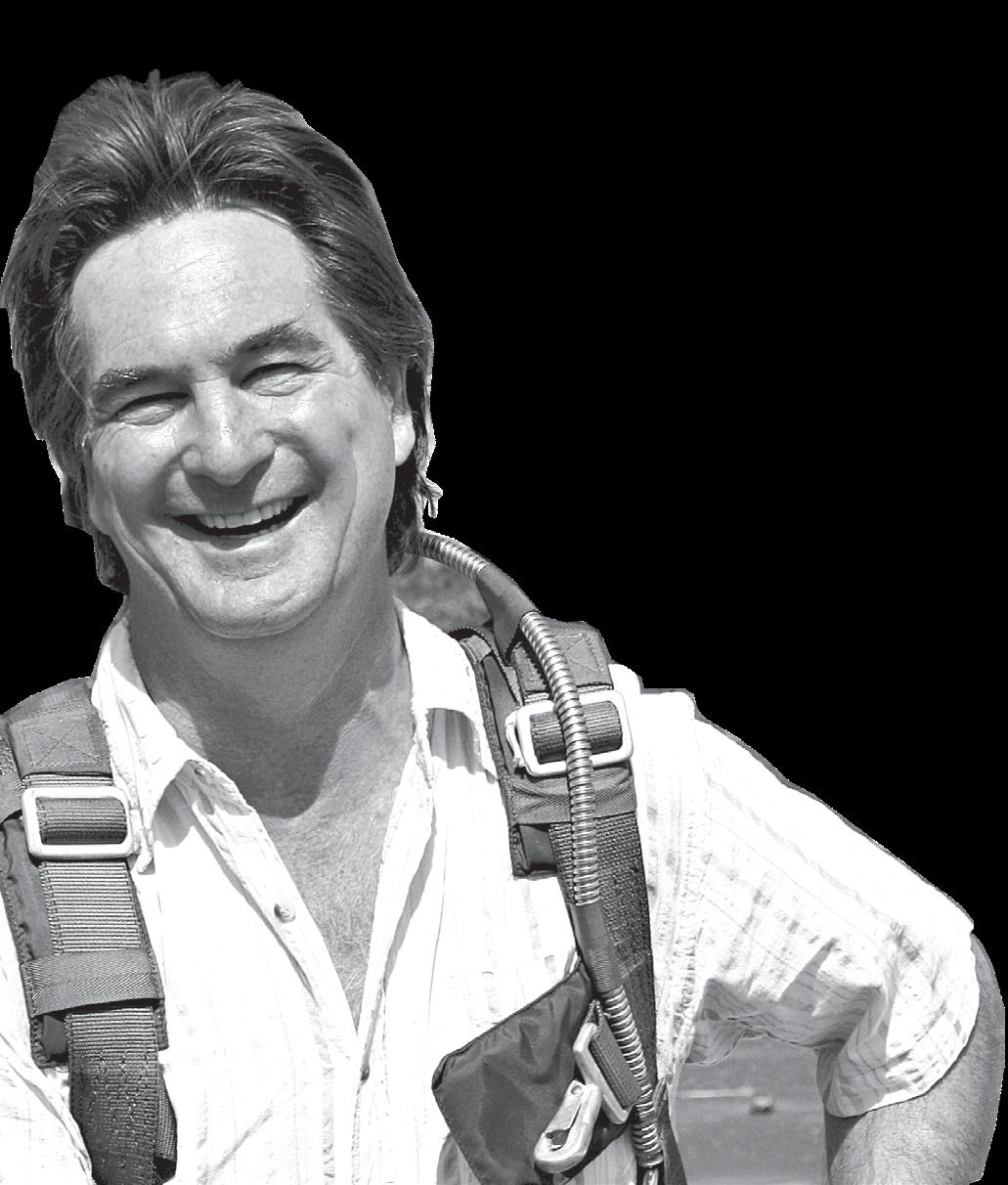
And it is not as though he does not have any other commitments. He has his career flying responsibilities, his beautiful wife Belinda, and their sons Dante and Ziaan. I asked Felix about how he manages to balance his career with his responsibilities as a father and husband and still meet the incredible demands of organising the Elders Flight. He just said that he could not do it without the massive support he gets from the flying community and its stalwarts like Menno Parsons.
Felix is making a huge impact on countless people’s lives. He has spread the love of flying into thousands of children and, despite the attacks of the dullards, his greatest legacy will be all those who choose flying as both a vocation and avocation.
j Guy Leitch
a huge impact on countless people’s lives

Pre-owned? More like pre-loved.
Porsche Approved. Reignited by passion.

Why should you only buy your Porsche from us?

As the official Porsche Distributor in South Africa, we are the only entity able to exclusively guarantee true peace of mind with our legendary Porsche Pre-owned Plan that is sold with each vehicle from our Porsche Centres. Our confidence in our vehicles only grows as our technicians use a 111-point checklist to examine the condition of the entire vehicle along with the complete history, making use of only Genuine Porsche Parts.





The right Porsche at the right price
Porsche South Africa prides itself on always having the widest selection of pre-owned Porsches available, and our skilled Sales Executives are experts in helping you find the right Porsche with the right package to suit your needs. Should we not have a specific vehicle in stock, we will use our extensive industry connections to source it for you. As a result of buying your Porsche through our trusted official centres, you are given the assurance of a better resale value should you decide to upgrade or sell your Porsche in the future.
Discover more by contacting your nearest Porsche Centre.
Porsche Centre Johannesburg
Witkoppen and
Road, Paulshof
Porsche Centre Cape Town
Century Avenue and Summer Greens Drive, Century City
Porsche Centre Umhlanga 49 Meridian Drive, Umhlanga Ridge Town Centre, Umhlanga Ridge Telephone 031 514 3000 www.porscheumhlanga.com Porsche Centre Pretoria 452 Botterklapper Street, Off Lynnwood Road, The Willows Telephone 012 816 7600 www.porschepretoria.com
Corner
Wroxham
Telephone 011 540 5000 www.porschejohannesburg.com
Corner
Telephone 021 555 6800 www.porschecapetown.com
2018 – 911 Carrera GTS PDK Including Maintenance Plan, 48,900 km, Carmine Red, Alcantara Package GTS Carmine Red, R1 745 000 2020 – 911 Carrera S PDK Including Maintenance Plan, 11,100 km, Agate Grey Metallic, Black & Bordeaux Red Leather, R2 345 000 2018 – Panamera 4 Sport Turismo PDK Including Maintenance Plan, 18,900 km, Volcano Grey Metallic, Black Leather, R1 315 000 2014 – Cayman S PDK Including Maintenance Plan, 82,000 km, Agate Grey Metallic, Black Leather, R695 000 2016 – Cayman GT4 Manual Including Maintenance Plan, 8,400 km, White, Black Leather & Alcantara, R1 479 000 2016 – Boxster GTS PDK Including Maintenance Plan, 27,000 km, White, Black Leather, R995 000 APPROVED





 2019 – Cayenne Tiptronic Including Maintenance Plan, 95,000 km, White, Black Leather, R995 000
2019 – Cayenne S Tiptronic Including Maintenance Plan, 69,600 km, Carrara White Metallic, Black Leather, R1 395 000
2020 – 718 Boxster Spyder Manual Including Maintenance Plan, 6,000 km, Racing Yellow, Black Leather & Alcantara, R1 745 000
2011 – 911 Carrera GTS PDK Including Maintenance Plan, 49,500 km, Carrara White , Black Leather & Alcantara, R1 149 000
2019 – Cayenne Tiptronic Including Maintenance Plan, 95,000 km, White, Black Leather, R995 000
2019 – Cayenne S Tiptronic Including Maintenance Plan, 69,600 km, Carrara White Metallic, Black Leather, R1 395 000
2020 – 718 Boxster Spyder Manual Including Maintenance Plan, 6,000 km, Racing Yellow, Black Leather & Alcantara, R1 745 000
2011 – 911 Carrera GTS PDK Including Maintenance Plan, 49,500 km, Carrara White , Black Leather & Alcantara, R1 149 000
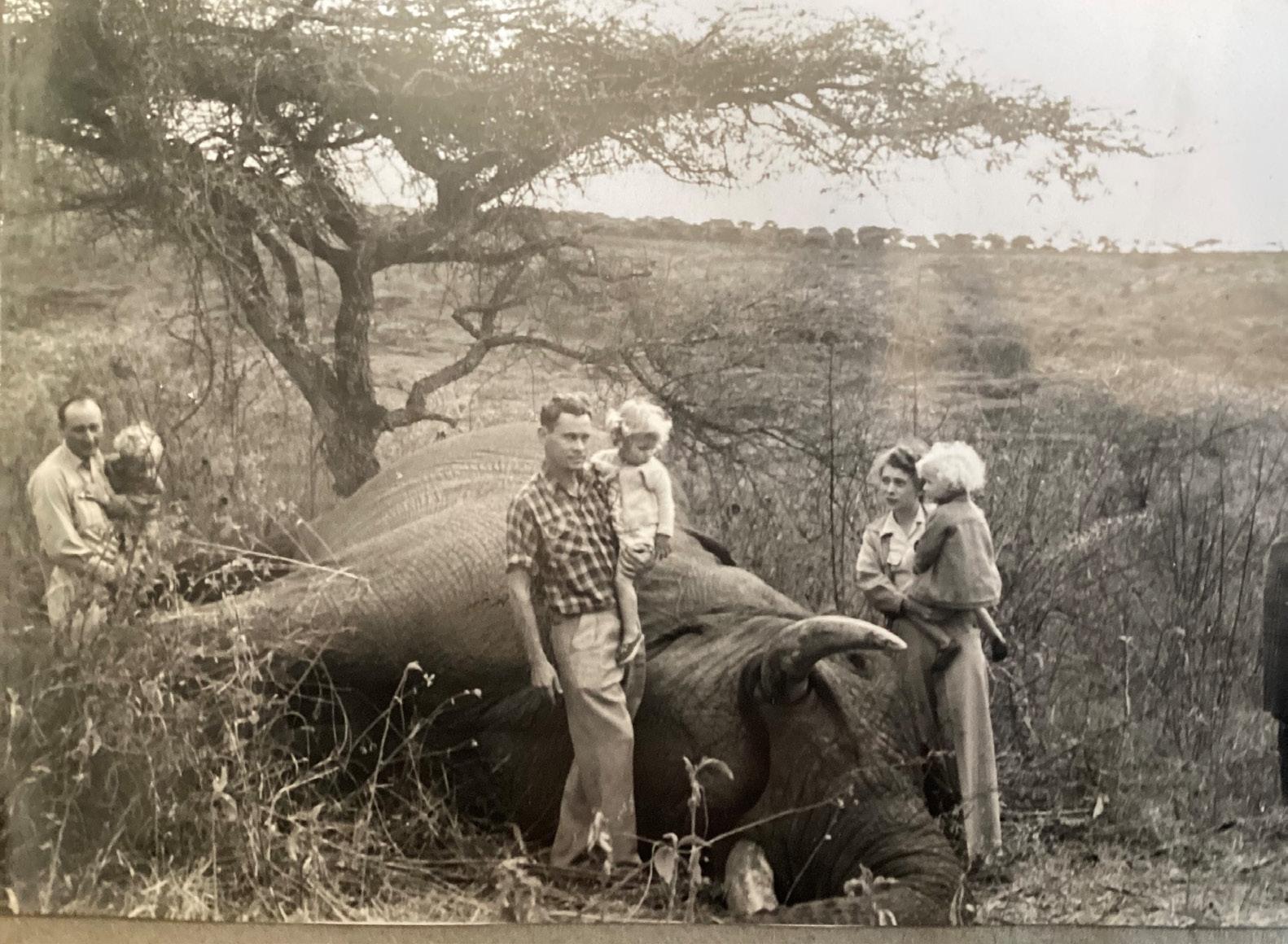

COLUMNISTS FLIGHTCOM 06 Bush Pilot - HUGH PRYOR 10 Pilots - LAURA MCDERMID Edition 326 FLIGHT TEST: FC 10 CONTENTS VL-3 EVOLUTION JMB AIRCRAFT SA FLYER 14 Guy Leitch - ATTITUDE FOR ALTITUDE 20 Peter Garrison - THE PITCH 24 Jim Davis - PLANE TALK 52 Jim Davis - ACCIDENT REPORT 60 Ray Watts - REGISTER REVIEW
tailBeaconX REDEFINING THE ADSB TRANSPONDER
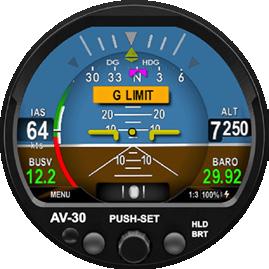

tailBeaconX combined with the AV-30 or supported third-party EFIS elevates your cockpit functionality while future-proofing your ADS-B transponder to meet South Africa, US, Canadian, and future ADS-B requirements. tailBeaconX replaces your existing transponder while upgrading your rear position light.
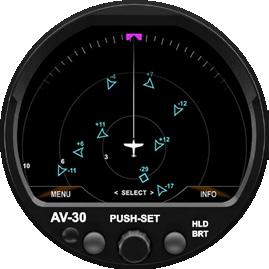
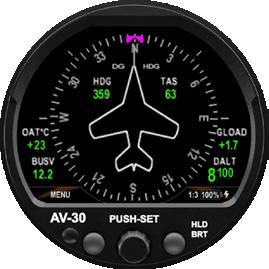
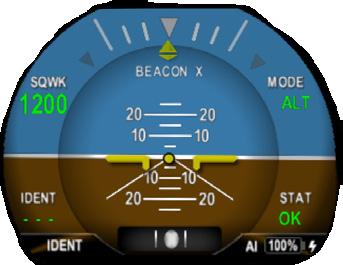
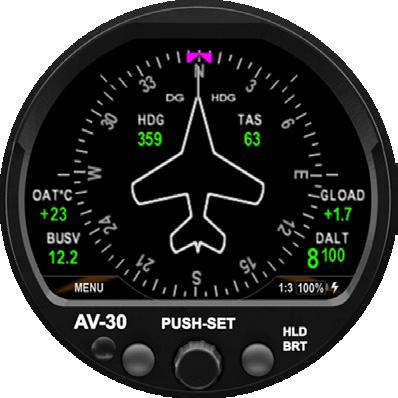


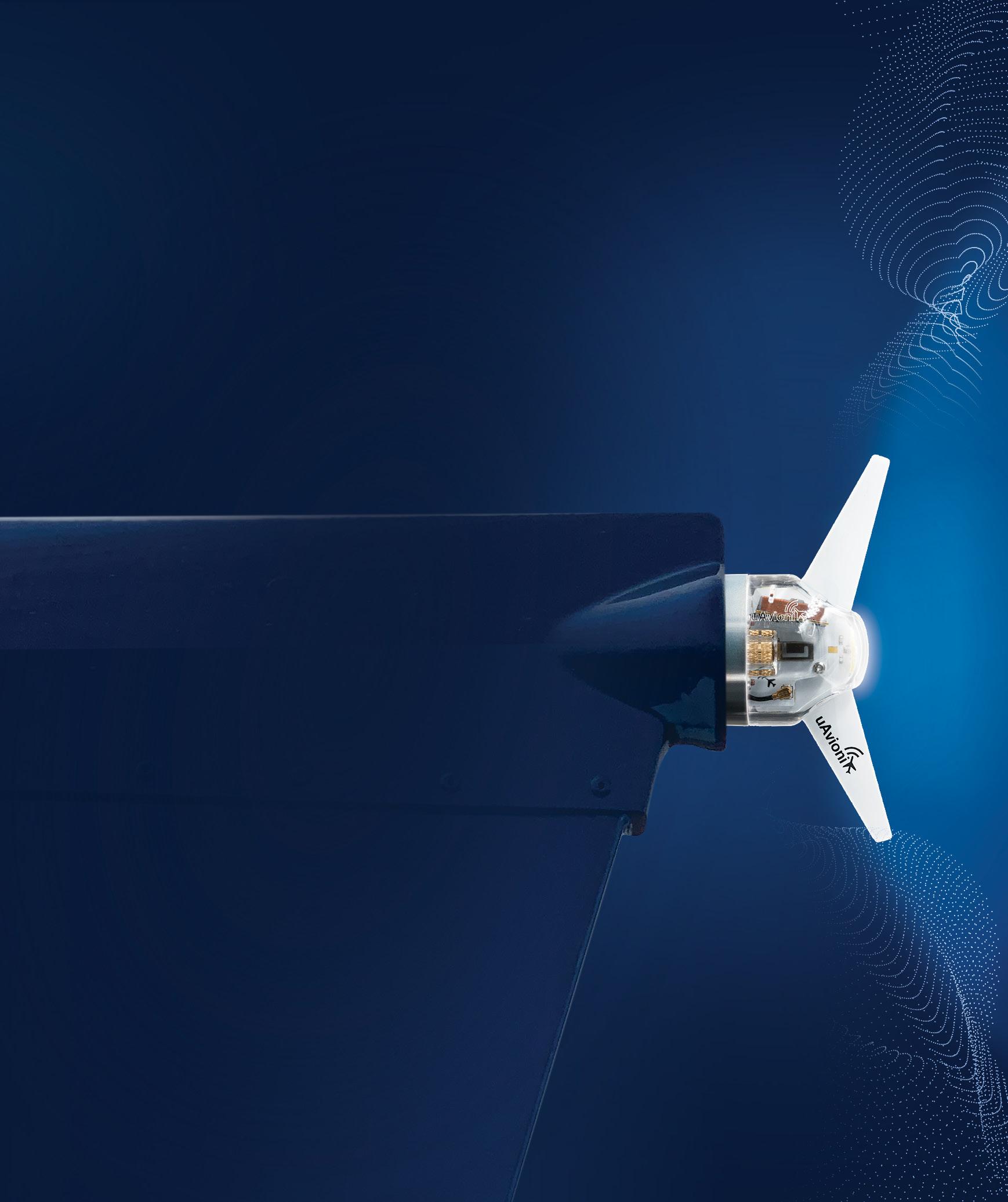

EASA Approved and Now Shipping
tailBeaconX CONTROLLED WITH AV30
AV30 HIGHLIGHT S:
• PRIMARY AI
• PRIMARY DG
• PRIMARY SLIP
• GMETER
• PROBELESS AOA
• LIVE ADSB TRAFFIC
AV MAG
• EXT MAGNETOMETER
AV LINK
• WIFI/TRAFFIC
AV30 ADDONS: uAvionix.com/tbx
May 2023 JOURNEY OF A MISSION PILOT ELDERS FLIGHT: 2023


May 2023 10 12 Opening Shot 64 M & N Acoustic Register Review 74 SV Aviation Fuel Table 84 Executive Aircraft Refurbishment Events Calender FLIGHTCOM 09 AME Directory 34 ALPI / BILL Flight School Listing 35 Merchant West Charter Directory 36 Skysource AMO Listing 38 Aviation Directory CONTENTS Edition 326 REGULARS FEATURES SA FLYER 31 QUOTE OF THE MONTH 34 FLIGHT TEST: JMB AIRCRAFT VL-3 EVOLUTION 49 NEWS: COBRA IN A BARON 50 CAA INDUSTRY AWARDS: NOW OPEN 56 GADGET OF THE MONTH: THE ROTAX 916 66 THE AMAZING ELDERS FLIGHT 73 NEWS: BLUE LASER ATTACK 76 AERO FRIEDRICHSHAFEN 2023 85 RAND AIRPORT AVIATION COMPANIES GUIDE FLIGHTCOM 14 Rules Part 4 - John Bassi 19 News - South Africa gets 92% ICAO Score 20 SANSA: Supporting Resources 24 The Long Journey of a Mission Pilot 32 Update: The Cape Winelands Airport

May 2023 11 YOUR AIRPLANE. READY FOR THE FUTURE. 1Additional hardware equired; sold separately. 2With select makes/models; visit Garmin.com/autopilots for more details. © 2023 Garmin Ltd. or its subsidiaries. HIGH-RESOLUTION TOUCHSCREEN DISPLAYS INTERFACES WITH POPULAR NEW AND EXISTING AVIONICS OPTIONAL ENGINE INDICATIONS WITH DATA LOGGING EASY UPGRADE TO YOUR PANEL COUPLE WITH GFC™ SERIES AUTOPILOT2 EFB FLIGHT PLAN SYNC1 GTN™ Xi NAVIGATORS AND TXi FLIGHT DISPLAYS TO LEARN MORE, VISIT GARMIN.COM/AVIATION
Under the Stars
This month we again feature one of Knysna based pilot Duran de Villiers remarkable images.
Duran has a wonderful eye for composition and catching the essence of flight. He has the privilege of being able to fly a number of different types: from an Airbus helicopter to powered paragliders. This beautiful image of his KFA Safari shows it best in its natural environment – far out in the bush under the stars of a crystal-clear sky. The modern digital cameras in-camera processing makes the specific exposure details of these pictures irrelevant.

May 2023 12

May 2023 13 Send your submissions to guy@saflyermag.co.za
Squeezing Out Every Last Cent
LET ME START OFF with the good stuff. It really is commendable that the SACAA scored 92% in its latest ICAO audit.
Under the leadership of Ms Poppy Khoza (yes really), this ICAO rating has been the prime objective, even if it is sometimes at the expense of the industry’s growth and development.
The importance of achieving this high rating must not be understated. Imagine what would happen if South Africa’s rating was going steadily backwards, like so much else in our beloved country. The industry would heap opprobrium on the government and regulator and say that the decline in aviation regulation standards is just another typical African governance failure.
Instead, we have a world-class aviation regulator. This is great comfort to those who rely on South African aviation standards. This includes international businessmen and tourists who fly into South Africa and use local airlines. It also includes all the flight schools who must
have their standards internationally accepted. And it applies to every pilot who needs to have his licence recognised in another country.
I must also record that, despite my carping that the CAA all too often regulates the industry into the ground, it is also trying to develop general aviation. I specifically note the relaunch of its Civil Aviation Industry Awards (CAIA) initiative. While many may like to think that this is a smug opportunity for overpaid civil servants to flaunt their conspicuous consumption of brands, it cannot be argued that it is good to recognise and reward excellence in the industry.
That’s enough of being nice to the regulator.
Of far greater concern is the unmitigated stupidity of the CAA now squeezing a miserable R380 for paperwork (well okay, data capture) that they should be providing for free and which are essential to the basic functioning of the aviation industry.

May 2023 14
ATTITUDE FOR ALTITUDE: GUY LEITCH
we have a world-class aviation regulator
I have been writing about the CAA for sixteen years and the more time passes, the less I’m able to make much sense of it.
If your instructor has signed you out on a new "type" - are you legal to fly?
Over time the CAA has made an increasing cock-up of the issue of recognising ‘conversions’ to different types of aircraft. In the old parlance – if you learned to fly on a Cessna 150 you needed a ‘conversion’ to fly a C172. The new language makes things far more complicated, and so you need to understand Type Ratings, Class Ratings Differences and Variants.

When I learned to fly forty five years ago, the DCA, as the then regulator, treated pilots like adults. It provided for Open Ratings for pilots with sufficient experience and skill to fly a variety of different aircraft without having to do ‘conversions’ onto each specific type.
Then, in about 1998, for whatever reason they came up with at the time, Open Ratings were abolished and pilots had to have a ‘conversion’ onto every model of aircraft they flew. The industry accepted it without much push-back.
For the past 25 years, pilots have to be qualified onto a new variant (ie model) by paying for an appropriately rated instructor registered at an Air Training Organisation (ATO). Once you have done the theoretical test and demonstrated that you can fly the plane, the instructor signed you out in your logbook – and you were good to go.
In some cases, if you were already qualified on a plane similar to the one you wanted to move to, it merely involved a ‘familiarisation’ exercise. You might not even have to fly the new variant but simply have it endorsed in your logbook, This was based on your experience and the judgement of the instructor, as well as notification of the endorsement; using Form 61.09-7. This must be sent to the SACAA within 30 days of the instructor having signed it off.
A key was that, as the variant is just part of the Class Rating (on Page 5 of your licence), you could immediately fly the new variant as soon as the instructor had signed it off in your logbook.
May 2023 15
However, around November last year the CAA started charging R380 just for noting a new variant in a pilot’s file.

The CAA says it is treating every Variant or Differences endorsement as a new Type Rating. However, a Type Rating is for aircraft with a MAUW over 5,700kg (12,500 lbs). Above this MAUW a specific Type Rating is required, which has to be added to our License document after completion of the training onto the new type via an ATO.
What the CAA does not seem to accept is that a Variant or Differences endorsement is not a Rating – yet the CAA is insisting on charging as though it is.
For sensible operational reasons, without having to wait for CAA approval, pilots must be able to fly an aircraft once it is endorsed in their logbook:. The Civil Aviation Regulations (CARS) state we need to submit the notification within 30
days of it being endorsed in our logbooks. A key concept is that nowhere on the endorsement form is there any reference to a Type Rating.
With the CAA now extorting fees and insisting that a piece of paper has to have been issued, instructors are naturally asking if there was a change in legislation. The CAA must be able to show the actual changes to the CARS. Otherwise this is yet another example of the ad-hoc “tea-time’ rule making the CAA is much criticised for.
It is argued that; “The CAA cannot just decide they now want to charge for endorsements unless there was a change of legislation. And such a change to the CARS can only be made after consultation with the public, (through CARCOM).”
The situation has become a mess. A group of concerned instructors has asked the CAA to clarify the following:
May 2023 16
The new SACAA card pilots licence - how do you check what you are rated on?
• What part of the Pilots License does the A4 “file copy” make up of the pilot license documentation ? It is noted that the wording, “This is not a licence” was recently removed from the file copy page, causing further confusion.

• Where in the regulations does this legal change/addition appear?
The information on the A4 copy does not always match the info on the actual Pilots License, due to either failure to update the info on the CAA side, or the pilots not double-checking the A4 Sheet. This creates confusion on ramp inspections, both locally and internationally.
The situation becomes worse with the implementation of the new License Card system. The question arises: how would the “File copy” – which is the printed A4 sheet – be carried with the license card? If it is not part of the licence, must the pilot (or ramp inspector) check online if the variant has been added? And if the CAA computer is offline, how does the pilot know when he can legally fly the new variant?
It sounds complex – and is – but the devil is in the detail. This new (non-rule?) policy has serious financial implications, as hire and fly and training schools now have to allow for a 10 day waiting period for additions to be processed by the CAA. This will cost the aviation industry millions every year in lost income due to pilots having to wait in order to fly recently added variants.
I can only assume that some bureaucrat bean counter was told to find other ways to cover the regulators’ bloated budget. So they looked at all the little paperwork transactions around aircraft pilot licencing and decided a great way to earn more would be to charge for things previously done as part of the annual licence fee. I can only surmise they had no concept of what this would do to the industry.
One of the more significant problems is that, when a pilot becomes an instructor, she will probably have at least 25 different ‘types’ on her license. She will now have to reapply to have all those types re-endorsed and must pay R380 for each. That simply means that many of the instructors are not going to renew their “type” Ratings/Variants on those aircraft as PI (Pilot Instructors) by paying for each aircraft already on their licence. Once again a vast repertoire of skills will be lost to the industry.
Even more serious is the effect on insurance. If a pilot gets a familiarisation or variation signed off in his logbook and then immediately flies that aircraft, does this mean the paperwork is not legal –because the fee to the CAA hasn’t been paid? If so, then the pilot’s insurance coverage is probably void.
The heart of the problem seems to be that the CAA has reverted to its practice of tea-time rulemaking. It is using Part 61.2. to unilaterally decide that it can charge a fee for simply noting a variance.
This move was presumably motivated by the CAA having lost a large part of its income to the Covid lockdown and the loss of passenger tax revenue.
The CAA may have increased its revenue, but the long-term damage to the industry by yet more fees will be incalculable. j
guy@saflyermag.co.za
May 2023 17
but the devil is in the detail.
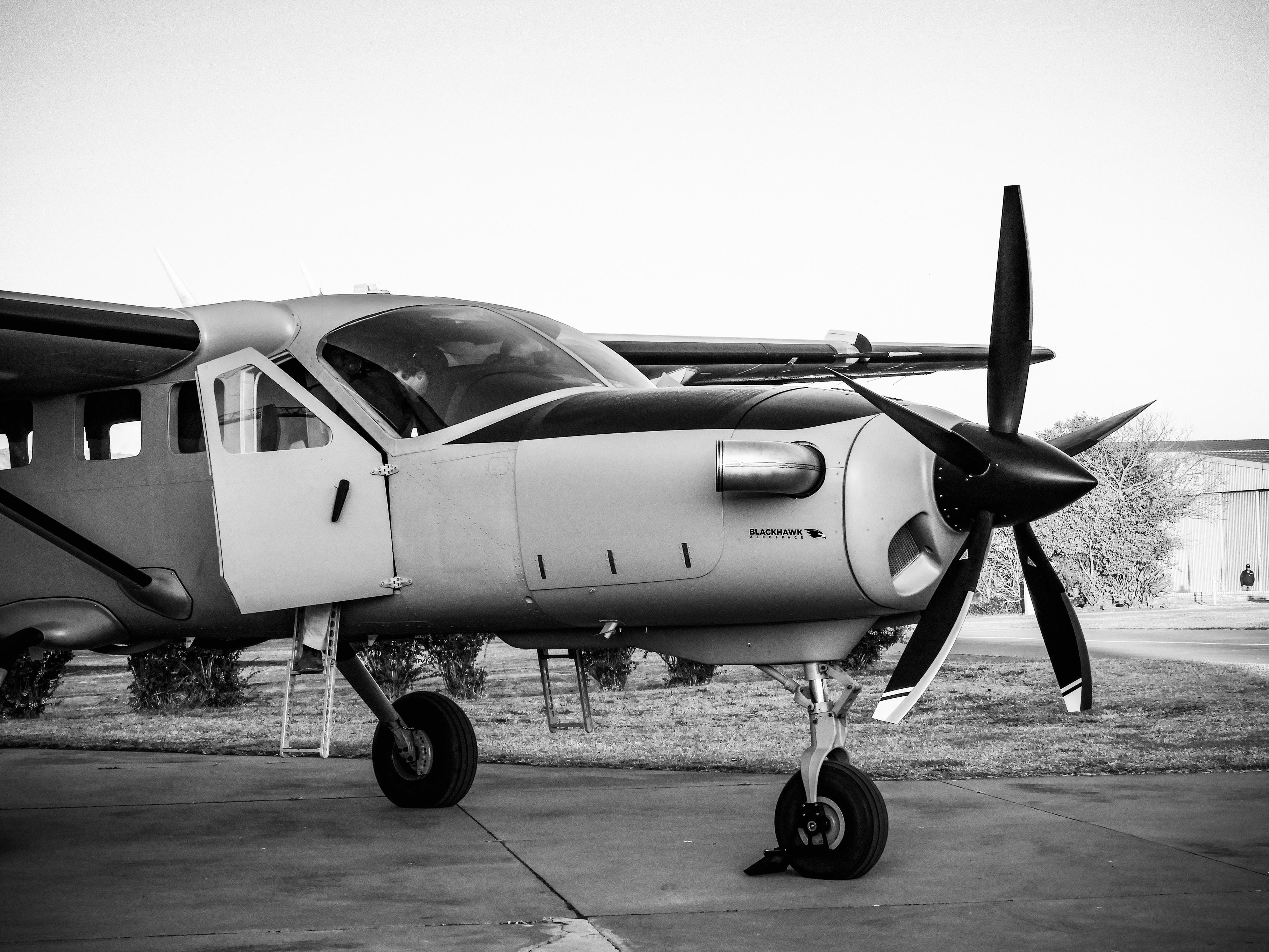
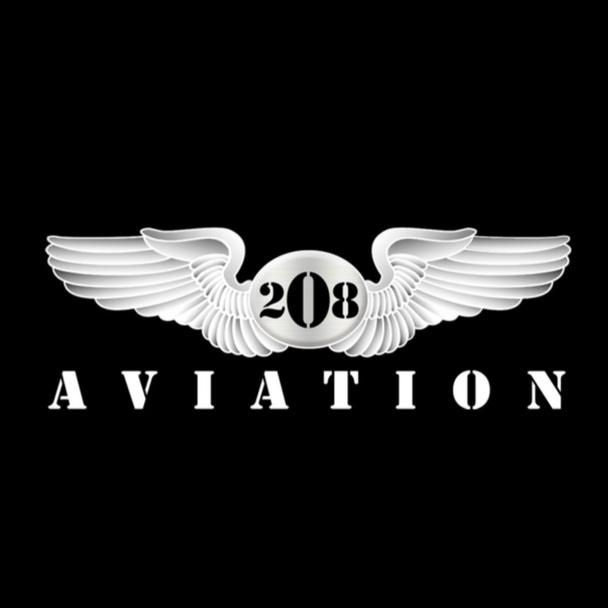

May 2023 18 2 0 8 A V I A T I O N H A N G A R 4 9 , W O N D E R B O O M A I R P O R T P R E T O R I A . S O U T H A F R I C A w w w . 2 0 8 a v i a t i o n . c o m + 2 7 8 3 7 4 4 3 4 1 2 W e a r e a n a p p r o v e d B l a c k h a w k D e a l e r a n d I n s t a l l a t i o n F a c i l i t y , 2 0 8 A v i a t i o n s p e c i a l i s e s i n B l a c k h a w k e n g i n e u p g r a d e s f o r B e e c h c r a f t K i n g A i r S e r i e s a n d C e s s n a C a r a v a n . AMO 1148

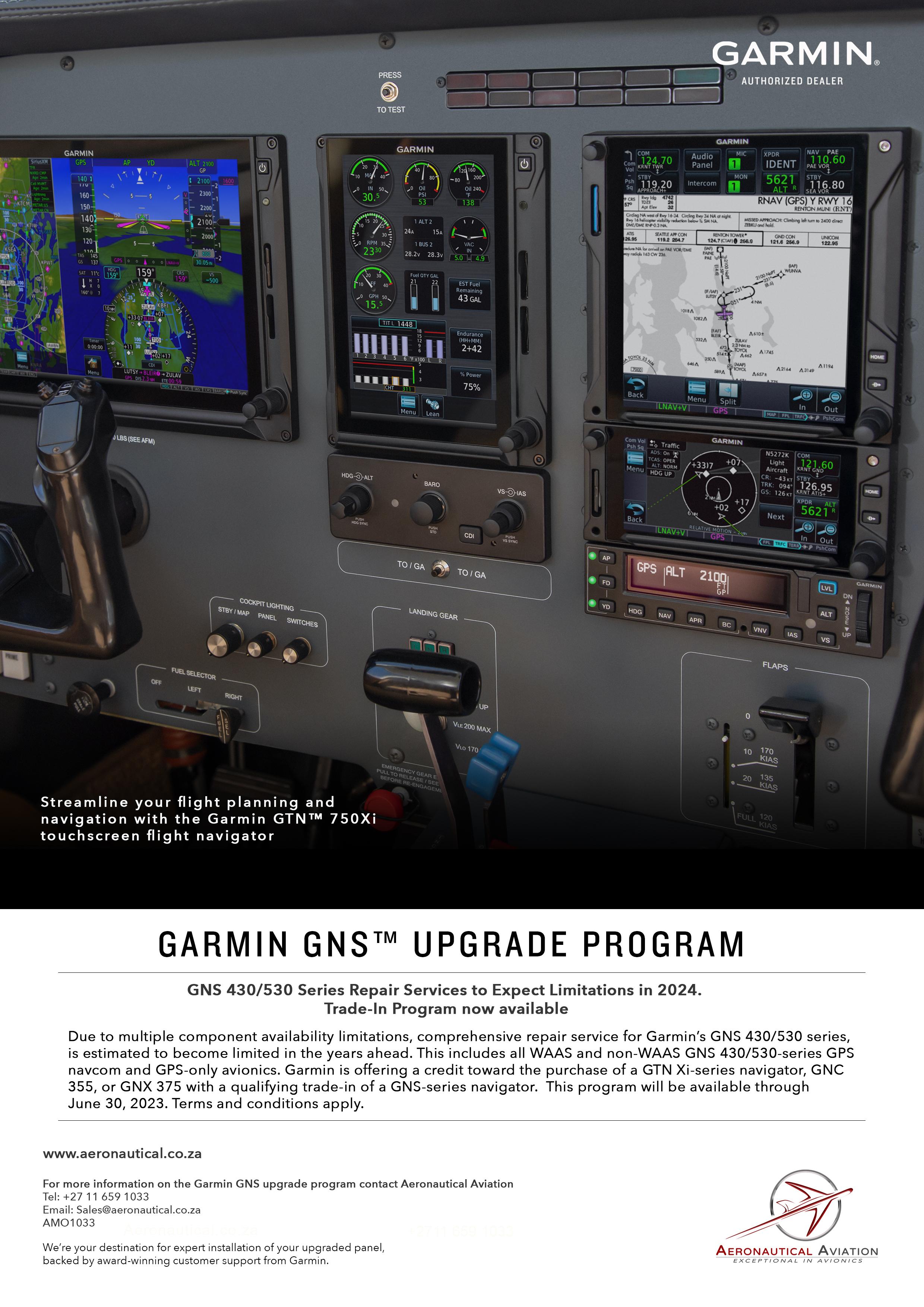
HERE COMES THE PITCH
IN THE ACCIDENT IN QUESTION, the pilot selected full flaps, allowed speed to decay to the vicinity of the stall, and then, feeling she was still too high to land, decided to go around. She retracted the flaps without first gaining speed. The minimum flying speed went up along with the flaps, and the aeroplane, a Cirrus, stalled and spun.
This seems like an elementary error, but changing configuration at low speed is not always an easy thing to do. Early Cessna 150s and 172s, for instance, were notoriously unable to gain speed with full flap; you had to bleed the flap up very carefully while you waited for the diminishing drag to allow the aeroplane to very gradually accelerate. If you had to turn or climb to avoid an obstacle, you were in a bad fix.
This characteristic was not confined to lowpowered personal aeroplanes; the Boeing 727,
with its fantastically complicated and powerful triple-slotted flap, had it too. Both the Cessnas and the Boeing had 40-degree flap positions that many operators eventually disabled because of the drag they entailed.
The first aeroplane I built, Melmoth (1973-1982) had a double-slotted Fowler flap that deflected 45 degrees. It produced a tremendous amount of drag. One of the tricks with which I would amuse or appal passengers was to stay at pattern altitude on final approach until the runway disappeared from view under the nose. I would then chop the power and land on the numbers.
On one memorable occasion, with Scaled Composites test pilot and civilian astronaut Mike Melvill riding in the right seat, I began the flare a little too abruptly and the nose did not come up. Thus, in accordance with my philosophy of

May 2023 20
Writing about a fatal accident that resulted from the pilot’s mishandling of a balked landing, I reflected that I had never assessed the behaviour of my own aeroplane in that manoeuvre. My idea of flight testing is to take trips and wait for something strange to happen, and, as luck would have it, I have never yet had a balked landing in Melmoth 2.
PETER GARRISON
unable to gain speed with full flap
flight testing by random events, I learned that with a forward CG and full flap the stabilator could stall.
Flaps 40 on those early Cessnas also produced a powerful nose-down pitch. You would trim nose up to approach speed with full flap, and only then discover that the Creator had omitted to provide you with a third hand with which to re-trim while the left hand pushed like mad on the yoke and the right milked the flap lever.
I expected my second design, Melmoth 2 (2002) to present similar problems. It has large Fowler flaps – but only single-slotted, and limited to 30-degree deflection – retractable landing gear
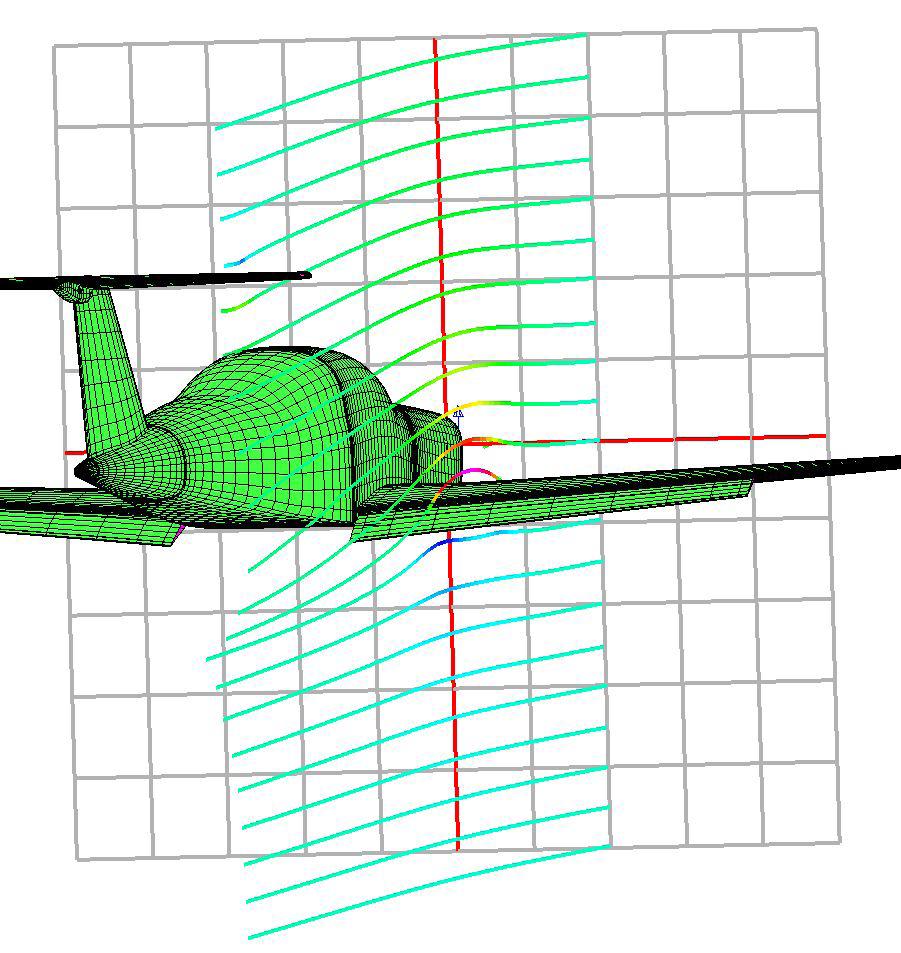
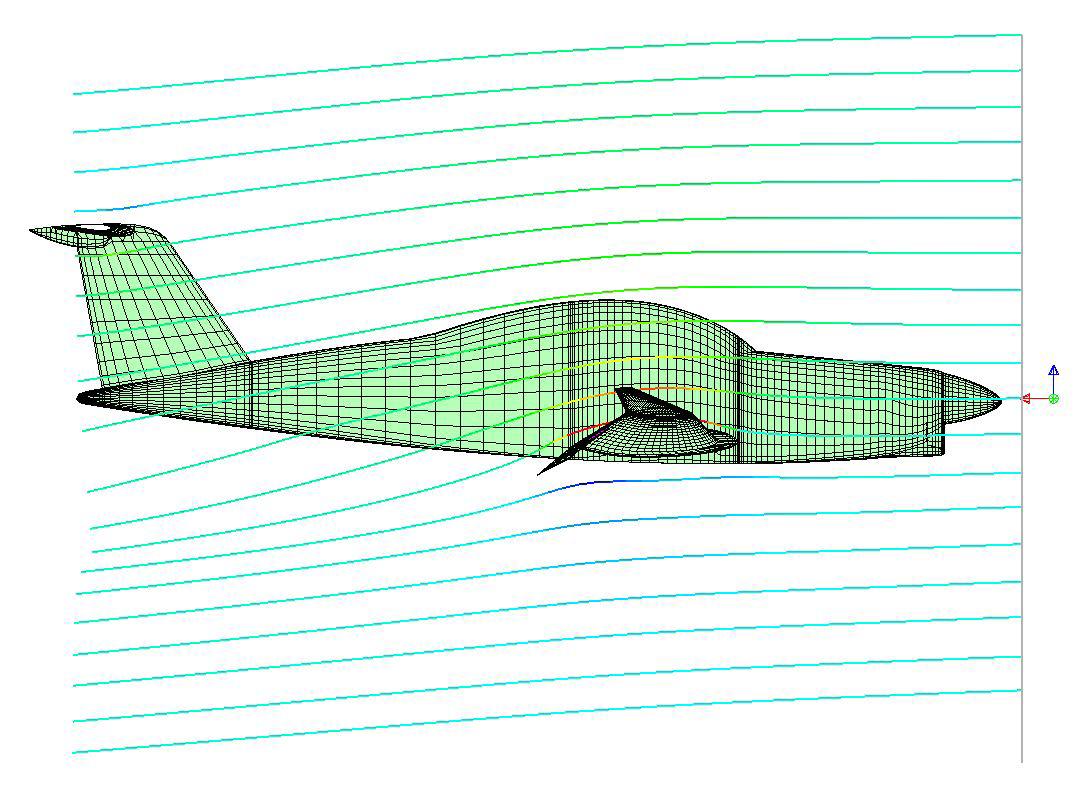
and an airbrake under the belly, near the leading edge of the wing. I decided that the go-around procedure should begin with a power increase, followed by gear retraction, then the airbrake (which is always used for landing) and finally the flaps.
At altitude, I configured for landing and set up a 500-fpm descent at an approach speed of 73 knots. This required about 18 inches of manifold pressure. I then pretended that an elk had strolled onto the imaginary runway in front of me. I arrested the descent while bringing the power up to 26 inches (the maximum allowable is 41) and started cleaning up.
May 2023 21
The downflow behind the wing with flaps deflected.
It was quite a complex routine. There was no pitch trim change with gear retraction, but a marked, and sudden, pitch-down with airbrake retraction (because the build-up of air pressure in front of the belly-board tends to lift the nose). There was an equally marked, but more gradual, pitch-up between flaps 30 and flaps 10, and very little change the rest of the way. With me alone in the plane it’s at its most forward CG, and has just enough trim authority to maintain a 1.3VS approach speed with flaps and airbrake down.
Trim is manual, so when the airbrake came up I had the same problem as the Cessna 150 pilot: not enough hands. As I cleaned up, therefore, I was making all the adjustments with the sidestick. It wasn’t smooth. I would have lived, but I might have scared the elk.
Go-around behaviour varies among types, largely because of the trim changes associated with flaps. Flap deflection, because it increases the camber of the wing, eventually results in a more nose-down fuselage attitude if you hold speed constant. But it is usually necessary to re-trim, and the transitional trim change while the
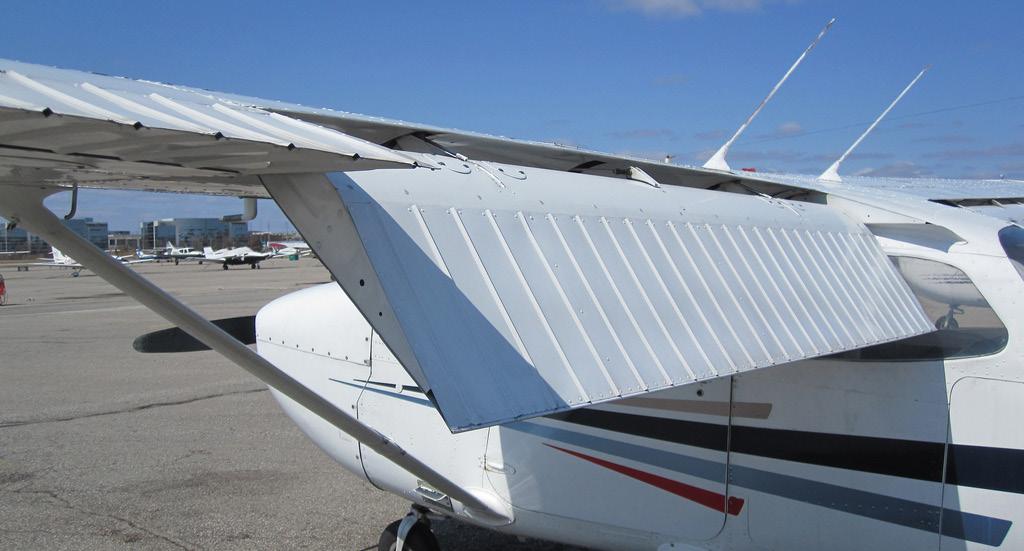
flap is moving may be nose-up or nose-down, depending on the configuration of the aeroplane.
The trim change is due to two factors. The first, which is common to all flapped wings, is an increase in the nose-down force generated by the wing itself. All cambered wings (unless they have reflexed trailing edges) produce a nosedown force that is counteracted by the stabilising surface, be it a horizontal tail or a canard. A deflected flap, which greatly increases camber, augments that force.
In addition, the moving flap – generally, the wings of canard aeroplanes don’t have flaps, and so we’re just talking about tail surfaces now – changes the angle of airflow at the tail. That change is invariably nose-up, because the downward angle of the wing’s wake pushes the horizontal tail downward.
So the reaction to flap deflection is the sum of the nose-down force of the wing and the noseup force due to the downwash at the tail. Each varies at its own rate with flap deflection, and in a given configuration either may predominate.
May 2023 22
The Cessna 172 will not climb with full flaps.
your
aeroplane may surprise you
The wing’s wake can be thought of as a capelike sheet emanating from the trailing edge. The downwash angle is greatest along that sheet; above and below it, the downward displacement of the wake lessens and, at a distance of a halfspan or so, eventually disappears.
In the accompanying illustration, which is a computer analysis of the downwash a few feet out along the wing of Melmoth 2 with the flap deflected, you can see that the downwash angle at the tail is greatest at a point somewhat lower than the wing. That is why aeroplanes, for example all high-wing Cessnas, whose horizontal stabilisers are below their wings, usually require nose-down trim with flap deflection, whereas low-wing aeroplanes, whose horizontal tails are farther from the centre of the wake and encounter a lesser downwash angle, are more likely to require nose-up trim. The difference is magnified by the fact that the
fuselage, which disturbs the downwash in its own wake, is less disruptive in high-wing than in low-wing aeroplanes. Power effects further complicate the picture, producing particularly marked pitch-up in a single-engine, high-wing, low-tail aeroplane.


The relations among wings, flaps, fuselages and tails vary in many ways, and a particular aeroplane may violate the general rule. That is why it is useful to practice a few balked landings, at a safe altitude, in order to see at first hand how your aeroplane behaves and how you yourself react.
If you doubt your own test-piloting abilities, do it during your next biennial, under the supervision of an instructor. The behaviour of your aeroplane at low speed, with sudden application of power and changes in flap setting, may surprise you.

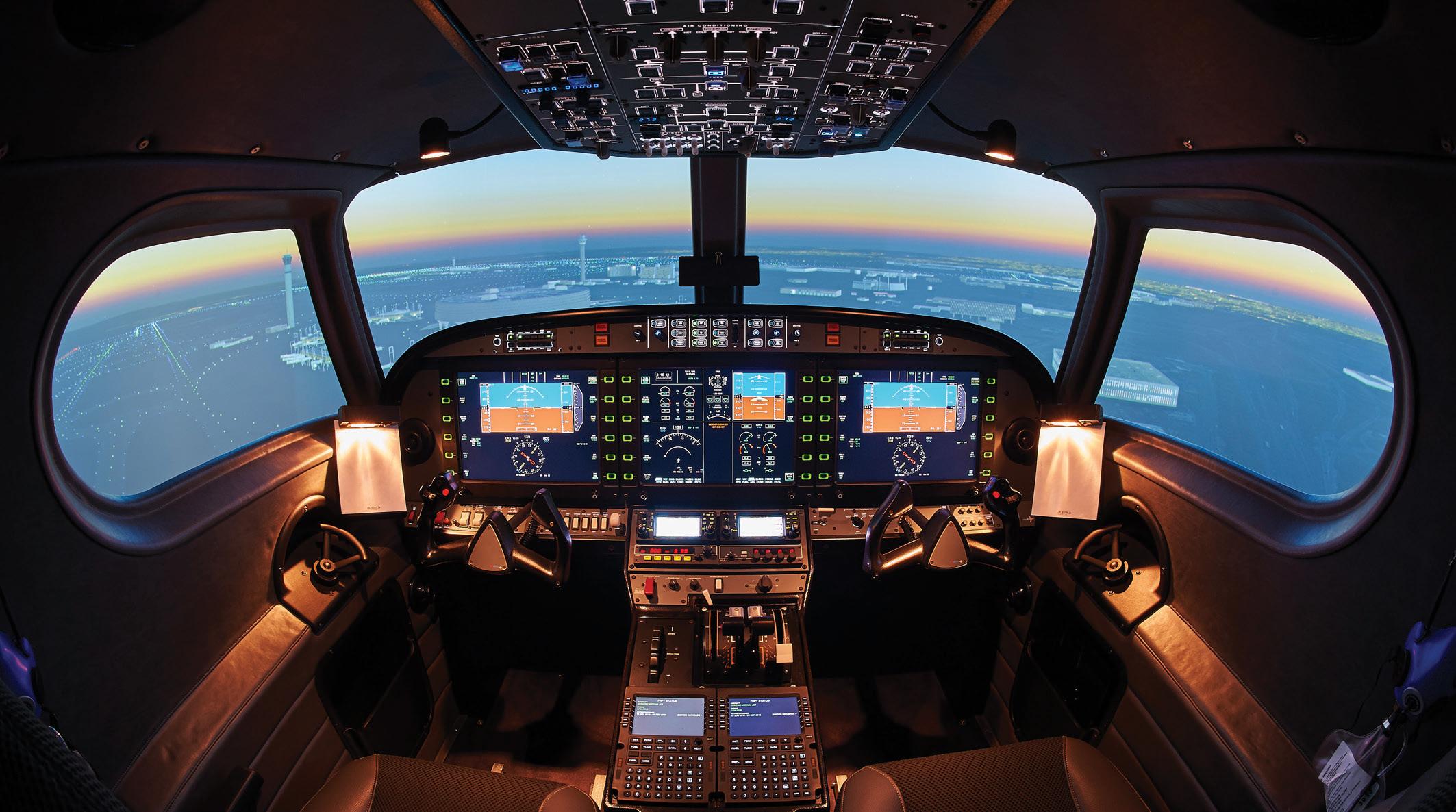
May 2023 23
j SA Flyer 2023 | 05 TRAIN ON THE MOST MODERN FLIGHT SIMULATOR AVAILABLE IN SOUTH AFRICA WITH NEW VFR LEVEL TERRAIN
• Now certified for TCAS training. • RNAV and GNSS Certified on all flight models from single engine to turbine. PPL TO ATPL TRAINING AND EVERYTHING IN BETWEEN CONTACT US OR VISIT OUR WEBSITE FOR MORE INFORMATION: Tel: 011 701 3862 E-mail: info@aeronav.co.za Website: www.aeronav.co.za SACAA ATO No: SACAA/1110/ATO
GRAPHICS
RIGHT SEAT RULES NO. 5
CLASSROOM CAPERS,
OR HOW TO GET THE GOOD STUFF
PAINLESSLY INTO PUPES’ PAWPAWS.
One of the best instructors
I ever employed
was
Manny Ceh – a jovial German (isn’t that an oxymoron like awfully good, and pretty ugly?)
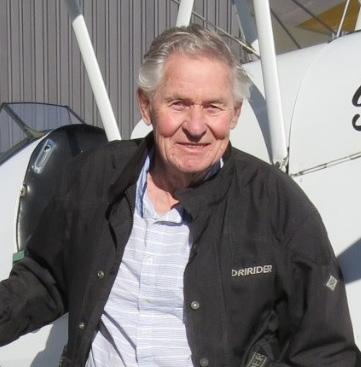
MANNY WAS SPHERICAL with a round face and a sparkling eye. He would always greet his pupils, male or female, with a huge bear hug.
One day I heard a hell of a racket in the PPL lecture hall. The place normally had an almost library-like ambiance, so I stuck my head in to see what was going on. There was chaos. The tables had been moved against the walls. The chairs were scattered all over the place, so were the twenty odd pupes. Some were sitting on the floor, others were on their hands and knees, while the remainder were offering words of advice and encouragement. In the middle of the room was Manny, elevated above the crowd, sitting on a chair on top of a table.
It quickly became apparent that Manny was the ATC and some of the pupes were aircraft. Marks on the floor were TMAs and FIR boundaries.
Some pupes wanted taxi clearance, others were ready for takeoff, and others were giving position reports. Everyone was having huge fun.
That, dear parishioners, was the best lecture I have ever seen.
Remember the rule:
• Tell me and I will forget
• Show me and I will remember
• Involve me and I will understand
Manny had them involved up to their necks.
LEARNING TO LECTURE
And now I must tell you the most extraordinary thing. Surely teaching, lecturing, training or whatever you want to call it, must be just about the most important obligation every society has. We are responsible for passing on to each new generation stuff we learned and inherited – languages, mathematics, physics, chemistry and so on.
All these have to be taught – so how do we learn to teach? Well there are formal routes through universities or teachers’ training colleges. But you don’t need formal training to teach at a private school, or at a university, or at a flying school.
May 2023 24 PLANE TALK - JIM DAVIS
Everyone was having huge fun
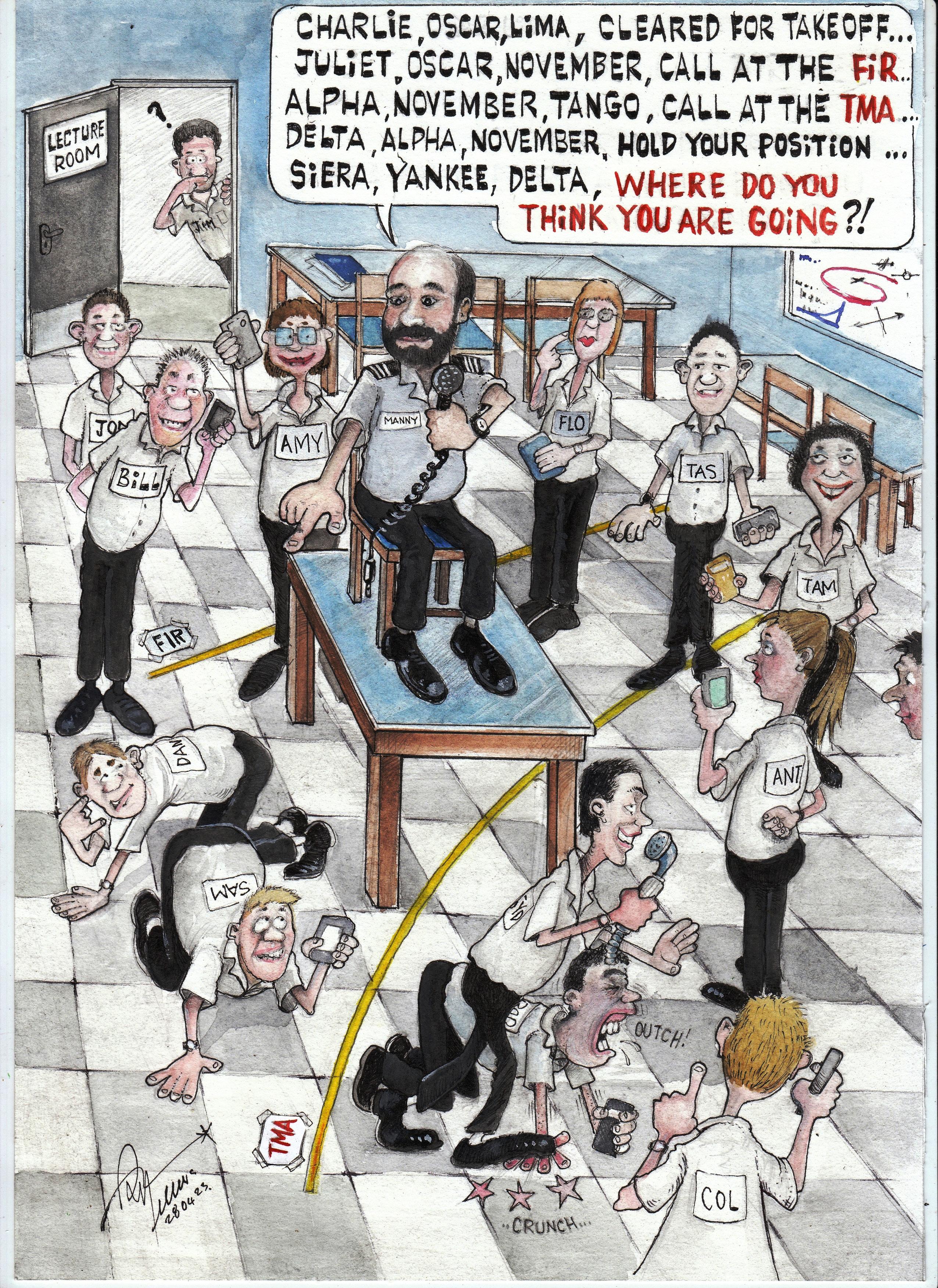
When I went to Rhodes University, at the turn of the century, the first thing that struck me like a blow on the head, was that most lecturers were extremely bad teachers. It was assumed that if they knew their subjects, they would automatically know how to teach them.
Nothing could be further from the truth. In fact, the opposite seemed true – the more a lecturer knew his subject, the less he was interested in learning how to teach it.

My geology lecturer was the worst. His style was to turn us all into human photocopiers. He would project a full page of closely typed stuff on to the screen and tell us to copy it word-for-word.
The result was that we were all writing so furiously that none of us absorbed a word he said.
So, as a lecturer, you must make sure your class can not only hear your words, but actually listen to them.
must flying instructors learn to teach
He would then conduct the lecture. He thought it was a good idea to keep talking until he estimated that about two-thirds of us had finished writing. At this stage, without pausing in his monologue, he would rip out the first typed page and slap on the second one.
This professor was so bad that I picked up the courage to speak to him privately. He was furious and the result was that I got appalling marks for the rest of the semester.
So must flying instructors learn
to teach? Well, yes and no. They have to pass written exams and a practical test on teaching specific subjects. But these are more about knowing your subject than having teaching skills.
Instructors also have a flight test – but this again is very specific to each exercise – it doesn’t test your ability to teach.
May 2023 26
Jim Davis congratulates the jovial Manny Ceh.
Anyhow, let’s start with how to deliver a lecture, if I’m lucky the occasional public speaker, or even university lecturer, may read it, scratch his bum and think, wow I learned something today.
First, a couple of things to bear in mind:
• You only convey 30% of information with words - the rest is visual – so you need aids and body language.
• Emotion is memory glue. Bring in stuff that’s funny, or sad, or frightening. My friend Gordon Rivas, while giving a talk on building, hurled a brick at the audience – that got their attention. Okay, it was made of polystyrene.
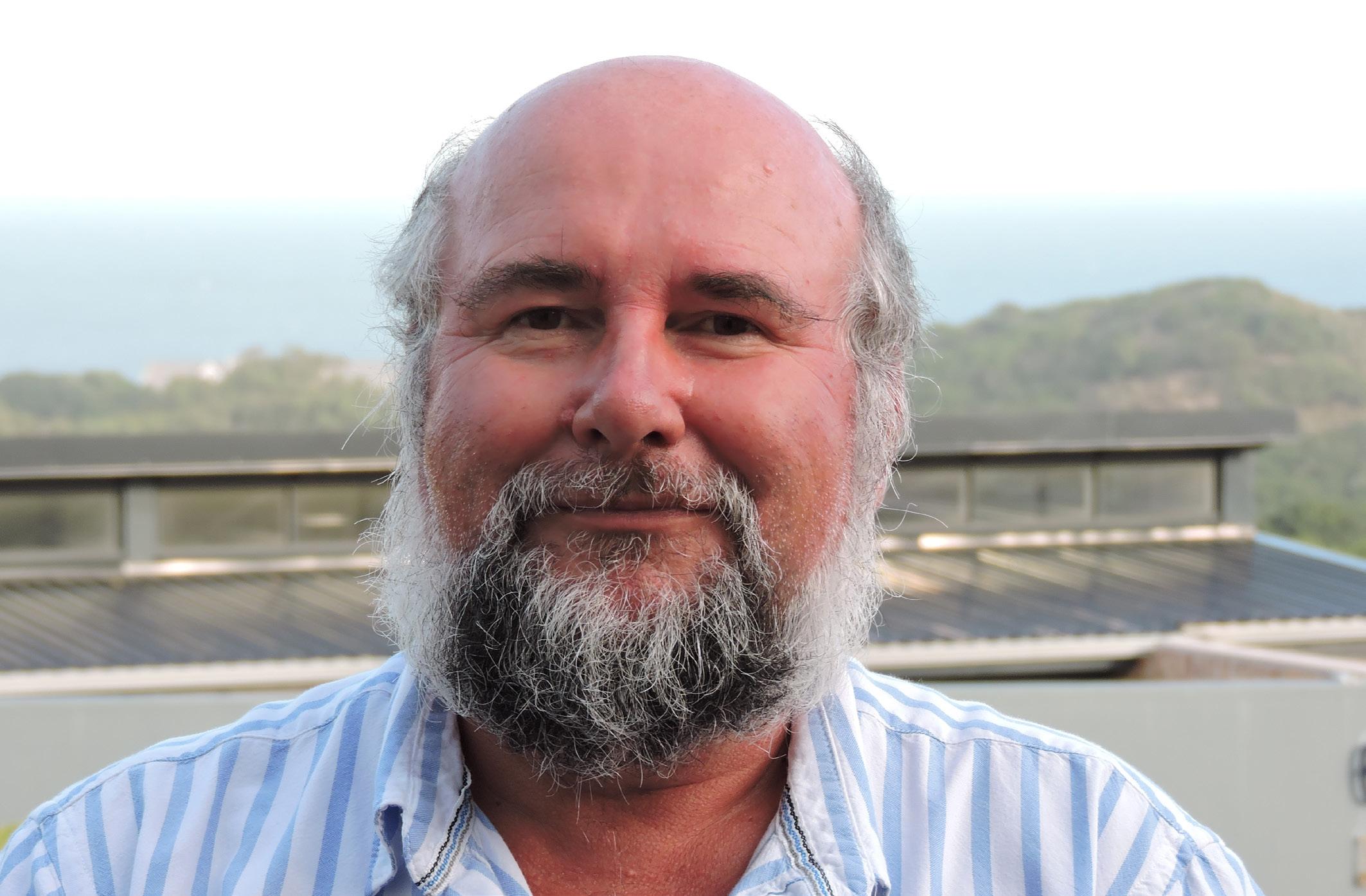
In a minute I’ll tell you a story about how Scully Levin grabbed everyone’s attention by using fear in a briefing. Remind me – and I’ll get to it.
Preparation is key. If you have to ask your audience whether they can hear – you haven’t prepared properly.
The same with seeing. It’s no use putting graphs and charts on the screen if they are too small and too detailed for people at the back to see.
STARTING THE LECTURE
So now you have established everyone can see and hear clearly, you can get on with the lecture.
• Introduce yourself. If the class doesn’t know something about you, how can they respect what you say? Start with something like this, “Good evening guys and girls. I am Captain Fred Oosthuizen, I have been flying Boeings for Safair for five years. I did my initial training in Cherokees and Cessnas at the Cape Aero Club. I’ll be doing all your met lectures.”
• Lay down some ground rules: “Before we start, remember that met lectures are every Thursday evening from 6 to 7.45 pm. We have a 15 minute coffee break after
May 2023 27
Manny survived instructing - and aged well.
45 minutes. You don’t need to take notes because I will give you hand-outs at the end. Please stop me and ask questions as we go along. Don’t wait to ask me privately afterwards. If you don’t understand something, others will probably be in the same position. Please switch your cell phones off now, and don’t refer to them during the lectures.”
• Give the lecture some context: “I’m going to start by telling you about the atmosphere. This is critical stuff for three reasons. First, the aeroplane is supported by the atmosphere. Second, you are physically and mentally dependant on it. And third, this is where all the weather happens. Here’s a diagram that shows the structure of our atmosphere.”
Now put up a slide and get into the guts of the lecture.
your job. It’s a simple sequence that you will use a hundred times a day, both on the ground and in the air. It applies to teaching, reviewing, reminding, correcting, briefing and debriefing. In fact use it every time you don’t know what to say or do.
Why should I use it? Because it puts everything in context for the pupil and it gives them a reason to be interested.
If a lecturer starts with, “As of 2023, by mole fraction (i.e., by number of molecules), dry air contains: 78.08% nitrogen, 20.95% oxygen, 0.93% argon, 0.04% carbon dioxide, and small amounts of other gases. Air also contains a variable amount of water vapour…” you have no reason to be interested – you don’t know what he’s talking about or why it should concern you. The lecturer has failed to involve you.
To get your interest, and involvement, he must give you the WHAT and the WHY.
THE WHAT WHY HOW RULE
Okay, dear instructor, lecturer, teacher, professor and everyone who wants to pass on info. Take a deep breath – while you weren’t looking, I have just given you the bedrock, the foundation of ALL teaching – the WHAT, WHY HOW rule.
First, I said WHAT I was going to talk about –the atmosphere.
Next I said WHY it’s important: It supports the aeroplane, it supports your life and it contains the weather. If I didn’t give you reasons for learning about the atmosphere, you’d quickly lose interest.
Finally, this is HOW it works. This is the body of the lecture.
The WHAT, WHY HOW rule is the very soul of
WHAT we are going to look at today is the earth’s atmosphere. (Yawn)
WHY because you need to know this in order to understand how aeroplanes fly, how their engines produce thrust, and how your body handles thin air at high altitude.
I recently read about a “rogue” Lear Jet, that flew slap through New York and Boston airspace. It later crashed killing the pilot, his young wife and their three month old baby girl.
How did this happen? Basically, aeroplanes love flying in the thin atmosphere at high altitude, and humans don’t – let me explain why. (are you still yawning?)
Ok, so now you have got the interest of your audience and they know what the lecture is
May 2023 28
he must give you the WHAT and the WHY.
about. The next step is to break it down into bitesized chunks – temperature, humidity, pressure and so on, then you do the WHAT WHY HOW on each chunk.
And after each chunk you recap, ask for any questions, ask if you may rub the board clean, and then do a WHAT WHY HOW on the next chunk.
It works like a charm.
And you use the same WHAT WHY HOW in the air – particularly when correcting mistakes:
WHAT happened to that landing? – it was too fast and too deep.
WHY? Because you let your downwind leg converge. This gave you a short base leg which meant you were too high on final approach.
HOW do we fix the problem? On downwind pick a distant point to aim at so we don’t converge. Do not use landmarks – they won’t apply to other airfields.

LECTURING AIDS
Okay, so we have to use aids to supplement words.
If you use Keynote or PowerPoint, be careful not to fall into the trap of using it as a shot-gun to pepper your audience with a bunch of facts. Use it as an aid to give your lecture context and structure.
Keynote and PowerPoint Tips
Use few words on screen:
Don’t be like my geology lecturer – shut up for a moment. Let your audience read for themselves. Less is more when it comes to text on your slides. Stick to bullet points, and limit yourself to 50 words per slide.
Avoid complex charts. Don’t put too much detail on charts and graphs. If you have a lot of data, simply use separate slides.
Don’t jump between media. If you need to play a video, show some images or share other media, put up a blank slide, or embed everything you want within your presentation.
May 2023 29
Magnetic model aircraft cut-outs are a great instruction tool.
Use simple transitions. Keynote and PowerPoint both have fancy transitions between slides. Most are distracting – just use hard transitions.
Use strong contrasts on slides. If you have a dark background, use a light font and visa versa.
Use smart placement. Highlight important information or place it centre screen where it displays prominently.
Quality counts. Make sure that your presentation is high-quality and free from errors. Proofread it for spelling, punctuation, grammar and accuracy of statements. A tatty presentation reflects on you as a person, and as a lecturer.
Avoid ClipArt. It seldom does your presentation any good – mostly it cheapens it.
Avoid clutter. Don’t mix colours, fonts and text styles. Use a clear and easy-to-read font such as Calibri or Arial. Avoid sand and handwritten-styled fonts.
Don’t read the slides. This is a common and annoying fault. Don’t do it. A slideshow should support what you’re saying –but it’s not a script. Your focus should be on them – not on the slide.
Testing your presentation. Test your presentation well beforehand. Make sure all your projection equipment is compatible and working properly.
trying to say, but by the end of the clip I was thoroughly confused.
I was fascinated by how he managed to stuff it up so badly – particularly as he was using a rather nice model of a twin. He was a greybeard, and obviously an experienced pilot, so what was he doing wrong? Actually, just two small things:
• He had the model pointing towards the pupil so left and right on the aircraft was not left and right for the pupil.
• He also used the words port and starboard. He would feather the starboard engine by pulling back the right pitch control – not the wrong one. It was so confusing I could cheerfully have killed him.
It would have been a pretty good presentation if he had simply pointed the model away from the pupe, and struck the port and starboard BS from his vocab.
Whiteboard/blackboard
This is a really useful aid. Many of the rules for making a good PowerPoint presentation apply, but it has the advantage of giving the pupil time to absorb stuff as you write or draw it.
For people like me, who are not good at sums, the lift formula can be quite daunting if it suddenly appears on a slide. But a good instructor can involve the class as he builds it up, step by step, in front of them, on a whiteboard.
OTHER AIDS
Model Aircraft
I have just watched a video of a “top” instructor in the USA explaining about multi-engine flying. Now, I’ve done my share of instructing on twins, so I have a reasonable idea of what he was
The same with a diagram of a carburettor, if the pupe sees it taking shape, in different colours, he can almost become involved in its construction.
Magnetic models: These are just about the most useful aids you can have. They are just small cut-outs that stick to the whiteboard with magnets. They are particularly effective when you move them about to show, for instance
May 2023 30
become involved in its construction
different angles of attack. You need at least seven – the left and right side views of an aircraft, plus the plan, and rear views, plus both sides of an aerofoil section. And finally a wind arrow
Bits of aircraft – or lawn mower: There’s nothing like having stripped instruments, vacuumpumps, pistons, alternators and starter-motors for the pupils to handle and examine. Use them to get the class involved in engines and airframes lectures.
Scully’s spinning lecture: I said that Manny’s radio lecture was something special – but so was Scully’s talk on spinning a Harvard. He was briefing half a dozen SAAF pupils before they were to do their first spins.
He had talked them through the HASELLL checks, throttling back the big, noisy radial, and easing the great rounded nose well above the horizon. He took his time to describe the smell of avgas, oil and exhaust smoke, and the way the aircraft felt as if it were balancing on a pinnacle as it started to shudder and rattle. Then WHAM! Your bone-dome smacks into the side of the canopy and you get a moment’s negative G as the nose swirls down and the dust rises from the floor and you feel a sickening lurch…
At this stage one of the pupes hurried from the classroom as he murmured excuse me Sir, through fingers clamped over his mouth. He was violently sick on the grass.
That, ladies and gentlemen, is an excellent briefing. j
QUOTE OF THE MONTH
A Twitter poster commenting on the enormous damage caused to the specially hardened Fondag concrete that is Stage 0 by the launch of the world’s most powerful ever rocket, the Space X Starship, wrote:

May 2023 31
“I can see the earth is being pushed down with all that force. So it's not a Liftoff, rather a Pushdown.”
Elon Musk
QOM
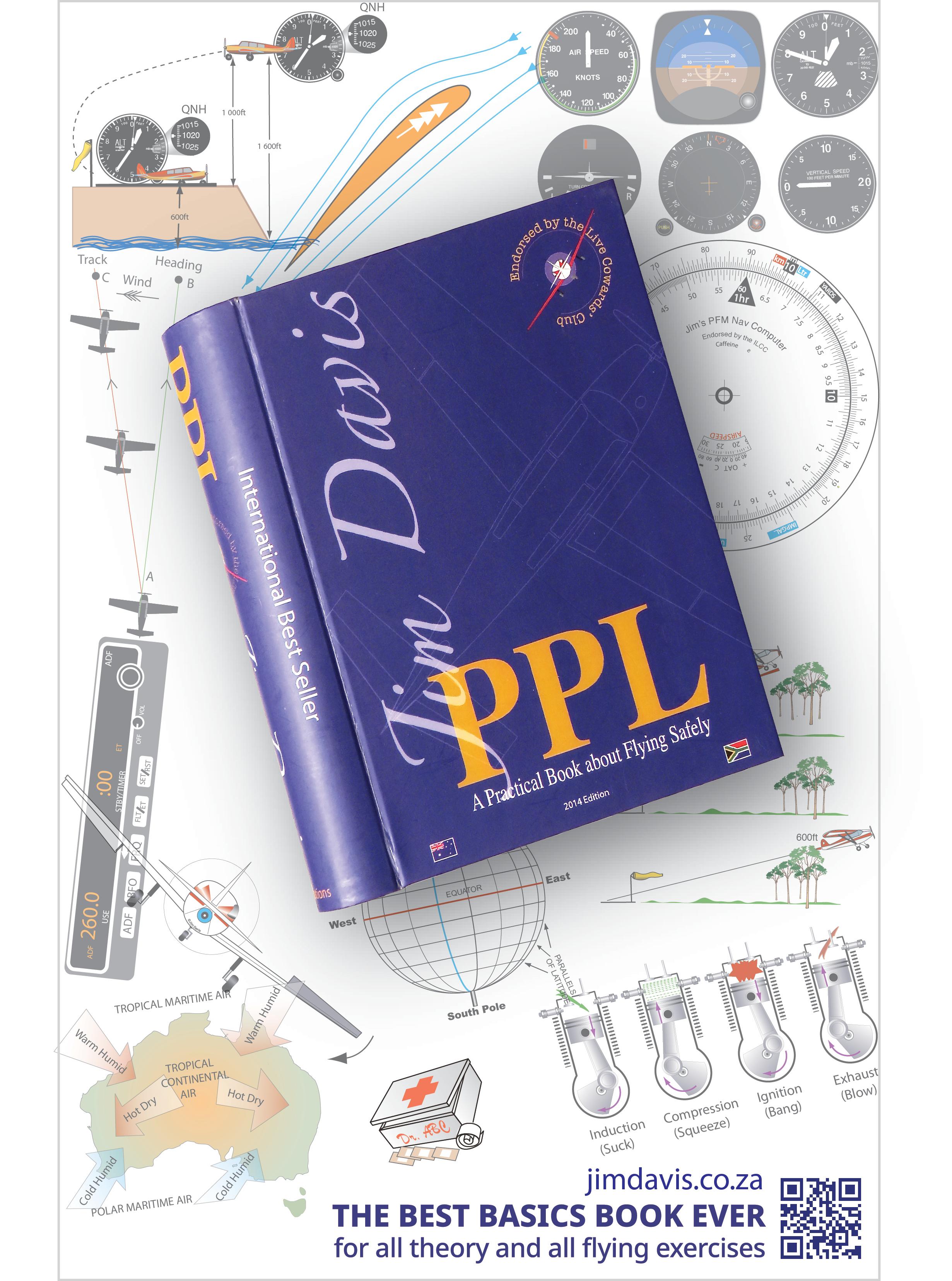
May 2023











R E G I S T R A T I O N F O R A E R O S O U T H A F R I C A 2 0 2 3 N O W O P E N E R A N W E
July 2023
National Airport, City of Tshwane, Pretoria Tshwane, www.aerosouthafrica.com S c a n t h e Q R c o d e t o r e g i s t e r E x p e r i e n c e t h e t h r i l l o f g e n e r a l a v i a t i o n a t A E R O S o u t h A f r i c a - r e g i s t e r n o w ! O t f e s C o n t a c t : + 2 7 ( 0 ) 1 0 5 9 9 6 1 5 0 | Z i n h l e D l a m i n i @ z a m e s s e f r a n k f u r t c o m IN CO-OPERATION WITH HOST CITY VENUE ORGANISED BY PARTNERS ENDORSED BY
6-8
Wonderboom
JMB AIRCRAFT
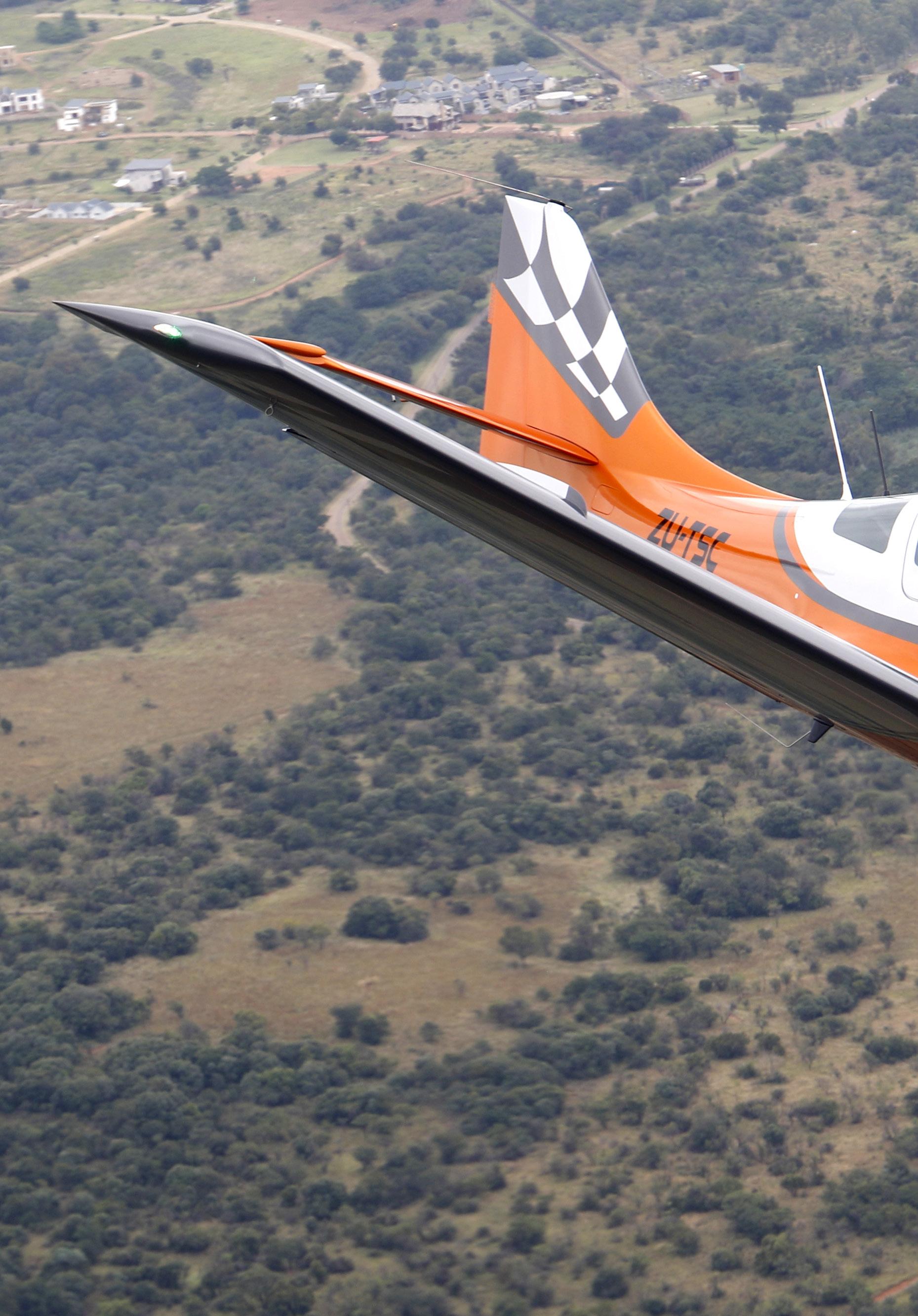
May 2023 34 FLIGHT TEST: JMB AIRCRAFT VL-3 EVOLUTION
VL-3 EVOLUTION
Guy Leitch with David Toma. Pictures Garth Calitz
Speed and small sexy bodies may be cute for supercars –but they can be a dangerous cocktail for inexperienced pilots. Beech had this problem with the V-tail Bonanza, Piper with its Malibu and Cirrus with the SR-22. The good news is that in time, all these problems were solved.
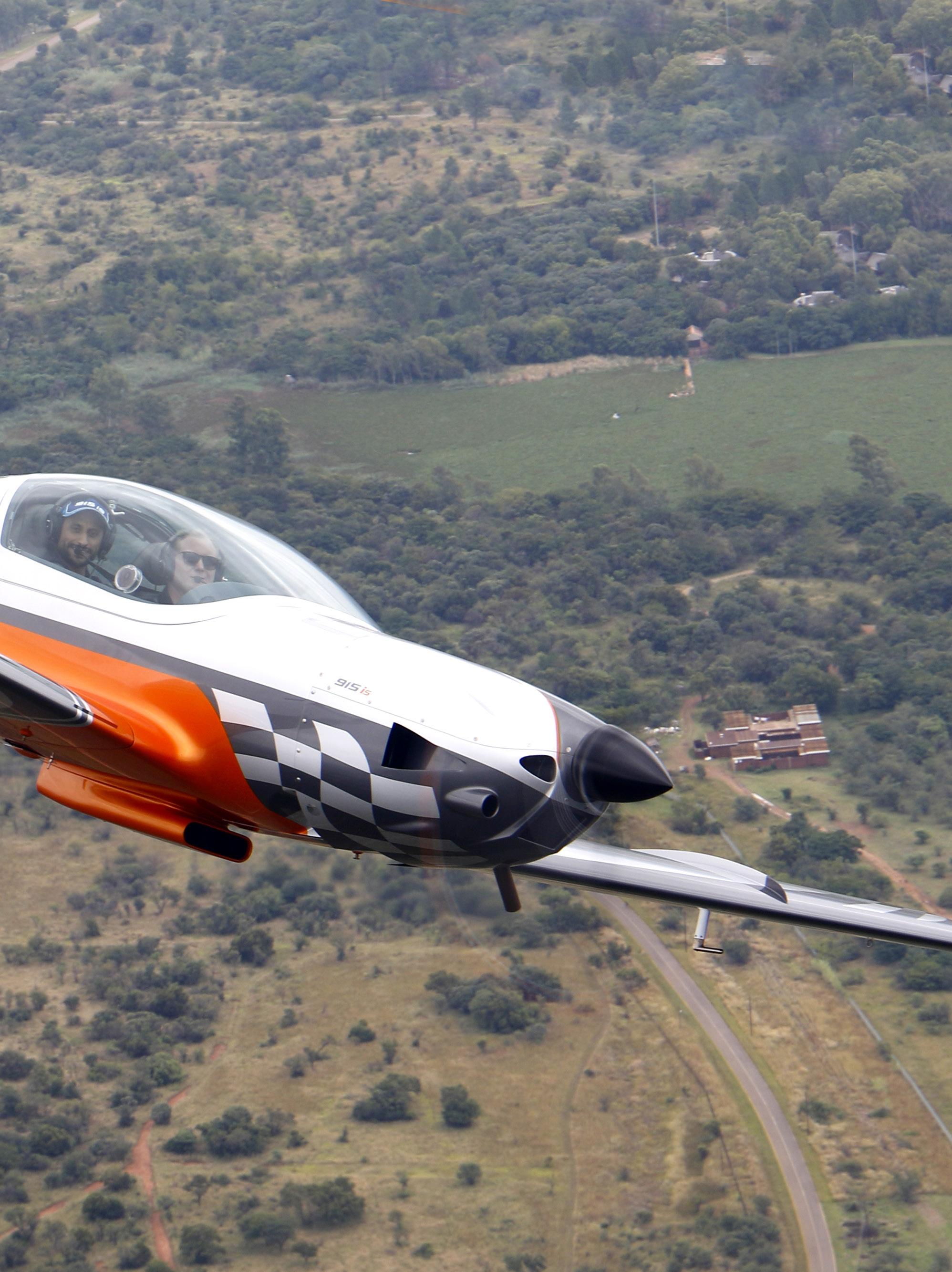
May 2023 35
The JMB VL-3 Evolution is a completly reworked version of the original VL-3 Flamingo. Note the nose down position of the elevator which suggests the aircraft needs further development.
NON TYPE CERTIFIED AIRCRAFT are tested to far lower standards than type certified aircraft and if a plane is just too fast for its own good – it is generally the unsuspecting pilot who will be the first to discover its limits. One of the most spectacular such events happened in South Africa in 2010 when a VL-3 broke up in flight –with fatal consequences.
It is a hopeful sign that the latest incarnation of the VL-3 is called the Evolution. Hopefully this glamorous little sportplane has evolved from its troubled progenitor.

I have some personal experience – in 2010 I was flying the Presidents’ Trophy Air Race when competitors ahead reported a plane having gone down after breaking-up in flight.
The crew of a VL-3 had put the nose down to descend to a check point. The aircraft behind reported large bits falling off. The CAA accident report found that the published Vne had been exceeded, causing flutter.
There was clearly a problem
The original Aveko VL-3 has a scary history in South Africa – and indeed around the world. A look at its accident stats shows 28 significant accidents (including such minor items as a nose gear failure in South Africa) yet with 30 fatalities. With more than one fatality per crash, some may consider it a dangerous little beast.
This crash caused much controversy about the real nature of Vne – the Velocity to never exceed. Citing this tragedy, Peter Garrison wrote a seminal piece on Vne, which should be required reading for anyone who wants to fly a fast little plane – especially a non-type certified one. The title is telling: “Are you feeling lucky?” https://www.flyingmag.com/ technique-proficiency-technicalities-are-youfeeling-lucky/
May 2023 36
The heart of the new VL-3 is the current Rotax 915iS which gives an almost 200 KTAS cruise at oxygen altitudes.
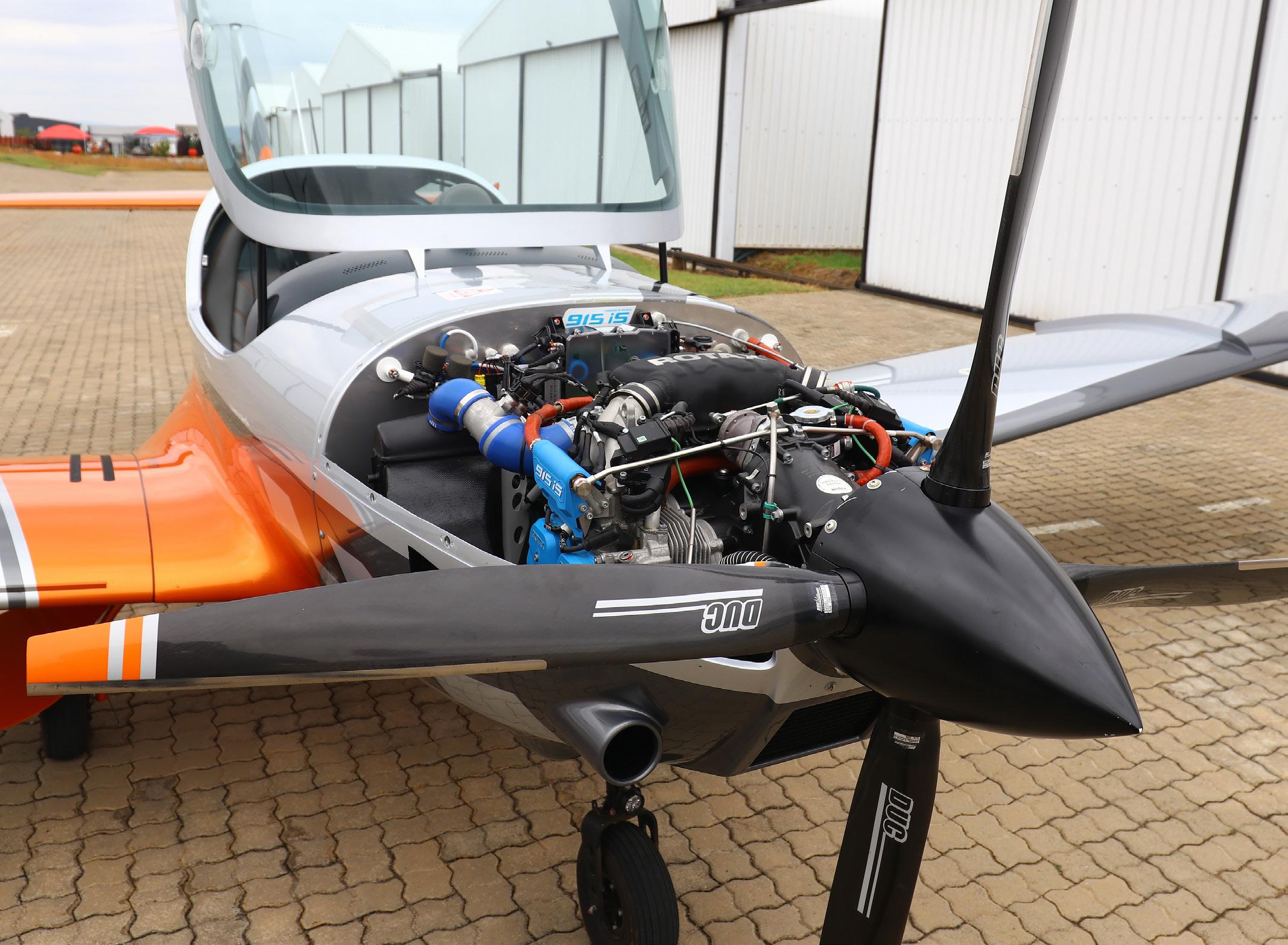

May 2023 37
Black constant speed 4-blade propellor gives plenty of ramp presence.
Small wing planform and large radiator scoop evident.
Peter Garrison wrote; “An airplane was descending toward a turn point in a valley when the pilot of a following airplane saw what appeared to be paper scattering behind it. An instant later, a shattered wing separated from the fuselage, falling to earth a hundred yards from the main wreckage. The airplane was a Czech-built Aveko VL-3 Sprint, an NTCA (nontype-certificated aircraft) that bills itself as the “world’s fastest ultralight.”
After the race crash, the Vne for the VL-3s in South Africa was reduced from 165 KIAS to 145 KTAS – just about its straight and level maximum speed. And most importantly, note the shift from Indicated to True Airspeed.
There was clearly a problem – so Aveko went back to the drawing board. But the doubts about the safety of little sports plane had set in, and
Aveko went bust. Then two intrepid Belgians brothers, who were distributors of the VL-3, bought the factory. The VL-3 was redesigned with more carbon fibre to make it stronger and stiffer. Essential aerodynamic changes were made – the most obvious of which is a balance horn for the elevators.
The manufacturer says that the design has been thoroughly re-validated by EASA and the Vne is now back at 183 Knots Indicated. Remarkably, the JMB website claims that the VL-3 has been tested to be flutter free at 450 km/h =240 KTAS. Sounds good, but the rub is in old the old conundrum of Vne as a True or Indicated air speed. My whizzwheel confuser says that at a typical South African ISA plus 20 at FL200, 183 KIAS is 260 KTAS. So hold and below! - the factory is saying that they have not in fact tested it to the real VNE – which is after all a True airspeed.
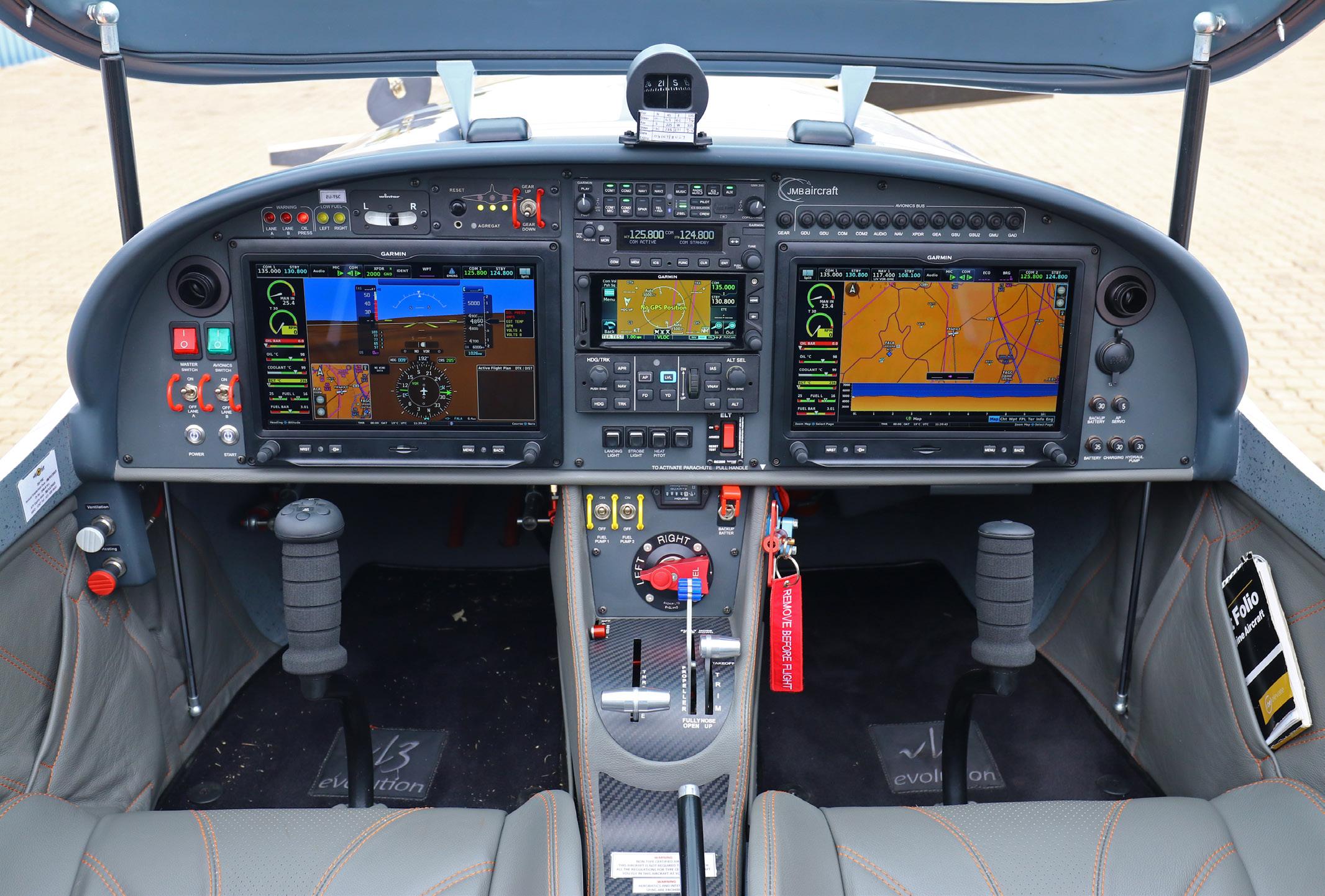
May 2023 38
The design has been thoroughly re-validated
Instrument panels come standard with Garmin 3GX and GFC autopilot - a key safety feature.
For additional insights former EAA Chairman David Toma writes; “So the never exceed speed (VNE) is a limit indicated airspeed that the pilot is to not exceed, but it isn’t always for the reasons that we think. Here are the constraints that a designer should be considering when specifying the aircraft’s VNE.
“The first would be inertial loads that could be imposed on the airframe during gust loads as specified by the chosen certification specification. Such loads would require a higher dynamic pressure if we are to look at the worst-case scenarios and this can possibly lead to the assumption of flying closer to sea level and hence one could use indicated airspeed directly for this constraint.
“The other constraint would be flutter, which as we all know is dependent on true airspeed as compared to indicated. Lastly one must
not forget about acceptable handling qualities. If beyond a specific airspeed the aircraft has unacceptable handling qualities, then a new applicable limiting velocity is specified. Having considered all the variables, a decision is to be made as to how to communicate this to the pilot. The easiest choice is through an airspeed indicator and an indicated speed is chosen for the VNE. However in cases where an aircraft has a high service ceiling, one indicated airspeed becomes rather limiting and a table of VNE speeds is given for varying altitudes. That also saves the pilot from continuously whipping out the whizz wheel as they climb in order to calculate a true airspeed.”
This makes JMBs decision to turbocharge the VL-3 dubious. The original 912 produced around 75 hp at a typical cruise altitude of FL075, whereas the Rotax 915iS is good for

May 2023 39
Cockpit is wide enough not to rub shoulders and seats reclined for a laid-back experience.
All the controls and instruments are in easy reach
135 hp to 15,000 ft. Since Vne is actually a true airspeed, it is high altitude flight that is the most dangerous. I fear the highly turbocharged 915 will test the 183 KIAS Vne.
So let’s see how far the original Aveko VL-3 has come in its latest incarnation – the JMB VL-3 Evolution.
The composite surfaces are mirror smooth and JMB has moved away from the earlier version’s boring white paint schemes to elaborate colour schemes glistening under a clearcoat varnish. The 50 shades of grey with a colour that can only be described as Lamborghini orange, sets this plane apart.
The large bubble canopy is front-hinged. Swinging it open reveals a beautifully detailed and finished interior.
On the ground
The subject of this report is ZU-TSC, a 2022 VL-3 Evolution which has Rotax’s 915iS 141-horsepower powerplant.
On the apron in front of the large hangars at Jo’burg’s Eagles Creek airfield, the overriding impression is that the VL-3 is small, short and sexy – it looks like a shrunk Lancair Legacy. Apart from its small stature, what is also evident is that the quality of the fit and finish are to supercar standards.
Giving it a ramp presence, like a sport’s cars fat takkies, is no less than a four blade, constantspeed, Duc propeller with, unusually for Rotax, a traditional hydraulic hub. The prop’s governor is controlled via a blue lever on the throttle quadrant. (Electric constant-speed props are an option).
As befits a sexy little hot ship, the wings are small. In American units, just over 105 sq ft, with a 14 lb/sq ft loading. Wingspan is just 27 ft 7 in. (or 8.44m for South African hangars). Each wing has a 70-litre fuel tank, fitted with flush lockable lids. For an engine that can swallow more than

May 2023 40
Main gear legs retract diagonally into the fuselage - like a Cessna single.
30 litres of fuel and hour, 70 litre tanks are too small. The local agent, Warren Massey, says that South African models will have a gross weight increase from the EASA LSA 600 kg limit to 750kg. This will enable 160 litre tanks and a decent load carrying ability in the cockpit, but for any useful range, 200 litres would be better still.
For low-speed handling, the wings have split flaps over two-thirds of the trailing edge. Many manufacturers have gone with slotted, or even the complexity of Fowler flaps for greater aerodynamic efficiency. JMB uses a simple manually operated split flap to achieve the same purpose—and it gets results by making the flaps gigantic. The split flap has the advantage of doing without worm gears, draggy external hinges, or other complex electro-hydraulic mechanisms. On the VL-3 the flaps extend to a barn door 55 degrees. Great for drag – but they require careful handling for a go-around. Fortunately the flaps are operated by a single large handbrake ‘Armstrong’ lever which makes them quick to retract.
Climbing into the cockpit requires a step up onto the low wing, which has a walkway with thin non-slip strips, presumably to keep the wing surface as smooth as possible. You can then step over the cockpit sill and with a bit of dexterity, by leaning on the front edge of the turtle deck, avoid having to step on the beautiful grey stitched leather seat squabs.
sculptured bucket seats are reclined

The sculptured bucket seats are reclined, with firm but good lumbar support. Once seated, the 45-inch cockpit seems surprisingly wide, so you don’t have to overlap shoulders. The seat doesn’t adjust fore or aft, so setting the recline angle, then adding or subtracting cushions, is the only way to alter the seating position. This is a plane you sit in, rather than on. Thanks to the reclined seating position the top of the panel is roughly at the pilot’s eye height – so the view forward is not great. The nosewheel retracts rearwards into a large tunnel that takes up space in the footwell.
Two NACA scoops supply fresh air to the cockpit via eyeball vents, and glider type pop-out
May 2023 41
Latest versions have a small baggage bay door - baggage area is fair for overnight bags.
vents on the sides of the canopy are great for an air blast on hot days.
A whole airframe parachute is located ahead of the canopy, and a prominent red handle, bolted, in what seems something of an afterthought, to side of the centre pedestal, fires it.
All the controls and instruments are in easy reach, despite the reclined seatback. Two large Garmin G3X displays fill the panel. An optional extra is a neat feature to have: a wide-angle video camera on the belly showing all three undercarriage legs so you see the actual gear legs and wheels. Its one-upmanship on a Cessna 210’s wing-mount mirrors. Next to the surprisingly small gear toggle switch, oddly located at the top of the panel, there are also the usual ‘veggies’ – three green undercarriage up or down lights.
The undercarriage is electrically controlled and hydraulically actuated. Looking from the front, the size of the landing gear doors is apparent –and they do not align with the airflow but rather form a large airbrake. Again a reason to treat go-arounds very cautiously and to make sure you clean the gear up promptly – especially considering its slow transition.
Something to note is that the aircraft has such a high power to weight ratio that is also coupled with low pitch forces that I don’t foresee a problem for a go around in the dirty configuration. The 182/206/210 Long body Mooney that require a lot of trim changes with flaps and have higher control forces, end up throwing your nose skywards if you simply slam the throttle forward for the go around without anticipating the required trim change.
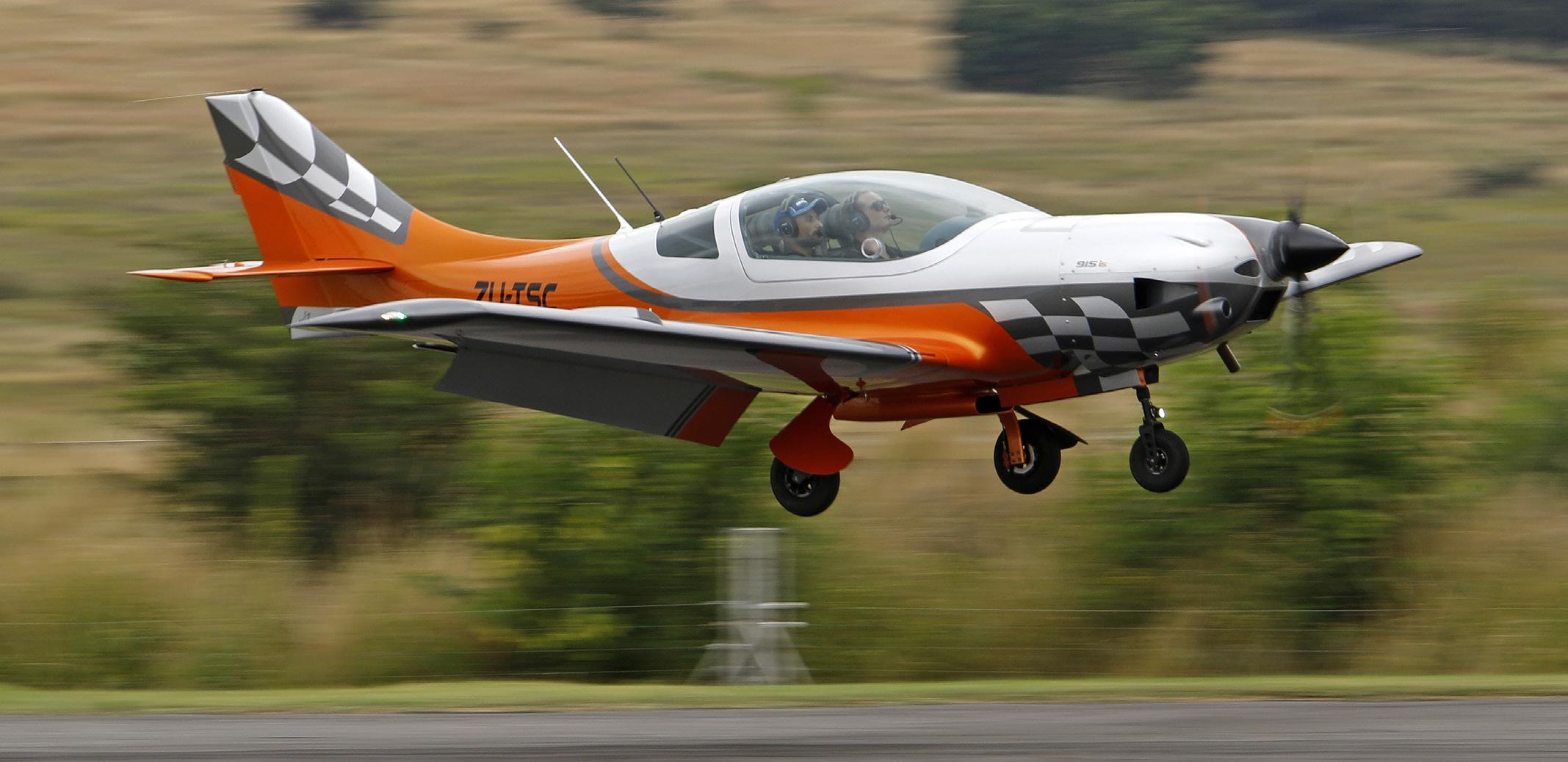
Flying the VL-3 Evolution
For our flight test, David Toma flew with the factory demonstration pilot Joren Vermeulen (he’s Belgian, not a Saffer). Starting the 915 takes some practice as the design philosophy is completely different compared to the more traditional Lycosaurus engines. Here there are lights that are used to communicate with the pilot as to how the engine is running and if there is any exceedances or failures. Flip on the two ignition lane switches and the two fuel pumps and turn the ignition key. The Rotax springs readily into life, and, compared to earlier engines, has less clatter from the prop gearbox, thanks to its larger impulse damper.
May 2023 42
With full flap and gear down the VL-3 can descend spectacularly. Touchdown is at a commendably slow 40 knots
elevator authority is excellent
Despite the weight of the complex engine, turbo and intercooler in the nose, and the forward CG as we were two-up with lots of fuel and no baggage, the VL-3 is still light and easy to taxi with its tricycle gear and nose wheel steering so there’s seldom need for differential braking. The turn radius is tight, but the small wheels may be harsh on a rough taxiway.
Runup is standard Rotax 915iS: the computer performs a diagnostic test of both ignition systems by toggling the lane switches.
Whilst it’s a turbo, you shouldn’t just bang the throttle open even though the engine management system limits boost automatically. As you get to full throttle, the turbocharger limits manifold pressure to usually around 47 inches, and this occurs midway during the take-off roll. Using a brisk but progressive application of power, take-off acceleration is impressive considering that we had 37° of the massive split flaps deflected. You can definitely feel that it wasn’t just Eagle Creek’s strongly downhill Runway 08 that got us airborne in under 200 meters. Above 82% power the 915 goes to auto rich and has a huge thirst for such a small engine, sucking up to 46 litres per hour. This is something to keep in mind when flight planning
for a long leg as a reduced power setting, and thus speed, is required to achieve the required range.
David Toma reports: “The low seating position heightened the sense of speed down the runway. With a bit of back pressure on the stick, we were airborne. It was immediately apparent that stick pitch forces are noticeably light – a common feature of non-type certified aircraft. Those used to clunky Cessnas will find themselves having to guard against pilot induced oscillations.
We were almost instantly at Vy (best rate) climb speed of 79 knots, indicating a healthy 1,500 fpm over the runway end. It was natural to lower the nose to 100 KIAS and still be climbing skyward at over 1000 fpm. Gear retraction takes about four seconds.
The graphics on the large Garmin G3X EFIS make situational awareness a treat. The two large 10.6-inch screens dominate the instrument panel. There is even an option for Traffic Awareness System (TAS) – like TCAS but without the automatic instruction to both aircraft and, importantly for the soon to be mandatory ADSB.
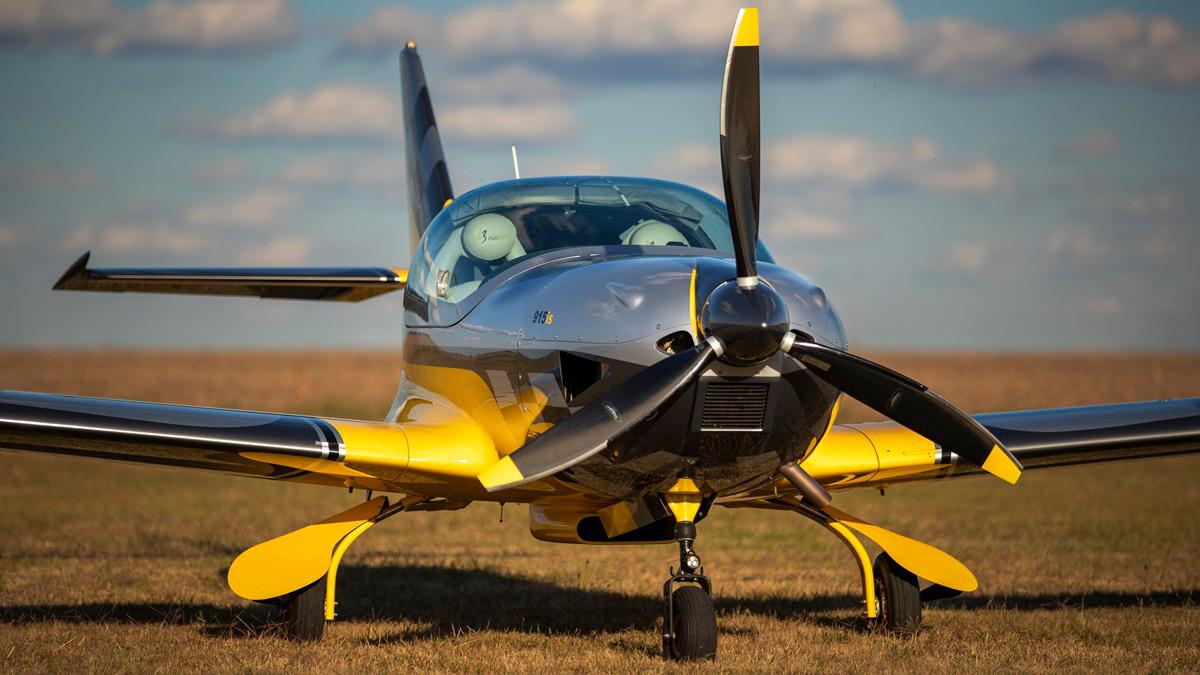
May 2023 43
Airbrake effect created by the gear doors is evident in this picture.
A huge benefit is the intelligent and smooth Garmin GFC500 integrated auto-pilot that can be programmed to maintain altitude, direction and attitude and even fly a coupled approach. A particularly useful feature on the Garmin GFC autopilot is to simply push the blue “level” button which means the plane flies hands-off straight and level, leaving the pilot free to snap that photo for the memory bank. If you plan on eating lunch rather, then set the autopilot in nav mode including vertical navigation and watch how the aircraft not only corrects for the prevailing winds but also sets up a perfect descent to have you exactly at the joining altitude as you reach your destination!
The VL-3 is true to its looks in terms of sporty handling. Pitch is significantly lighter than roll, particularly at high speeds. David Toma notes, “The ailerons are ‘RV10 stiff’, which to me serves as a reminder of the speeds that are being achieved and that you must be mindful of large control deflections.”

The ailerons use carbon fibre push rods, and it was immediately apparent that the breakout
forces are low, and the roll response is still crisp, yet without twitchiness. Overall control harmony is fair, and the bubble canopy makes for reasonable visibility while manoeuvring.
Even though we were below the Johannesburg TMA, which is far below the aircraft’s best operating altitude, we explored the VL-3’s speed capability at 7000 ft. The EFIS displays power as a percentage of total rated power, and at around 82%, it changes the engine management from producing best power to best efficiency. Thus, at 82% power, the fuel burn is 9.2 gph, while at 80% the fuel burn drops to 7.4 gph. The G3X shows true airspeed and at 78% power, burning 34 litres/hour, we saw 170 KTAS. Throttling back to 55% power we saw 150 KTAS whilst sipping 18 litres! This possibly explains why 140 litres was selected as an acceptable fuel quantity.
Having been lied to many times before by NTCA manufacturers that seem to ignore large static errors in their selected systems; I took it upon myself to fly a standard position error calibration at 139 KIAS which showed 160 KTAS at 7000ft. The result of this test was a static error of only 2 knots in the VL3! This correlates to the figures shown in the POH for this speed which meant that you can get rid of the normally required pinch of salt when it comes to some of the published performance figures.
I tested the control harmony and roll response by cranking it over into about a 75-degree bank. It effortlessly maintained height, even though the stall warning beeped occasionally. With a full throw of the stick, a 150-degree roll reversal was smooth, with little tail wag.
Slow speed handling was found to be textbook thanks to the stall strips and wing fence. I pulled the power back, thankful that liquid cooling vastly reduces the chance of shock cooling the engine. With the flaps and gear up and the nose surprisingly high, the stall break came at 55 knots. I held the wing in a deep stall and tried to keep it straight with rudder until it would take no more abuse and gently dropped the nose. The recovery just required relaxing the backpressure on the stick.
May 2023 44
Nosewheel has direct steering which makes for good ground handling. Tyres are sized for tar runways.
With gear down, full flap and power off, the airframe shook until the stall break came at 40 knots—with a very mild and, thanks to inbuilt stall strips, a predictable wing drop. We recovered with less than 500 feet of altitude loss. Even deep in the stall, the elevator authority is excellent. Both recoveries are standard with the caveat that it’s easy to unintentionally exceed flap speeds, from experience one quickly gets accustomed to the required pitch attitude that would keep you away from such an exceedance.
Returning to Eagle’s Creek, we joined a Left Downwind for 26. Despite the cleanness of the airframe, slowing down for the circuit turned out to be surprisingly easy. The VL-3 does however have surprisingly slow gear extension and flap deployment speeds, and I anticipated we’d have to descend early and cut the power to slow enough to meet the limitations of 81 knots for gear and 67 knots for flaps. But at a full 55 degrees, the wide chord flaps, large and draggy gear doors and four blade, constant-speed prop were effective aerodynamic braking. Joren impressed me by arriving almost overhead the runway numbers at nearly 1000 ft, and with everything hanging out we fell out of the sky like a proverbial grand piano, and still made it onto the first third of the runway with just a small squirt of power to stop the precipitous descent. Even more impressive was how stable the VL-3 was with the airspeed happily sitting between 65 and 70 KIAS. I got to try one of those approaches at Aviators Paradise and still remain very impressed with both the performance and how low the pilot workload was throughout the manoeuvre.
As the semi-liquid-cooled Rotax isn’t subject to shock cooling, pulling the power back to idle on downwind is fine and we were able to extend the gear and full flaps in plenty of time. Trim changes with 15 degrees of flap were small.
Pitch changes due to further flap deflections all the way to 55° were easily compensated for initially thanks to the light control forces but I am glad to report that there is sufficient pitch trim authority in order to allow for hands off flying in the full landing configuration and at the desired reference landing speed. This is another one of those things that seems to be ignored by several other NTCA manufacturers.
With its light weight and sub-40 knot stall speed the VL-3 can easily be stopped within 100 metres if you work the big Beringer disc brakes hard enough to almost slide the tyres.
Conclusion
This is a plane built for speed –and to go fast economically. It is amazing that it has a cruise speed four times faster than its stall speed,. JMB Aircraft claims the Rotax 915-powered VL-3 has a top cruise of 199 KTAS at 18,000 feet, but 170 KTAS at FL085 will be a more typical set of cruise numbers.
We look forward to new aircraft having an increased max all up weight of 750 kg. if this enables 200 litre fuel tanks, the range will be commensurate with its cross country performance.
New aircraft prices range from $205,000 for a Rotax 912 powered VL-3 with basic analogue avionics to a wallet busting $350,000 for a 915-powered version with dual Garmin G3X primary flight display/multifunction displays, an IFR-capable GPS navigator and many nice to have gadgets. I guess when one looks at the pricing on a new C172/182, a Cirrus or a Diamond, the price appears rather reasonable but R6.3m for a two place NTCA will take some getting used to.
May 2023 45
Slow speed handling was found to be textbook
j
DEVELOPMENT AND SAFETY
THE VL-3 WAS DESIGNED by Vanessa Air in 2004 and built by Aveko in the Czech Republic until 2011.
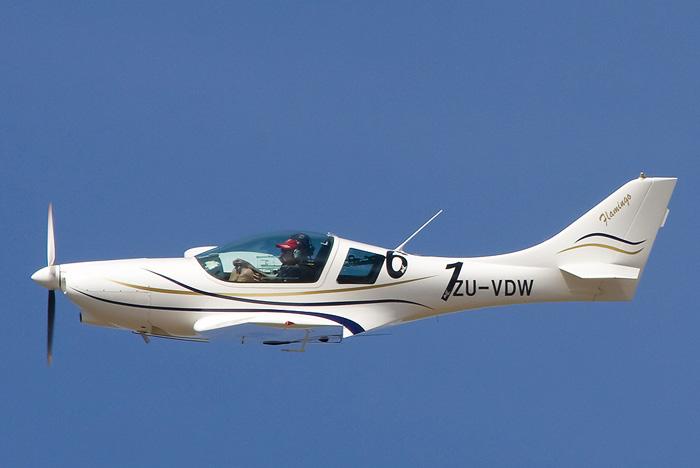
The Guisset brothers, Jean-Marie and JeanBaptiste, were dealers in France and Belgium for Aveko. Driven by a passion for flying, the brothers could at the time claim to have sold more than 85% of the aircraft produced by Aveko. And they sold a lot. South African agent Warren Massey says there are more VL-3s flying than Slings.
After the parent company went bankrupt in 2012, the Guisset brothers acquired Aveko. Shortly after, they started to upgrade the aircraft, doubling down by pushing the aircraft to fly even faster. Three years later in 2015, JMB began fully producing the fuselage and wings, work which had previously been subcontracted. Today, JMB Aircraft is in full production at their Chocen, Czech Republic facility.
The VL-3 is approved under EASA part 24 standards. It was tested in collaboration with the Czech Aerospace Institute to ultimate loads of up to +15Gs and -8Gs. To address Vne fears the VL-3 is has been shown to be free of flutter until 240 KTAS. The VNE is however limited to 184 KIAS. At max power it claims to have a climb of over 2000ft/min and a sea level cruise of 160 knots CAS.
All VL-3 aircraft now come standard with autopilot. As noted in the flight test review, if you lose control you can activate the blue button levelling function and the aircraft will
automatically correct from an unusual attitude and fly straight and level.
The Angle of Attack indicator will give you a warning if you approach the critical angle of attack before stalling but if the aircraft does stall, the VL-3 is equipped with stall strips located on the leading edge close to the fuselage, to improve controllability. It also uses fences to stop spanwise flow.
The VL-3 Evolution is available in two options in South Africa:, the 100HP Rotax 912, with either carburettors or fuel injection. With a Maximum All Up Weight of 600 kg, this has a useful load of 290kg and it’s best cruise at around 8000 ft. The Rotax 915 option has a 50 kg payload penalty giving 240 kg useful load, depending on empty weight, but claims 199KTAS at 18,000ft. The aircraft is now available on order with max all up weight increase to 750 kg. j
May 2023 46
JMB caims that the JL-3 Evolution is vastly improved from the earlier VL-3. This is the aircraft that fatally broke up in flight. Pic Bruce Perkins.
pushing the aircraft to fly even faster
Specifications and Performance Model

VL3 915iS

May 2023 47
SPECIFICATIONS AND PERFORMANCE Base price $235,000 Price as shown $330,000 Powerplant Rotax 915iS, 142 hp Recommended TBO 2,000 hr Propeller Woodcomp 3-blade Length 20 ft 6 in Height 6 ft 7 in Wingspan 27 ft 7 in Wing area 105 sq ft Wing loading 14.2 lb / sq ft Power loading 10.5 lb / hp Seats 2 Cabin width 45.25 in Empty weight 862 lb Max gross weight 1,500 lb Useful load 638 lb Payload with full fuel 390 lb Fuel capacity, std 37 gal Takeoff distance, ground roll 600 ft Rate of climb, sea level 2,000 fpm Max TAS at 18,000 ft 199 kt Landing distance ground roll 600 ft Range 800+ nm

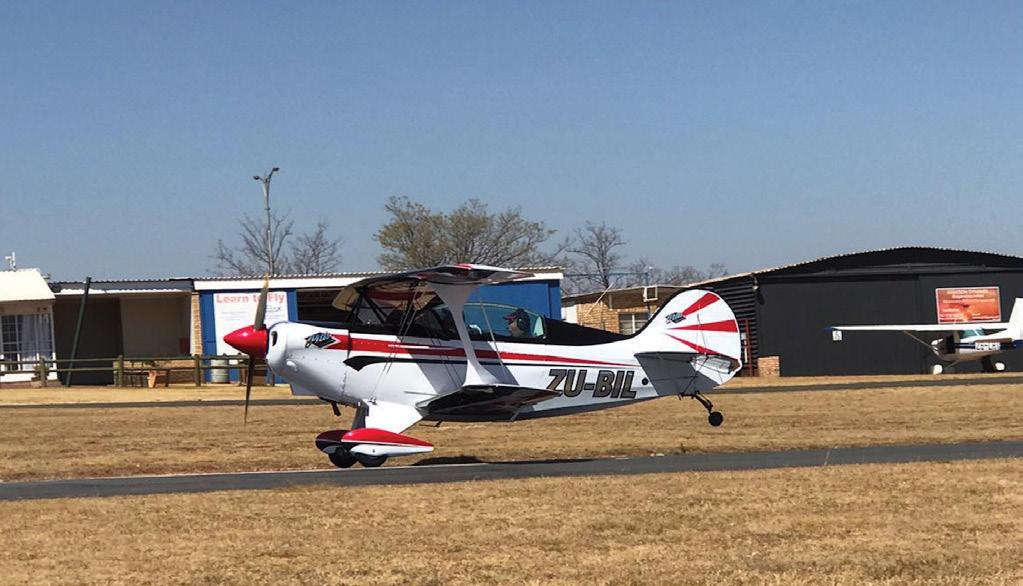

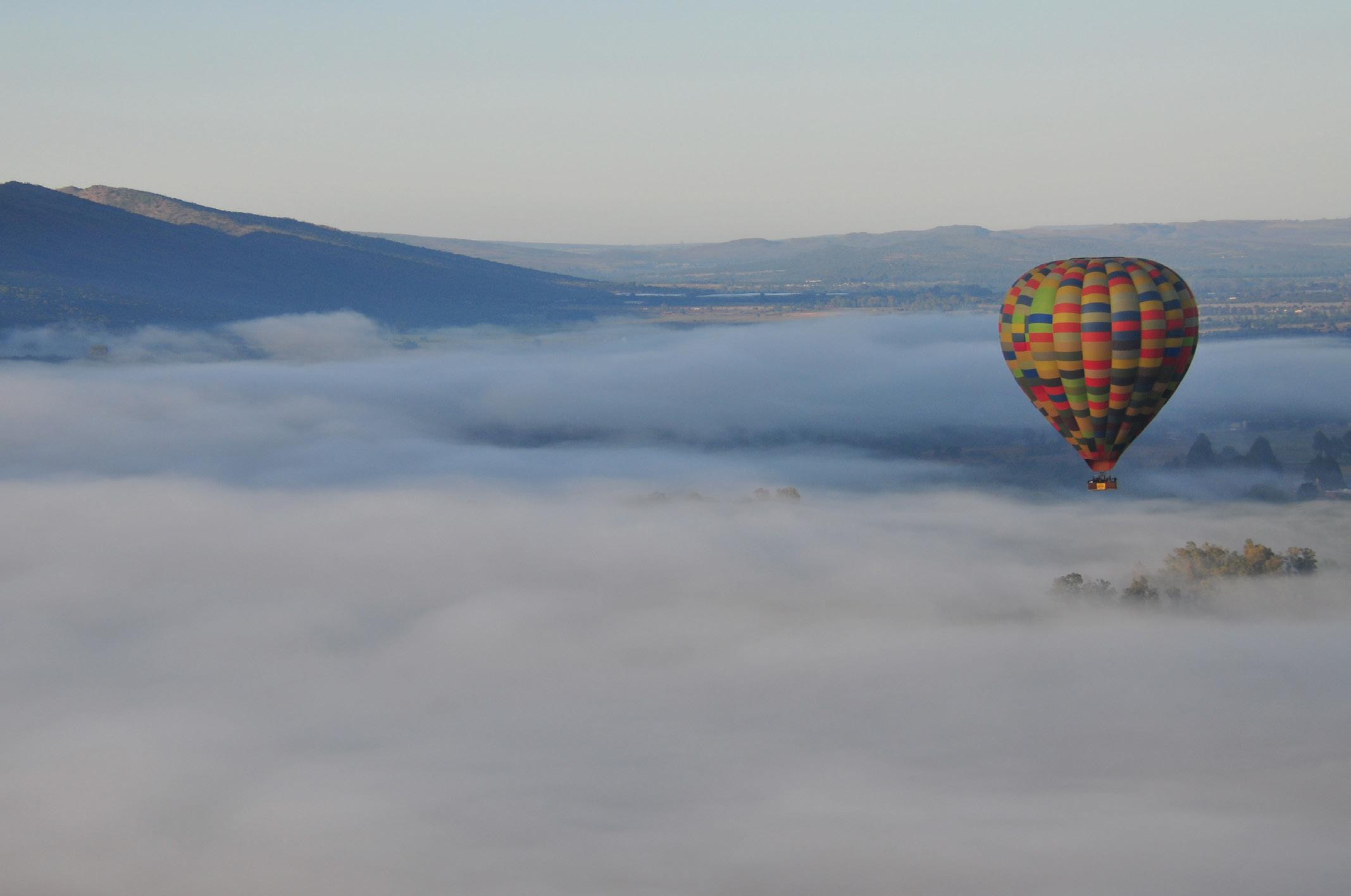


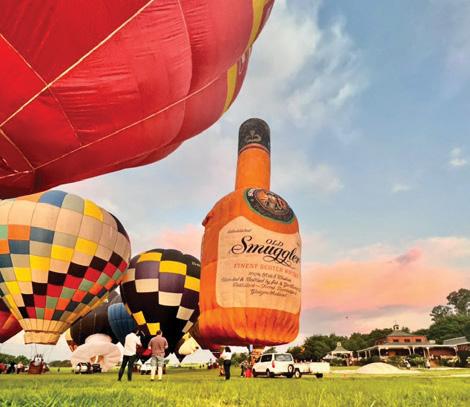
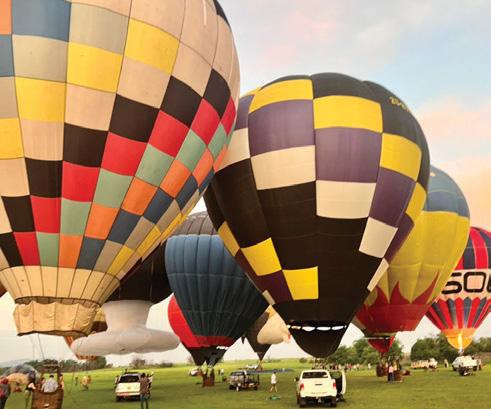
May 2023 48 WE NOW OFFER TAILWHEEL TRAINING www.alpiaviation.co.za Dale de Klerk Cell: +27825563592 Fax: 0866058948 Skype: dale_de_klerk Email: dale@alpiaviation.co.za FROM NPL THROUGH TO CPL LEARN TO FLY WITH US Bill Harrop’s ‘Original’ Balloon Safaris +27 83 457 3402 or +27 83 443 2661 / 2 • email: website@balloon.co.za • www.balloon.co.za Balloon Pilot Training Facility PACKAGES: • Magalies River Valley Scenic Balloon Safari • Game viewing at Mabula Private Game Reserve • Groups • Team Building • We fly from the beautiful Magalies River Valley in the Cradle of Humankind World Heritage Site. Do it in style!
RUDOLF ERASMUS and four friends were flying in his Baron 58 when he felt something cold under his shirt near his hip.
He assumed his water bottle was leaking but he glanced down just in time to see a Cape Cobra’s head disappear under the seat. “I had a moment of stunned silence,” he said. “It was more as if my brain did not register what is going on. It was a moment of disbelief, I think.”
He told controllers he had “a bit of a situation” and landed at Welkom Airport, which was his nearest. The five occupants jumped out without getting bitten and a tentative look saw the snake curled under his seat.
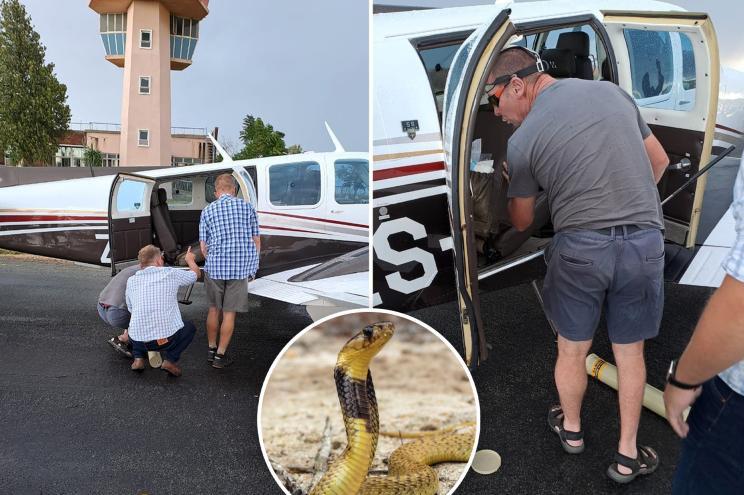
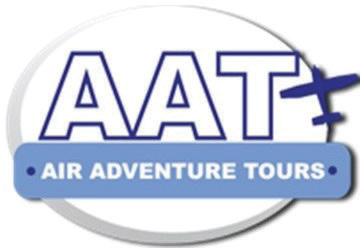
The story didn’t end there. While he was waiting for a snake handler to capture it, the reptile disappeared.
Engineers who travelled from Ferreira Aviation in Bloemfontein spent two days stripping the aircraft but couldn’t find it. He continued his flight gingerly.
May 2023 49 Prices from R33 850 ex Johannesburg Oshkosh AirVenture 2023 SA Flyer 2023|05 21st July to 1st August 2023 CONTACT: Neil: +27 84 674 5674 email: info@airadventure.co.za Website: www.airadventure.co.za CATERED CAMPING TOUR TO THE WORLD’S GREATEST AVIATION EVENT! NEWS COBRA IN A BARON
j
Searching for the Cobra that appeared in-flight in a Baron 58.
CAA INDUSTRY AWARDS 2023 NOW OPEN
In the spirit of developing excellence in aviation, the South African Civil Aviation Authority (SACAA) is again sponsoring a major awards event.
AFTER A THREE-YEAR BREAK, largely due to the COVID-19, entries are now open for the SACAA’s annual awards, which celebrate the best of South Africa’s aviation industry and its people. The Civil Aviation Industry Awards (CAIA) is an opportunity for industry leaders and aviators to showcase their own or their company’s capabilities, innovation and excellence.
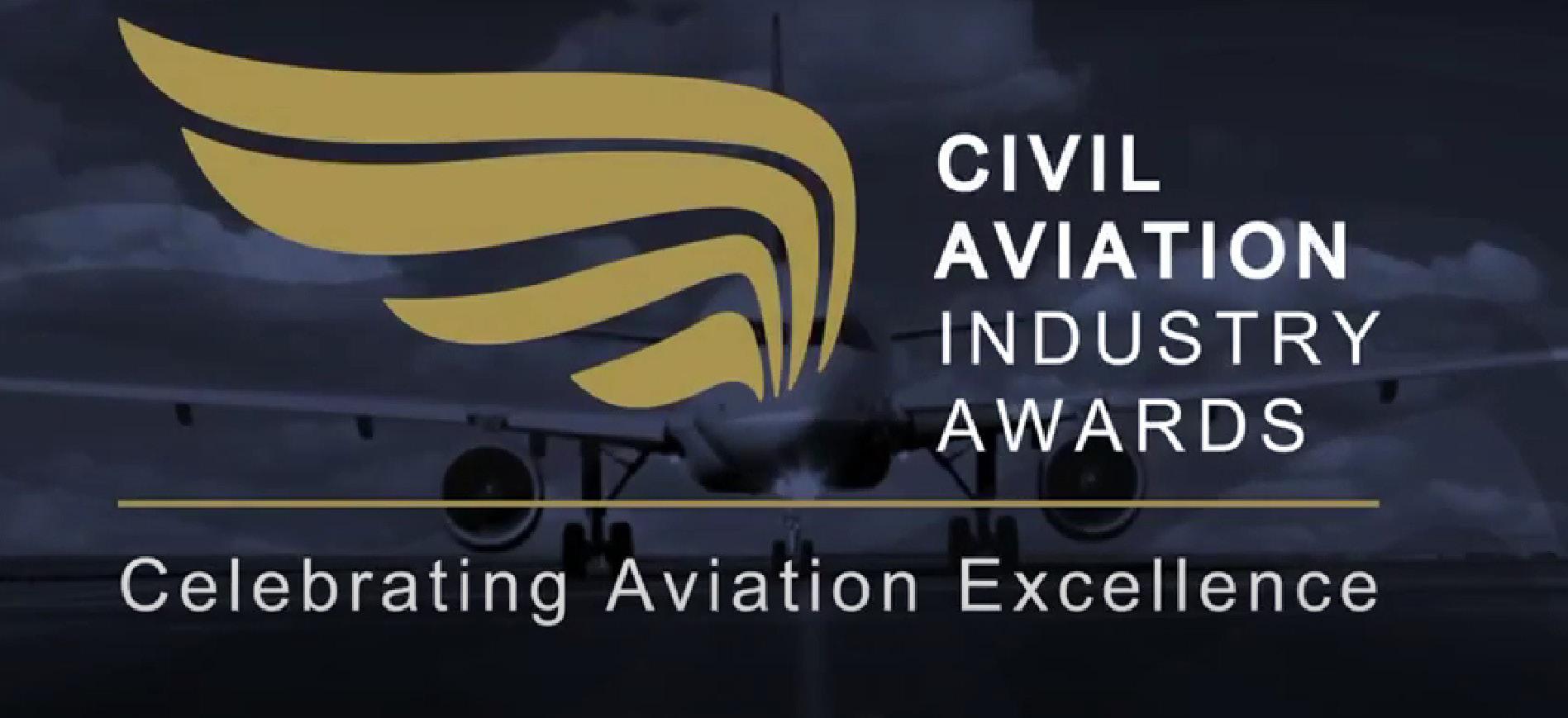
The deadline for nominations is 1 August 2023.
The SACAA’s Director of Civil Aviation, Ms Poppy Khoza said: “We are glad to again invest in the 2023 CAIA awards after a three-year absence due to the COVID-19 pandemic. These awards were created to represent and reward sector excellence across all aviation individuals and organisations.
“The nomination portal is now open, and we wish all of the best to all of the nominees as we look forward to seeing you at the Gala function that will take place later in the year.”
May 2023 50
Entries for nomination close on 1 August 2023.
There are 19 categories for the 2023 CAIA.
Awards:
• National Aviation Company of the Year
• Outstanding Contribution to SA Aviation

• Aviation Safety
• Aviation Transformation
• Aviation Innovation
• Aviation Sustainability and Environment
• Aviation Professional
• Aircraft Operator
• Airport Achievement
• Aviation Training
• Aviation Maintenance Organisation
• Aviation Security
• Aviation Research and Development
• General and Sport Aviation
• Aviation Support Services
• Aviation Customer Services
• People Development
• Manufacturing Organisation
• Approved Design Organisation
To nominate, visit this entry portal: https://www.caa.co.za/caia/
Various special opportunities and incentives are available for those interested in sponsoring the 2023 edition of awards.
Prospective sponsors can contact Nishan Singh on 083-451-2657 or by sending an email to singhs@caa.co.za.
j
May 2023 51
Winners at the 2020 awards.
CIRRUS GO-AROUND
Aircraft registration: ZS-VOL
Date and time of accident: 4 March 2016 at 12.53 Z
Type of aircraft: Cirrus SR22
Type of operation: Private - Part 24
PIC license type: PPL
License valid: Yes
PIC age: 37
PIC total hours: 186
PIC hours on type: 82
• This discussion is to promote safety and not to establish liability.
• CAA’s report contains padding and repetition, so in the interest of clarity, I have paraphrased extensively.
Synopsis:
Last point of departure: Vredendal
Point of intended landing: Driefontein
Location of accident site: Driefontein
Meteorological information: 080/5.Temp: +26˚C
CAVOK
POB: 1 + 3
People injured: 4
People killed: 0
The pilot, and three passengers, took off on a private VFR flight from Vredendal in the Western Cape for Driefontein airfield, an unmanned aerodrome near Fochville in North West. On arrival at Driefontein – his first visit here – the pilot conducted a low-level inspection of the runway, then commenced his approach for runway 21 (1300m long) with a light southerly wind.
He had also been told that the runway had a slight upslope towards the far end and was prepared for this.
The pilot touched down at 80kt IAS, almost half way along the runway. The published stall speed, in landing configuration, at gross weight is 60 kts.
The tables in the POH show that at that elevation (4780’) and temperature (+26˚C) the aircraft should have been approached with full flap at 77kts indicated, and it would have a ground roll of 425m
During the landing roll, the pilot realised he was running out of runway and decided to initiate a go-around. This decision came too late, and the aircraft failed to get airborne by the time it
May 2023 52
JIM DAVIS
reached the end of the runway. It continued straight ahead, crashed through the perimeter fence, over a provincial road and eventually hit a small tree.
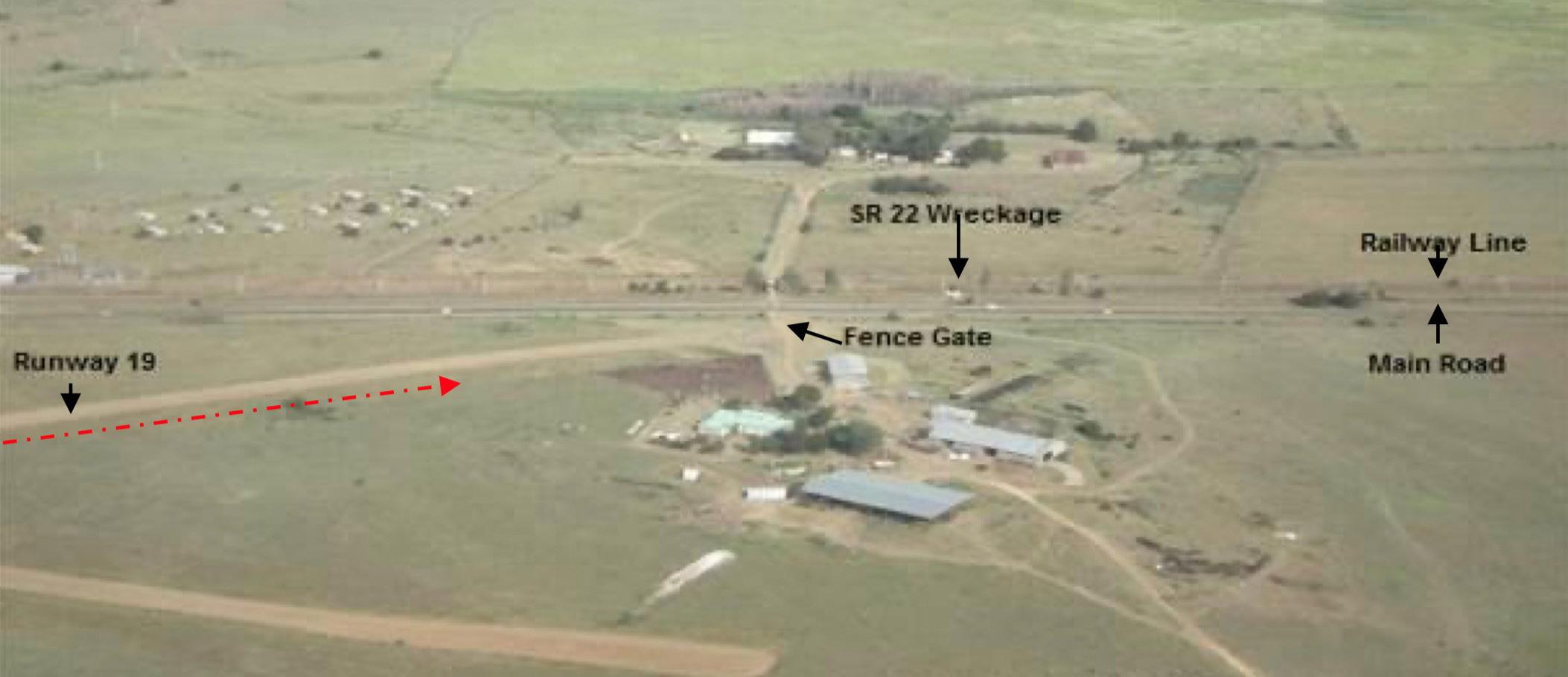
From the POH:
At any point in the approach, a go-around may be executed. Smoothly apply maximum power, level the wings and transition to a pitch attitude that will slow/stop descent. After descent has stopped, reduce flaps to 50%, pitch for Vy (101 KIAS), and retract flaps to 0%. Ensure positive rate of climb. At a safe altitude and above 80 KIAS, retract the flaps.
The performance section of the POH shows that if the pilot had already reached the halfway mark when he decided to do the go-around, he could have taken off safely.
After the aircraft crashed through the perimeter fence, it skidded over a public tar road parallel to the fence, slid across a grassy area and finally came to rest against a small tree on top of a steep embankment alongside the Johannesburg Potchefstroom railway line. The aeroplane ended up a few metres from the edge of the embankment and the occupants were fortunate that the aircraft did not fall over the edge.
JIM’S COMMENTS
Please allow me a little rant before we have a look at the mechanics of this stupid accident.
It’s been bugging me for three days – why do I get so bloody cross every time I come across one of these needless go-around accidents?
It’s not as if the pilot had done something stupid like flying into bad weather. Neither had he done something that he knows to be naughty – like doing a beat up.
Probable Cause
Botched go-around.
The truth is that he tried to do something sensible and completely buggered it up.
He has simply handled the controls badly as if it was some strange manoeuvre that he has never tried before – or if he has, it was such a long time ago that he’s forgotten how to do it.
It’s like asking him to do a steep turn and he throttles back, banks sharply to the left and uses full top rudder – you would say where the hell does that come from? The guy has no clue what to do.
May 2023 53
The layout of Driefontein with its 1300 metre runway.
Anyhow these thoughts have been swilling around in my turnip for a few days. A go-around accident seems to be in a different class to other accidents. The guy really wants to do the safe thing, and just doesn’t have a clue how to do it.
So why can’t he do it – it’s largely because the system gets in the way. Think about it. When did any of us last do a go around? Probably once or twice during our initial periods of circuits and bumps.
And even then, was it solo? Nope, we had an instructor bellowing in our ears and telling us when to do it, and what to do with the controls.
Let me tell you exactly what will happen if I suddenly shout, “go-around, go-around” at a pupe at 100’.
He will initially do nothing. Perhaps he thinks I have gone mad, or he has mis-heard me, or that I am talking to someone else on the radio. When he eventually realises I’m talking to him, and I’m serious, he will do two things – he will take half power and dump the flaps – leaving us
wallowing on the edge of a stall at 50’.
Actually I won’t let him do that because I value my life – but that’s what he will try to do. Sadly, this is not a joke – that will be the first reaction from most pupes – and licensed pilots too.
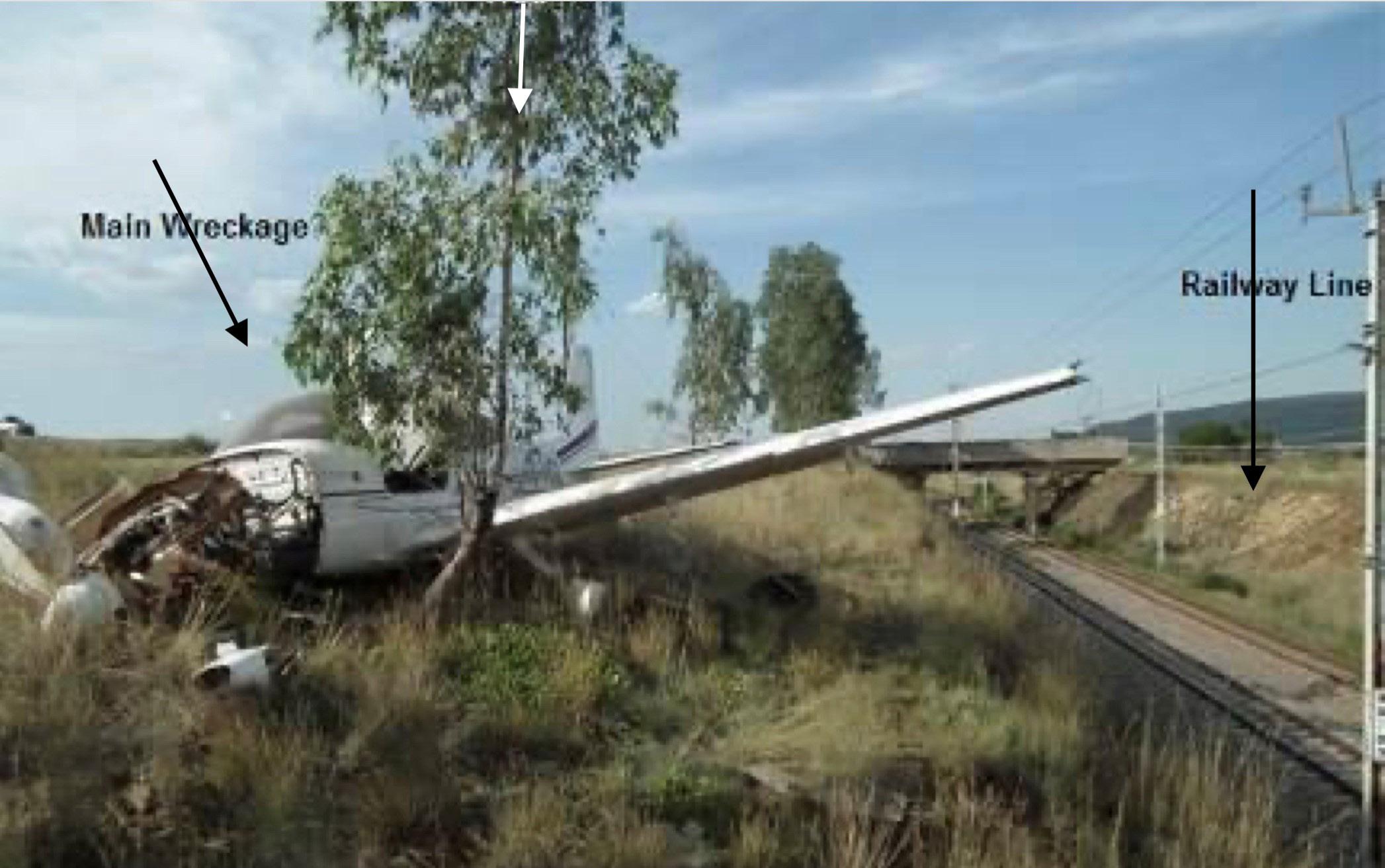
They are not expecting it, and they have no plan.
Okay, rant over – now let me be a good instructor and tackle the problem under these three headings:
• What he
did wrong
• Why he did it
• How he should have done it
What he did wrong
He mismanaged a go-around. This is one of the most important exercises, and definitely the one that receives the least attention during PPL training.
May 2023 54
The Cirrus stopped on the edge of the railway cutting.
Why he did it
This is the interesting part. The short answer is that he was probably badly trained and he almost certainly hadn’t practised one in yonks. Think of your own training – if you learned on a tricycle undercarriage at a big airfield it is possible that you never had to do a go-around in anger.
If you messed up a landing your instructor would have helped you through a recovery or told you what to do. But did she ever unexpectedly yell at you to do a go around? Probably not.
Did she ever say, after you have spent six or seven minutes flying round a busy circuit, we are not going to land off this approach? Possibly not. Was it something that you practised time and time again? Almost certainly not.
This is about training with a nosewheel in a busy circuit on a long runway.
If you trained at a country strip in a taildragger you would have done plenty of go-arounds. That’s just the nature of the beast – a taildragger will bite your head off if you push your luck with a landing that’s going wrong.
So we have all practiced steep turns and forced landings and incipient spins fairly recently – but go-arounds? Naaah not really.
How he should have done it
He should have mentally prepared for a go-around – particularly at an unfamiliar country airfield. All the way down the final approach he should have been saying to himself, if I don’t like the look of this, I will smoothly take full power with enough right rudder to keep straight. At the same time, I will level the nose. Once I have 75 knots I will bleed off the flaps and climb away for another circuit.
If he was in a Cessna with full flaps he should have reminded himself that full power will cause it to rear up like a wild horse and he will need a massive amount of forward pressure on the stick to keep the nose level.
His hand should have been twitching on the throttle in anticipation of seeing an antbear-hole or an animal on the runway.
He should also have been asking himself all the way down the approach whether he is too high or too low or too fast or too slow.
This guy was patently too high and too fast. Hell, he touched down nearly half way along a 1.3 km long strip at 20 knots faster than necessary. I am certain that if someone had asked him whether he was too high and/or too fast he would have said, yes. Yet he did nothing about it until it was too late.
So why did he leave it until disaster was upon him? It simply wasn’t part of his planning. Also he probably didn’t want his pax to think less of him. That’s easily cured. You simply tell the pax that you may do a go-around if you are not happy with the approach – (a) They will mentally applaud your caution, and (b) You will have prepared yourself for a go-around.
Take home stuff
This is easy,
• Grab a good instructor to do a bunch of go-arounds with you.
• Mentally prepare yourself to do a goaround on every approach and landing.
• Tell your pax that a go-around is normal and may be necessary.
May 2023 55
Please allow me a little rant j
THE ROTAX 916
You may have to forgive us for listing a whole new aero engine as a mere gadget – and thus suitable for review in our Gadget of the Month series. But the Rotax 916iS so small, yet so powerful it represents the ultimate gadget.

May 2023 56 GADGET OF THE MONTH
The April launch of the Rotax 916 was much anticipated at Aero Expo.
AFTER MUCH SPECULATION the 916 was launched at this year’s Sun ’n Fun in Florida USA and then in Friedrichshafen in Germany.
Derived directly from the 915, the 916 is also a turbocharged intercooled, four-cylinder, liquidcooled flat-four. The big trick is that it makes yet more power (160 vs 141 peak; 137 vs 135 max continuous) than its predecessor. This comes from a series of small adjustments, including a new exhaust system, revised engine mapping –and an increase in turbocharging boost.
the engine is truly single lever
The 916 displaces just 1.35 litres (83 cubic inches) and revs to a maximum of 5800 rpm. The base engine weighs a claimed 189 pounds. Compare that to a Lycoming O-360.
As with the modern generation digital Rotax engines, the 912iS and the 915iS, the 916iS uses dual-channel FADEC (full authority digital engine control) that combines boost control, ignition and fuel injection so that the engine is truly single lever. Rotax says there will be both fixedpitch versions and a hydraulic constantspeed prop option, such as used in the VL-3 the subject of this month’s flight test. There will be 12- and 24-volt versions available. The Time Between Overhaul at product launch is 2,000 hours.
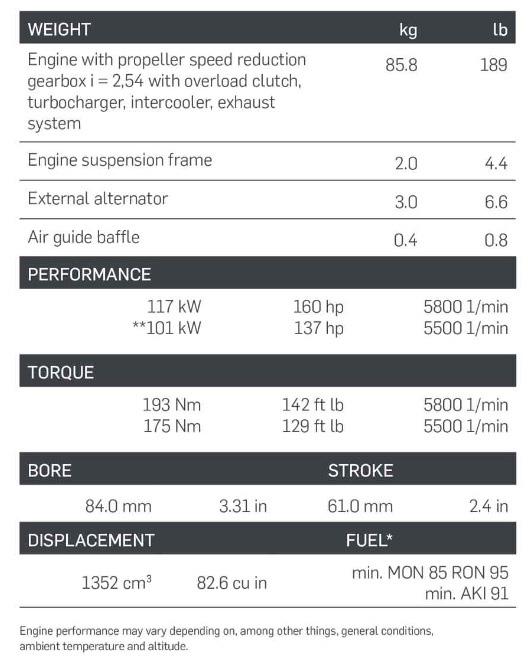
The certified version will be known as the 916iSc. Rotax says the 916iSc is aimed at four-seater aircraft and high performance two-seaters – such as the CubCrafters Carbon Cub UL – which was the launch aircraft.
Rotax offers the 916iSc for Instrument Flight Rules (IFR) flights as well as for commercial flying, for example for flight schools and private pilots. The increased power enables shorter take-off distances and steeper climb and descent. The 916iS features multi-fuel technology for Mogas and Avgas, which allows both and aviation fuel.
Peter Ölsinger of BRP-Rotax said, “For us, it was crystal clear that we had to build on the success of the 915 engine. We can now seize new opportunities in the four-seat market segment with a perfectly mature product and thus continue our steady growth of recent years.”
May 2023 57
j
Rotax 916 Specifications
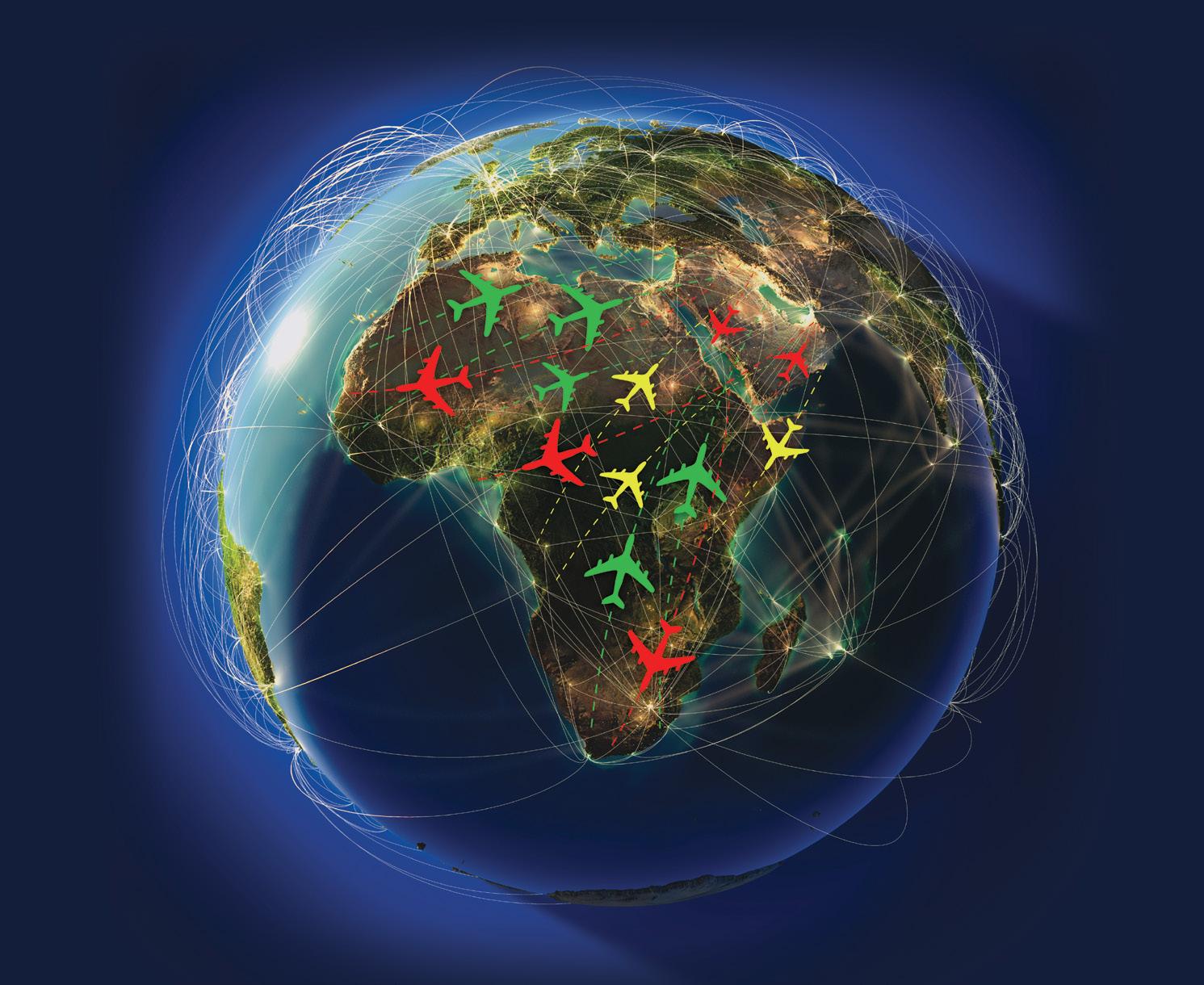


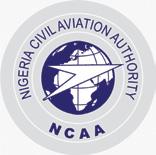
May 2023 58 13th – 14th September 2023 International
Follow us: www.aviationafrica.aero STEPPING UP FOR BUSINESS West Africa’s strategies to develop a safe, efficient and profitable aviation industry To find out more please contact Mark Brown: T: + 44 (0) 1702 530 000 | M: + 44 (0) 7889 100 987 E: mark.brown@aviationafrica.aero OFFICIALLY SUPPORTED BY: REGISTRATION SPONSOR: GOLD SPONSOR: DELEGATE BAG SPONSOR: SILVER SPONSORS: BRONZE SPONSOR: NIGERIA CIVIL AVIATION AUTHORITY
Convention Centre, Abuja, Nigeria
In association with Nigeria Civil Aviation Authority
NOW IS THE TIME TO LEARN:
• PRIVATE PILOT TO AIRLINE TRANSPORT PILOT
• NIGHT RATING
• INSTRUMENT RATING
• MULTI ENGINE CLASS RATING
• TURBINE RATING
• INSTRUCTORS RATING
• ENGLISH PROFICIENCY
• PPL & CPL GROUND SCHOOL LECTURES.
FLEET SIZE IS: 19 X C172, 12 X WARRIOR, 7 X SEMINOLE, 3 X KING AIR C90

CONTACT US:
Tel: +27 (44) 272 5547
Email: info@aifa.co.za
Website: www.aifa.co.za
Instagram: AVIC int Flight Academy
www.facebook.com/ AIFASA
Linkedin: AVIC – International Flight Training Academy
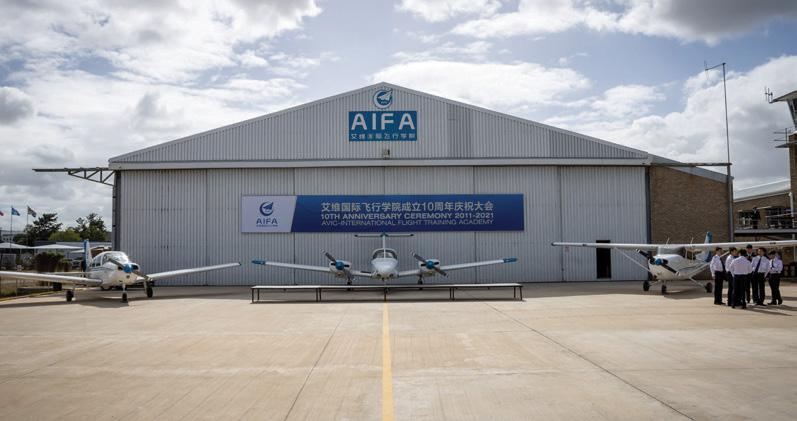

• ALL GARMIN EQUIPPED FLEET
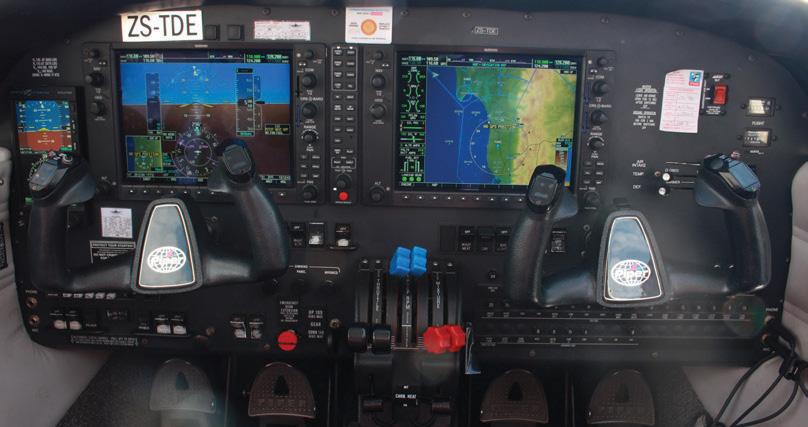
• TRAIN AS YOU GOING TO FLY ALL GLASS COCKPIT
• AIFA HAS FLOWN MORE THAN 300 000 HOURS AND QUALIFIED 1090 CPL PILOTS IN ONLY 10 YEARS OF OPERATIONS

May 2023 59
SA Flyer 2023 | 05
MARCH 2023
THERE HAS BEEN A NEW Pilatus PC24 jet delivered as well as a PC12 single engine turboprop.
Yet another Boeing 737-800 has been registered to Safair, this one comes from the Ukraine, and by my calculations this makes their fleet now four Boeing 737-400s and no less than twenty-two Boeing 737-800s. And I know there is still another 800 series to be registered. This airline is really growing rapidly.
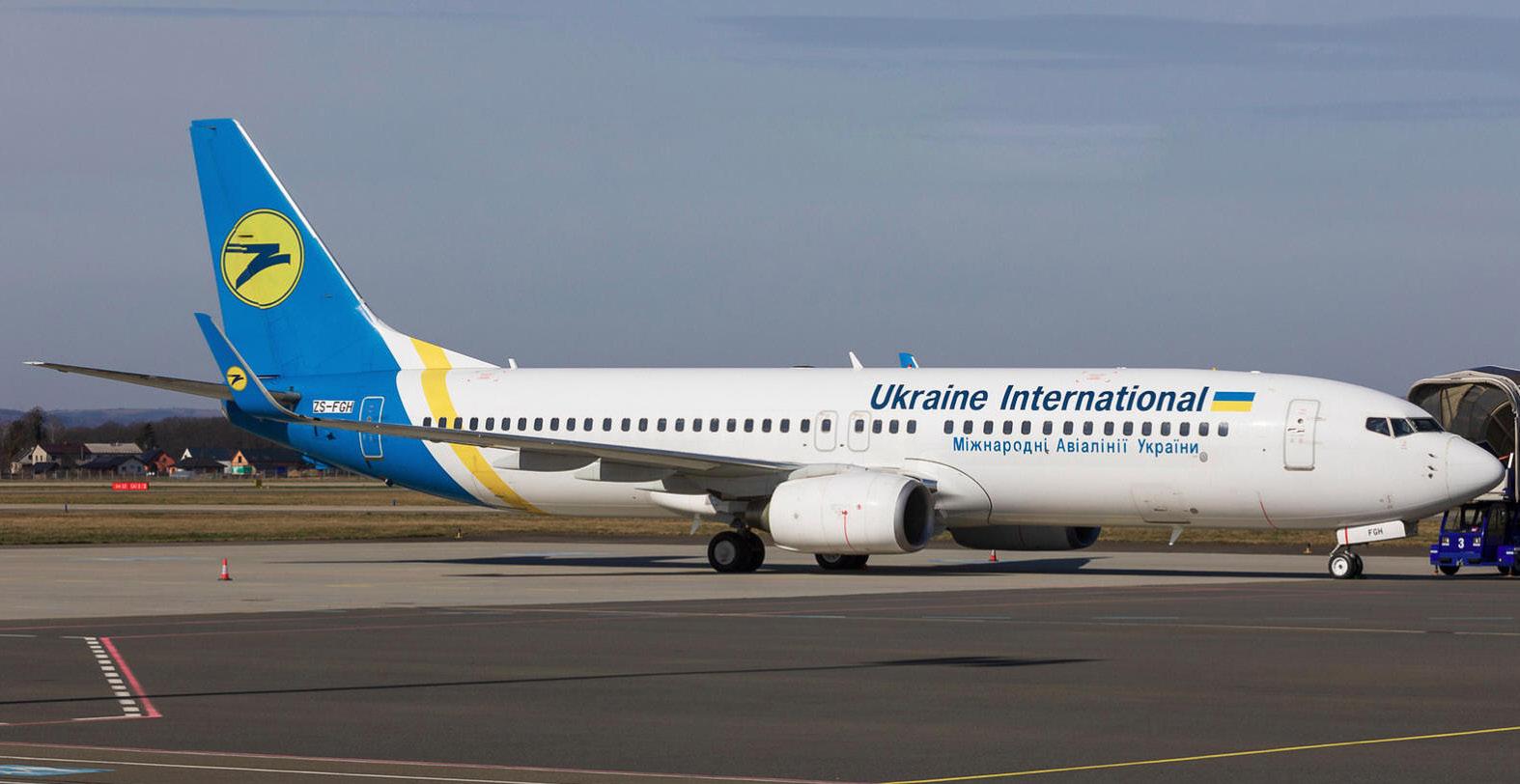
There is a second Embraer BizJet registered this month. This one comes from Germany.
An old favourite, ZS-PKU, a Boeing 737-529, has returned to her owners after being leased to Mat Airways / KonTiki Sky of Macedonia. She has been around the world, having started life with Sabena in Belgium, then to the USA,
to Nationwide here in South Africa then to Macedonia, the USA, back to South Africa and again to Macedonia.
There are two Bell 412SP helicopters added to the register this month, both coming from Indonesia. They have also operated in the UAE, Saudi Arabia, Germany, Iran and Spain.
The NTCA side of the register is quiet this month with only three aircraft being registered. One of these is a Bristell LSA which makes it the second one to be registered here. The Bristell is powered by a Rotax 915iS with a max speed of 141 Kts, a MAUW of 600kg and a useful load of 270kg. The other one is ZU-IAS. The other two are a BatHawk and a Savannah S.
We continue to lose aircraft to the export market.
60 May 2023
REGISTER REVIEW: RAY WATTS
Yet another Boeing 737-800 for FlySafair.
March has been a pretty average month with regard to aircraft movements on to and off the register, however there are some exciting new arrivals. airline is really growing rapidly
ABOVE: ZS-DES is a Cessna 550 Citation exported to the Bahamas. Photo Ray Watts.
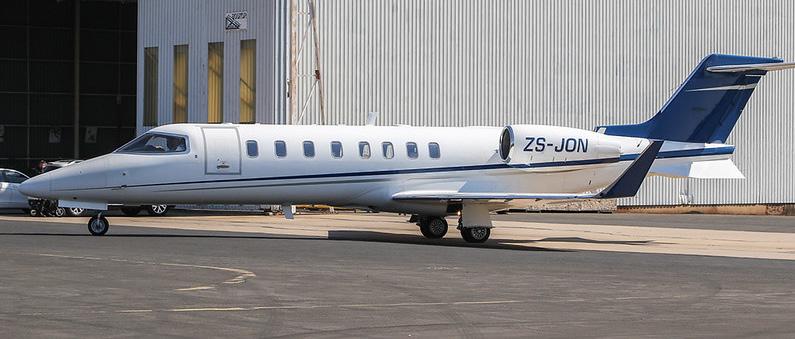

BELOW: After 50 years in South Africa, ZS-DZK, a Cessna 182, has been exported to Turkey.
BELOW BOTTOM: ZS-JON is a Lear 45 now exported to Malta. Photo Omer Mees.

61 May 2023
ABOVE: Boeing 737-500, Z3-AAM has now returned from lease as ZS-PKU. This aircraft belongs to African Air Charter.
BELOW: ZS-PKU is a well known Boeing 737-500 seen here in a previous incarnation with Nationwide.

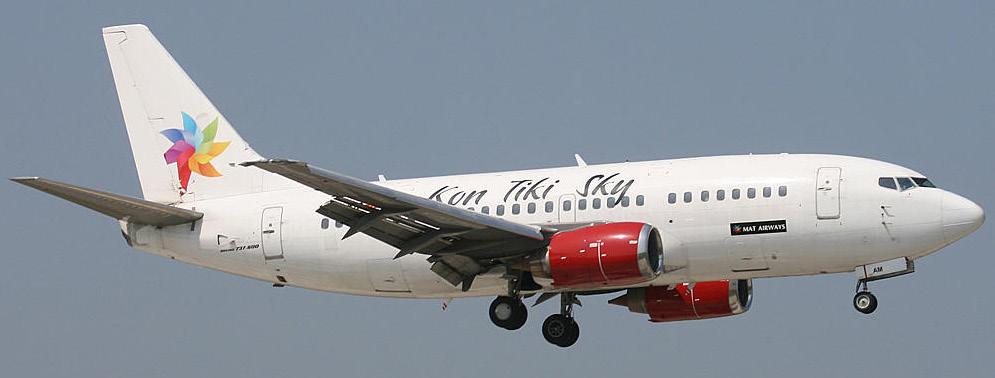
BELOW BOTTOM: Unusual destination - ZS-TTB is a Cessna 206H exported to Saudi Arabia. Photo Ray Watts.
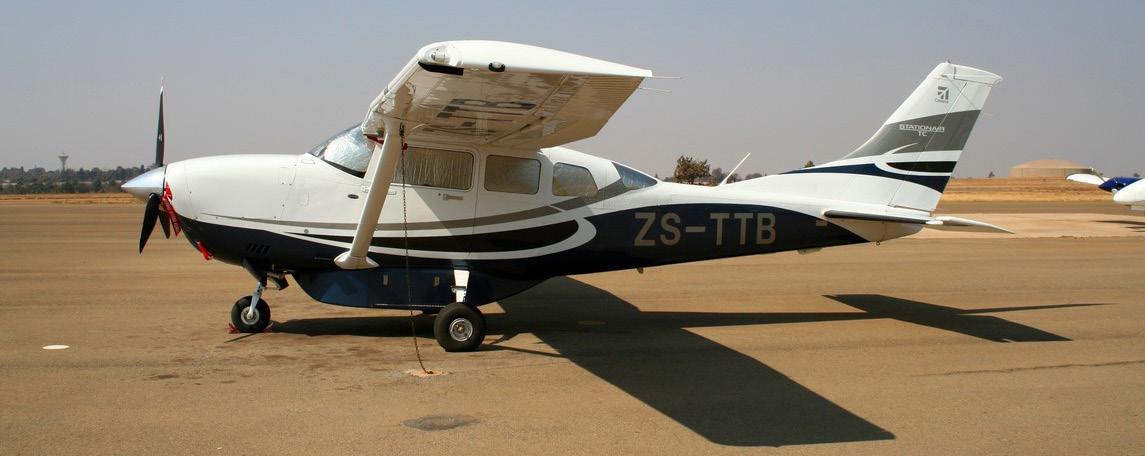
62 May 2023
Another eight TCA aircraft, six fixed wing and two helicopters were exported this month. They have gone all over the world but surprisingly, none to USA. There was one NTCA exported to New Zealand.
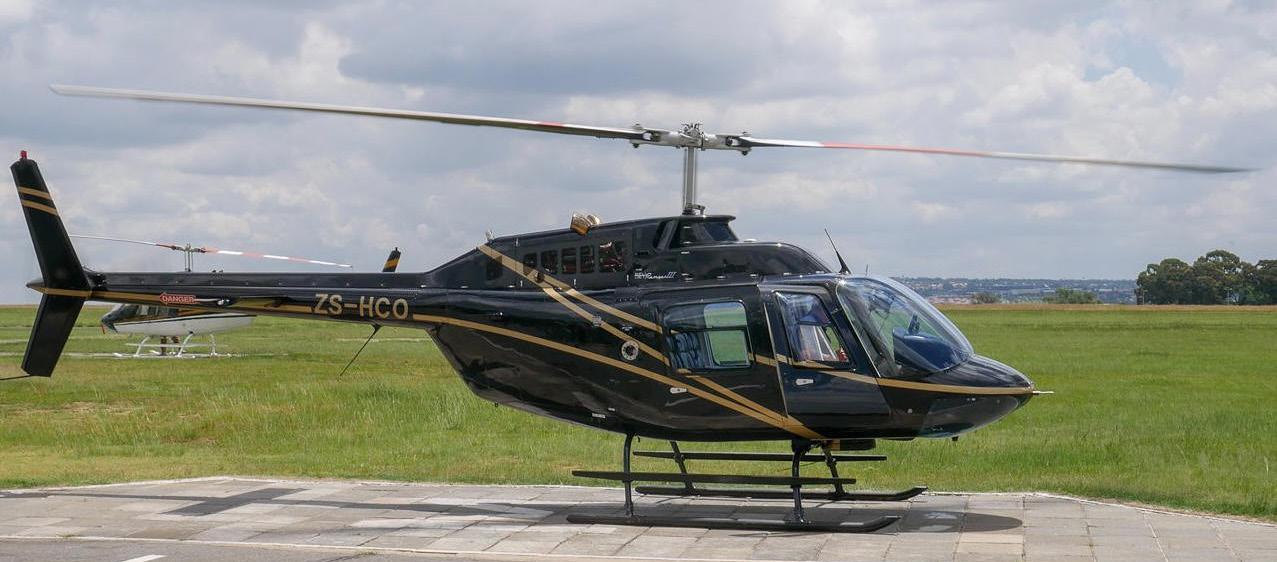
On the drone side another fifty-one have been added and two deleted from the register. Drones are being employed more and more with the security industry, there are now two of them being used to patrol the area around the DSV warehouses, just north of O.R. Tambo airport. They can be seen regularly on Flight Radar 24. There was another one being used to patrol the overhead electric cables in the area in which I live but this had to be stopped because apparently the operator didn’t have the
Tail Piece
Winter is on its way and, here in Gauteng that generally means that better flying weather is coming.
The SAAF Museum are holding their show on 6 May 2023. This is the annual major fund raiser for the Museum. Tickets from Computicket. j

63 May 2023
necessary permissions from the CAA to operate so close to the airport, which is about 5km away in a straight line.
ZS-HCO is a Bell 206B Jet Ranger exported to Canada. Photo Greg Rooken-Smith.
ZU-MSC is an FKA Bushbaby now exported to New Zealand.




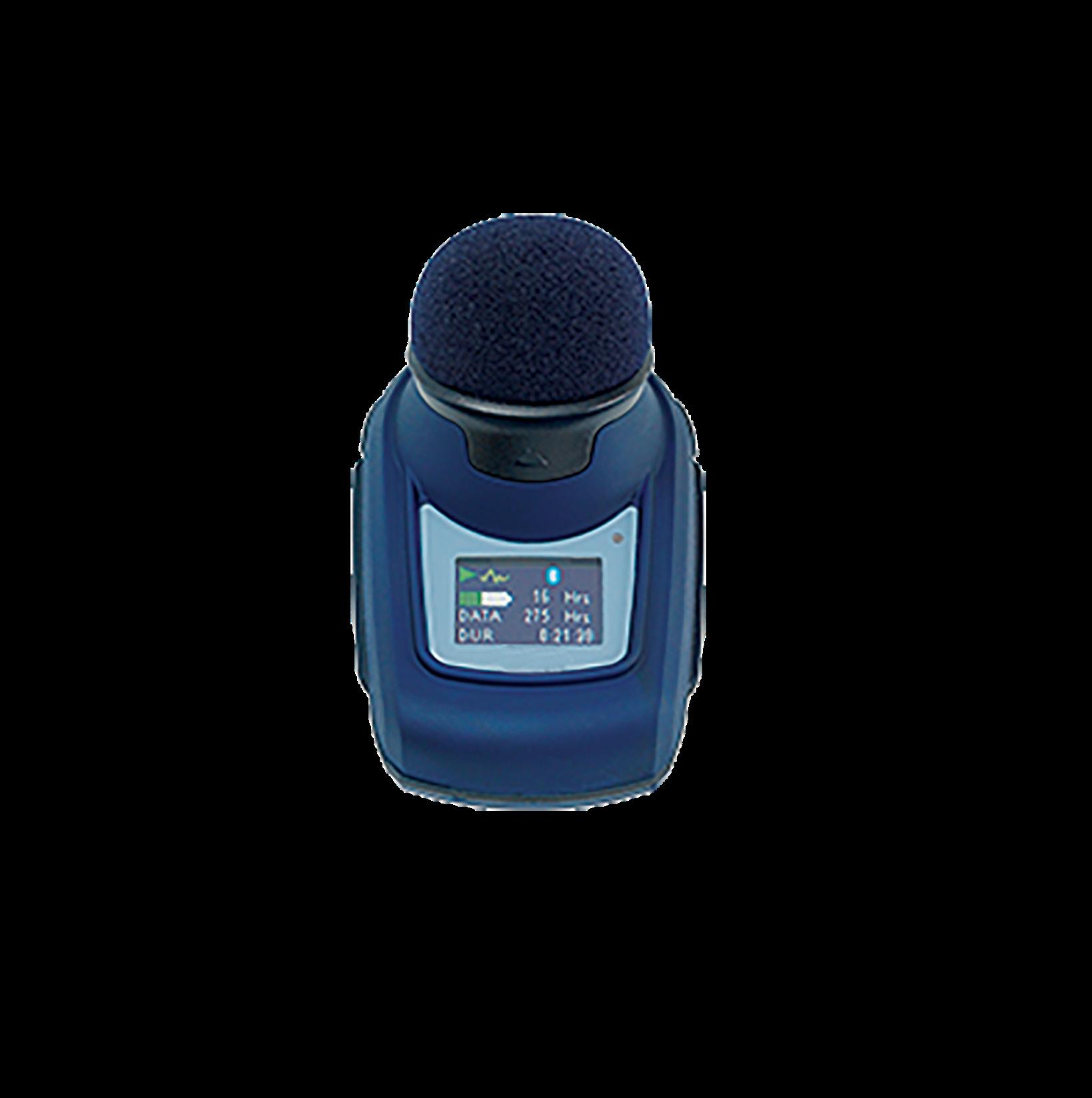
M & N Acoustic Services (Pty) Ltd REGISTER REVIEW MARCH 2023 Contact: Marianka Naude Tel: 012 689 2007 I Cell: 076 920 3070 Email: admin@mnacoustics.co.za We perform SANAS certifications on all your: Vibration ( eg. Rion VA -11) Human Vibration ( eg. Quest Hav Pro) Electrical DC/LF Equipment – inhouse or on site (eg. Fluke Multimeters, Insulation Testers) SANAS Accredited Laboratory 1302 & 148 REG MANUFACTURER TYPE NAME SERIAL NUMBER PREVIOUS IDENTITY / EXPORT COUNTRY New Registrations ZSZS-ASR PILATUS AIRCRAFT LTD PC-24 301 HB-VUB ZS-BEV PILATUS AIRCRAFT LTD PC-12/47E 2246 HB-FSW ZS-FGH BOEING 737-800 35005 OE-IIC, UR-PSS, EI-EFA, N1786B ZS-JOY EMBRAER EMB-135BJ 14501067 D-ADCP, PT-SES ZS-PKU BOEING 737-529 25249 Z3-AAM, N237MA, Z3-AAH, ZS-PKU, N249JW, OO-SYG New Registrations ZT-T ZT-HNH BELL HELICOPTER TEXTRON INC 412SP 33107 PK-HMU, A6-BAZ, HZ-PCO, D-HHOP, HZ-RCO, EC-MZC ZT-HNG BELL HELICOPTER TEXTRON INC 412SP 33102 PK-HMP, A6-BAY, EP-HUH, A6-BAY, EC-MGI New Registrations ZUZU-IXY MICRO AVIATION SA BAT HAWK 0115 ZU-IXZ SAVANNAH AIRCRAFT AFRICA SAVANNAH S 22-02-54-0852 ZU-IYA KEVIN DOUGLAS FOUCHE BRISTELL CLASSIC LSA 005/2013 Aircraft deleted ZSZS-DES CESSNA AIRCRAFT COMPANY S550 S550-0087 BAHAMAS ZS-DZK CESSNA AIRCRAFT COMPANY 182H 182-55910 TURKEY ZS-HCO BELL HELICOPTER 206B 4523 CANADA ZS-JON LEARJET INC 45 45-0088 MALTA ZS-OYJ BEECH AIRCRAFT CORPORATION 1900D UE-273 ALGERIA ZS-TTB CESSNA AIRCRAFT COMPANY T206H T20608852 SAUDI ARABIA ZS-ZAD AIRCRAFT INDUSTRIES A.S L 410 UVP-E20 3003 LIBYA Aircraft deleted ZUZU-MSC KITPLANE FOR AFRICA BUSHBABY EXPLORER 159-01-12 EXP NEW ZEALAND Aircraft deleted ZTZT-ROZ ROBINSON HELICOPTER COMPANY R66 0839 KENYA





M & N Acoustic Services (Pty) Ltd QUOTATIONS ON REQUEST We perform SANAS certifications on all your: Acoustics ( eg. CEL 350 ) Vibration ( eg. Rion VA -11) Human Vibration ( eg. Quest Hav Pro) Electrical DC/LF Equipment – inhouse or on site (eg. Fluke Multimeters, Insulation Testers) Contact: Marianka Naude Tel: 012 689 2007 I Cell: 076 920 3070 Email: admin@mnacoustics.co.za SANAS Accredited Laboratory 1302 & 148
THE AMAZING ELDERS FLIGHT: 2023
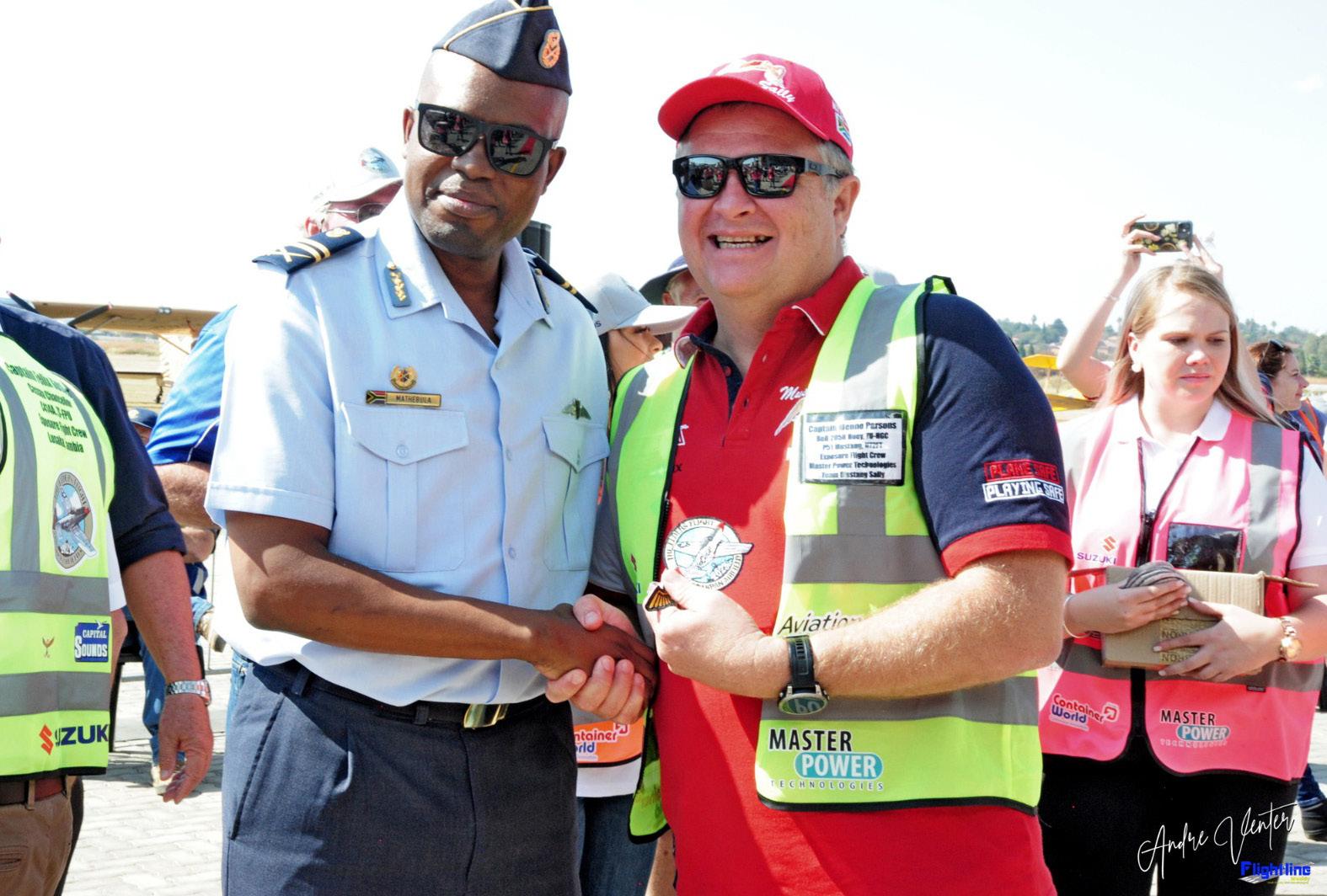

66 May 2023
NEWS
As just one person, Felix Gosher does more to develop aviation in South Africa than any number of Cadet Schemes or CAA outreaches.
Menno Parsons has long been a key supporter of Felix Gosher's initiatives. Here Maj Gen Mathebula presents Menno with his commemorative patch. Pic Andre Venter.
FOR HIS LATEST MAGNUM OPUS,
the Elders Flight 2023, held at Brakpan at the end of April, Felix continues to grow his original model of giving disadvantaged children the opportunity to fly by extending the privilege and thrill of flight to elders and military veterans.
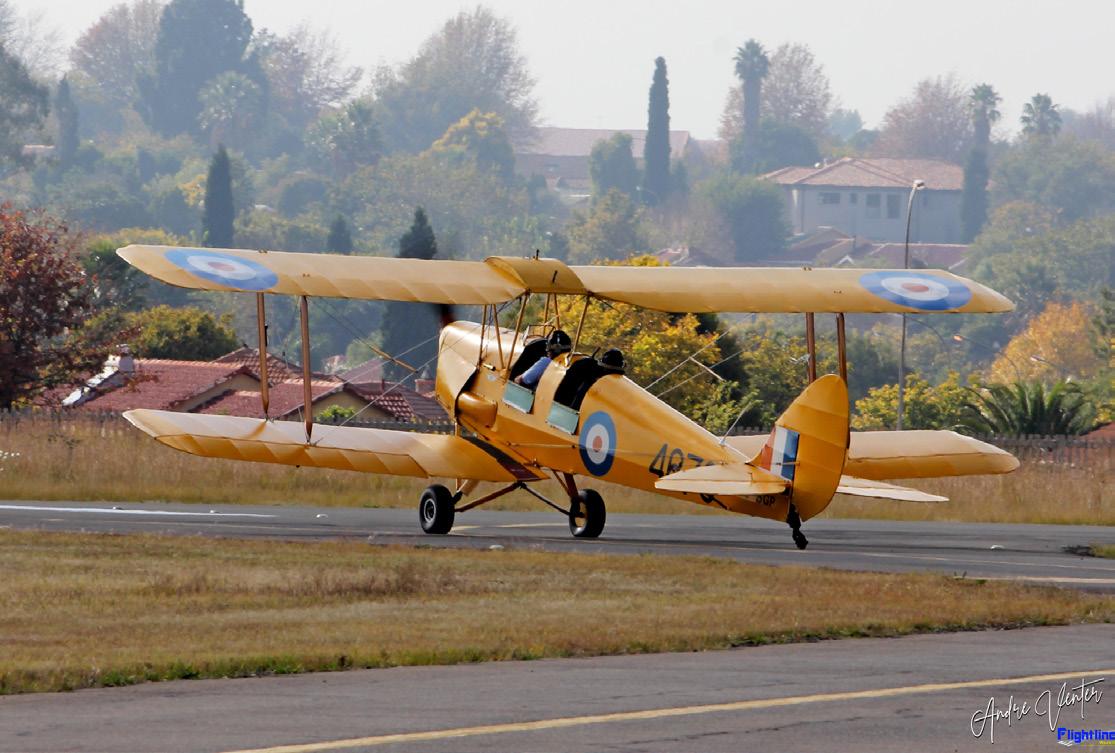
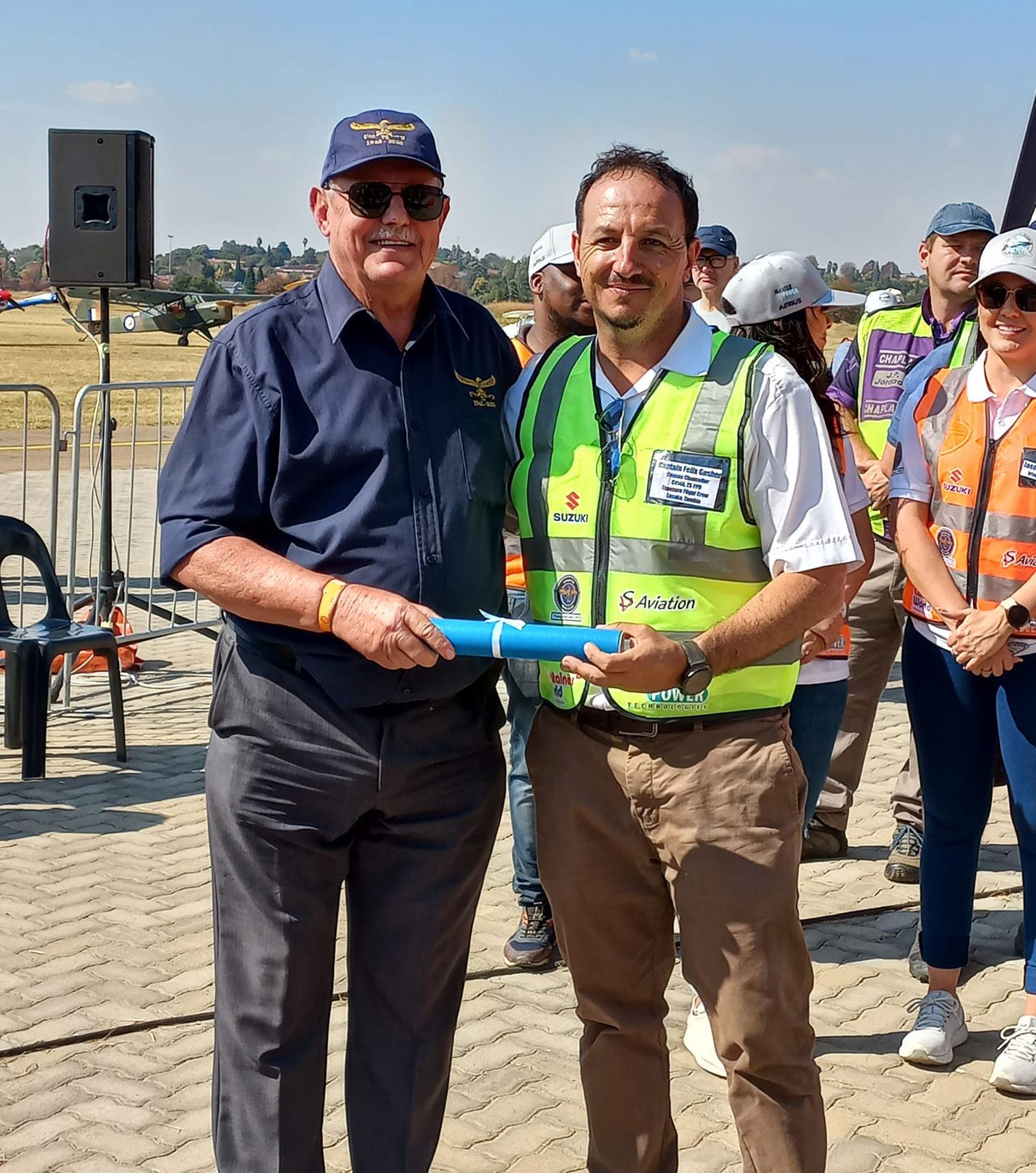

The logistics were enormous. Over 300 elders and 15 military veterans were flown by 80 pilots. There were visiting VIPs a-plenty – and just the ground transport logistics were daunting.
Felix is an energizer bunny who has the drive to round-up all the skills required to stage these complex events safely and efficiently. The skills include: sponsors, pilots and their planes, safety officials, food providers and countless ground support staff. Veteran air show commentator Brian Emmenis once again mobilised his team from Welkom and provided much needed safety information, general announcements and background music.
A remarkable feature were the live bands, including a bagpipe band, providing great atmosphere. Touchingly Felix opened the safety briefing with the Lord’s Prayer.
67 May 2023
The whole experience was incredibly moving
The 80 pilots brought a wide range of aircraft - from the L-39 jet to a Tiger Moth and a Harvard. Image Paul Ludick.
A veteran flies a veteran - Jeff Earle taxies out in his Tiger Moth. Image Andre Venter.
Colonel Mike Louw of SAAFA with the indomitable Felix Gosher.
Felix is doing these events in a true spirit of excellence. The main hangar venue looked like a professionally arranged gala dinner, complete with red carpet. Outside, a wide range of aircraft had been brought by their proud owners to enable the massive airlift. From Menno Parsons with his P-51 Mustang Sally and helicopters, to the venerable old Antonov An-2 biplane and the L-39 jet of Richard Lovett.
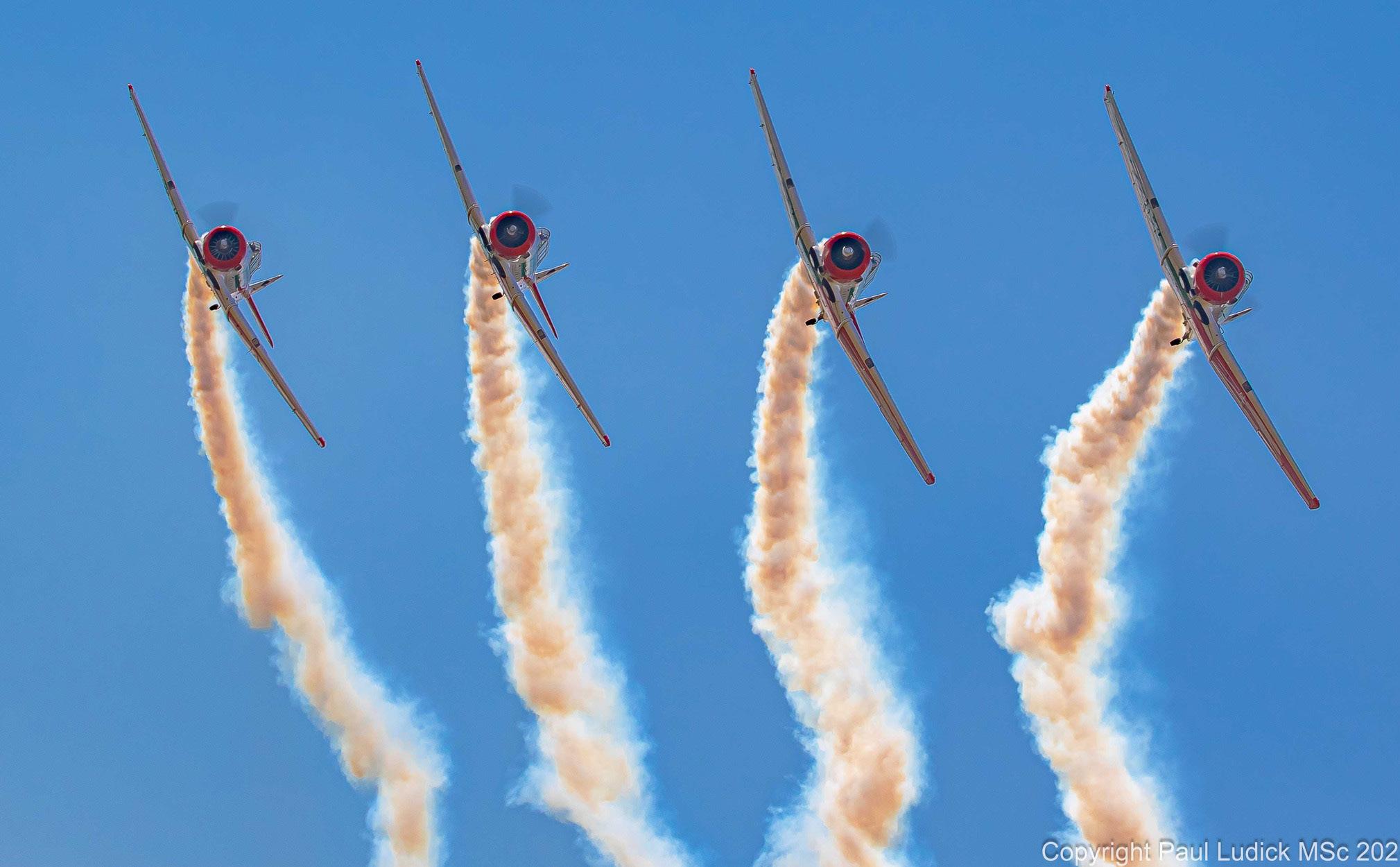
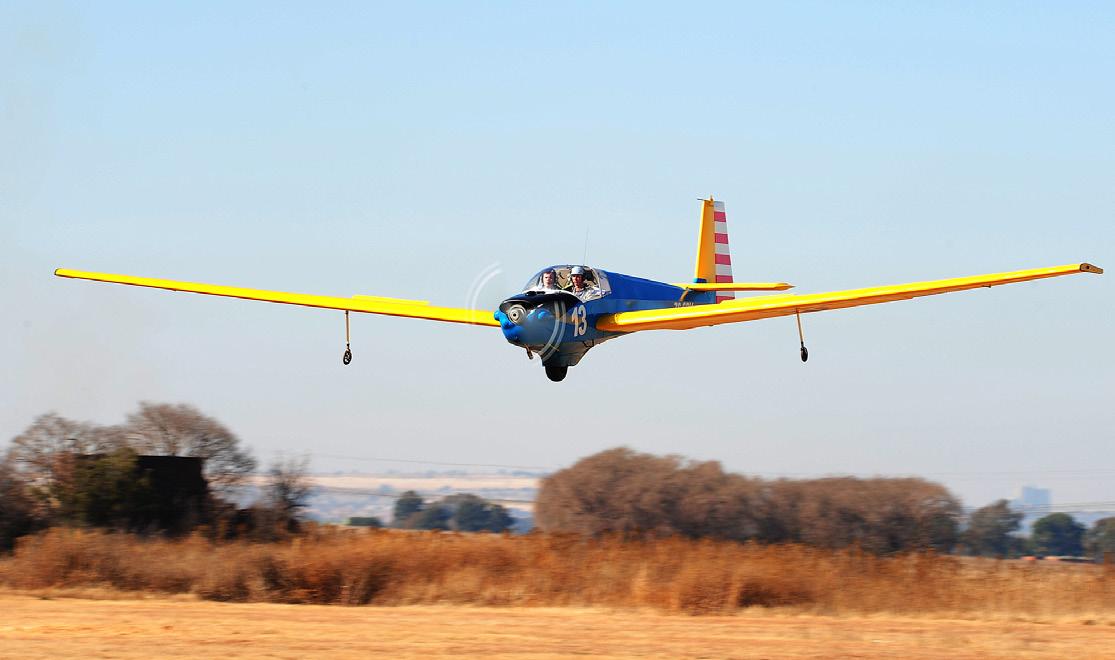
The prerequisite safety briefings were handled by the best of all possible teams: Felix Gosher did the pilot briefing –remembering that almost none of the pilots were professional display pilots, but simply volunteers. Rand Tower ATC Ricardo Afonso gave the ATC briefing and veteran air show organiser Nigel Musgrave the ground crew briefing. It was lovely to see ‘Search and Rescue Angel’ Santjie White do the Safety Overview.

68 May 2023
Felix Gosher touches down in the Cessna 414. Image Anton Wannenburg.
The ubiquitous Flying Lions put on another precisison display in ther Harvards. Image Paul Ludick.
There was even a Falke motor glider doing flips. Image Andre Venter.


69 May 2023
Menno Parsons loads up his spectacular Huey. Image Anton Wannenburg.
Menno Parsons with a veteran. Image Andre Venter.

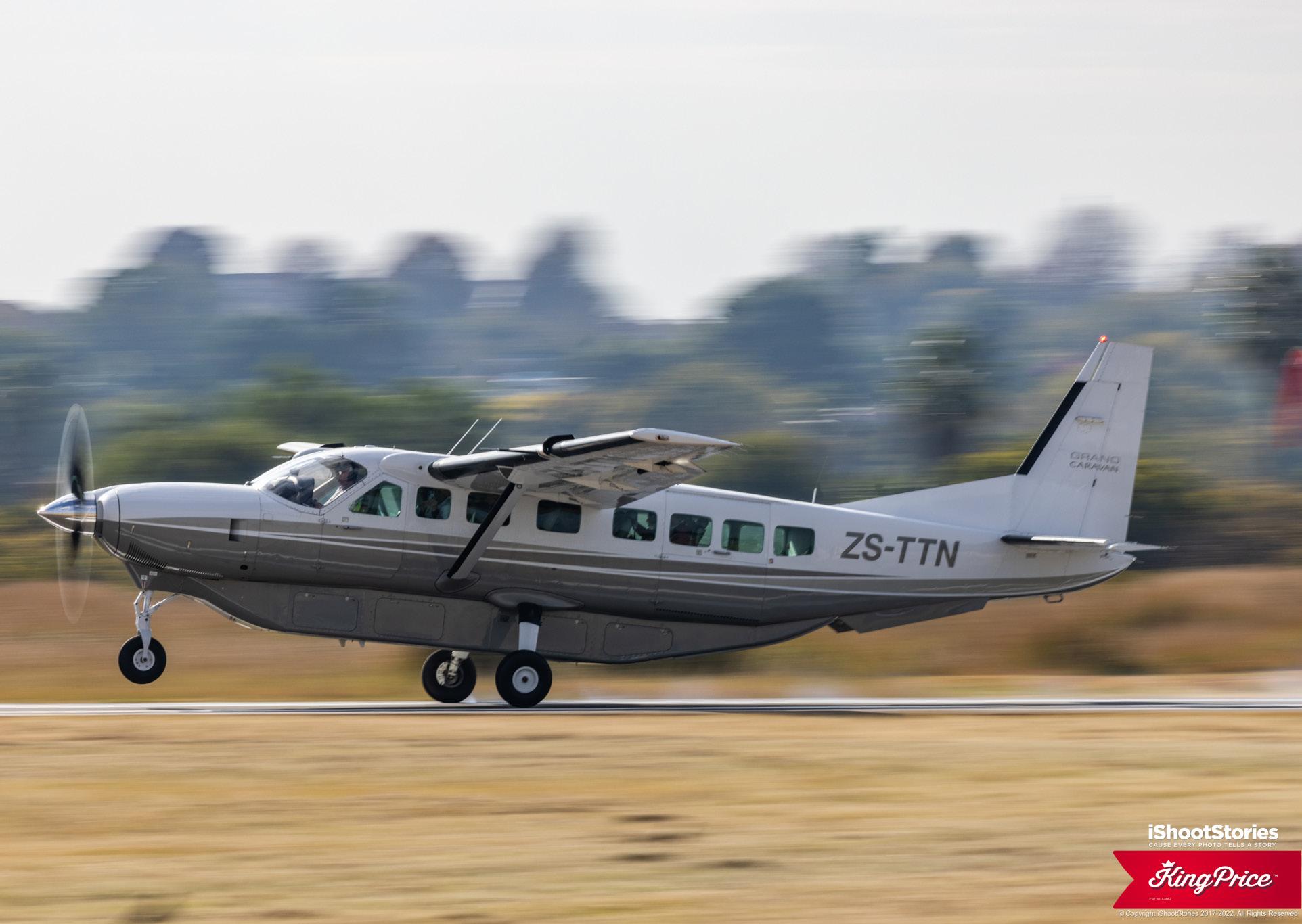
70 May 2023
Felix Gosher and Greg Rooken Smith help out a veteranimage Anton Wannenburg
The Cessna C208 Grand Caravan was a great load hauler. Image Anton Wannenburg.

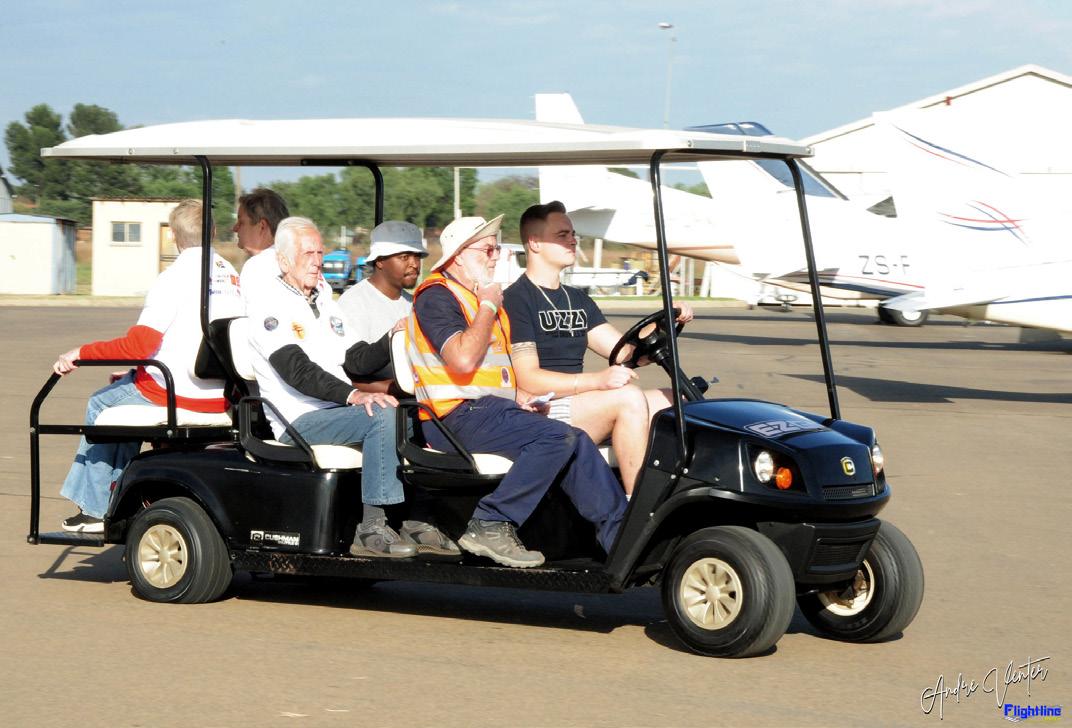
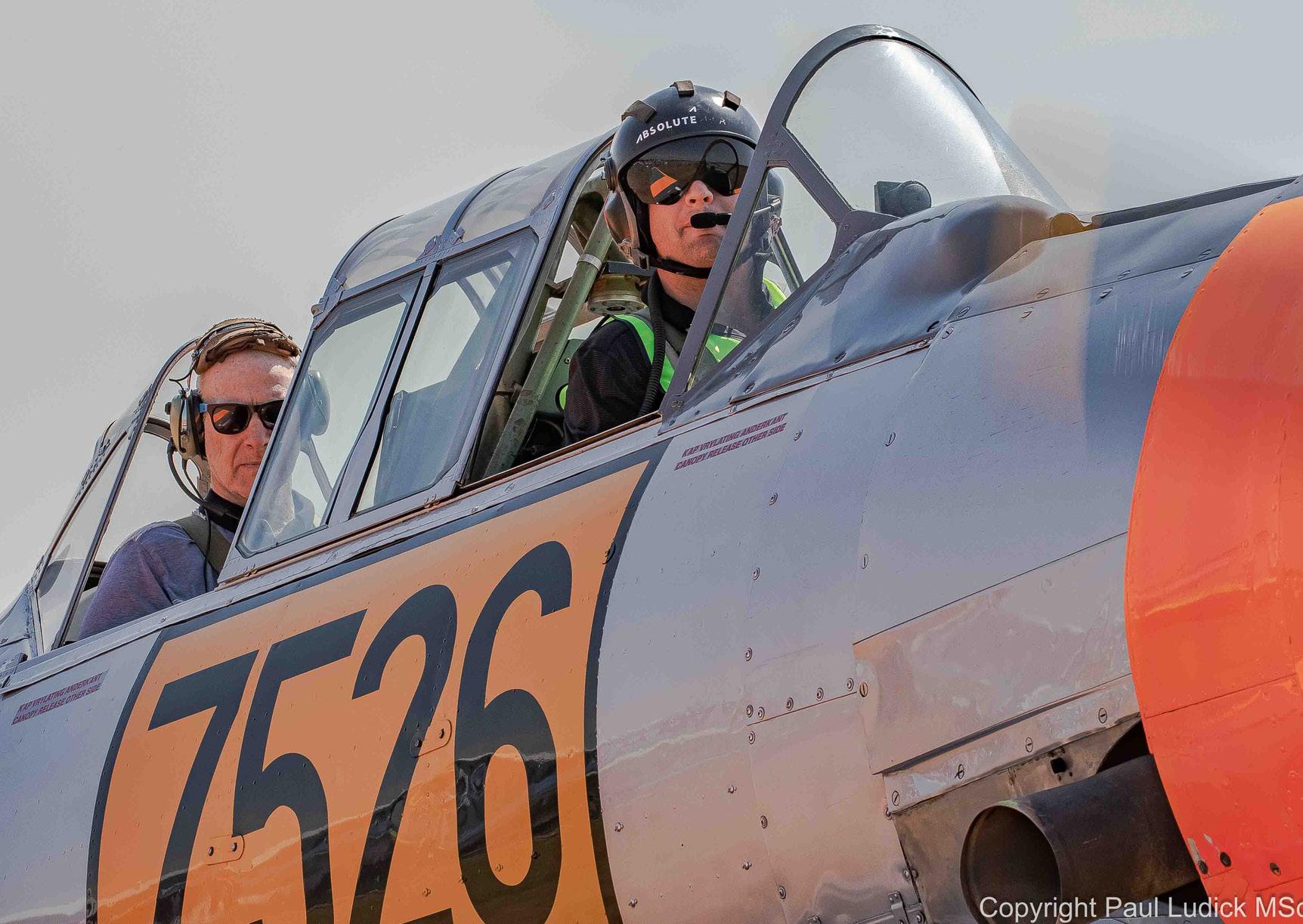

71 May 2023
Jason Beamish flies a veteran in a SAAF liveried Harvard. Image Paul Ludick.
The Jeppe High School pipe band opening in prayer.
Man on the move - Felix Gosher in actionImage Anton Wannenburg.
Ground crew had golf carts to transport the veterans. Image Andre Venter.
The multiple events flowed seamlessly. The Flying Lions roared overhead in their nostalgic radial Harvards to fly their precision display. The action never stopped and the day was perfectly rounded off by the presentation of commemorative wings to all the participants.

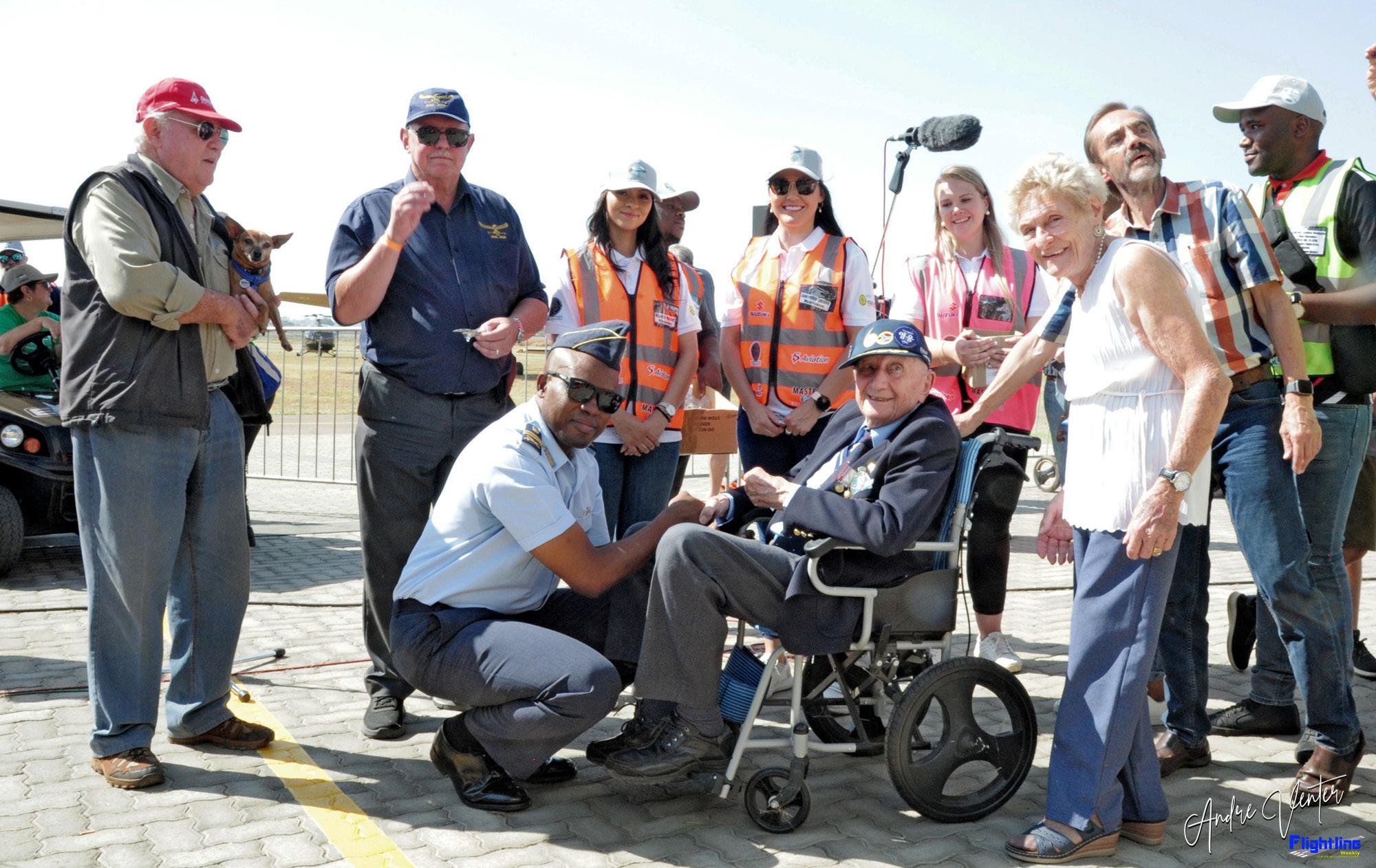
The whole experience was incredibly moving.
Many a tear was shed – either secretly or in open displays or emotion and appreciation. Felix Gosher and his team worked miracles. They are truly inspirational and, so rare is his blend of focussed passion and the ability to lead and manage the huge logistics that he is a man in 100 million. I stand in awe.
72 May 2023
The lumbering but unforgettable An-2 approaches to land. Image Andre Venter.
j
General Matebula with Lt (Ret) Piet Visser. Image Andre Venter.
BLUE LASER ATTACK GETS TWO YEARS
A Minnesota USA man whose lasered a Delta Air Lines flight was sentenced to two years in jail.
NICHOLAS JAMES LINK of Rochester, Minnesota, pleaded guilty to shining a blue laser into the flight deck of the Delta aircraft and to also lighting up a Minnesota State Patrol aircraft that was involved in the investigation.
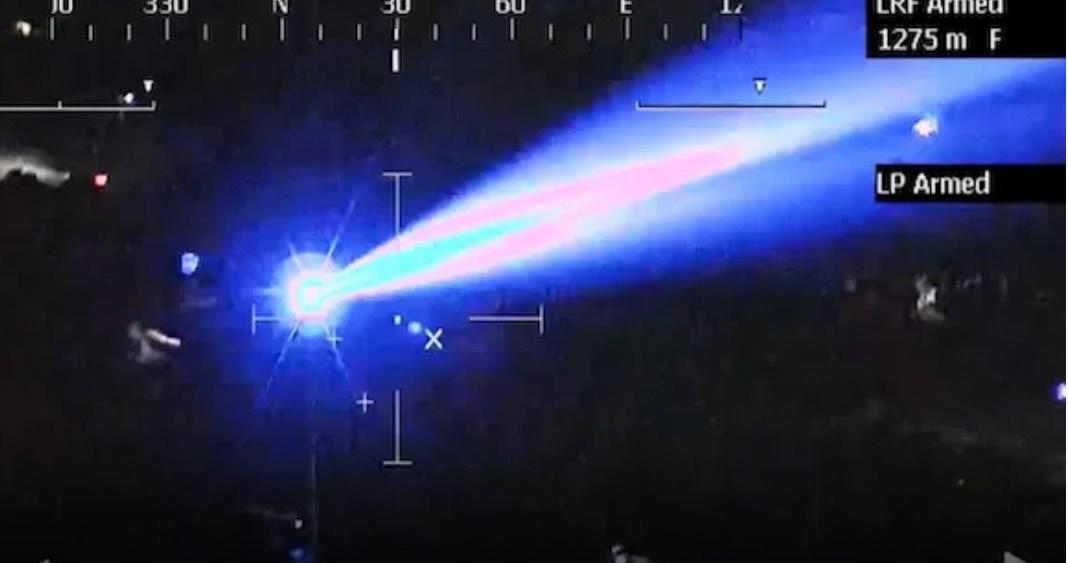
The flight was hit by the lasers as it descended through 9,000 feet and the pilots were punching data for a runway change. They landed without incident.
According to Associated Press, prosecutors said the judge took into account that the laser strike distracted the pilots while they were complying
with a change in their approach ordered by air traffic control.
The State Police aircraft was sent to help find the suspect and he made it easy by lighting it up, too. Local police on the ground found Link with the blue laser still on him. Blue laser attacks are relatively rare and potentially more dangerous than the more common green and red incidents. Human eyes are less sensitive to the shorter wavelengths of the blue light so they don’t react as quickly to the damaging rays.
73 May 2023
j
NEWS j
A blue laser is tracked by a police helicopter.
Fuel Prices as at 29/03/2023
Fuel Prices as at 29/03/2023

Prices include VAT but exclude any service fees
Prices include VAT but exclude any service fees
Fuel Prices as at 26/04/2023
Fuel Prices as at 26/04/2023
Prices include VAT but exclude any service fees
Prices include VAT but exclude any service fees
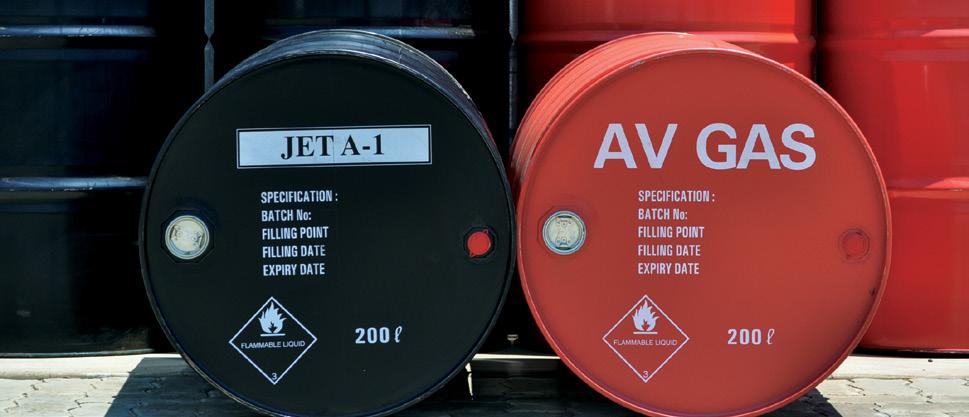


74 May 2023 FUEL TABLE www.sv1.co.za Tel: +27 10 446 9666 Danielle: +27 82 553 9611 Email: aviation@sv1.co.za Marina: +27 82 924 3015 GPS Co-ordinates: S25°50’37 E27°41’28 Import/Export no. 21343829 SA Flyer 2023|05 Airfield Avgas Jet A1 Airfield Avgas Jet A1 Beaufort West R32,60 R26,40 Baragwanath R33,50 Bethlehem NO CONTACT Beaufort West R33,70 R 26,70 Bloemfontein R31,23 R19,81 Bethlehem NO CONTACT Brakpan R31,50 Bloemfontein R31,92 R18,55 Brits R28,70 Brakpan R31,50 Cape Town R35,48 R18,69 Brits R28,70 Cape Winelands R32,50 Cape Town R35,13 R17,96 Eagles Creek R31,50 Cape Winelands R32,50 East London R32,42 R19,65 Eagles Creek R31,50 Ermelo R29,79 R24,73 East London R32,42 R18,84 Gariep Dam R32,00 R23,00 Ermelo R29,78 R24,73 George R32,88 R18,73 Gariep Dam R32,00 R23,00 Grand Central R31,11 R24,67 George R32,88 R17,94 Heidelberg R30,00 Grand Central R32,72 R23,63 Hoedspruit POA Heidelberg R30,50 Kimberley R31,99 R19,88 Hoedspruit 28.73 20.38 Kitty Hawk R33,60 Kimberley R31,79 R18,42 Klerksdorp R29,90 R24,15 Kitty Hawk R33,60 Kroonstad R30,16 Klerksdorp R29,90 R24,15 Kruger Intl Nelspruit R30,30 R25,50 Kroonstad R31,22 Krugersdorp R30,50 Kruger Intl Nelspruit R30,30 R25,50 Lanseria R32,32 R22,85 Krugersdorp R30,50 Margate No Fuel Lanseria R32,66 R22,83 Middelburg R29,96 R24,15 Margate No Fuel Morningstar R30,50 Middelburg R29,90 Mosselbay R36,00 R24,50 Morningstar R30,95 Nelspruit 30.82 R23,98 Mosselbay R36,00 R24,50 Oudtshoorn R33,16 R23,10 Nelspruit R30,82 R23,98 Parys POA POA Oudtshoorn R33,16 R23,10 Pietermaritzburg R32,10 R26,90 Parys POA POA Pietersburg Civil R30,20 R22,85 Pietermaritzburg R32,00 R26,30 Plettenberg Bay R34,50 R25,00 Pietersburg Civil R30,20 R22,85 Port Alfred R33,50 Plettenberg Bay R34,50 R25,00 Port Elizabeth R33,00 R20,59 Port Alfred R33,60 Potchefstroom POA POA Port Elizabeth R33,12 R21,38 Rand R30,01 R23,98 Potchefstroom POA POA Robertson R30,50 Rand R30,72 R23,98 Rustenberg R30,50 R23,50 Robertson R35,65 Secunda R31,63 R25,88 Rustenberg R30,50 R23,50 Skeerpoort *** Customer to collect POA POA Secunda R31,63 R25,88 Springbok POA POA Skeerpoort *** Customer to collect POA POA Springs R32,30 Springbok POA POA Stellenbosch R34,00 Springs R32,30 Swellendam R31,90 R22,30 Stellenbosch R35,00 Tempe R30,16 R24,91 Swellendam R32,00 R22,30 Thabazimbe POA POA Tempe R31,22 R24,18 Upington R34,49 R20,76 Thabazimbe POA POA Virginia R31,74 R23,46 Tzaneen 25.58 Vryburg POA POA Upington R32,67 R19,30 Warmbaths R32,00 Virginia R32,55 R22,54 Welkom R30,16 R24,91 Vryburg POA POA Wings Park EL R29,75 R21,90 Warmbaths R32,00 Witbank R33,00 Welkom R31,22 R24,18 Wonderboom POA POA Wings Park EL R29,75 R21,90 Worcester R33,29 Witbank R31,00 Wonderboom POA POA Worcester R34,31
Airfield Avgas Jet A1 Airfield Avgas Jet A1 Beaufort West R32,60 R26,40 Baragwanath R33,50 Bethlehem NO CONTACT Beaufort West R33,70 R 26,70 Bloemfontein R31,23 R19,81 Bethlehem NO CONTACT Brakpan R31,50 Bloemfontein R31,92 R18,55 Brits R28,70 Brakpan R31,50 Cape Town R35,48 R18,69 Brits R28,70 Cape Winelands R32,50 Cape Town R35,13 R17,96 Eagles Creek R31,50 Cape Winelands R32,50 East London R32,42 R19,65 Eagles Creek R31,50 Ermelo R29,79 R24,73 East London R32,42 R18,84 Gariep Dam R32,00 R23,00 Ermelo R29,78 R24,73 George R32,88 R18,73 Gariep Dam R32,00 R23,00 Grand Central R31,11 R24,67 George R32,88 R17,94 Heidelberg R30,00 Grand Central R32,72 R23,63 Hoedspruit POA Heidelberg R30,50 Kimberley R31,99 R19,88 Hoedspruit 28.73 20.38 Kitty Hawk R33,60 Kimberley R31,79 R18,42 Klerksdorp R29,90 R24,15 Kitty Hawk R33,60 Kroonstad R30,16 Klerksdorp R29,90 R24,15 Kruger Intl Nelspruit R30,30 R25,50 Kroonstad R31,22 Krugersdorp R30,50 Kruger Intl Nelspruit R30,30 R25,50 Lanseria R32,32 R22,85 Krugersdorp R30,50 Margate No Fuel Lanseria R32,66 R22,83 Middelburg R29,96 R24,15 Margate No Fuel Morningstar R30,50 Middelburg R29,90 Mosselbay R36,00 R24,50 Morningstar R30,95 Nelspruit 30.82 R23,98 Mosselbay R36,00 R24,50 Oudtshoorn R33,16 R23,10 Nelspruit R30,82 R23,98 Parys POA POA Oudtshoorn R33,16 R23,10 Pietermaritzburg R32,10 R26,90 Parys POA POA Pietersburg Civil R30,20 R22,85 Pietermaritzburg R32,00 R26,30 Plettenberg Bay R34,50 R25,00 Pietersburg Civil R30,20 R22,85 Port Alfred R33,50 Plettenberg Bay R34,50 R25,00 Port Elizabeth R33,00 R20,59 Port Alfred R33,60 Potchefstroom POA POA Port Elizabeth R33,12 R21,38 Rand R30,01 R23,98 Potchefstroom POA POA Robertson R30,50 Rand R30,72 R23,98 Rustenberg R30,50 R23,50 Robertson R35,65 Secunda R31,63 R25,88 Rustenberg R30,50 R23,50 Skeerpoort *** Customer to collect POA POA Secunda R31,63 R25,88 Springbok POA POA Skeerpoort *** Customer to collect POA POA Springs R32,30 Springbok POA POA Stellenbosch R34,00 Springs R32,30 Swellendam R31,90 R22,30 Stellenbosch R35,00 Tempe R30,16 R24,91 Swellendam R32,00 R22,30 Thabazimbe POA POA Tempe R31,22 R24,18 Upington R34,49 R20,76 Thabazimbe POA POA Virginia R31,74 R23,46 Tzaneen 25.58 Vryburg POA POA Upington R32,67 R19,30 Warmbaths R32,00 Virginia R32,55 R22,54 Welkom R30,16 R24,91 Vryburg POA POA Wings Park EL R29,75 R21,90 Warmbaths R32,00 Witbank R33,00 Welkom R31,22 R24,18 Wonderboom POA POA Wings Park EL R29,75 R21,90 Worcester R33,29 Witbank R31,00 Wonderboom POA POA Worcester R34,31
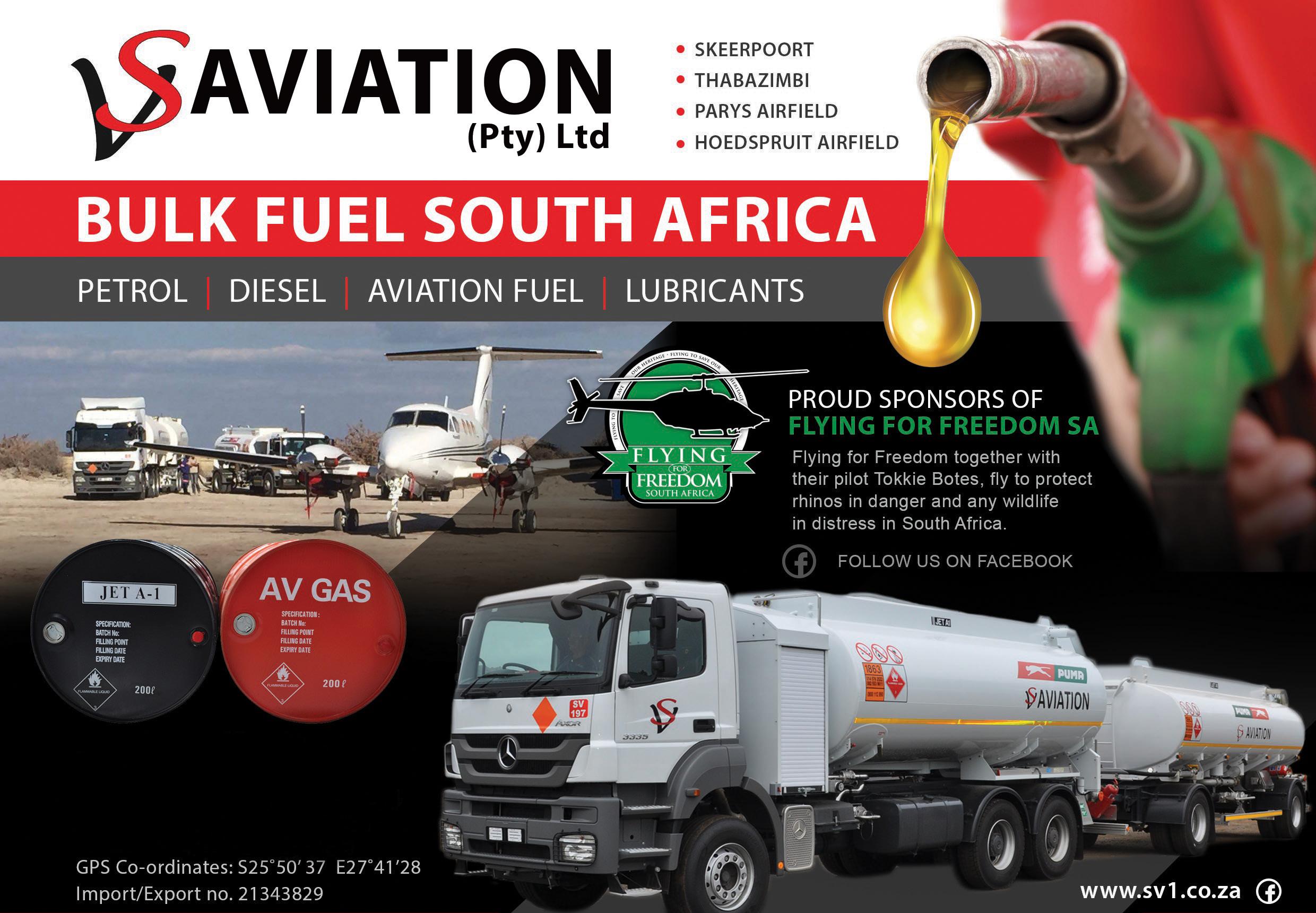


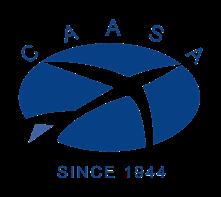

75 May 2023 WE ALSO HAVE AN ON-SITE HELI-PAD FOR CONVENIENT REFUELING. CALL US FOR A QUOTE OR VISIT OUR WEBSITE FOR MORE INFORMATION. SEALED 200L AVGAS DRUMS • SEALED 200L JET A1 DRUMS • AVGAS 100LL • JET A1 • PETROL • ILLUMINATING PARAFFIN • DIESEL • LUBRICANTS • HOEDSPRUIT • PARYS AIRFIELD • POTCHEFSTROOM AIRPORT • SKEERPOORT • THABAZIMBI • WONDERBOOM Tel: +27 10 446 9666 Danielle: +27 82 553 9611 Email: aviation@sv1.co.za Marina: +27 82 924 3015
FRIEDRICHSHAFEN 2023
by Guy Leitch
Aero Friedrichshafen is Europe’s premier general aviation Expo. Unlike conventional airshows, it is an expo as it uses static displays inside the hangars, rather than flying displays, as for instance Oshkosh Airventure does. Given the German weather and a train strike, it is perhaps appropriate that the organisers were not relying on the gee-whizz crowd pull of an airshow.
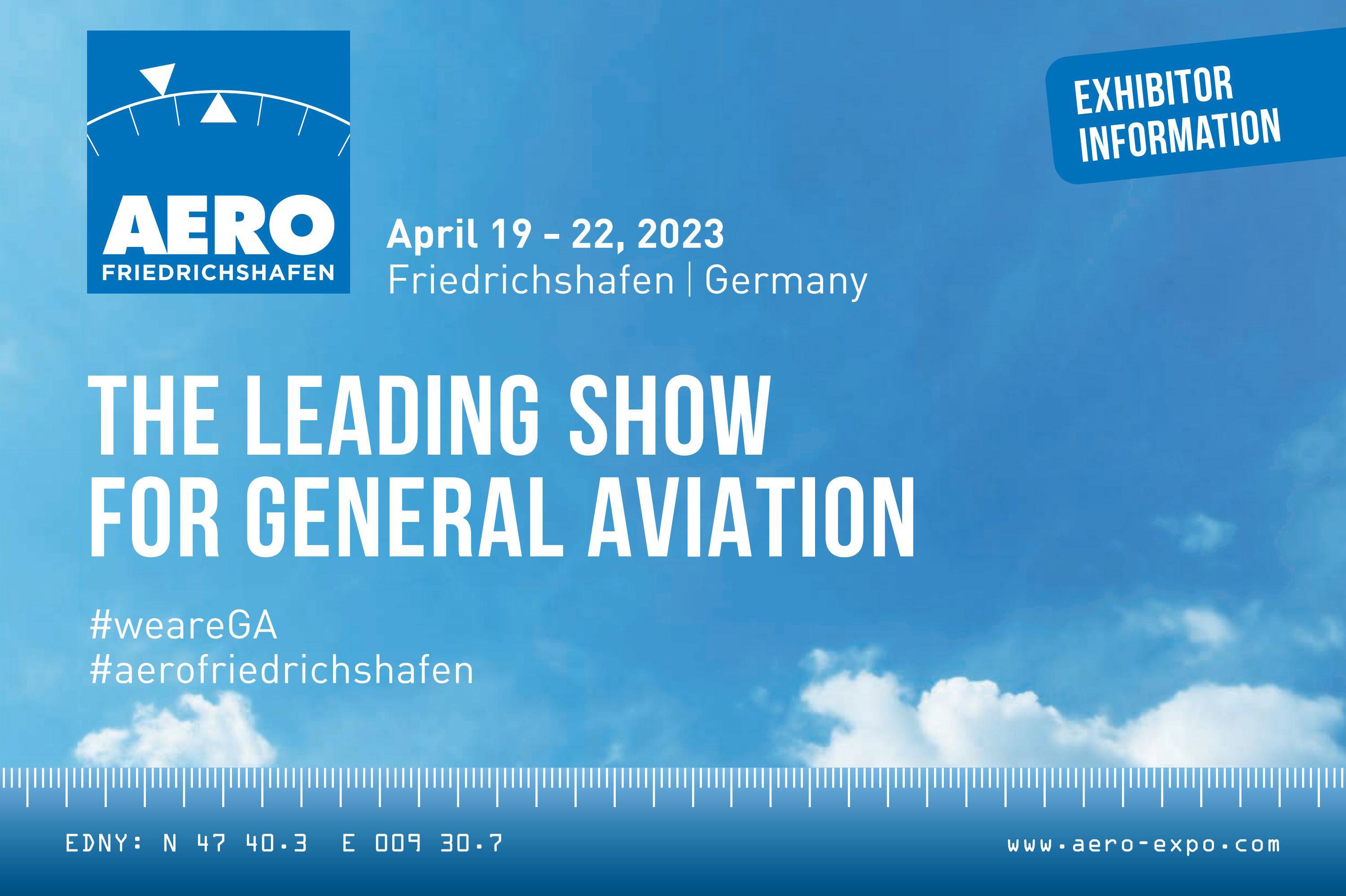
76 May 2023
AIR SHOWS AERO
AERO EXPO IS Europe’s biggest convention focused solely on GA, held in Friedrichshafen, Germany. With 670 exhibitors the 2023 Expo is almost back to pre-Covid levels. For 2023 it once again maintained its focus on both traditional designs and future trends. The organisers say that a high percentage of the 27,200 visitors hold a pilot’s license.


The American based OEMs happily make the trip across the pond to support this Expo. Notably, Cirrus, Textron, Piper, Garmin and Boeing subsidiaries Jeppesen and Foreflight, were prominent. There was also a notable newcomer; Gulfstream Aerospace, which displayed the new G500 (the first large-cabin, global-range bizjet to visit Aero).
Despite the American presence Aero still has a strong European look and feel. European daily life is marked by a pervasive concern about carbon emission reductions, sustainable fuel, and the
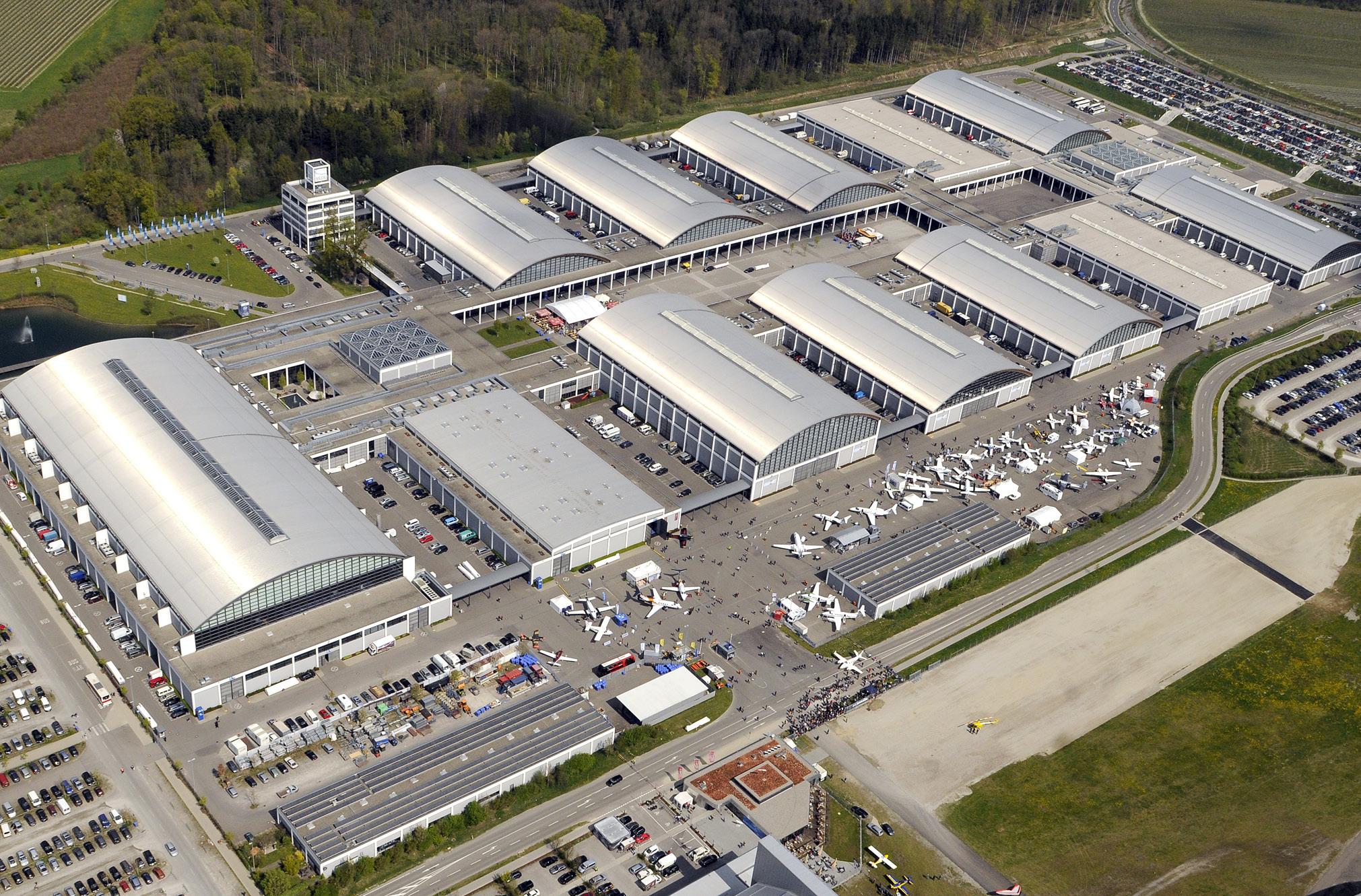
77 May 2023
Aero Expo is largely held indoors, as an Expo, rather than an airshow.
A Star of the show was the Junkers A60 with sideby-side seating.
The static park featured Gulfstream for the first time.
technology that advances those goals. This concern is reflected in Aero’s dedication to tracking progress in alternative propulsion schemes.
This year marked the tenth year that Aero dedicated exhibit halls to what it calls “e-flight expos.” There was a plethora of designs making use of battery-electric and hydrogen-powered aircraft — some of which are certified under EASA rules. This year’s e-flight expo had some 126 exhibitors.

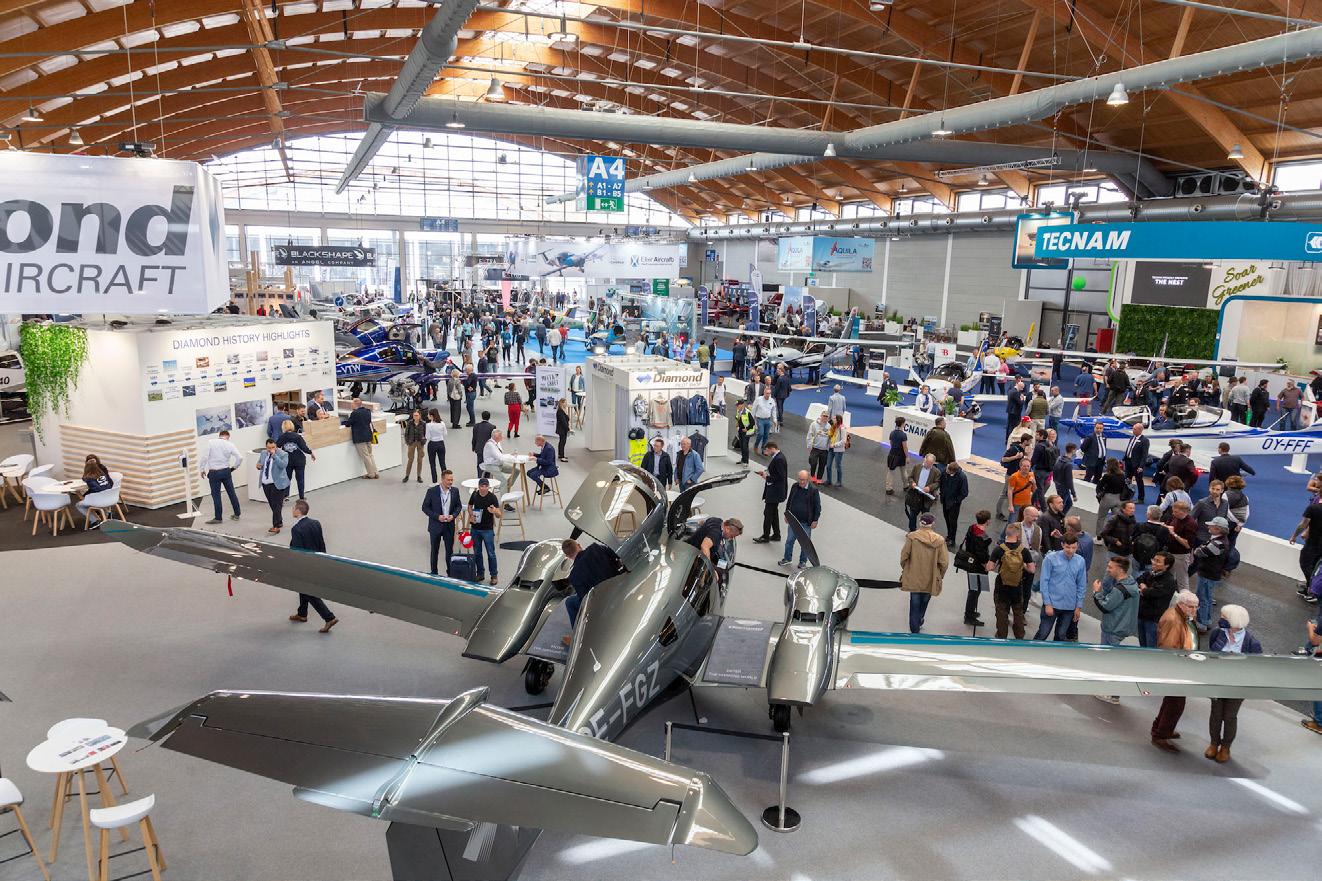
There is a rich vein of new technology designs and pure research efforts. Technical universities in Germany and other European Union states sponsor programmes that allow students to learn the science behind electric and hydrogen propulsion. One large exhibit area showed off the work of students at six different German universities and Technikons.

78 May 2023
The halls are always a hive of people looking for the latest developments in general aviation.
An all-electric Sling 4 was a popular exhibit.
The all-electric Sling 4 panel.
An Electric Sling
Notable amongst these was a Sling 4 which has an electric motor. The battery pack weighs 224 kg and provides 44 KWh, for an endurance of 1 hour and a range of 180 km. So it’s getting there but has some way to go to emulate the Sling’s globe trotting achievements with a Rotax 914.

Interestingly, electric vertical takeoff and landing aircraft (e-VTOL) and the more ambitious hydrogen designs, which have been plentiful at previous Aeros, seem to have peaked and were less well-represented this year.
Markus Fischer, from the German Aerospace Center (DLR), speaking at an Aero pre-show media day panel discussion, addressed the challenges that the eVTOL movement faces when he reminded the audience of a wellworn saying in aircraft manufacturing: “You must never over-promise, then under-deliver on a design. This is the biggest danger in the development of all aircraft, and it’s especially true at times like these. It will kill the future of the new design, investors will leave, and the future of the industry will be at risk,” Fischer said, adding that he was “not an eVTOL person.”
The big driver for new green technologies will come from training. Cate Brancart, manager of European operations and safety for the General Aviation Manufacturers Association, citing pilot shortages, emphasised the need for newer, more sophisticated training aircraft in the next two years. At the aero Career Day on the Friday, the trade show gave exhibitors a forum for the first time to offer interested parties concrete career prospects in aviation, which was well received.
Claus Cordes, president of the German Aero Club, also talked about the pilot shortage. “Air sports can be a significant future talent source for both pilots and the aviation industry in general,” he said.
One of the stars of the Expo was the new side by side corrugated-skin Junkers A60. Following the tandem seat Junkers A50 Junior, updated from 1929, the A60 is another new design with retro looks. “We wanted to offer our customers side-by-side seating, versus the tandem seating on the A50,” said Alexander Jainsky, the Junkers salesman. “The journey is the destination. It’s about the joy of flying an extremely beautiful machine; a lifestyle,” explained Jainsky.
79 May 2023
Green and Carbon-neutral energy are key drivers. This is the H55 electric motor in a Bristell B23.
Cirrus is always popular, despite their evolutionary rather than revolutionary development.
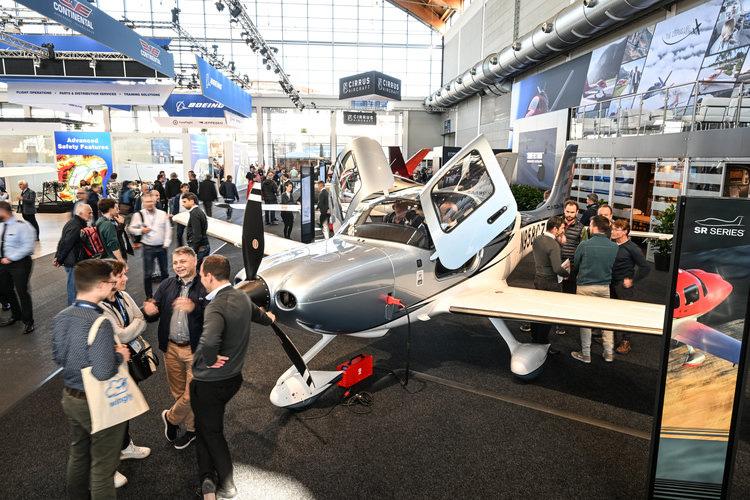
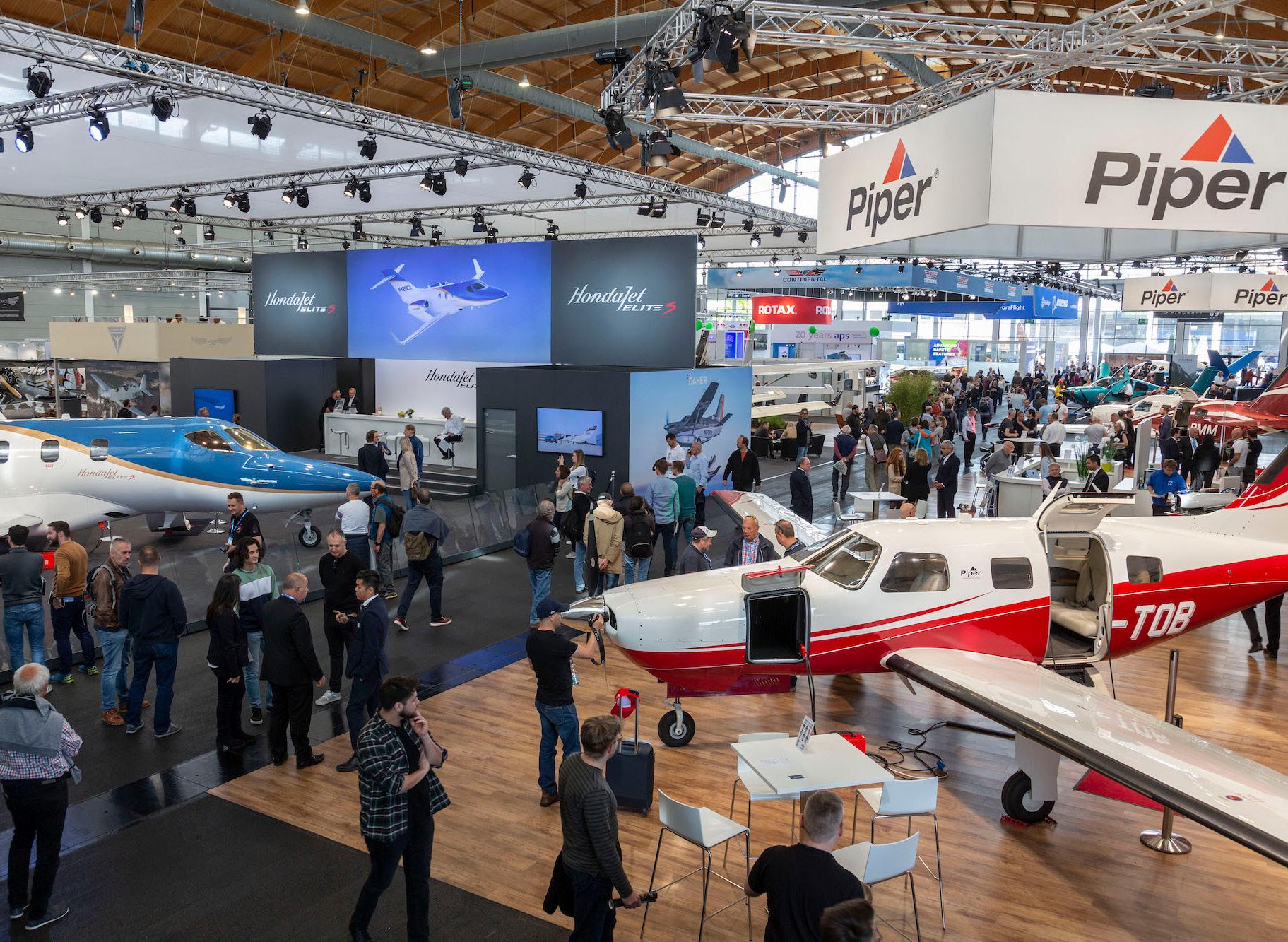
80 May 2023
American manufacturers see Aero as a not to be missed event.
Prices are around $260,000. The aircraft is powered by a 100-horse Rotax 912iS), and has retractable gear. There is a choice of canopy. If you opt for the sliding version to give you that convertible, open-air feel, the windshield is different than the fixed canopy.
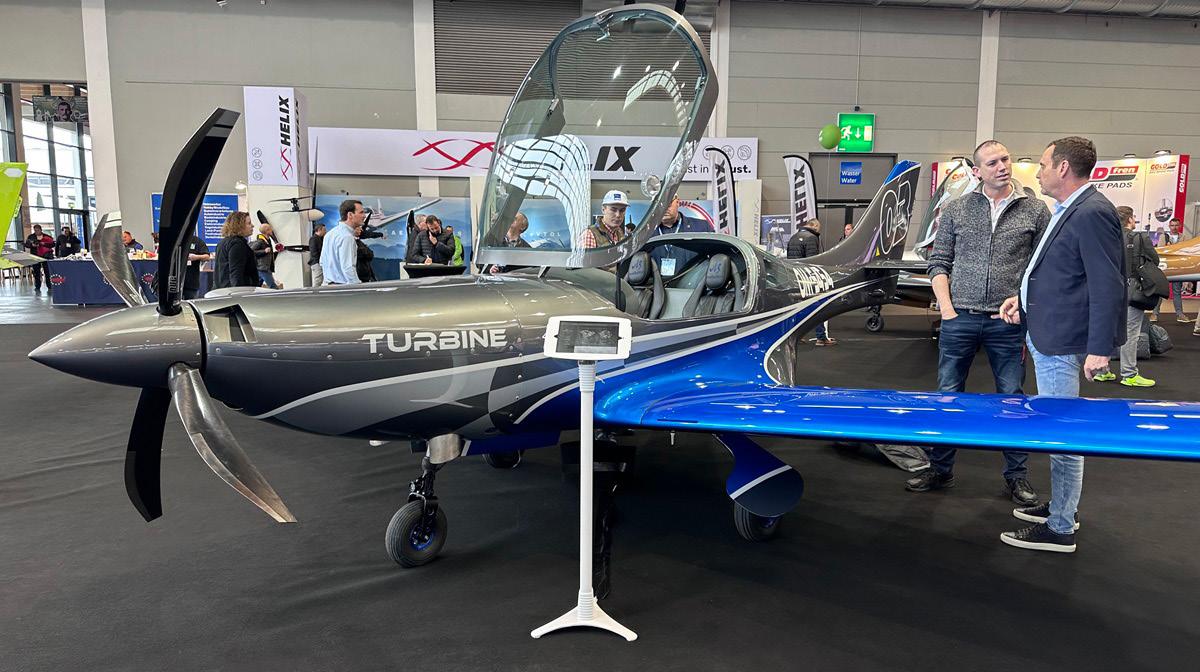
Yet another attempt at a small
-
Sustainable Aviation
Tobias Bretzel, AERO show director said, “The future of aviation is extremely exciting, but also sustainable. The innovative power of the industry is enormous and AERO visitors were able to see many ‘green’ technologies in the exhibition halls and learn about them in numerous conferences. Ecology and economy often go hand in hand: electric flight, for example, makes flying not only low-emission and low-noise, but also significantly cheaper.”
Staying with the ‘green theme’, Aero hosted a full-day symposium on the use of hydrogen as an aviation fuel for the first time.
(SETOps), with a day full of seminars and training moments.
Daher’s TBM 960 single-engine turboprop, featured as did the Extra NG, which is the latest aerobatic mount from Extra Aircraft and the first in its class to be equipped with an allcarbon rigidbase frame – a first in the history of aerobatics.
When the expo ended on 22 April, the Expo was deemed successful for the organizer as well as the exhibitors.
Single Engine Turbines
Another key input to the 2023 show is the pending approval for single engine turbine IFR air taxi operations. EASA’s much-anticipated decision to open the market to singleengine turbines commercially at night and in instrument meteorological conditions—termed “CAT-SET-IMC”—promises to revolutionise the industry. To support this, Aero hosted a Single Engine Turboprop Operations Conference

81 May 2023
a high percentage hold a pilot’s license.
JMB Aircraft was one of the first to display the Turbotech Turbine.
j
turboprop
the Turbotech TP-R90 mixes intake air with exhaust gases to reinject it into the combustion chamber.
ALUMINIUM
2024, 3003, 6061, 7075
STAINLESS
15-5PH, 17-4PH, 17-7PH
ALLOY STEELS
ALUMINIUM 2024, 3003, 6061, 7075



4130 ANNEALED AMS 6350 4130 NORMALIZED AMS 6345
TITANIUM
6AL-4V, CP1, CP2, CP3, CP4
STAINLESS 301 15-5PH, 17-4PH, 17-7PH
IN ALL FORMS OF: SHEET, PLATE, COIL, ROD, BAR, TUBE, EXTRUSIONS
ALLOY STEELS

4130 ANNEALED AMS 6350
4130 NORMALIZED AMS 6345
ALL MATERIAL FULLY CERTIFIED TO INTERNATIONAL STANDARDS, SUCH AS: AMS, QQ-S, QQ-A, ASTM, SAE, MIL
TITANIUM
www.alclad.co.za I Ed Knibbs: +27 83 251 4601 I ed@alclad.co.za
6AL-4V, CP1, CP2, CP3, CP4

IN ALL FORMS OF: SHEET, PLATE, COIL, ROD, BAR, TUBE, EXTRUSIONS
ALL MATERIAL FULLY CERTIFIED TO INTERNATIONAL STANDARDS, SUCH AS: AMS, QQ-S, QQ-A, ASTM, SAE, MIL






























www.alclad.co.za I Ed Knibbs: +27 83 251 4601 I ed@alclad.co.za
www.alclad.co.za | Ed Knibbs: +27 83 251 4601 | ed@alclad.co.za
Visit us at our partner company at the Paris Air Show, Paris Le Bourget Exhibition Centre, Hall 3, USA Pavilion, Booth 3-F174, Mon, Jun 19, 2023 - Sun, Jun 25, 2023













82 May 2023
ZAF ORDERS ENSTROM 480B HELICOPTERS
THE ZAMBIA AIR FORCE (ZAF) has ordered two Enstrom 480B helicopters for training.

The helicopters will be used for training and utility missions – a training package is included in the deal.
The helicopters will be equipped with cargo hooks and hard points for cameras, as well as Garmin EFIS. One helicopter will be supplied with a full glass cockpit and one with a hybrid glass and analogue panel to provide training with a flight deck similar to the round-gaugeequipped Mi-17s used as the mainstay of the fleet.
South Africa’s Safomar Aviation assisted Enstrom in the sale to the ZAF, including logistics, specifications, and configuration of the
helicopters. Safomar has previously assisted in the sale of three Enstrom 480B helicopters to Botswana’s police service.
Shai Shalem, Managing Director of Safomar, said, “We are excited to have Enstrom back and under new management with exciting and excellent helicopter upgrades. It is an honour to have sold two of the first helicopters off the line under the new ownership. These 480B’s are just the right fit for military and Law Enforcement missions.”
Enstrom went out of business in January 2022 but was purchased by Surack Enterprises in May that year. Production under new ownership resumed some months later, and the first new helicopter was completed in January this year.
83 May 2023
NEWS
j
Enstrom 480B has been ordered by the Zambian Air Force
KALAHARI BUNDU BASH ADVENTURE
4-7 May
Pan, Northern Cape
Contact:
459 2636 or 054 331 3534 E-mail: kbb@rafsa.co.za
BONA BONA FLY-IN AT THE BONA BONA AIRFIELD AND COUNTRY LODGE
5-7 May
Bona Bona Lodge, Wolmaransstad
Contact: Christian 083 251 4573
E-mail: christian@vsg.co.za
SAPFA SPEED RALLY NO.1 AT BONA BONA AIRFIELD
6-7 May
Bona Bona Lodge, Wolmaransstad
Contact:
David le Roux 073 338 5200
Email: david@pilotinsure.co.za
GRAIN SA’S NAMPO HARVEST DAY
16 – 19 May
Contact:
Wim Venter 086 004 7246
E-mail: wim@grainsa.co.za
ZEBULA FAMILY WEEKEND FLY-IN
19 – 21 May
Location: Zebula
Contact:
Sean Hensman 078 460 2259
E-mail: info@efaf.co.za
SAA MUSEUM HOBBY AND COLLECTABLES FAIR
20 May
Rand Airport Main Terminal Building
Contact: 076 879 5044
E-mail: events@saamuseum.co.za
NAC FLY-AWAY TO NAMIBIA
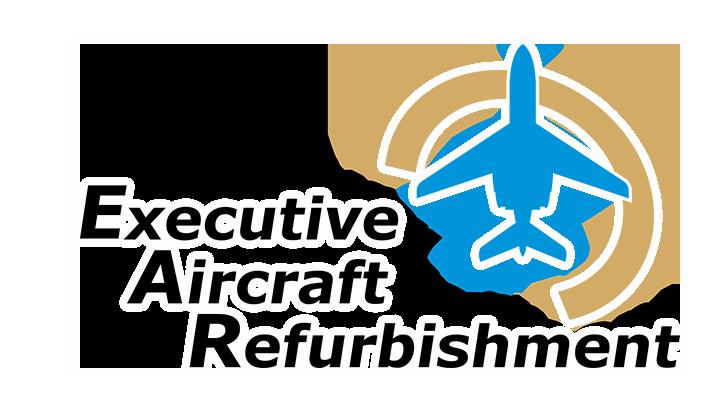
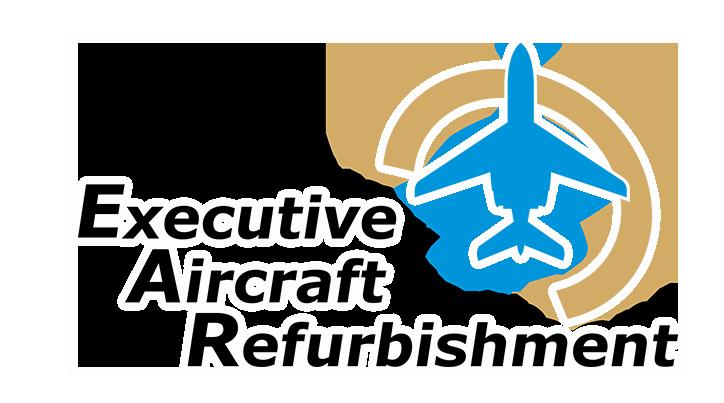


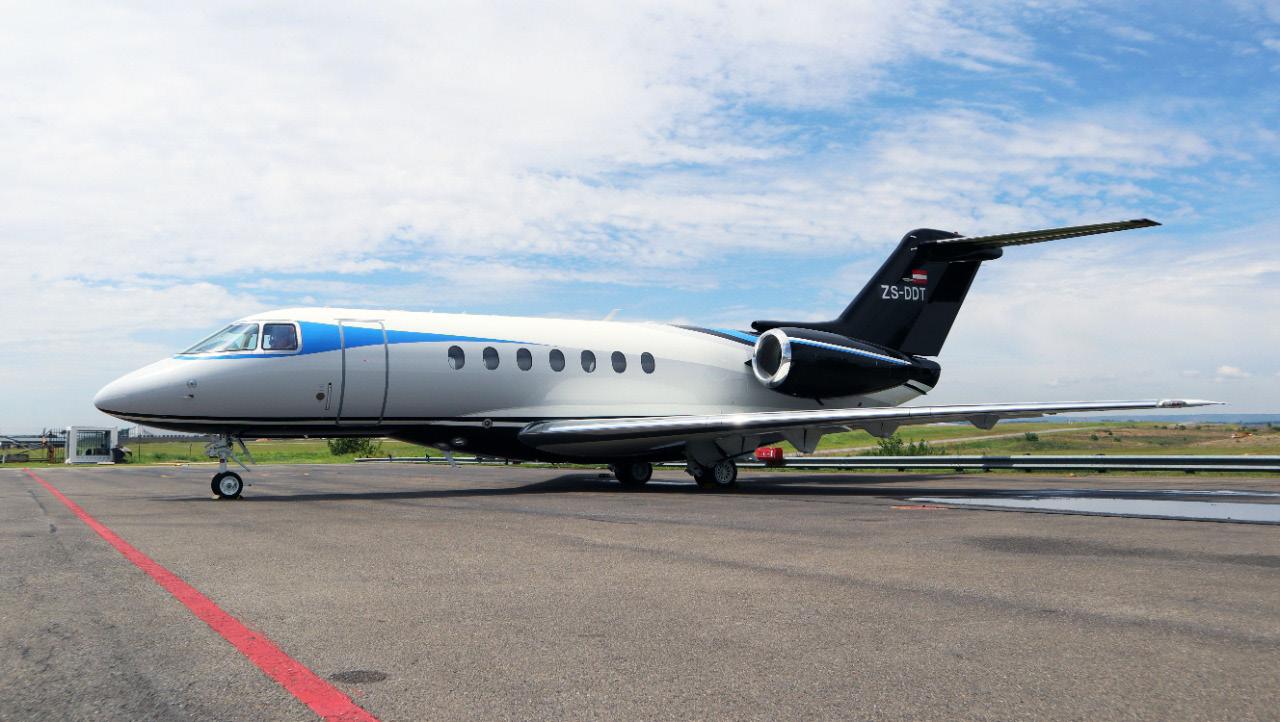
4-8 May Volksrust
Contact: Agnes Phillips082 893 3399
agnes.phillips@nac.co.za
KUZUKO LODGE AND PRIVATE GAME RESERVE RV FLY-IN SAFARI
5-7 May
Kuzuko Loge, Addo, Eastern Cape
Contact: E-mail: kuzuko@legacyhotels.co.za
LOWVELD AIRSHOW AT NELSPRUIT AIRFIELD
13 May Nelspruit Airport
Contact: Johan Heine 082 456 5909
E-mail: Johan@kishugu.com
ORION TRAINING, TECH, DRONES AND UNMANNED AVIATION CONFERENCE

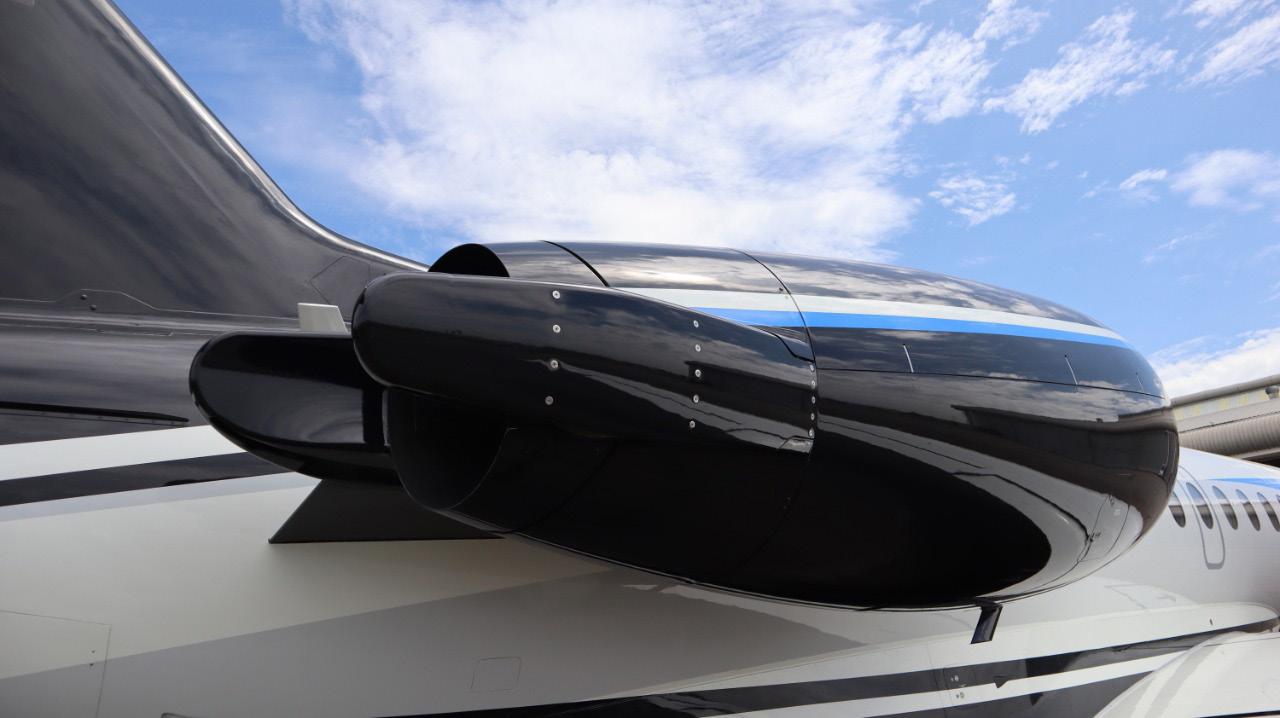

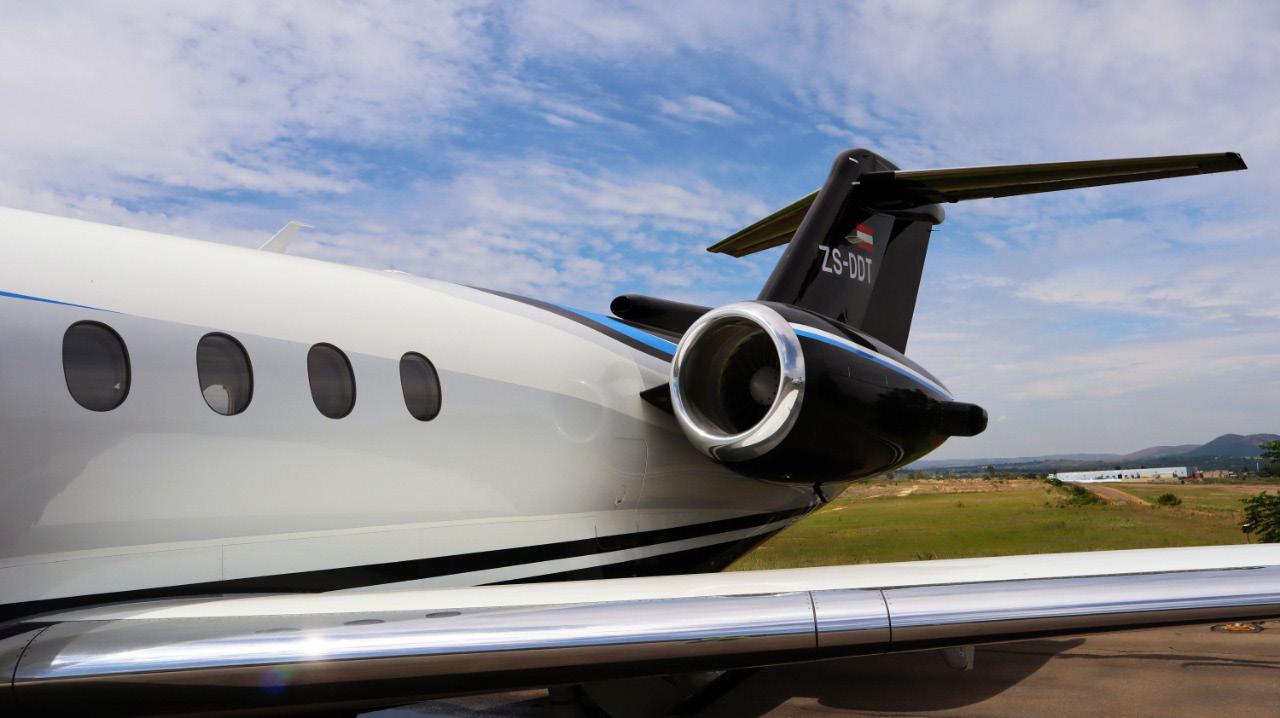
18 – 19 May
Contact: habo Ndimande 072 663 2724
E-mail: thabo@orion-training.co.za
EAA CHAPTER 322 BREAKFAST FLY-IN AT FLY INN ESTATE
20 May
Fly Inn Estate , Elandsfontein, Gauteng
Contact: Neil Bowden
E-mail: airadventuresa@gmail.com
SAAF MUSEUM ANNUAL AIRSHOW AFB ZWARTKOPS
5-6 May
SAC NATIONAL AEROBATICS CHAMPS
16 – 19 May
Tempe Aerodrome, Bloemfontein
Contact: Annie Boon 082 902 8614
E-mail: info@anniesaviationcorner.com
SAGPA GYRO FLY-IN TO BONA BONA AIRFIELD
19 – 20 May
Bona Bona Airfield
Contact:
Tommie Jordaan 082 802 3221
NEW TEMPE AIRSHOW BLOEMFONTEIN
20 May Bloem
Contact:
Conrad Botha 082 770 5505
E-mail: rowco24cc@mailbox.co.za
SAPFA PRESIDENTS’ TROPHY AIR RACE
25 – 28 May
Middelburg Airfield
Contact: Iaan Myburgh 082 449 2531
E-mail: iaanmyburgh@gmail.com
Website: www.sapfa.co.za
84 May 2023 Tel: +27 (0)10 900 4149 | Mobile: +27 (0)82 547 8379 Info@earefurbishment.com | Francois@earefurbishment.com Hangar 24 (Interior Shop) and Hangar 31 (Paint Shop). Lanseria International Airport, South Africa, Gate 5 North Side. EVENTS CALENDAR
MONTHLY GATHERING 6
07h30 Rand Airport Main Terminal Building
E-mail: airadventuresa@gmail.com
EAA CHAPTER 322
May @
Contact: Neil Bowden
Koppieskraal
078
E-mail:
Bela
Bela Airfield Contact: Maj. Ntshangase 012 351 2289
RAND AIRPORT AVIATION COMPANIES GUIDE
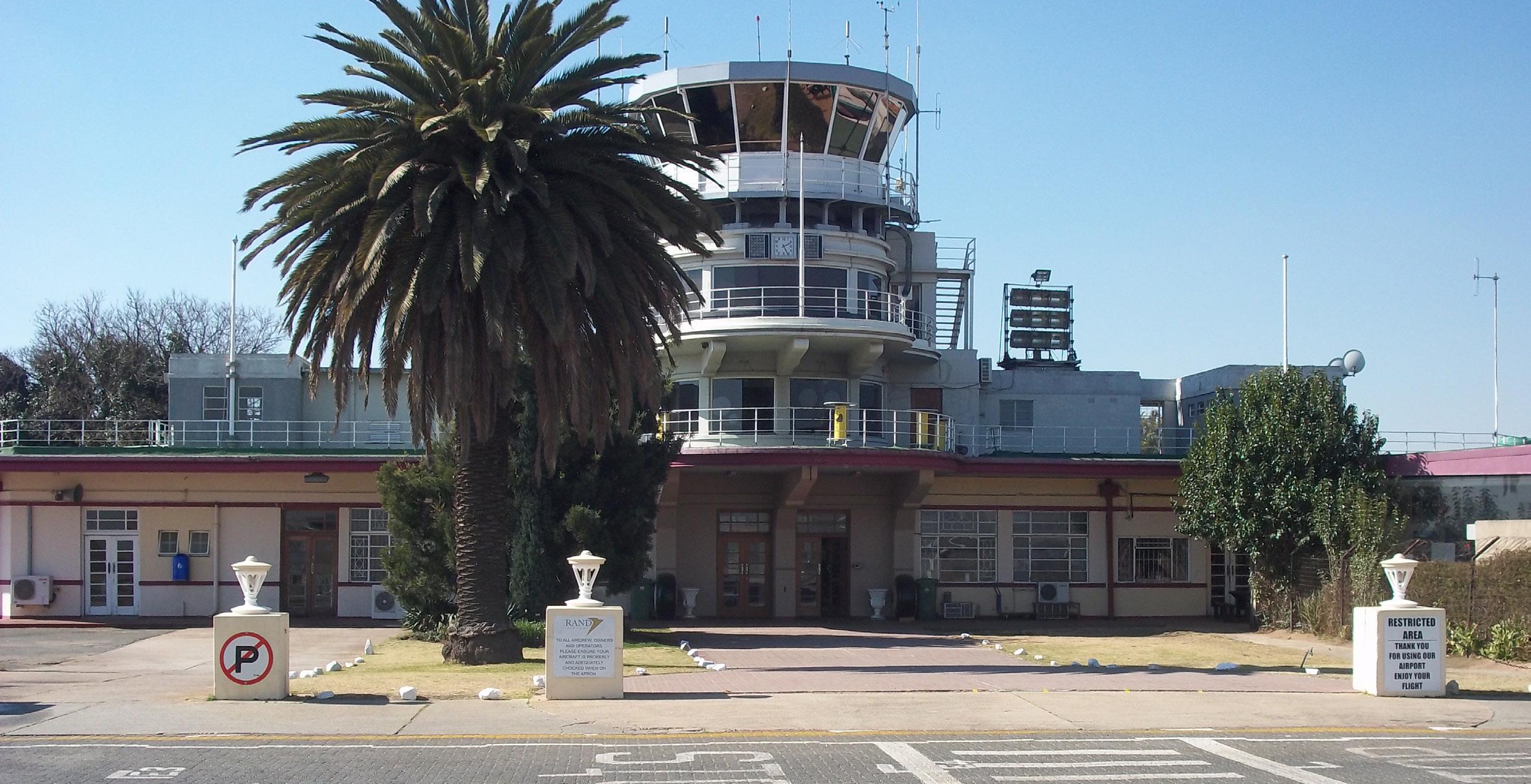
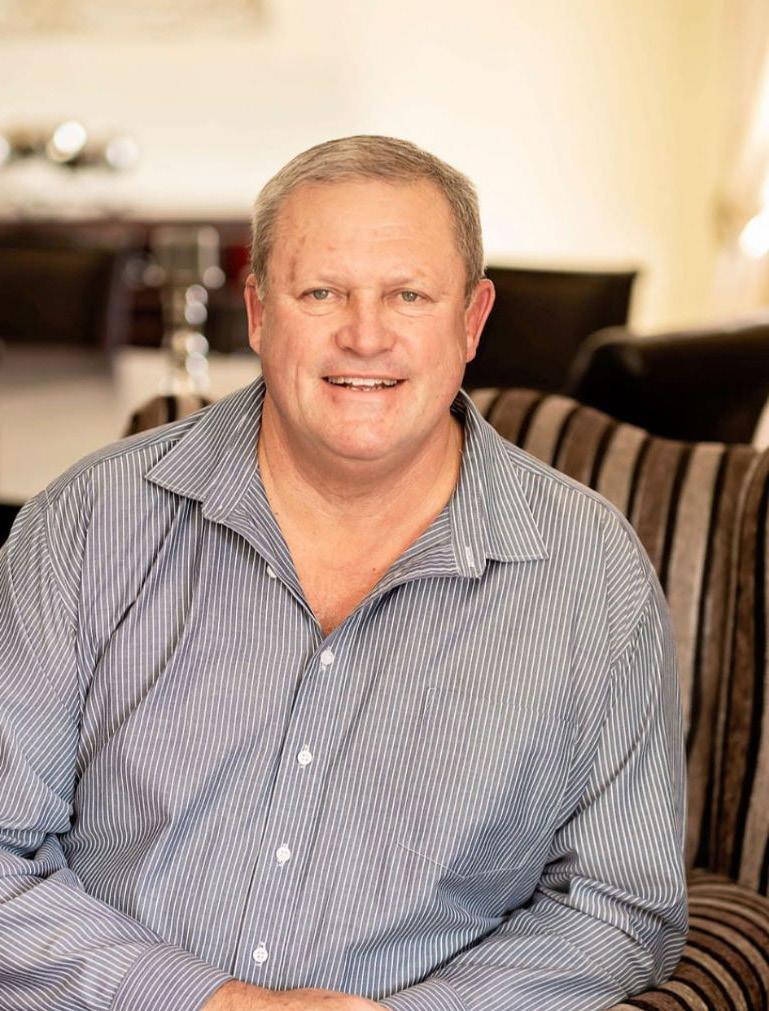


RAND AIRPORT
A Management era at Rand Airport has ended. Six years
his appointment, Rand
DESPITE THE VOLATILE TIMES and the stresses of the Covid pandemic on aviation, Rand Airport has managed a commendably low staff turnover – especially at General Management level. The previous General Manager, Anton Kruger, was in the hot seat for 12 years before he retired.
Following Anton Kruger, Stuart Coetzee was the ideal person to run the airport as, prior to his appointment he had a twentyfive year involvement with the airport and is one of its 19 private owners.
Stuart’s involvement with Rand began when he managed the well-known Vics Flight Centre and it was forced out of the old Baragwanath by the airport’s closure by the Johannesburg City Council who wanted to develop the land for industry.
Vics Flight Centre moved to Rand in 1984 and
Manager,
so Stuart has been intimately involved with the airport for almost forty years. When Vics closed in 2009 Stuart continued at the airport in a number of capacities, one of which was as a consultant on the all-important fuel supply.
When the airport was sold off by the Johannesburg City council in 2000, a specific condition of the sale was that it had to remain an airport at least until 2020. The ownership structure of the airport is unique in that all the hangars are owned with full freehold title. When the airport was sold in 2000 some of the hangar tenants elected` not to buy their hangars and so these are owned by the Airport Holding company and are let to tenants, providing essential long-term income for the management and up keep of the facilities.
Over the past 13 years the ownership of the airport has been remarkably steady, a testimony to how well the original sale ownership structure
86 May 2023
since
Airport General
Stuart Coetzee has ‘been retired’. It is notable that he has not resigned for greener pastures but was essentially forced into retirement due to advancing age.
in the hot seat for 12 years
Introduction
was conceived and assembled. There were originally 23 private shareholders in 2000 and there has been very little change.
Most of the hangar sales have been taken up by existing owners the there has been a small consolidation to the current 19 owners plus the Mayondo BBBEE consortium and Ekurhuleni Town Council.
companies closed shop and many tenants struggled to pay their rent. Sympathetic to their plight, the airport management provided a rent holiday and is helping tenants bring their accounts up to date.
Fortunately, the airport’s finances are healthy due to the development of an industrial park to the south of the threshold of Runway 29. Development is proceeding apace with large warehousing emerging from the ground. All nine industrial stands comprising have been sold.
Still the Grand Rand Airport
Despite the impact of Covid, by the end of 2022 the airport’s operations levels were almost back to pre-Covid levels.
The Covid pandemic impacted general aviation hard – and Rand had its fair share of the economic damage. A number of longestablished businesses such as car rental
Demand for the airport facilities remains strong. There are currently no vacant hangars and all office space is fully let, with a waiting list. This is not only due to the strong recovery of the aviation businesses on the airport but the movement of large operators from other airports around Gauteng to the more friendly and central environment that Rand provides.

87 May 2023
Rand Airport's iconic Art Deco terminal building.
The airport is proud of it’s a safety record with no fatal accidents having happened over the past two years – despite the large number of movements and the number of flying schools.

The airport also hosts the large ‘Grand Rand Air Show’ which plays a vital role in making aviation accessible to the masses, particularly the underprivileged.
The Aerotropolis Proposal
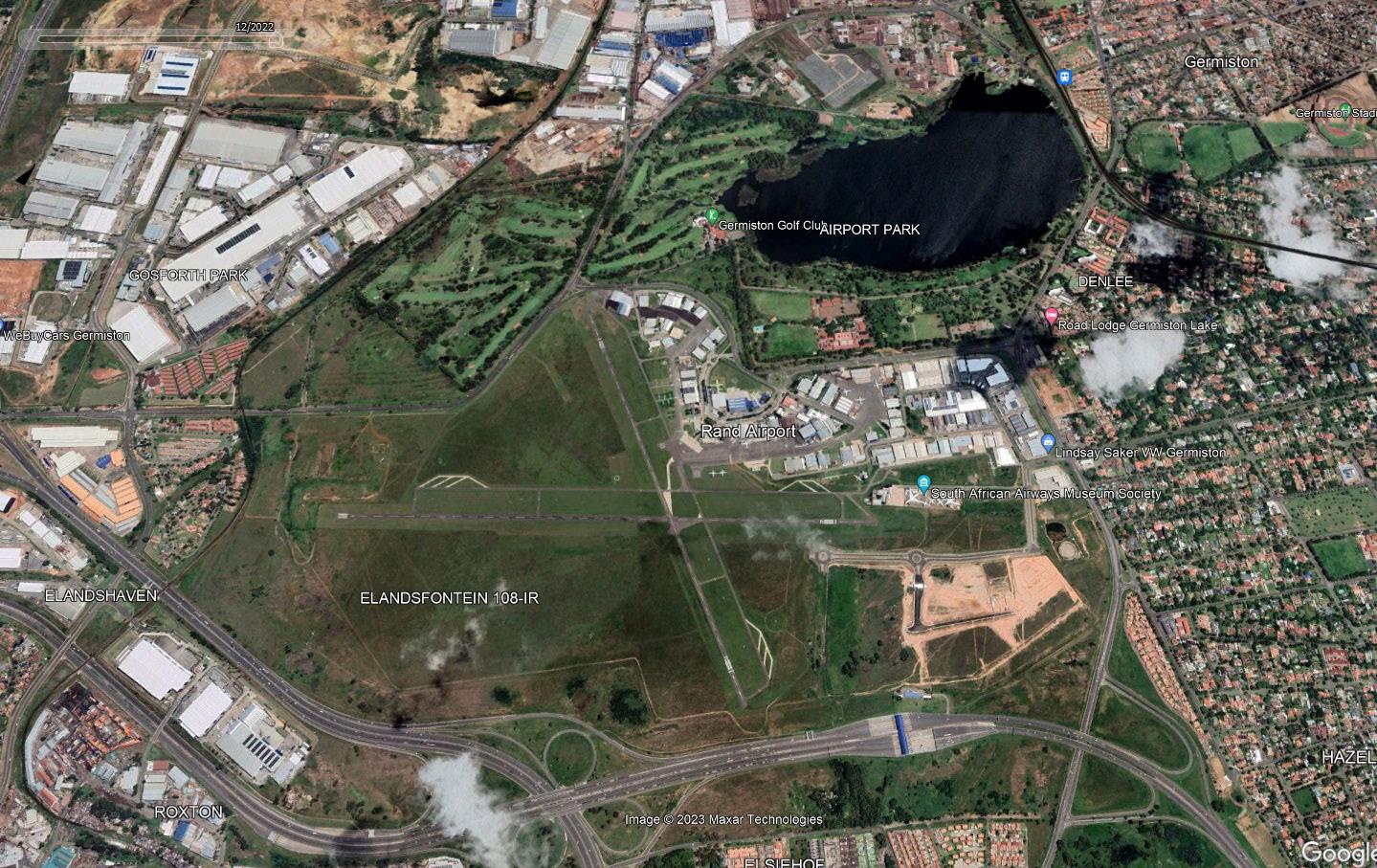
The central location of Rand Airport is recognised by the airport’s local authority, the Ekurhuleni Metropolitan Municipality. Ekurhuleni continues to promote an ‘Aerotropolis’ that recognises Rand Airport’s proximity to OR Tambo International.
The airport is also very well located near the centre of the Witwatersrand’s network of highways and rail network. The recent highway upgrade makes it convenient, even for those aircraft owners who live in northern suburbs.
88 May 2023
General Manager Stuart Coetzee has now retired after more than 30 years involvement at Rand.
Introduction
A recent Google Earth image of Rand Airport showing the new development south-east of the threshold of Runway 29.
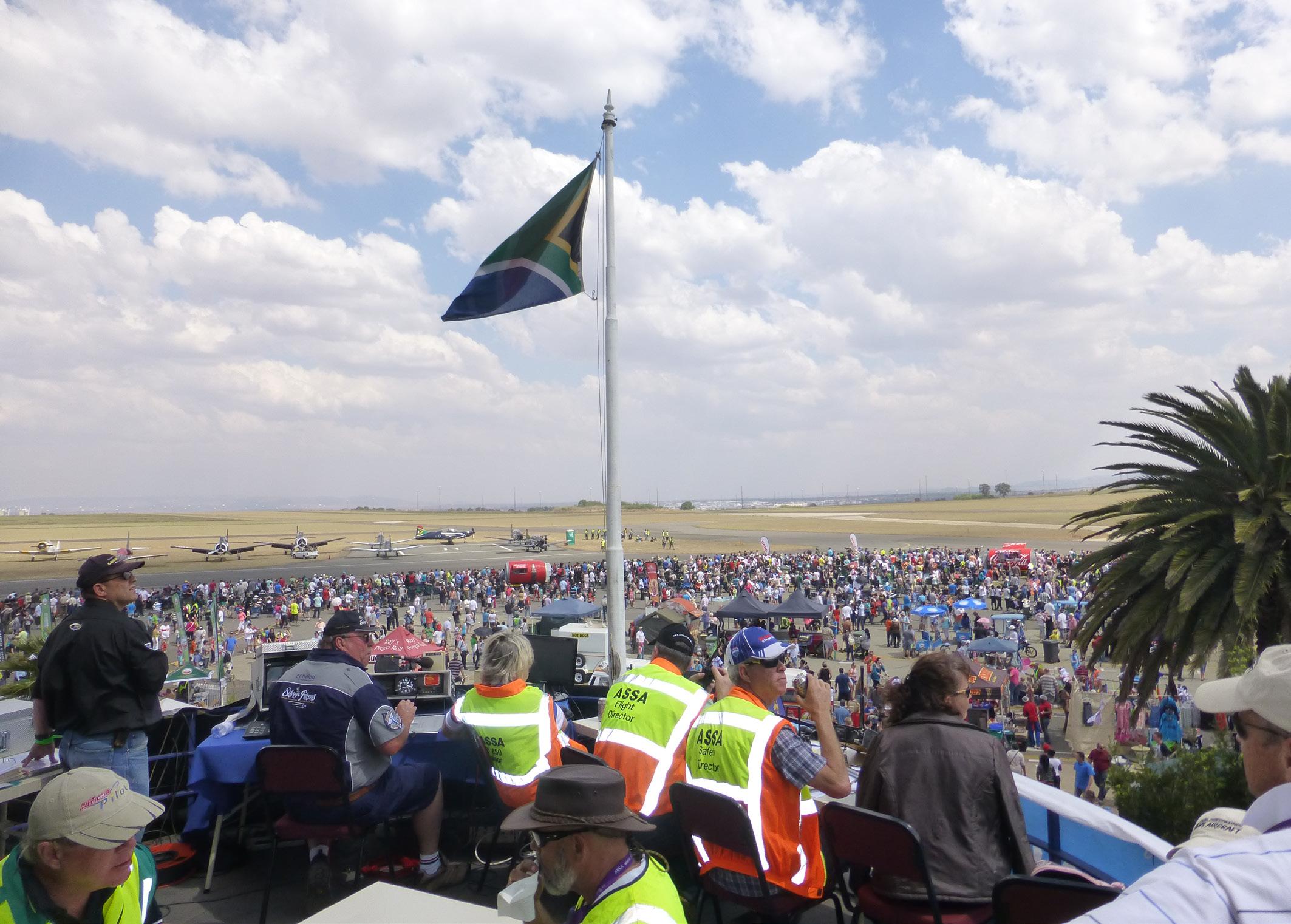

89 May 2023
Rand Airport maintains a Cat 6 fire department which operates from 06h00 to 21h00,
Held on a Sunday, the Rand Airshow is a great outing for the whole family to enjoy.
The ownership consortium has embarked on a revamp campaign, emphasising; “It has the potential to become the complete integrated Airport Park,” which will include hotels, shops and an industrial park.
has been very little change. Over the past 22 years the ownership of the airport has been remarkably stable, a testimony to how well the original ownership structure was conceived and assembled.
the airport is unique j
The airport has proven to be a tremendous investment for its owners with some suggesting the initial R18 million purchase price might today have been transformed into a value of well over R500 million. There were originally 23 private shareholders in 2000 and there
The ownership structure of the airport is unique in that all the hangars are owned with full freehold title. When the airport was sold in 2000, some of the hangar tenants elected not to buy their hangars and so these are owned by the Airport Holding company and are let to tenants, providing essential long-term income for the management and up-keep of the facilities.
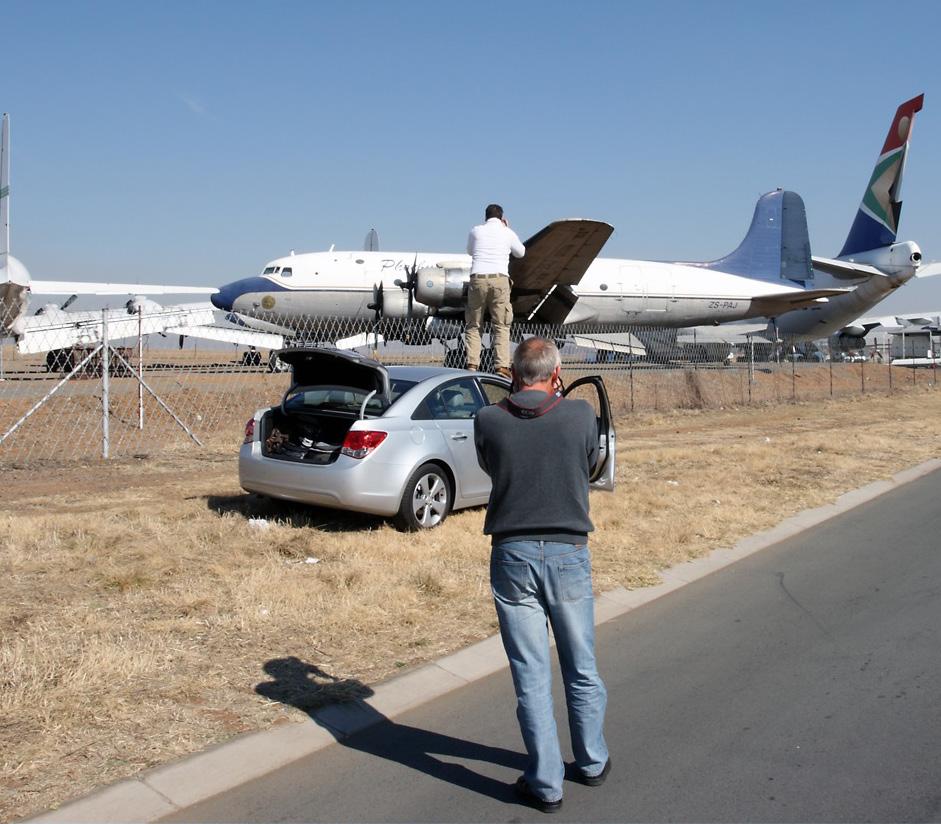
90 May 2023
Introduction
International plane spotters make pilgrimages to Rand Airport's Historic Society compound. Pic Stauffenberg.
HISTORY
RAND AIRPORT IS LIKE A classy old dowager. In its almost ninety years the airport has seen grand times and great moments.
The SAA Museum Society provides an invaluable description of the incredible early days of the airport: Rand Airport was originally constructed in the 1930s when it consisted of just a grass-covered field and a hangar.

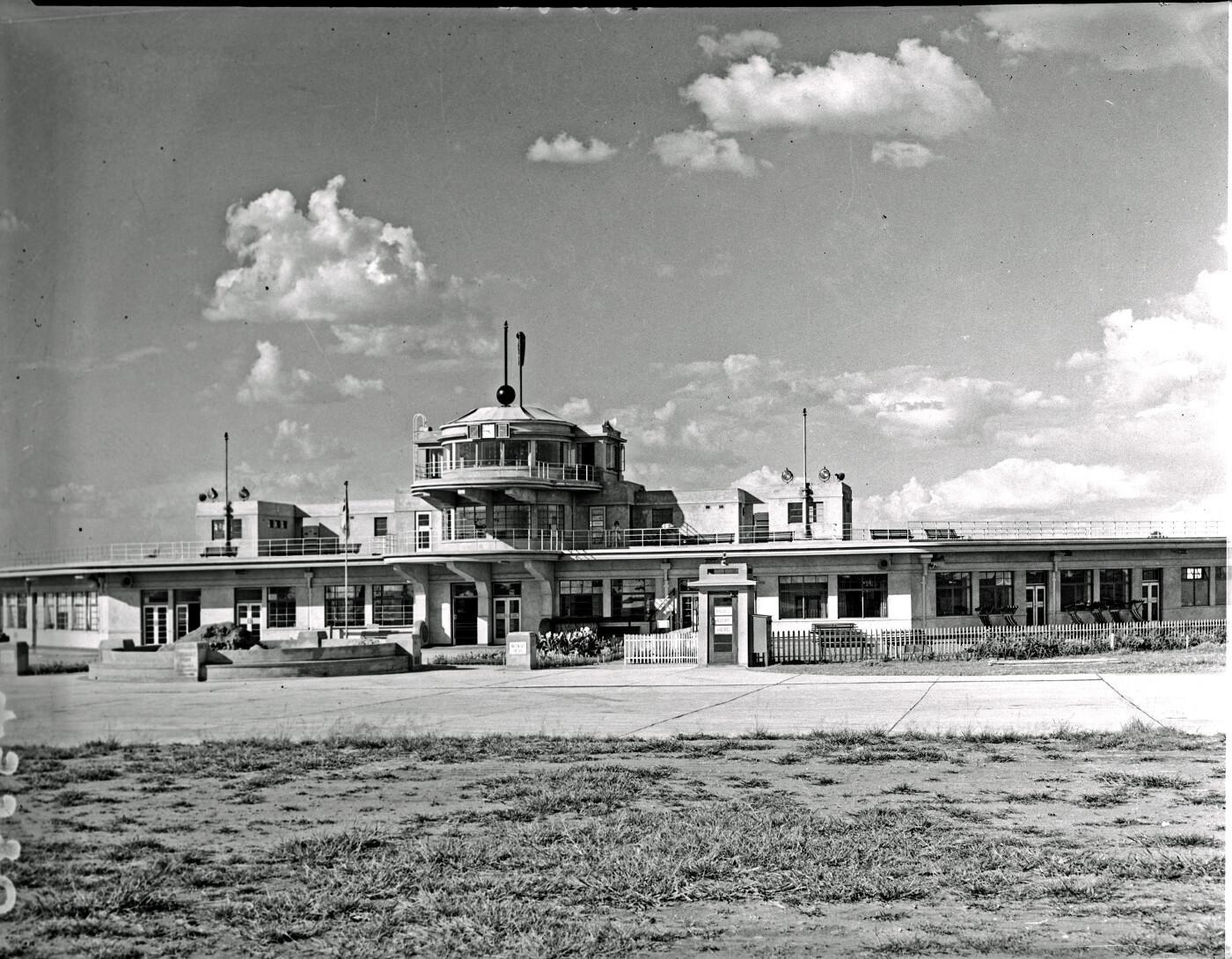
In 1929, when Imperial Airways made it known that they definitely intended to organise a service to South Africa, the energy and vision of the Municipality of Germiston (afterwards backed up by the Johannesburg Civic Authorities) laid the foundation of what would eventually become Rand Airport.
It was a bit of a free for all until the Transport Commission brought some kind of order. On 21 December 1931 the first flight of Imperial Airways arrived from London at Rand Airport and the airport was officially opened by the Governor General, the Earl of Clarendon.
In 1931 the various governments concerned concluded arrangements with Imperial Airways to run a service from London to the Cape. The Germiston Municipality was officially approached by the Union Government to provide an adequate airport capable of handling day and night traffic and of housing aircraft larger than any previously used in South Africa. As a result of the negotiations the Germiston Town Council voted £65,000 for the conversion of the old aerodrome into a properly equipped airport, and work started at once.
One large and one small hangar, as well as an administrative office building and workshop for Imperial Airways, were constructed. A complete floodlighting system was installed and a number of cottages built for the staff of Imperial Airways. Also erected were wireless masts for communication with the Imperial Airways aircraft.
The Governor-General, the Earl of Clarendon, officially opened Rand Airport in December 1931. Over 2,500 people drove, rode or walked to the aerodrome to attend the opening. The following day, 20 December 1931, the first Imperial Airways airmail from London arrived at Rand Airport.
Growth was quick. As a result of increased activity at Rand Airport a decision was made to improve facilities and a new air station was built to provide adequate control of the movements of aircraft from a properly equipped control tower, and to cater for the comfort of passengers by means of waiting rooms, baggage hall, Customs office and restaurant. Until the time of
91 May 2023
The Terminal building in ealry days - before the control tower was added. DRISA archive
Rand Airport's original clock.
the erection of the air station, the passengers’ baggage was dumped on the ground and sorted in the open while friends meeting air travellers were obliged to stand about in the open in all weathers for indefinite periods.
In addition, a clubhouse for the Rand Flying Club, a house for a resident Customs official and a meteorological station were erected. Previous to the building of the clubhouse, flying club members were accommodated in a small reed roofed shack which, owing to the rapid increase in membership, soon became too small for them.
For the second time the Governor-General opened the New Rand Airport, on Monday 5 August 1935. At the time it was considered that sufficient development work had been done to last many years.
But inevitably it was not so. The introduction of the Empire airmail, the continually increasing activity of South African Airways and the greater interest in private flying necessitated further development.
Soon after the opening in 1935 seven more hangars were erected, a larger clubhouse built for the Rand Flying Club, the South African Airways administrative building was greatly enlarged and buildings, both temporary and permanent, provided for the fuel supply companies and flying schools operating from the airport.
Even this was not sufficient and in 1939 work began on constructing two further hangars, as well as extensions to existing hangars and
alterations and additions to the air station. A mess for South African Airways staff, a wireless workshop and an engine workshop were also constructed.
The terminal building has remained virtually the same since it was built. The only noticeable change is the addition of a new control tower, which was added on top of the existing structure. A special feature of the 1935 terminal building was the flat roof, which to this day is open to the public and gives a fine view across the airport.

Before World War 2 the airport was owned jointly by the Germiston City Council, the Rand Gold Refinery and Elandsfontein Estates. It became the headquarters of South African Airways when its head office was moved from Durban on 1 July 1935. After World War 2 SAA moved its headquarters to Palmietfontein Airport in 1948 due to runway length constraints. Nevertheless, Rand Airport still grew with vigour after the Second World War due to the pool of ex-airforce pilots.
Rand became the busiest airport in the southern hemisphere. However, during the 1980s, several corporate and charter operators moved to Lanseria Airport. The runway at Lanseria is considerably longer than those at Rand Airport, and the airport elevation is 1000 feet lower (4517’ as opposed to 5482’ at Rand Airport). In response to the exodus from Rand, its main runway, 29/11, was lengthened, but not to any large degree due to the geographical constraints of the site.
92 May 2023 Introduction
j
Rand Airport taken around 1934 - as the Ju52 on the apron was delivered in 1934.
Contact Details: Rand Airport Road, Terminal Building, Germiston, Gauteng Tel. No. 011 827-8884/5/6

Who to Contact: Kevin van Zyl - Managing Director Tel: +27 76 801 5639 Email: kevin@horizonrisk.co.za
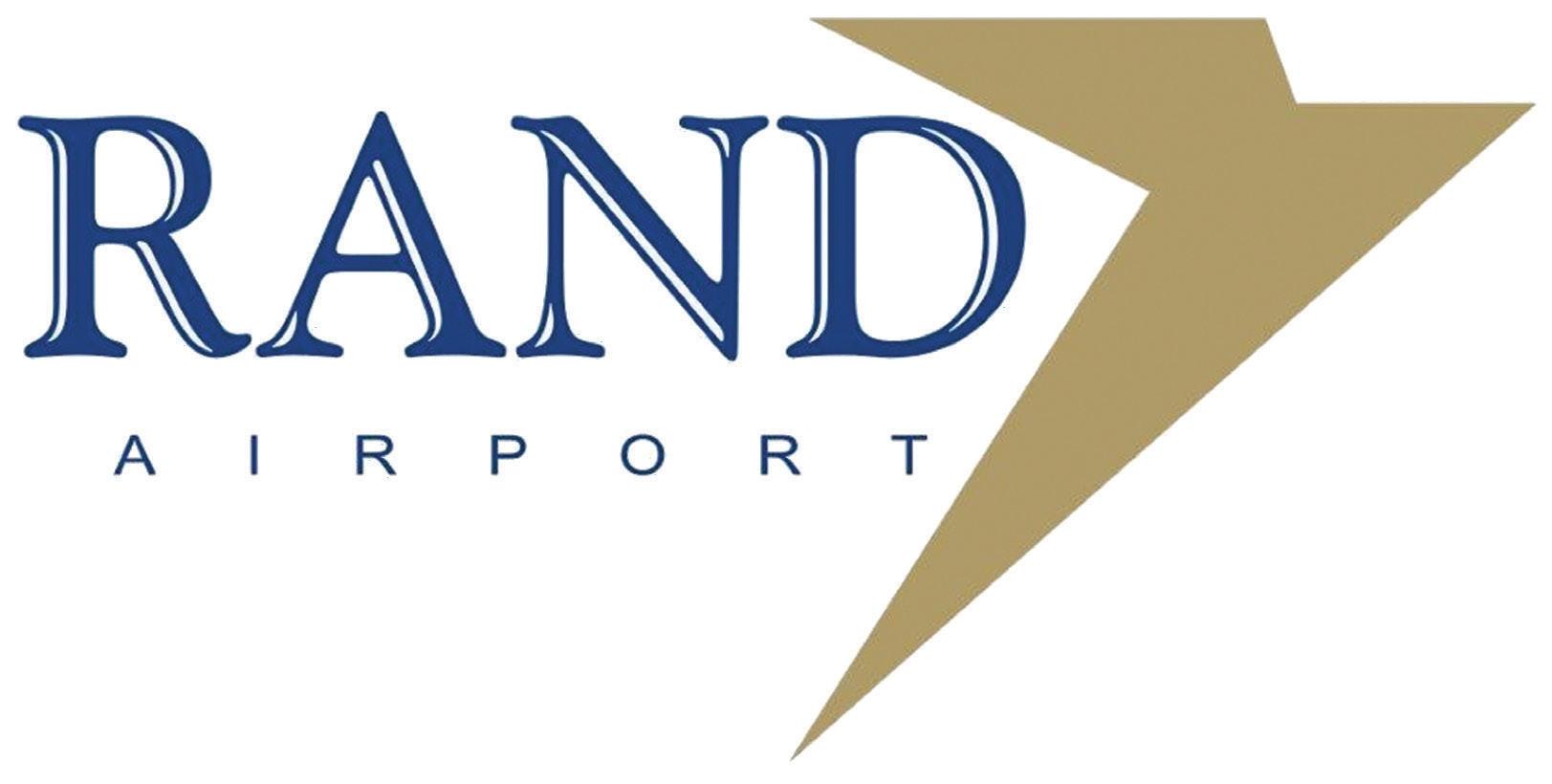
93 May 2023 SAF 2023|05 Image: Frans Dely

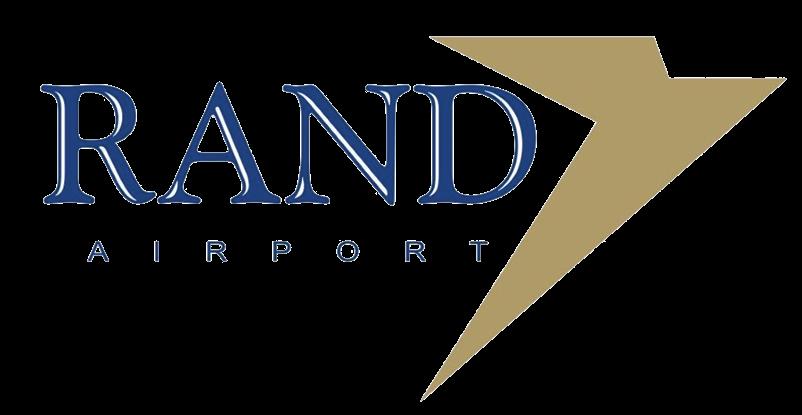
94 May 2023 LOCATIONS CLICK LOCATION TO LINK TO INTERACTIVE MAP AVIATION REBUILDERS DYNAMIC PROPELLERS PILATUS DART PILOTS 'N PLANES RAND AIRPORT INTELEK Training Consultation WAM SAM AVGEEK MATA AEROSPACE ELECTROPLATING HELI AFRIQUE Safomar Aviation Operations SAO Safomar Aviation Maintenance Wingman Aviation Maintenance Mega TrainingAeroAcademy CFA Central AcademyFlying
MEET RAND AIRPORT’S NEW MANAGER
KEVIN IS A GRADUATE of the University of South Africa and alumni of the Business School of the University of Cape Town. He is a professional with thirty years’ experience.

He is competent in Six Sigma Leadership from the renowned school of CSI International in the USA. Kevin has graduated as a Black Belt and Master Black Belt in Lean Six Sigma. He is a registered Safety Professional with SAIOSH and an experienced auditor for quality management systems.
In terms of aviation skills, Kevin holds fitness status in aviation safety management and quality assurance with 20 years’ experience in aviation security.
For his role at the airport, Kevin is instrumental in the key strategic delivery of:
• Management programmes which provide a framework for continued improvement and to enhance the professionalism of safety, health, risk, and airport operations,
• The efficiency of operational and capital finance that ultimately results in the mitigation of business constraints of airport operations,
• Emergency and disaster management processes for dealing with adverse conditions,
• Sophisticated business improvement models with a proven track record explicitly supporting business needs,
• Information and advice to boards, audit risk committees, and
• Leading people to success with their career development.
95 May 2023
Kevin van Zyl is the Managing Director of Rand Airports Management Company (PTY) LTD and appointed Airport Manager.
Introduction
j
Kevin van Zyl is the new Managing Director of Rand Airport
AVIATION REBUILDERS

AVIATION REBUILDERS is a sheet metal and cable assembly facility based in The Showroom, Rand Airport, Germiston. We are a Category B SACAA approved sheet metal and flight control cable assembly facility ready and waiting to serve the needs of the GA industry.
We offer a well-equipped sheet metal facility, the expertise and equipment to repair our beloved GA aircraft to the highest of standards. We offer competitive quotations on your sheet metal repair requirements. We are generally able to offer a one-day turn-around time on standard flight control cable assemblies. We welcome you to visit our facility, we have an absolutely open-door policy and family orientated approach to our staff and customers alike. We look

forward to welcoming you and your beloved aircraft to our family.
This month we bid a fond farewell to Mark Cumming, who has been a part of our team since 1998. We wish him well on his journey as he relocates to foreign shores. With Mark’s departure, we are open to applicants carrying a valid structural B and welding licence to join our team.
Contact Aviation Rebuilders on:


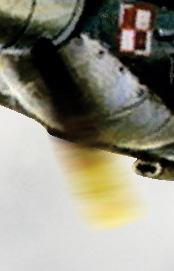






Tel: +27 (0)11 827-2491
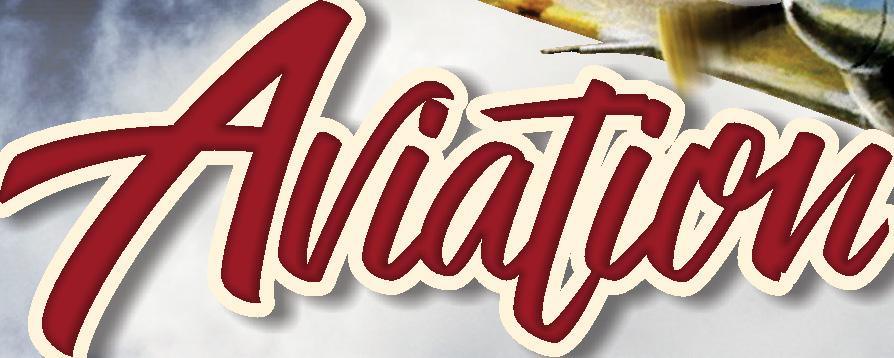
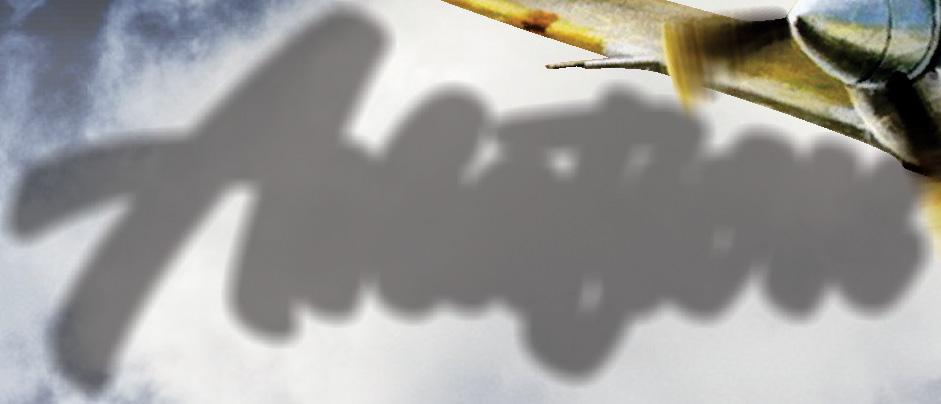
Cell: +27 (0)82 872-4117
Email: lyn@aviationrebuilders.com
96 May 2023
FAX ASSEMBLY OF FLIGHT CONTROL CABLES • SHEET METAL REPAIRS • APPROVED AIRCRAFT WELDING VISIT THE SHOWROOM @ RAND AIRPORT, GERMISTON 011 827 2491 SA CAA AMO 188 082 872 4117 THANK YOU TO OUR CUSTOMERS FOR YOUR CONTINUED SUPPORT IN AVIATION CELEBRATING www.aviationrebuilders.com lyn@aviationrebuilders.com
j
AEROSPACE ELECTROPLATING
AEROSPACE ELECTROPLATING has been based at Rand Airport, Germiston since its launch in 1980 and for the past 43 years has served the aircraft industry with distinction in the supply of high quality surface finished products.
From 2012 the company is now a subsidiary of Mistral Aviation Services and run by Oliver Trollope with a highly experienced and qualified team of electroplaters.

Aerospace Electroplating is fully approved as SACAA AMO 506. Its processes are approved by Denel, Airbus Europe, Rolls Royce, Pratt & Whitney and Allison Doil. The company offers a wide range of services for aircraft owners and
general industry, and through their partnership with Mistral Aircraft Services they can also offer engineering and non-destructive testing services.
Aerospace Electroplating’s highly qualified team are available to advise prospective clients on the perfect solution to all electroplating solutions to perfectly re-finish aircraft components to the manufacturer’s specifications.
Aerospace Electroplating can be contacted on Tel: 011 827 7535 or email: petasus@mweb.co.za j
ELECTROPLATING
506 For
all
your
SACAA
approved
plating
requirements
Cadmium Plate in Gold, Silver or Clear Passivation
Hard Chrome
AMO
506
Hard Silver Plate
Electroless Nickel
For all your SACAA approved plating requirements
Hard Copper Plate Anodising in Grey, Red or Black Black Phosphating
We
are
situated
at
30B,
Building
98,
Rand
Airport.
Next
to
Fields
Airmotive. Call
Des
on
011 827
7535
or
063 or
Peter
on
081 775
2434
or
083
For
all
your
Aircraft
and
Allied
Electroplating
and
queries.
Alodine
Cadmium Plate in Gold or Silver Passivation
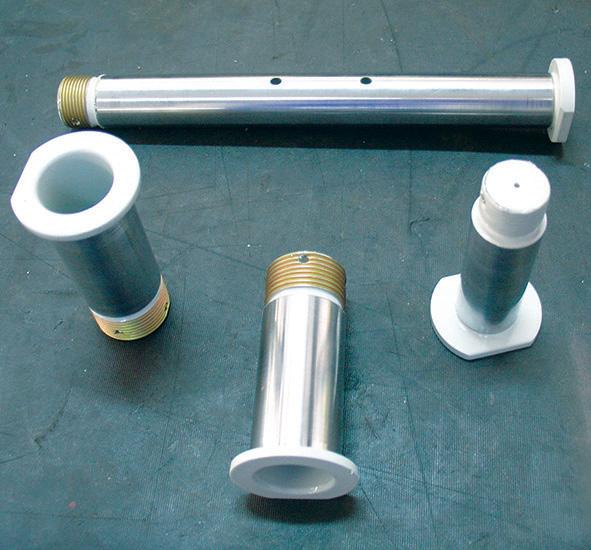
Call
Des
on
011 827
7535
or
063 or
Peter
on
081 775
2434
or
083
For
all
your
Aircraft
and
Allied
Electroplating
Hard Chrome
Hard Silver Plate
Electroless Nickel
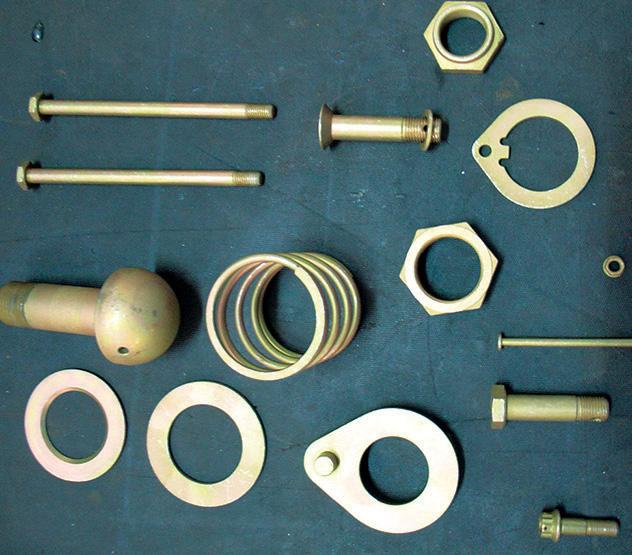
Hard Copper Plate
Anodising in Grey, Black Phosphating
We are situated at 30B, Building 98, Rand Airport. Next to Fields Airmotive. Call Oliver on 011 827 7535 or Peter on 081 755 2534 or 083 208 7249
Anodising in Grey, Red or Black
Black Phosphating
Phosphating
For
all
your
SACAA
approved
plating
requirements
We
are
situated
For all your Aircraft and Allied Electroplating requirements. SA Flyer
Phosphating
97 May 2023
AEROSPACE
ELECTROPLATING
AMO
506
plating
For
all
your
SACAA
approved
We
are
situated
at
30B,
Building
AEROSPACE
ELECTROPLATING
30B,
Building
98,
Rand
Airport.
Next
to
Fields
Airmotive. Call
Des
on
011 827
7535
or
063 150
1533 or
Peter
on
081 775
2434
or
083 208
7244
Clear Passivation
at
Cadmium Plate in
Hard Chrome Hard Silver Plate Electroless Nickel
Hard Copper Plate
AEROSPACE
AMO
2023|05
CENTRAL FLYING ACADEMY

“Where your Dreams take Flight”
Central Flying Academy has been training future young pilots for the past 16 years and was responsible for the ab initio training for the South African Air Force for three years, so they are extremely well equipped and experienced in fixed-wing training.
Training is available seven days a week, starting with Private Pilot Licence (PPL) through to Airline Transport Pilot Licence (ATP).
CFA has developed its own commercial pilot training notes that have an excellent reputation in the aviation industry.
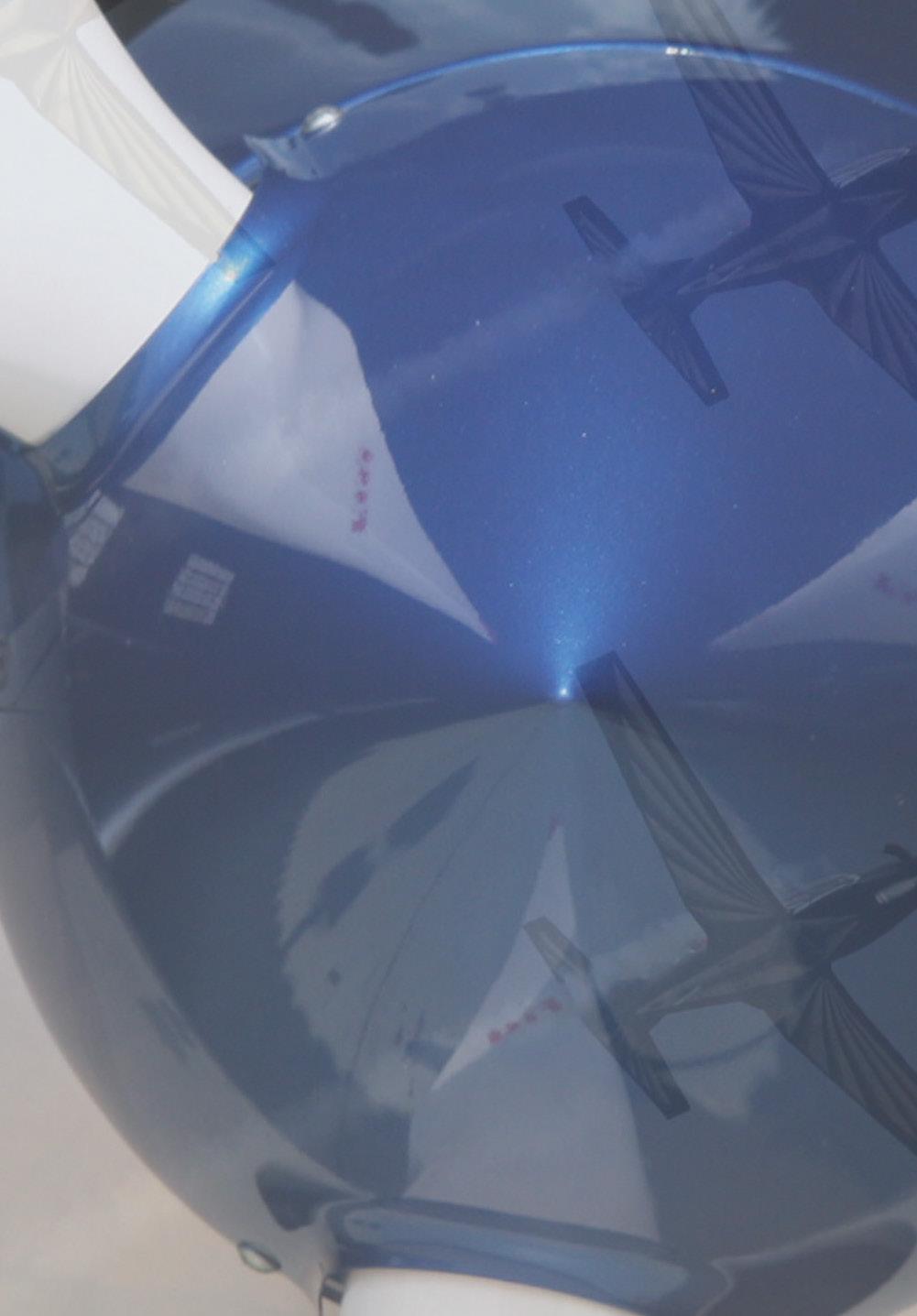
An SACAA approved Flight Training Simulator (FNPT II) is available for initial and recurrent instrument training and instructor renewals. CFA also has state of the art ground school facilities and an SACAA approved online exam test centre.

CFA has a fleet of nine training aircraft which include seven Cessna 172s, one Cessna 172 RG and a Piper Twin Comanche. This ensures excellent availability and backup at all times.
Accommodation is available at our own residence, a short walk from Rand Airport.
CFA is committed to offering you a professional, personal and rewarding experience. Safety and airmanship are the corner stones on which CFA bases its culture and ethos.
Contact CFA on:
Tel: 011 824 4421 / 078 800 9929
Email: info@cfasa.co.za
website: www.cfasa.co.za j
Tel: 011 824 4421
Cell: 078 800 9929, email: info@cfasa.co.za
98 May 2023
SACAA/0105
Where your dreams take flight Central Flying Academy
The
only flight training academy at Rand Airport that offers ALL the required facilities for COMPLETE pilot training at our on-site campus “Look at the rest, then come
fly with the BEST!”
Hangar 28 Hurricane Rd Rand Airport
Germiston www.cfasa.co.za
DART AIRCRAFT ELECTRICAL

BUILDING ON THE SUCCESS of Dart Aeronautical and M&D Aircraft Electrical, Dart Aircraft Electrical has now established itself as a leading aircraft electrical shop in the Gauteng Area situated at Rand Airport.

Dart Aircraft Electrical (DAE) took over from M&D and has acquired all M&Ds test and bench equipment, thereby maintaining M&Ds capabilities.
DAE has also retained the services of M&Ds Matthew Joubert, and is therefore well equipped to cater to all aircraft electrical requirements. Matthew has over 17 years’ experience and brings a high degree of professionalism to the aircraft electrics trade. He specialises in fuel pumps, magnetos, alternators and starters.
Sharing the premises with Dart Aeronautical, DAE is located on the ground floor of Aeronautical House at Rand Airport.
DAE will be able to sell, overhaul, service and repair the following:
• Starters
• Alternators
• Fuel Pumps
• Magnetos
• Strobe Boxes
• Aircraft electrical wiring installation and repairs
• Electronic components
Contact DAE on:
Tel: +27 827 0371
Cell: +27 82 414 1641
Email: dartaircraftelectrical@gmail.com j
Building on the success of Dart Aeronautical and M&D Aircraft Electrical, Dart Aircraft Electrical opened its doors in January 2015.
Dart Aircraft Electrical (DAE) took over from M&D and has acquired all M&Ds test and bench equipment, thereby maintaining M&Ds capabilities. DAE has also retained the services of M&Ds Matthew Joubert, and is therefore well-equipped to cater to all aircraft electrical requirements. Matthew has over 17 years’ experience and brings a high degree of professionalism to the aircraft electrics trade. He specialises in fuel pumps, magnetos, alternators and starters.
Sharing the premises with Dart Aeronautical, DAE is located on the ground floor of Aeronautical House at Rand Airport.
DAE is able to sell, overhaul, service and repair the following:
• Starters
• Alternators
• Fuel Pumps
• Magnetos
• Strobe Boxes
• Aircraft electrical wiring installation and repairs
• Electronic components
99 May 2023




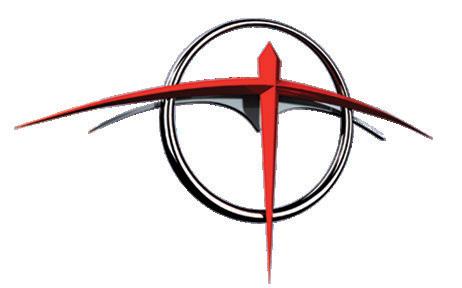




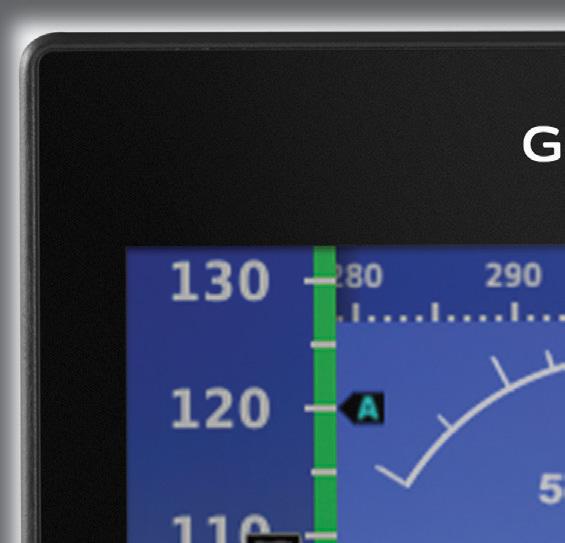
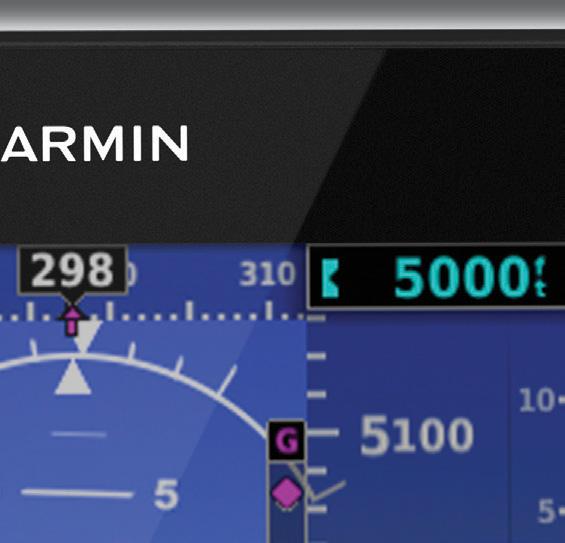
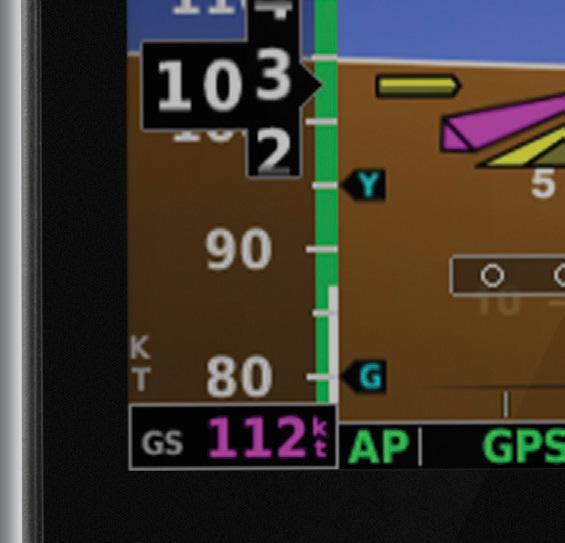





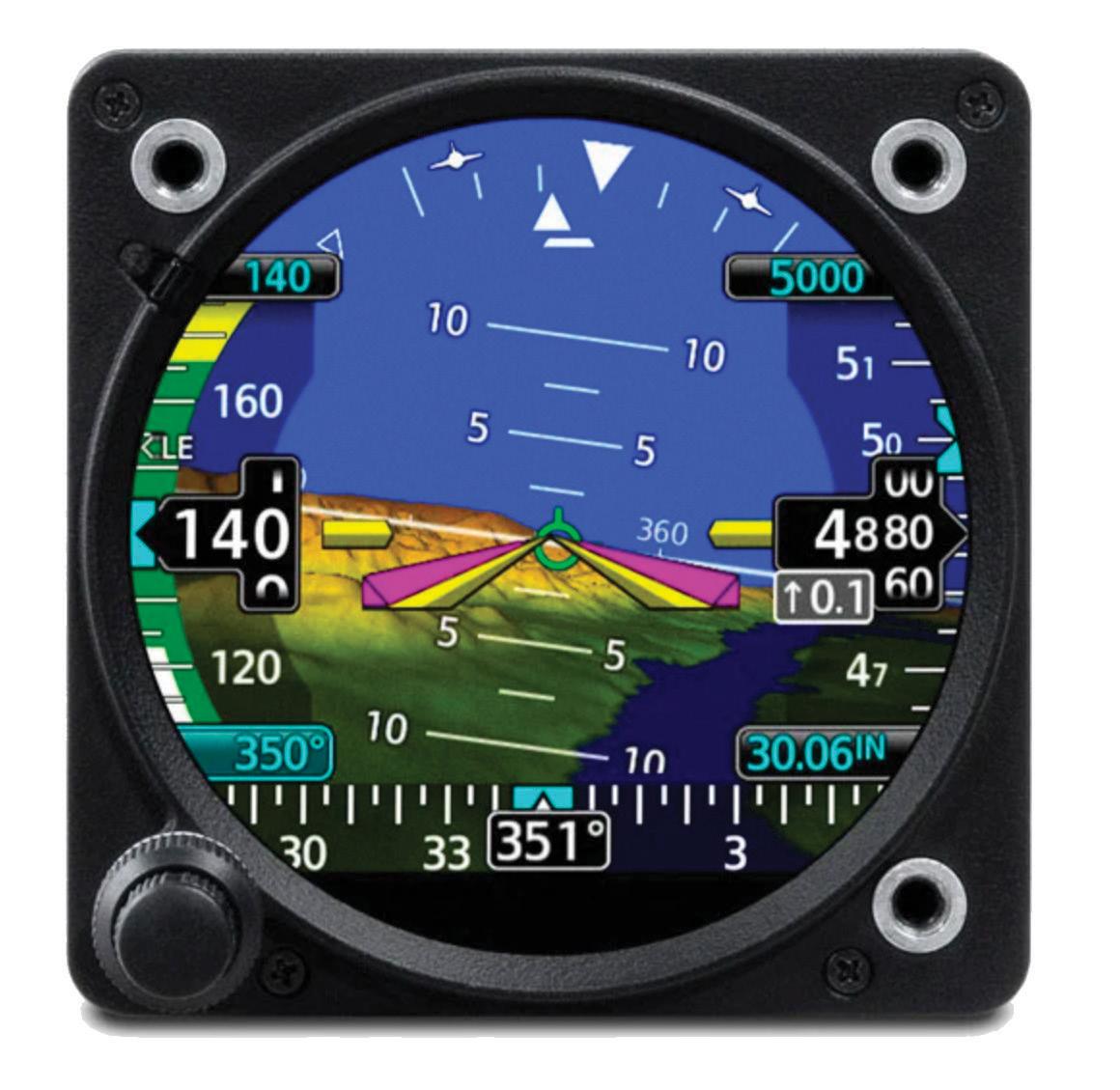
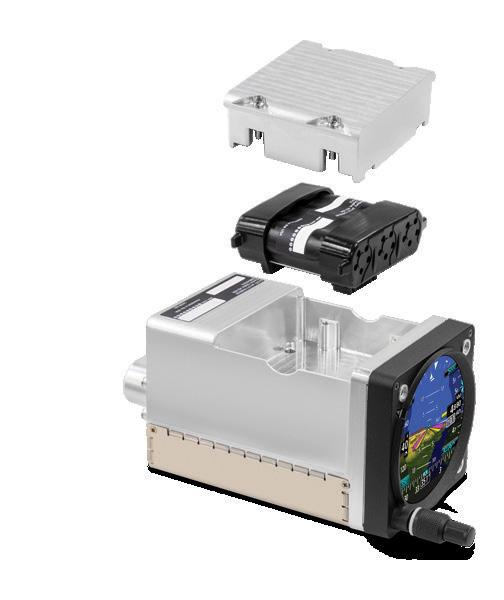
100 DART AERONAUTICAL GFC 600 GFC 500 Pieter Viljoen +27 83 652 4421 pieterviljoen@mweb.co.za Jaco Kelly +27 84 498 4916 pieterviljoen@dartaero.co.za AERONAUTICAL GFC 500 New Garmin Autopilot Options Pieter Viljoen +27 83 652 4421 Jaco Kelly +27 84 498 4916 ® ® FINANCE OPTIONS AVAILABLEENQUIRE NOW! GI 275 Attitude Indicator (AI/ADI) New Garmin Autopilot Options
DART AERONAUTICAL
DART AERONAUTICAL WAS established in 2006 and is situated at Rand Airport.
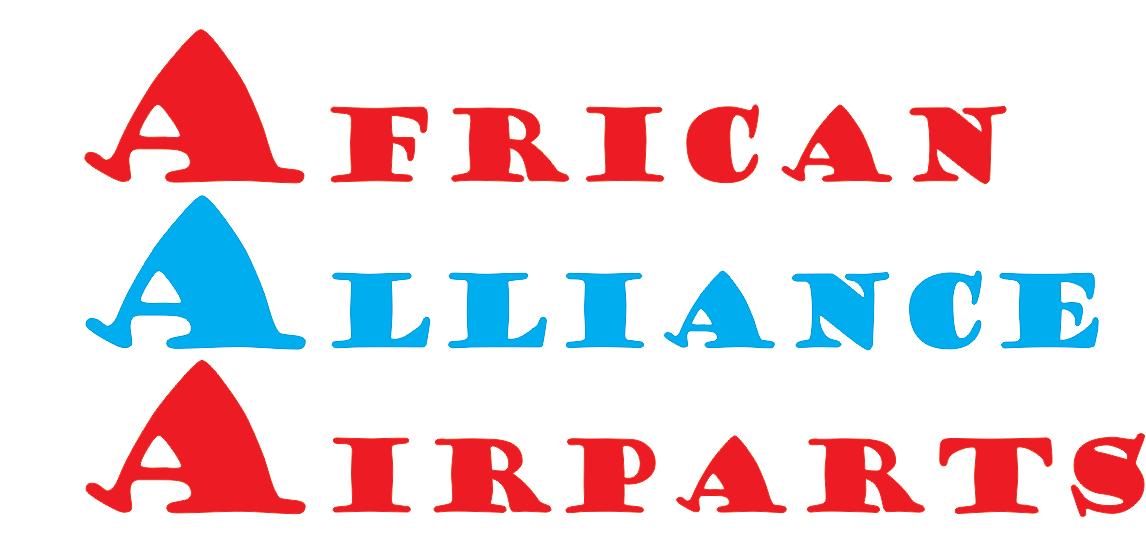
We are committed to providing excellent service with the highest technical standard, not only locally, but to surrounding airfields as well. This division is headed up by Jaco Kelly and Pieter Viljoen. The team of 15 specialises in all aircraft types ranging from homebuilt to DC9 aircraft.
We are market leaders in instrument and instrument panel refurbishments, which include the use of aircraft approved paint, router cutting and laser engraving.
Dart Aeronautical is an agent for all major equipment suppliers such as Garmin, Mid Continent, Bendix-King, Sigma Tek, JP





Instruments, Airtex, S-Tec etc. Our ability to purchase directly ensures our completeness and that our customers receive value for money without any reduction in quality and safety.
We carry a wide variety of serviceable units in store that can be used as loaners while working on a customer’s unit or that can be purchased or exchanged.

Contact Pieter Viljoen on:
Tel: +27 11-827-8204
Cell: +27 83-652-4421
Email: pieterviljoen@dartaero.co.za
Website: www.dartaero.co.za j
101 May 2023 AERONAUTICAL GFC 500 New Garmin Autopilot Options
pieterviljoen@mweb.co.za 4916
® ® FINANCE
ENQUIRE NOW! ® ®
4421
jacokelly@mweb.co.za
OPTIONS AVAILABLE
CONTACT: Chantal Du Plessis +27 61 508 3356
At Dynamic Propellers cc we overhaul and maintain all Hartzell, McCauley, MTPropeller, Hoffmann, Dowty, Sensenich, Whirl Wind and Hamilton standard propellers to include metal and composite blades. We do all maintenance procedures related to aircraft propeller overhauls as called for by the various propeller manufacturers including cadmium plating.
Everything is performed in-house, including cold compression rolling on Hartzell propeller blades, as well as dynamic balancing of propellers in the field. Dynamic Propellers cc is an Authorised Service Centre for MT-Propeller and Whirl Wind.
Dynamic Propellers cc is also appointed as the sole McCauley Authorised Service Centre for the African continent.
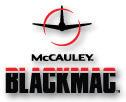
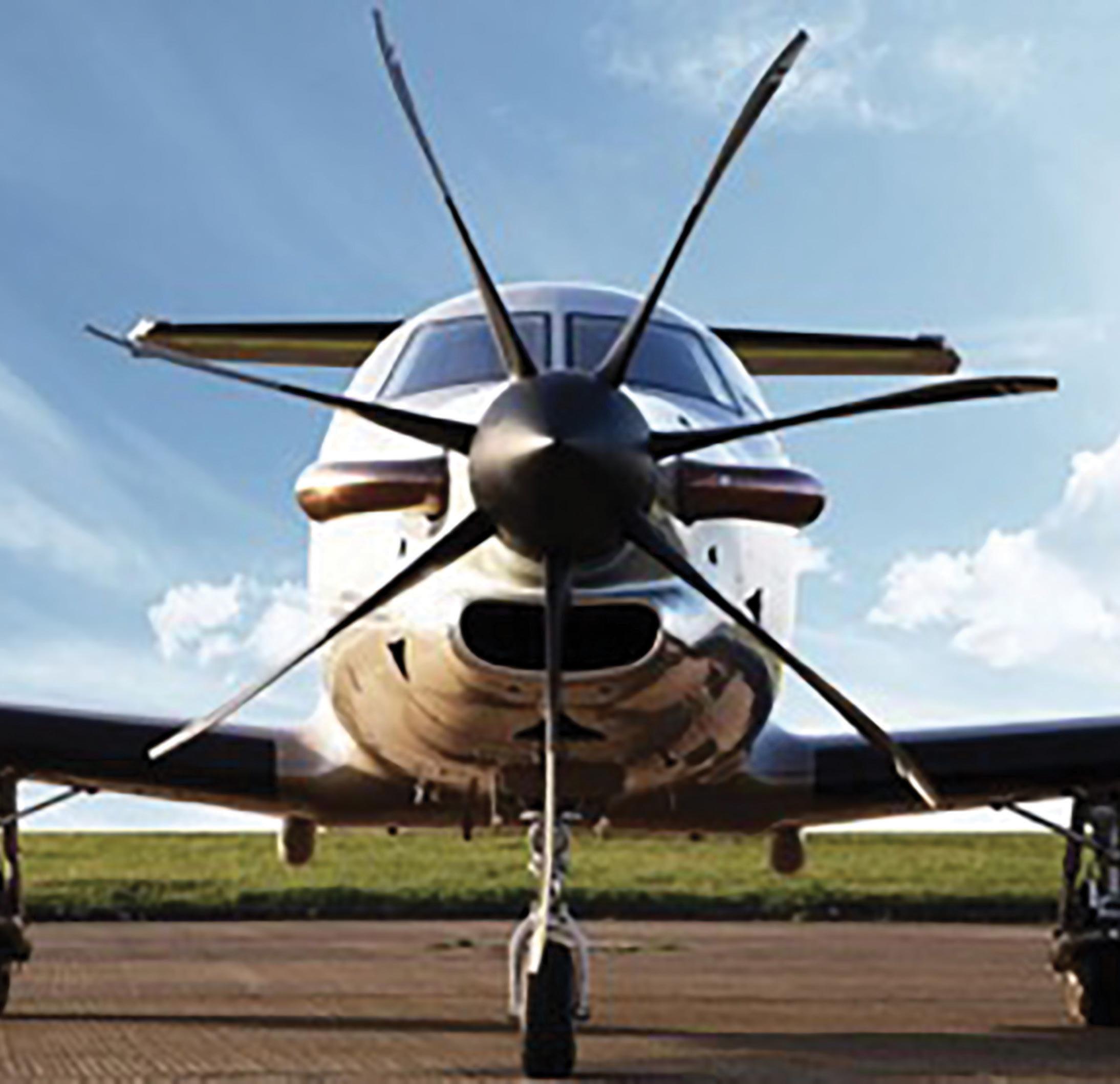
We carry a large stock holding of fast moving propellers, hubs, parts, de-icing parts, overhaul kits etc. in our inventory to cater for Hartzell, McCauley, MT – Propeller, Hoffman, Dowty, Sensenich, Whirl Wind and Hamilton standard propellers. We do a huge amount of travelling to local, domestic and neighbouring countries as well as abroad to cater for customer’s propeller requirements.



www.dynamicpropellers.co.za • Tel: +27 11 824 5057 • Fax2mail: 086 548 2651 E-mail: andries@dynamicpropeller.co.za • Andries: 082 445 4496 0 5 25 75 95 100
INTELEK TRAINING AND CONSULTATION
MARTHINUS POTGIETER started Intelek Training and Consultation in 2007, with almost 20 years of instructor experience from SAA. ITC presented maintenance and type training for individuals, maintenance organisations and major airlines and their customer list is ever growing. Some clients include Global Aerotech, TAAG Airlines, FFA, Air Mauritius, Safair, Air Zimbabwe, only to name a few.
In 2011, ITC Academy was born. Completely independent and without any outside funding. This in itself was a challenge, but no challenge is too big for the passion and drive Mr. Potgieter has for teaching and the aviation industry. ITC started off at a small AMO at Rand Airport, until this once little training school was bursting out its seams. ITC Academy has recently moved to its own building at Rand Airport, Germiston at the beginning of 2017 and now growing even faster. With his son-in-law, Matthys van Tonder, by his side as manager of the Mechanic training school, the company has been bursting out its seems.
ITC is renowned for their eminent Aircraft Mechanic Training for tomorrow’s aviation maintenance elite, providing not only the
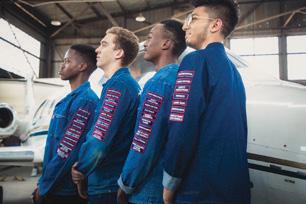
theoretical foundations, but also reputable practical experience to their students.
ITC has recently broken into the EASA market for maintenance training and are approved for EASA basic training as well. ITC Academy is the only privately owned EASA approved mechanic training organization in Africa

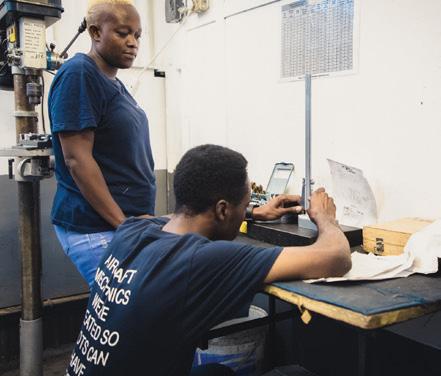


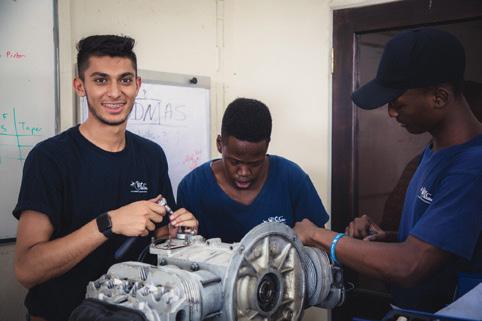

One can’t help but wonder what ITC will do next.
ITC offers:
• Aircraft mechanic training (intakes February and September of each year)
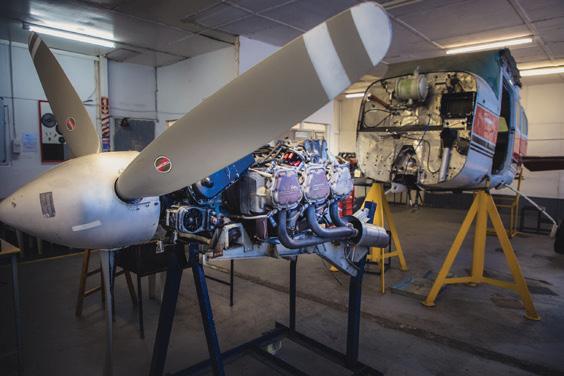
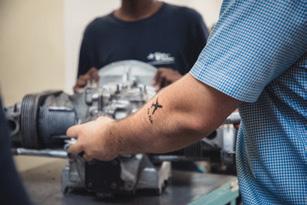
• Aircraft maintenance training
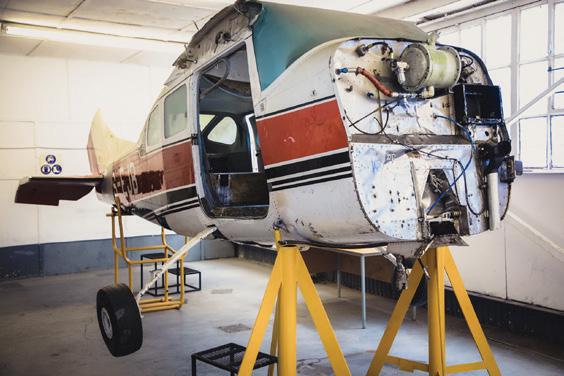
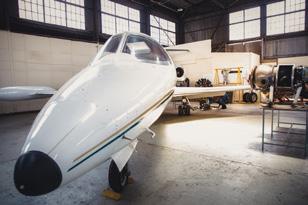
• First aid training
• Fire fighting training
• EASA basic training
• EASA type training through our sister organization AGT france
• Trade test centre j
Maintenance Training
For qualified persons who wish to expand their licenses and capabilities
Basic Training
For persons who aspire to be Aircraft maintenance Engineers
EASA Training
Basic Training A Level B1.1 & B2
103 May 2023
Tel: 010 312 5156 Email: itc.jackie@yahoo.com www.intelektrainingandconsultation.com
ITC Academy offers a full 30 month Aircraft Mechanic training program, consisting of theory and practical training. We also provide Trade Revision and assistance with your Trade Test.
ATTC03I
We specialise in general helicopter maintenance, upgrades, modifications, repairs, interior and exterior refurbishment.


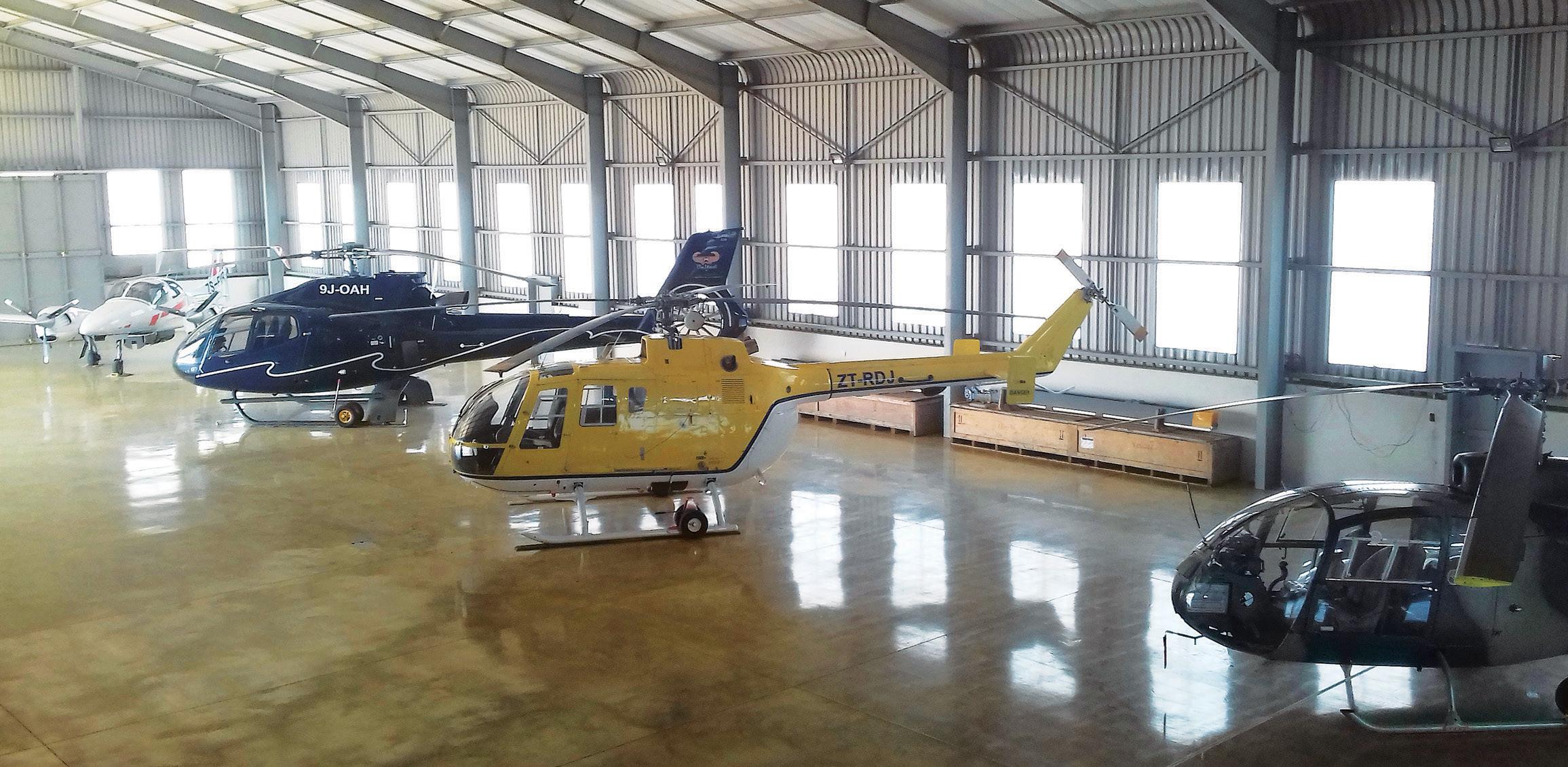
• SA341
• AS350/ 355 series
• EC120/130/135 series
• BO105 series
• BK 117
• McDonald Douglas
• Robinson R22/R44
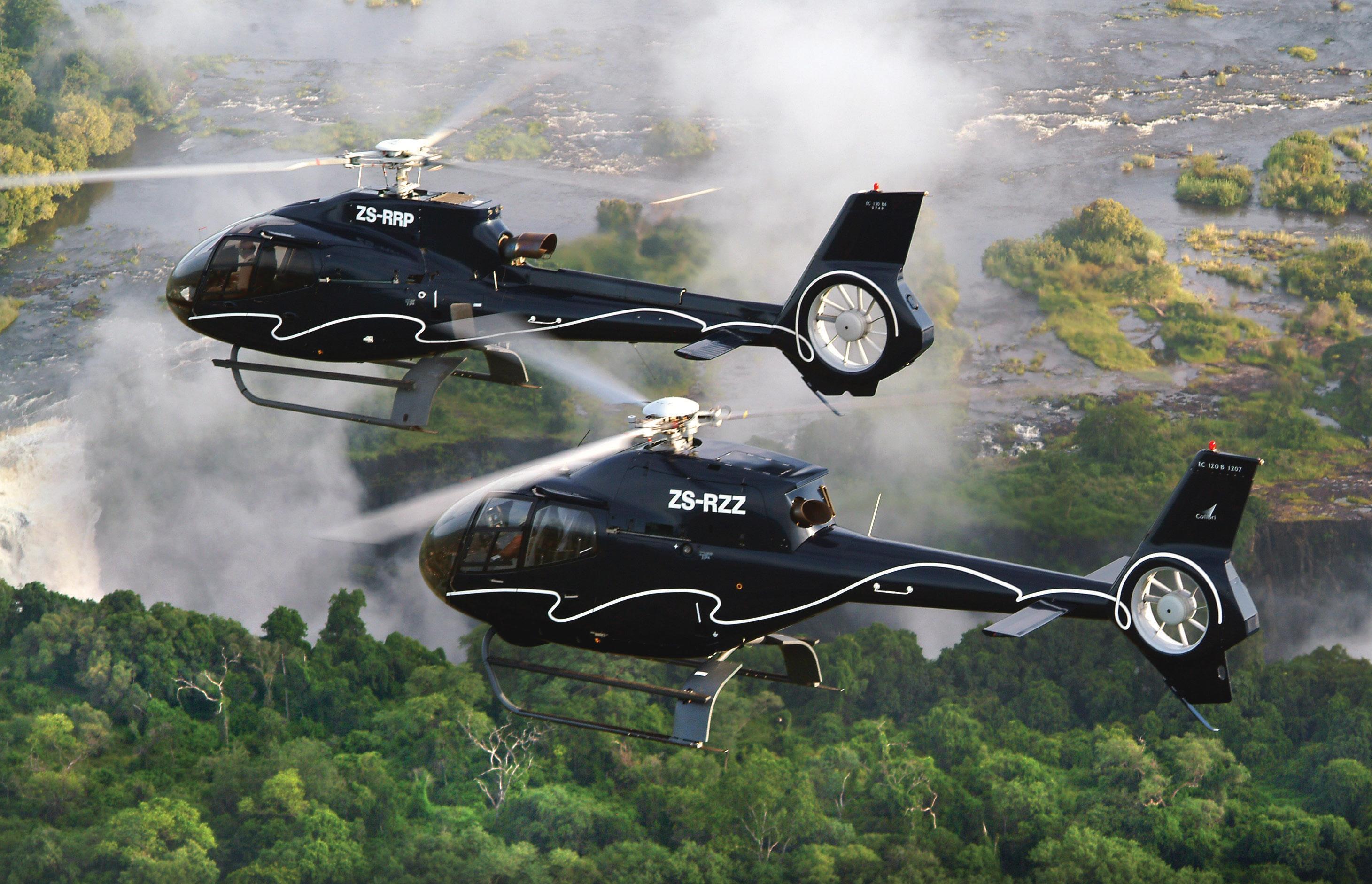
• Hangarage service available
First and second line maintenance on Safran (Turbomecca), Allison and Lycoming engines. CAA approvals : SACAA # 830, Republic of Zambia, Zimbabwe and Lesotho
We now support the BK 117 B2 model “Helicopter for Medi Vac Operations”
104 May 2023
YEARS EXPERIENCE
BUSINESS. SA Flyer 2022|09 Hangar 56, 10 Viking Way, Rand Airport Tel: 011 827 8632 Tino: 083 458 2172 Office: 083 446 0066 Email: technical@heli-afrique.co.za and info@heli-afrique.co.za
HELI AFRIQUE – WE HAVE 40
IN THE
HELI-AFRIQUE
HELI AFRIQUE SPECIALIZES in general helicopter maintenance, upgrades, repairs, interior and exterior refurbishment and modifications, specialising in the Airbus Helicopter SA341, H125 (AS350/355 series), H120 (EC 120), H130 (EC 130), H135 (EC 135 series), BO105 and BK117 helicopters. We provide first and second line maintenance of TURBOMECA, Allison and Lycoming Engines and hold a service centre for Robinson R22 & R44 helicopters.
Heli Afrique assist with inspections, C of Registration, Airworthiness formalities and have assistance from SACAA Inspectors to issue Certificates of Airworthiness and Certificates of Registration from abroad in foreign countries.
Heli-Afrique facilitates the sale of used helicopters, carry out export/import, customs and
shipping formalities. We provide pre-purchase inspections of helicopters worldwide.
Based at Rand Airport Hangar 56, Heli-Afrique holds a large range of spares inventory for the above mentioned helicopters and engines.
Heli-Afrique holds the following CAA approvals: SACAA # 830, Republic of Zambia, Zimbabwe, Angola and Lesotho.
We are the proven alternate ‘AMO’ to Airbus Helicopters and Safran (TURBOMECA) in Southern Africa.
Contact:
Tel: 011 827 8632/33
Email: tino.conceicao@heli-afrique.co.za www.heli-afrique.co.za j
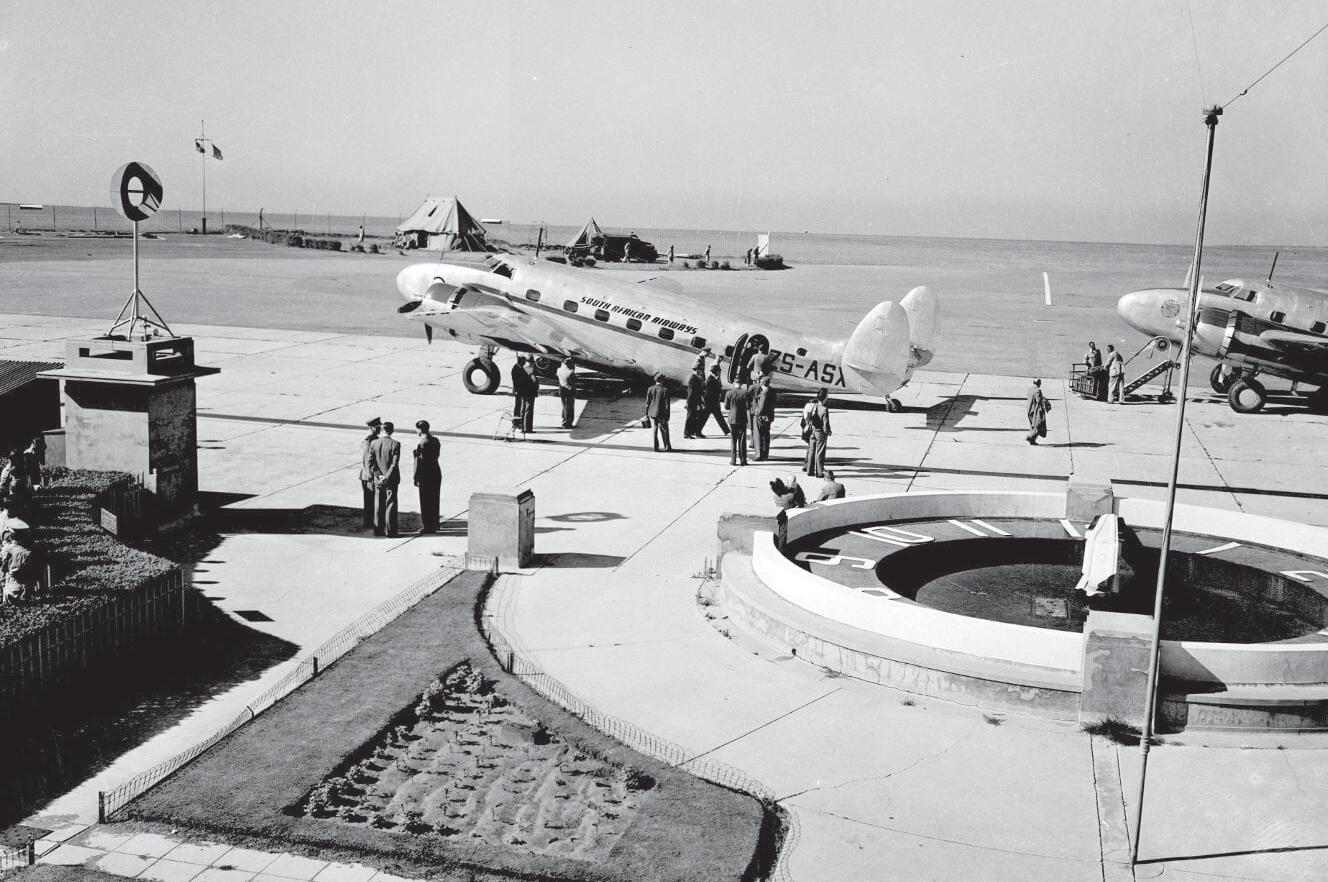
105 May 2023
PILATUS
PILATUS SERVICE CENTRE SOUTHERN AFRICA
As one of a global network of Pilatus authorised independent sales and service centres, Pilatus PC-12 Centre Southern Africa (PCSA) is official distributor for Pilatus aircraft in the region and the only such centre in Africa. Officially opened in 2007, PCSA has celebrated a decade of providing unmatched servicing and sales support to the Pilatus brand from its base at hangars 41 and 42 at Rand Airport. With a team of dedicated, highly qualified and competent staff members whose focus is to provide an all-round holistic sales and maintenance support experience for its customers. Nobody knows Pilatus aircraft like PCSA and at the same time the company strives to know its customers just as well.
Maintenance support
from the Pilatus factory. It is this philosophy, which has seen operators, in an independent survey, conducted by Professional Pilot magazine, vote Pilatus number one in turboprop customer service for the past 19 consecutive years. PCSA continues to uphold its commitment to Pilatus and its customers. The Pilatus PC-12 NGX and PC-24 are supported by the industry leading CrystalCare programme, which provides owners/operators with maintenance piece of mind and predictable operating costs.
Tel: 011 383 0800
E-mail: aircraftsales@pilatuscentre.co.za

Website: www.pilatus-aircraft.com j
DESIGNED FOR THOSE WHO REFUSE TO TRAVEL LIGHT
PCSA supports an ever-growing fleet of more than 85 Pilatus PC-6, PC-12 and PC-24 aircraft in the southern African region. The company strives to maintain Pilatus’ intense focus on post-sale maintenance support, where customers are served locally through strong personal relationships and backed by knowledge and technical support

Big things should be expected from such a big door. The PC-12 NGX is the only single-engine turboprop to provide a pallet-sized cargo door as standard. So, when packing for your next trip in the PC-12 NGX, you won’t have to choose between which pair of shoes to bring. Bring them all. You may even decide to bring your favourite surfboard, motorbike, or mountain bike. Yes, we’ve carried them all, and so can you in the PC-12 NGX.
pilatus-aircraft.com
106 May 2023 p
Contact Pilatus PC-12 Centre Southern Africa, your nearest Authorised Pilatus PC-12 NGX Sales Centre for further information on Tel: +27 11 383 0800, Cell +27 82 511 7312 or Email: aircraftsales@pilatuscentre.co.za
PILOTS AND PLANES
PILOTS ‘N PLANES is an aviation related retail outlet specialising in Pilot and Aircraft Owner requirements.
Pilots ‘n Planes is one of the larger retail outlets of its kind in South Africa and has its main branch at Wonderboom Airport in Pretoria, and a second branch at Rand Airport in Germiston.
Merchandise on offer includes:
• Pilot uniforms and apparel

• Aviation headsets (BOSE, DAVID CLARK, AVCOMM)
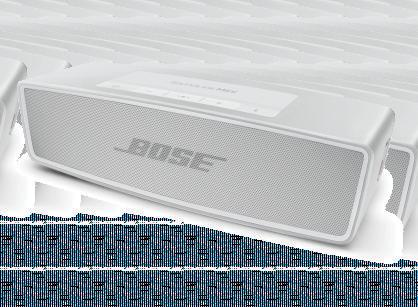

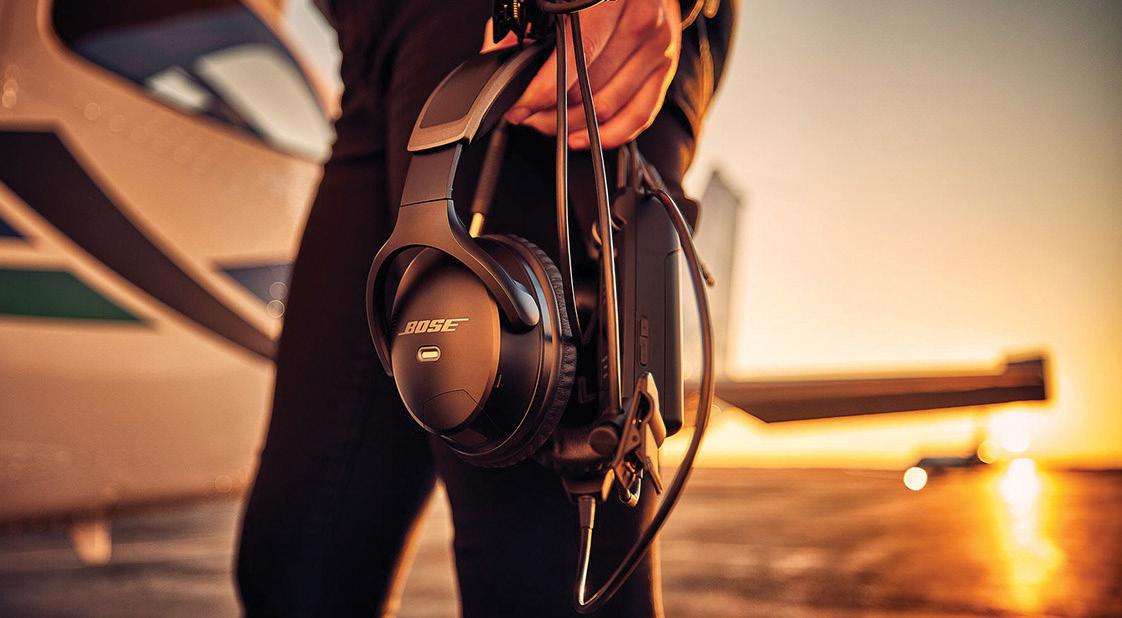
• Sunglasses (RAYBAN, RANDOLPH, BONDIBLU, WAVES, OAKLEY)
• Study material and equipment
• A wide range of Aviation related gifts and collectables
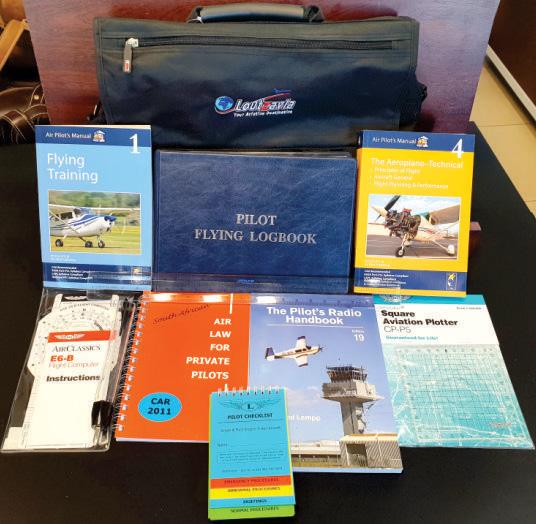
Both our Wonderboom and Rand stores trade Monday-Friday from 8am to 5pm.
On Saturdays, Wonderboom trades from 8am-2pm and Rand is open every first and last Saturday of every month from 8am-2pm.
Contact Melanie at Wonderboom Airport on: Tel: 012 567-6775


Email: pilotshop@pilotsnplanes.co.za Or Lee / Francois at Rand Airport on: Tel: 011 824-3339
Email: rand@pilotsnplanes.co.za j
107 May 2023
PLACE YOUR ORDERS ONLINE NOW AT www.pilotsnplanes.co.za OR EMAIL ORDERS TO orders@pilotsnplanes.co.za SA Flyer 2023 | 04
Contact: +27 12 567 6775, E-Mail: pilotshop@pilotsnplanes.co.za Contact: +27 11 824 3339, E-Mail: rand@pilotsnplanes.co.za Quiet the noice. Amplify the Experience BOSE A30 HEADSET
Pilots Planes nPlanes n
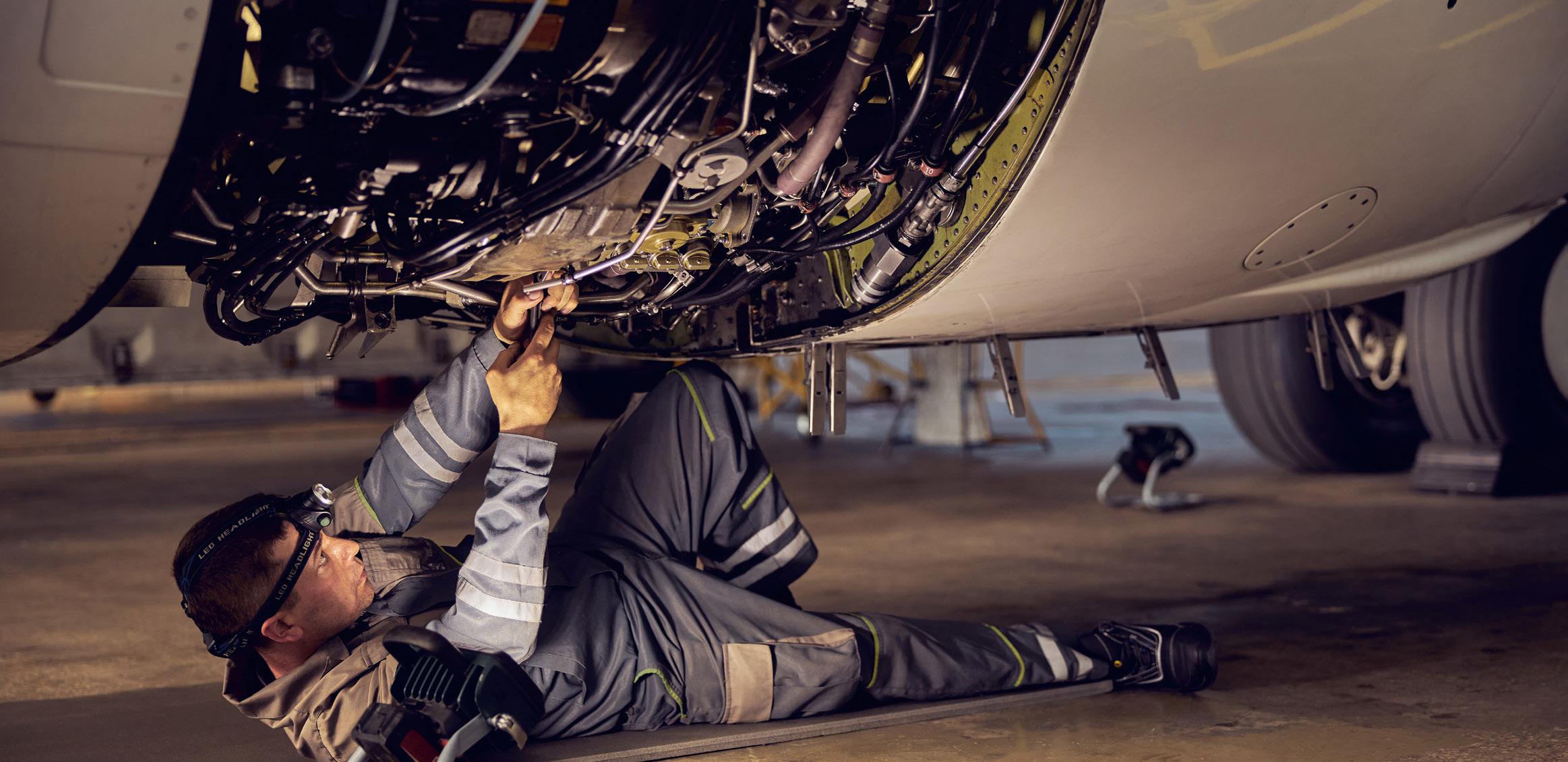




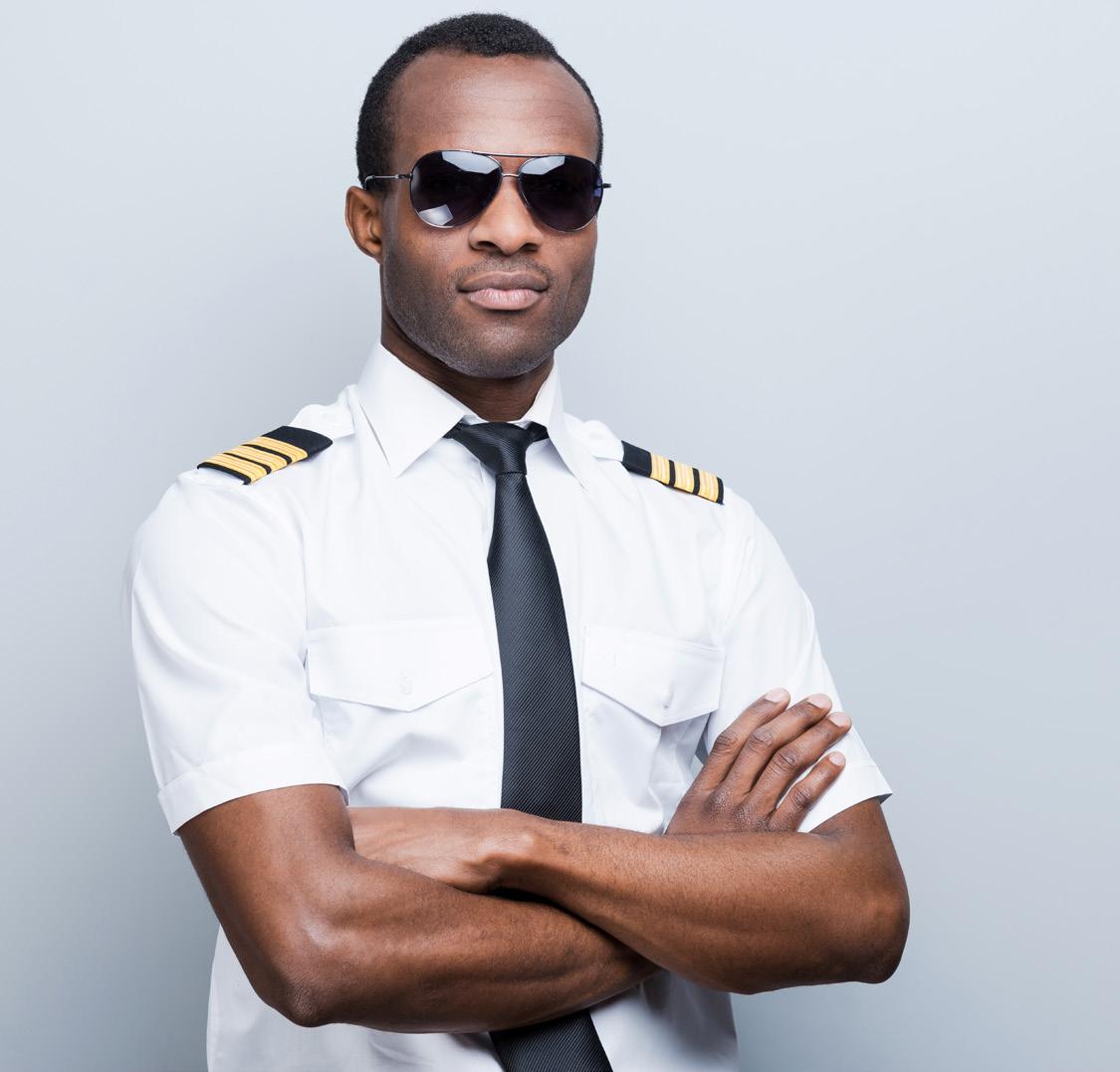

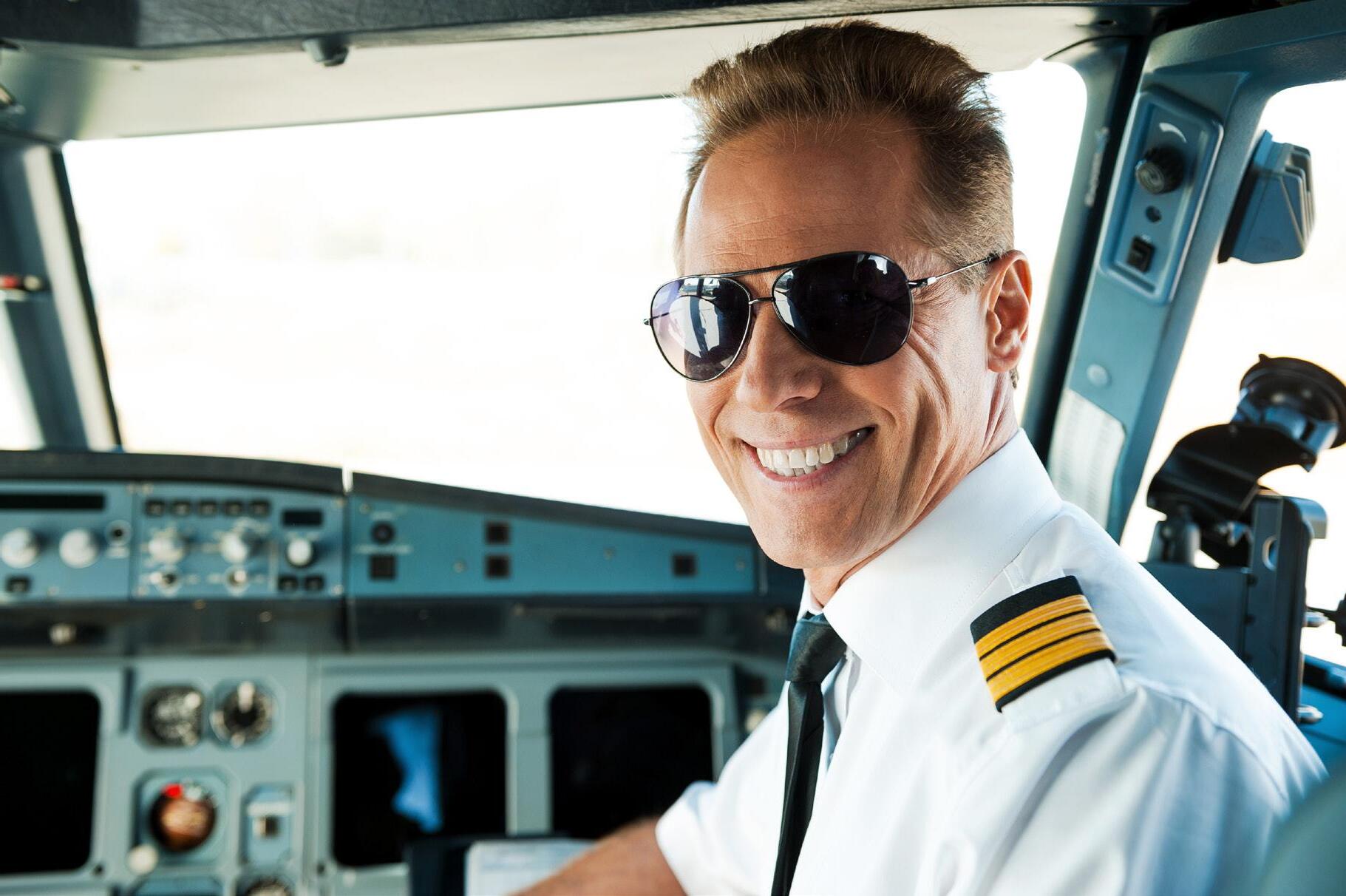
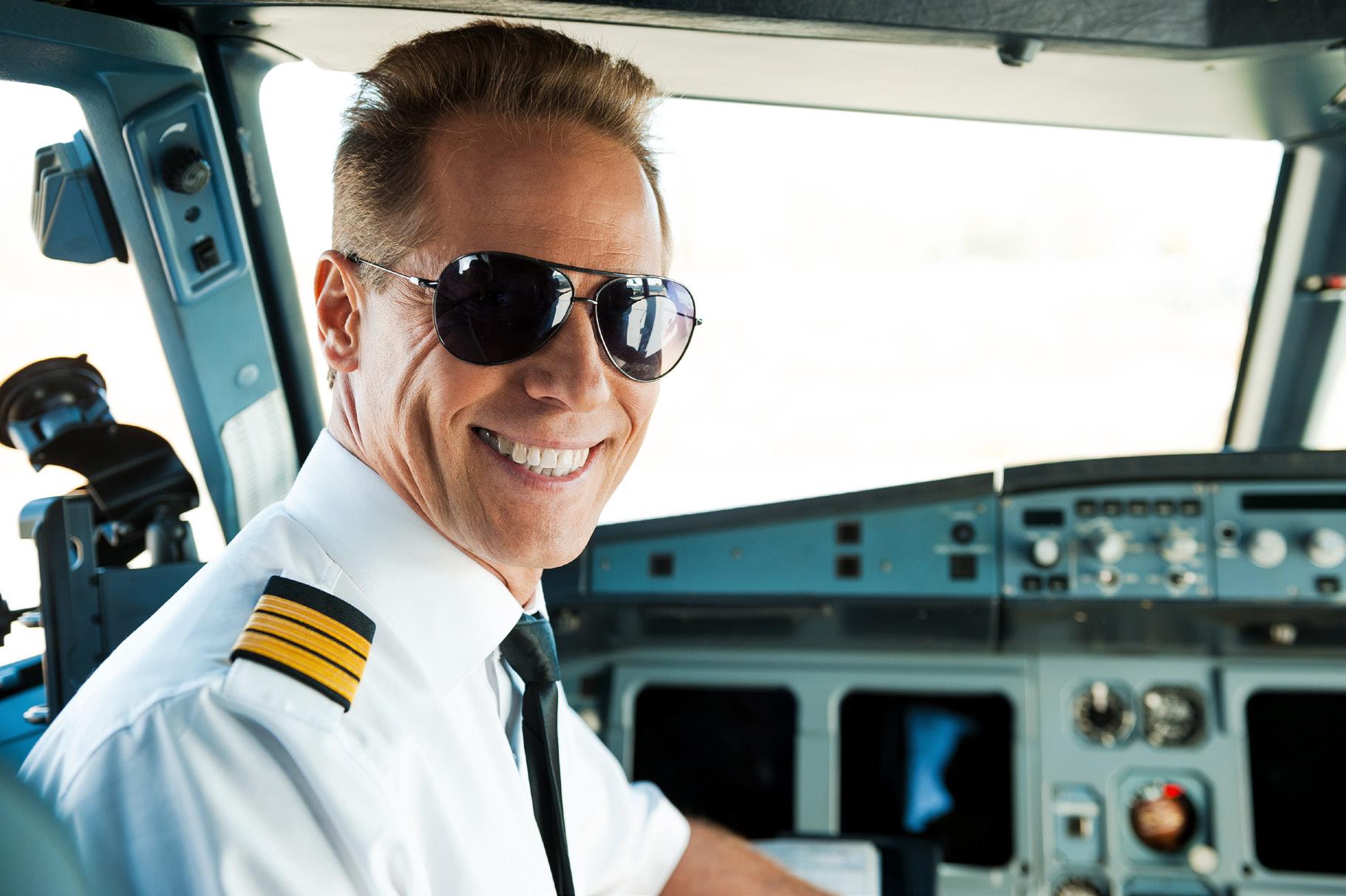
108 May 2023
ENSTROM ANNOUNCES THE SALE OF TWO HELICOPTERS TO THE ZAMBIAN AIR FORCE
MENOMINEE, MI – Enstrom Helicopter
Corporation is pleased to announce the sale of two turbine powered 480B helicopters to the Zambian Air Force (ZAF). The contract, which was signed on February 23 by the Ministry of Defense, includes both the helicopters and training for ZAF pilots and personnel. The helicopters will be based in Lusaka, and used for training and utility missions.
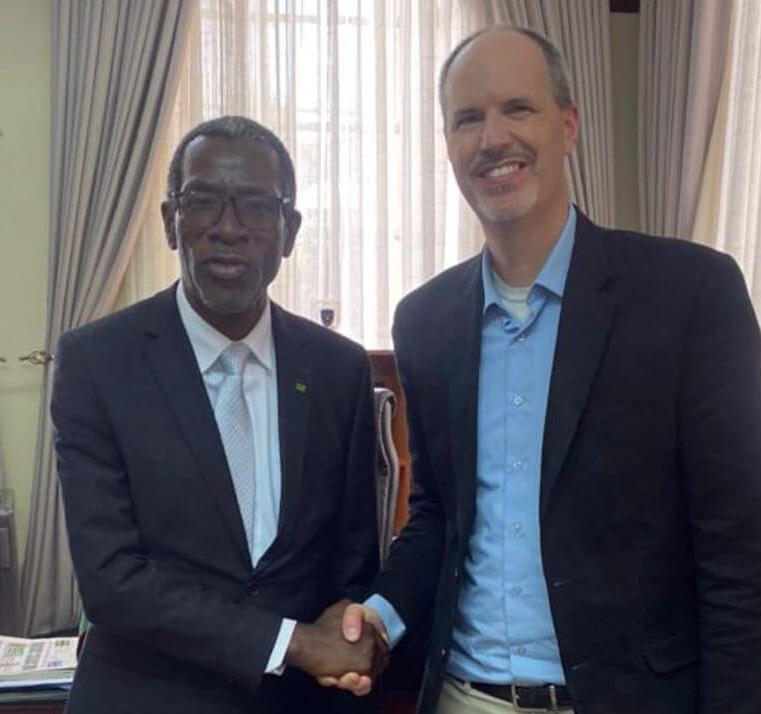
“We are very excited to be supporting the ZAF missions,” said Enstrom’s VP of Sales & Marketing, Dennis Martin. “The 480B will be a lot more efficient than some of the other light helicopters they were using, but with its performance and quick reconfiguration options, the 480B will provide the capability and flexibility they need.”
The helicopters will be equipped with cargo hooks and hard points for cameras, as well as the latest in Garmin avionics and glass panels.
One helicopter will be supplied with a full glass cockpit, the second glass cockpit and analogues combined to allow pilot students to have experience on the various ZAF platforms.
Safomar Aviation Group South Africa coordinated and assisted Enstrom in the sale to the ZAF, including logistics, specifications, and configuration of the Helicopters. Safomar operates a large regional MRO as well as a flight school, and both maintains and operates Enstrom helicopters throughout sub-Saharan Africa.
According to Shai Shalem, Managing Director of Safomar, “We are excited to have Enstrom back and under new management with exciting and excellent helicopter upgrades. It is an honor to have sold two of the first helicopters off the line under the new ownership. These 480B’s are just the right fit for military and Law Enforcement missions.”
About Enstrom Helicopter Corporation
From Rudy Enstrom’s early designs in 1943 to initial testing in a Michigan Quarry in 1957 to aircraft operating on six continents, Enstrom Helicopter Corporation has maintained a reputation for safety, value and performance. Based in Menominee, Michigan and proudly made in the United States, Enstrom has a rich history for design innovation. The goal is to provide helicopters to the customer’s exact specification and deliver support and maintenance worldwide.
109 May 2023
j PRESS RELEASE



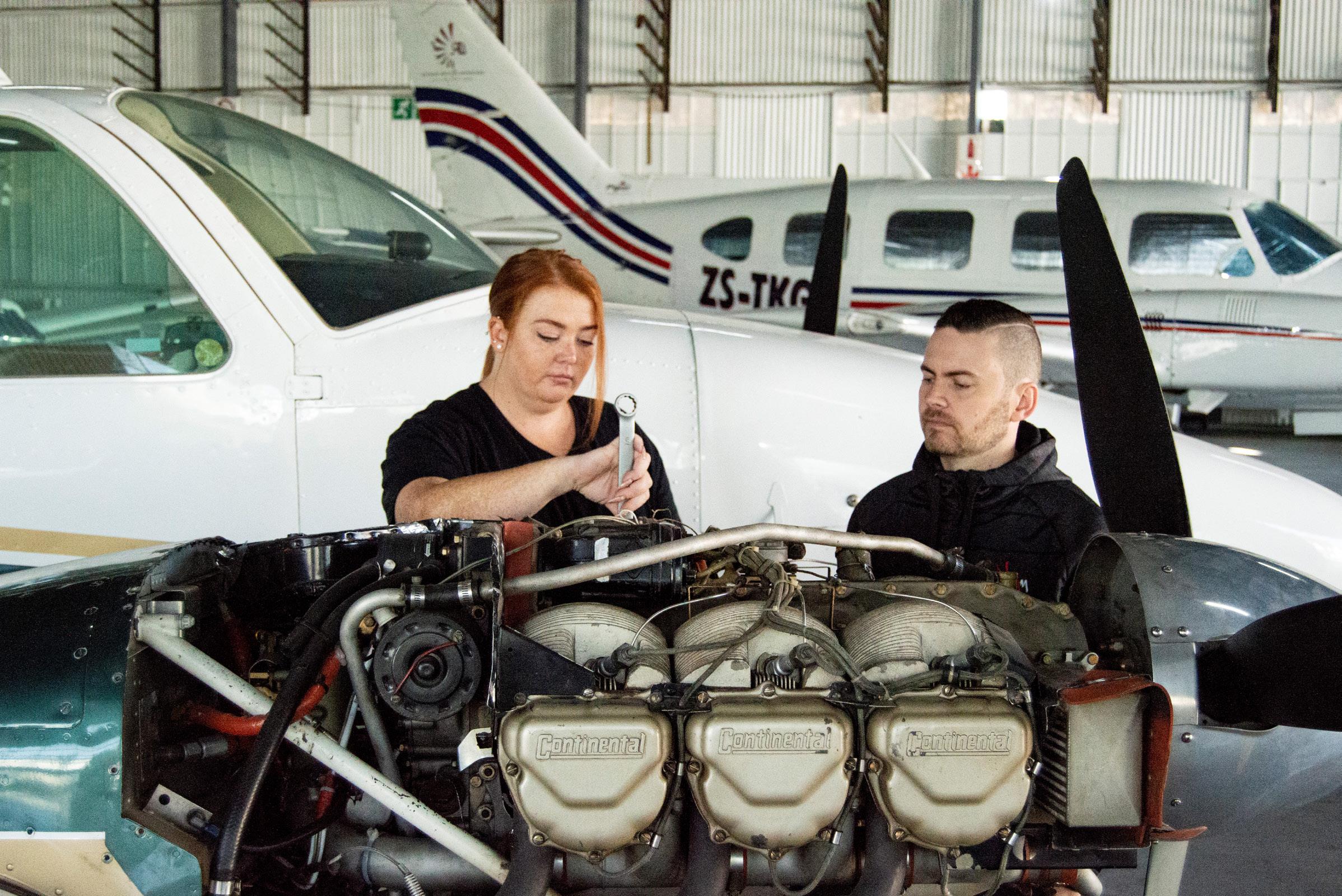







May 2023
Safomar Aviation Maintenance is a SACAA certified Maintenance organisation holding licenses to maintain the Enstrom 280FX and 480B, Robinson R22 and R44 Series, Airbus As350, Bell 206, EC130 and MBB -BK117 Series Helicopters.
FlightCm
Afr ican Commercial Aviation
Edition 172 | May 2023
Cover: Svein-Robert Solberg
Mission Aviation Fellowship: A Pilot’s Long Journey

John Bassi – Listen to your Engine
IRIS – early days
Cape Winelands - Latest
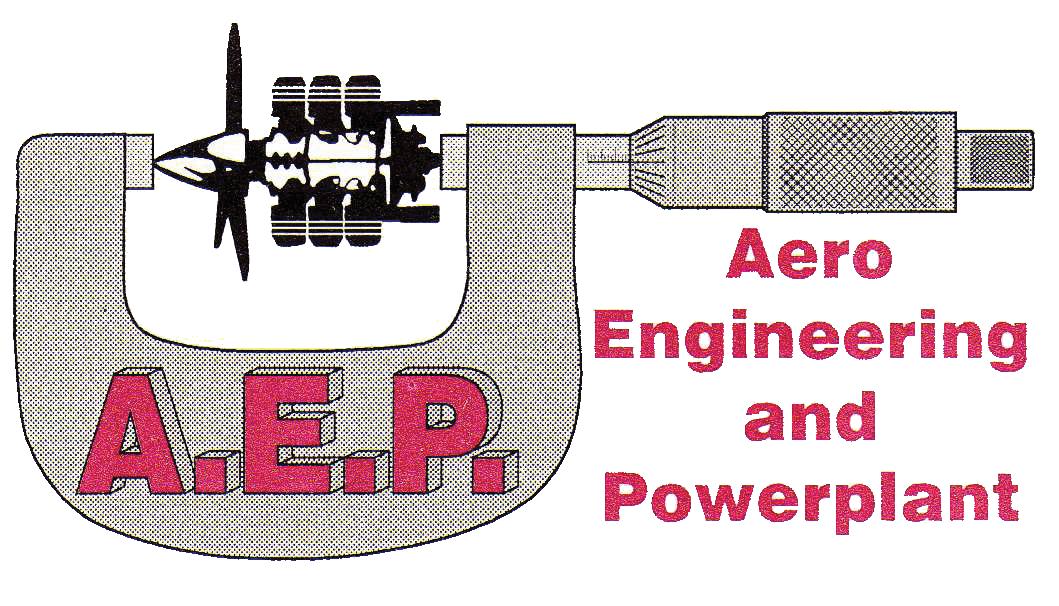



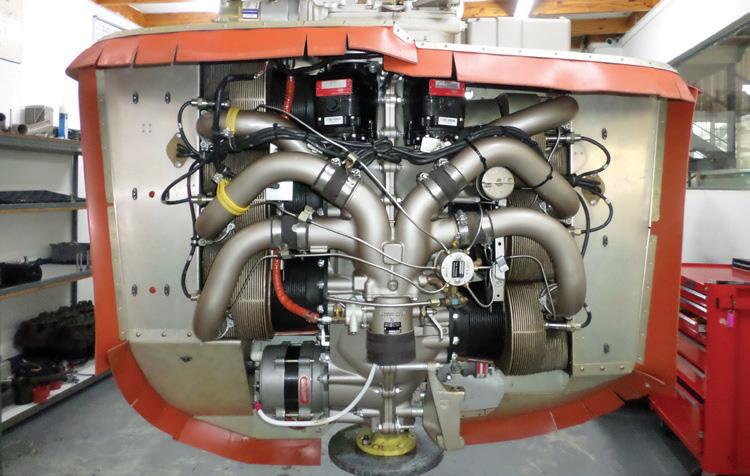

Overhaul / Shockload / Repair of Continental and Lycoming Aircraft engines Overhaul Engine Components Overhaul and supply of Hartzell / McCauley and Fix pitch Propellers FLIGHT SAFETY THROUGH MAINTENANCE Hangar no 4, Wonderboom Airport, Pretoria PO Box 17699, Pretoria North, 0116 Tel: (012) 543 0948/51, Fax: (012) 543 9447, email: aeroeng@iafrica.com SA Flyer 202 3 | 0 5 AMO 227
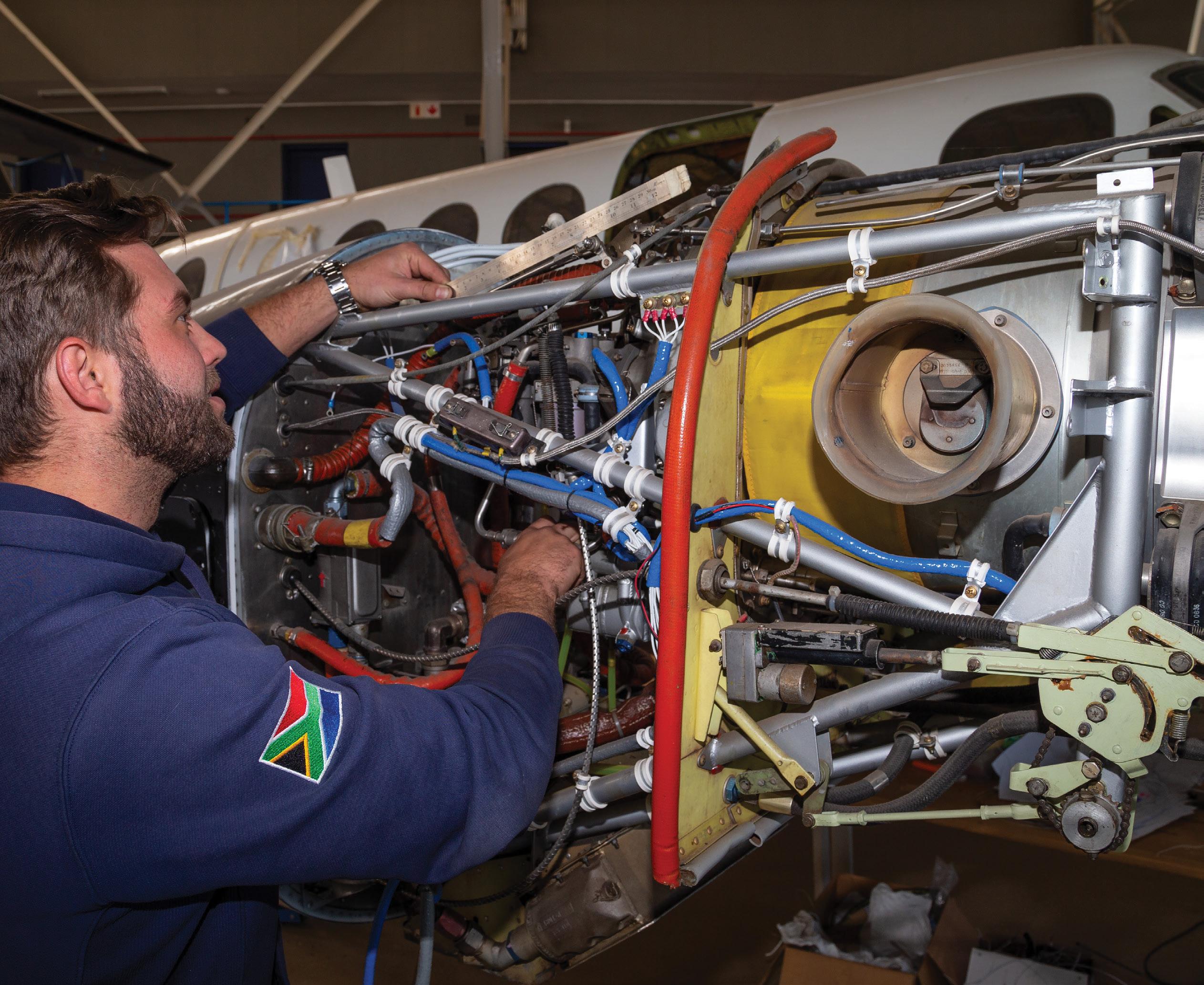
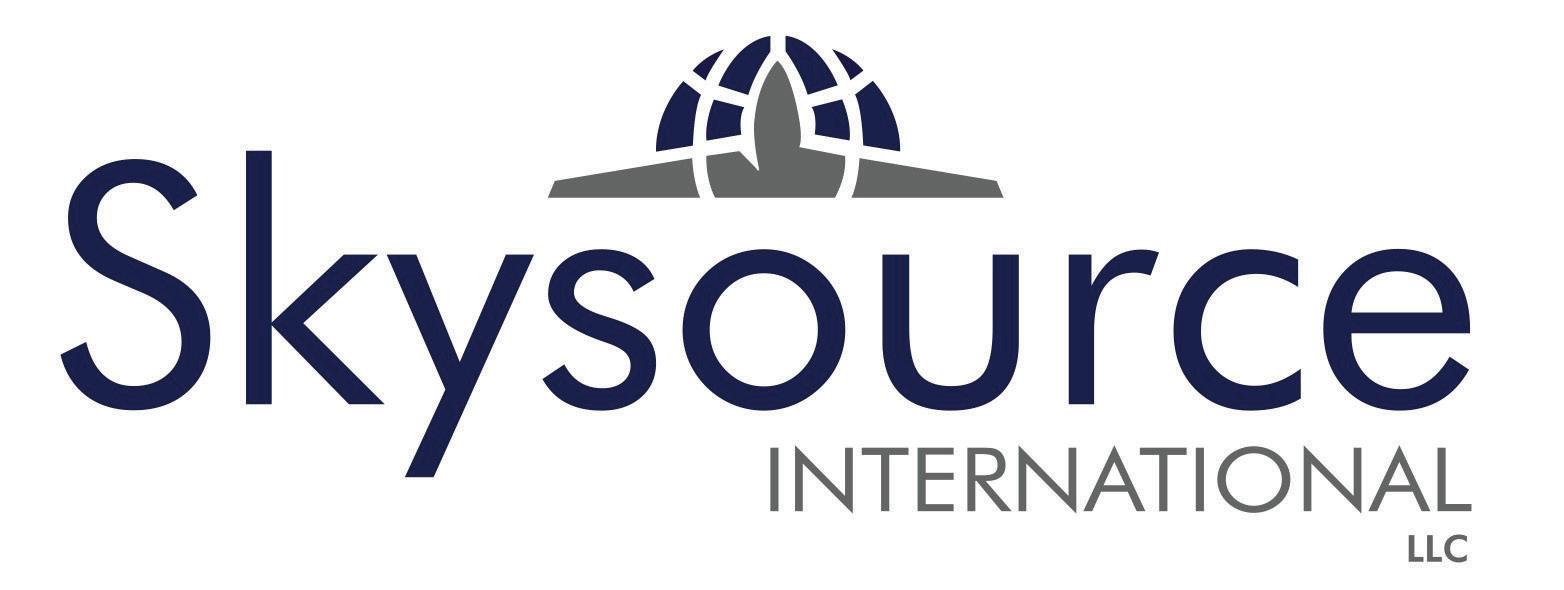

CALL US NOW FOR ALL OF YOUR AVIATION NEEDS! AIRCRAFT MAINTAINENANCE AND REFURBISHMENT QUALITY IS OUR PASSION Skysource International SA, Hangar 203, Lanseria International Airport South Africa SOUTH AFRICA Aircraft Maintenance based at Lanseria International Airport South Africa. FAA USA Worldwide Aviation Resources Aircraft Sales, Purchasing, Maintenance and Consulting. AMO 1427 info@skysourcesa.com +27 10 900 4300 • +27 72 036 3433 WE SPECIALIZE IN: Beechcraft 90 Series Beechcraft 200 Series Beechcraft 350 Series Beechcraft 1900D Series Cessna Caravan C208 Series Aircraft With Full Aircraft Maintenance and Refurbishment, Paint, Upholstery, Defect rectification, Pre-purchase Inspection Capabilities. Decades of experience! Sheet Metal + Avionics Maintenance + Installation SA Flyer 2023|04 www.skysourcesa.com PTY
MAY 2023
EDITION 172
06 09 10 14 19 20 24 32 34 35 36 38
Bush Pilot - Hugh Pryor
AME Directory
Pilots - Laura McDermid
Rules Part 4 - John Bassi
News - South Africa gets 92% ICAO Score
Publisher Flyer and Aviation Publications cc
Managing Editor Guy Leitch guy@flightcommag.com
Advertising Sales Wayne Wilson wayne@saflyermag.co.za
Layout & Design Patrick Tillman: Imagenuity cc
+27 (0)83 607 2335
ADMIN: TRAFFIC:
+27 (0)81 039 0595
ACCOUNTS:
+27 (0)15 793 0708
SANSA: Supporting Moon Shots and Water Resources
The Long Journey of a Mission Pilot
UPDATE: The Cape Winelands Airport
Alpi Aviation SA: Flight School Directory



Merchant West Charter Directory
Skysource AMO Listing
Backpage Directory
TABLE OF CONTENTS
© FlightCom 2021. All rights reserved worldwide. No part of this publication may be reproduced, stored in a retrieval system, or transmitted by any means, electronically, mechanically, photocopied, recorded or otherwise without the express permission of the copyright holders.
A NOTE FROM THE EDITOR:
THE NOTION OF FLAG CARRIERS providing national prestige that attaches to having an airline has lured many otherwise deficient governments into owning and operating an airline and, worse, subsidising it with bailouts that deter natural competition and divert much needed development funding.
Some interesting views about the national interests of states in wanting to own airlines are emerging. Notably the idea that national interests should be subservient to a notion of community interest. Thus, the various trade blocs and development communities which are emerging in Africa should be able to determine Freedom of the Air rights, at a community rather than a national state level. The states themselves are too small and fragmented to efficiently develop their own freedoms of the air with the already extant larger groupings such as the European Union.
I recently examined a Masters dissertation and the student (name available on request) makes some insightful points about Liberalisation: Drawing on Lykotrafiti, he writes, “The provision which seems to obstruct liberalization is Article 6 of the Chicago Convention.
“Article 6 places the principle of national sovereignty in the area of market access. In essence, it provides that all commercial international air passenger transport services are forbidden except to the extent that they are permitted. This axiom should be seen against the historical backdrop prevailing at the time of the conclusion of the Chicago Convention. Since then, the concept of national sovereignty has evolved considerably, so much so that, within certain
“regional or subregional economic groupings”, the ICAO principle of community of interest has taken precedence.
“The relevance of the principle of community of interest for developing and developed States alike implies the need to revisit the concept of national sovereignty. The main obstacle to opening up market access is the nationality restrictions provided for in national laws. Nationality clauses create a right of revocation, which may or may not be exercised. The discretion conferred on the Parties implies a right not to revoke. This has given rise to the idea of waivers of nationality clauses, pioneered by IATA.
The idea of waivers of nationality clauses is part of IATA’s Agenda for Freedom initiative. First launched at IATA’s 2008 AGM, it culminated in a “Statement of Policy Principles regarding the Implementation of Bilateral Air Services Agreements”, adopted in 2009, at Montebello, Canada. The Statement is a non-legally binding instrument, signed so far by twelve countries, including the United States, and endorsed by the European Commission.”
The problem is that the Montebello statement is nonbinding, which makes it not enforceable. The student says, “It seems that for liberalisation of international civil aviation to occur, economics and politics must merge, an outcome a long way down the road, but certainly not out of sight.”
The single greatest obstacle to the development of the African Aviation industry is the resistance of state-owned airlines to “Open Skies’ and the cold winds of liberalisation.
MARINA
NOT ONLY WAS SHE A SLIM, dark-haired beauty, Marina was also tough, intelligent and very amusing. She was, to put it succinctly, ‘One of the lads’...she also just happened to be a real princess. Her father was a nephew of King Hussein of Jordan and her mum was from an old Scottish family. They had met at Saint Andrew’s University in Edinburgh and their daughter seemed to have been blessed with the best of the characteristics of each of her parents.
Marina was the kind of person who illuminated any room she walked in to. This is a story to illustrate, to some extent, what I mean.
people
In her capacity as a ‘Food Monitor’ she was detailed off to do an assessment in a place called Ayod, to find out how much food they would need when we carried out the next air-drops. Ayod is in the middle of ‘The Sudd’, a swamp so large that it provides 2% of the world’s oxygen.
The Nile River only drops fifty feet in the three hundred miles it flows between Juba and Malakal, so in effect it forms a vast flat plain which is subject to flooding from only moderate quantities of rainfall.
The rains in South Sudan are not ‘moderate’ by any stretch of the imagination! They are torrential.
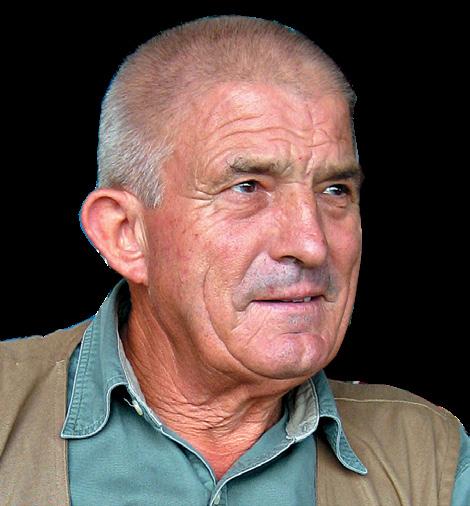
Marina allowed four days for the assessment and prepared her stores accordingly. Having been at the centre of a civil war for over twenty years, the only crop which the population could harvest from the rich soil surrounding Ayod consisted of anti-personnel mines. They were indiscriminately brutal to men, women and children, old and young. Similarly, cows and goats received the attentions of the bomber, to the extent that they became disturbed when they heard the sinister voice of the Antonov. The drop zones where we airdropped the food for the starving locals, were carefully seeded with explosives by aircraft from the North.
Sometimes the drop crews would interrupt a drop after observing explosions on the ground where the food bags had landed on mines. The characteristic hum of the hated Antonov invariably initiated a desperate search for cover. Some were lucky, others were not. So many people were missing feet and legs that the local cobbler only made sandals singly. If you wanted two shoes you had to specify that you wanted a pair.
From all this you will appreciate that Marina’s
6 FlightCom: May 2023
BUSH PILOT HUGH PRYOR
One of the most delightful people with whom I have had the pleasure of working was a ‘Food Monitor’ for the UN Operation; Lifeline Sudan....in the middle of a war zone.
were missing feet and legs
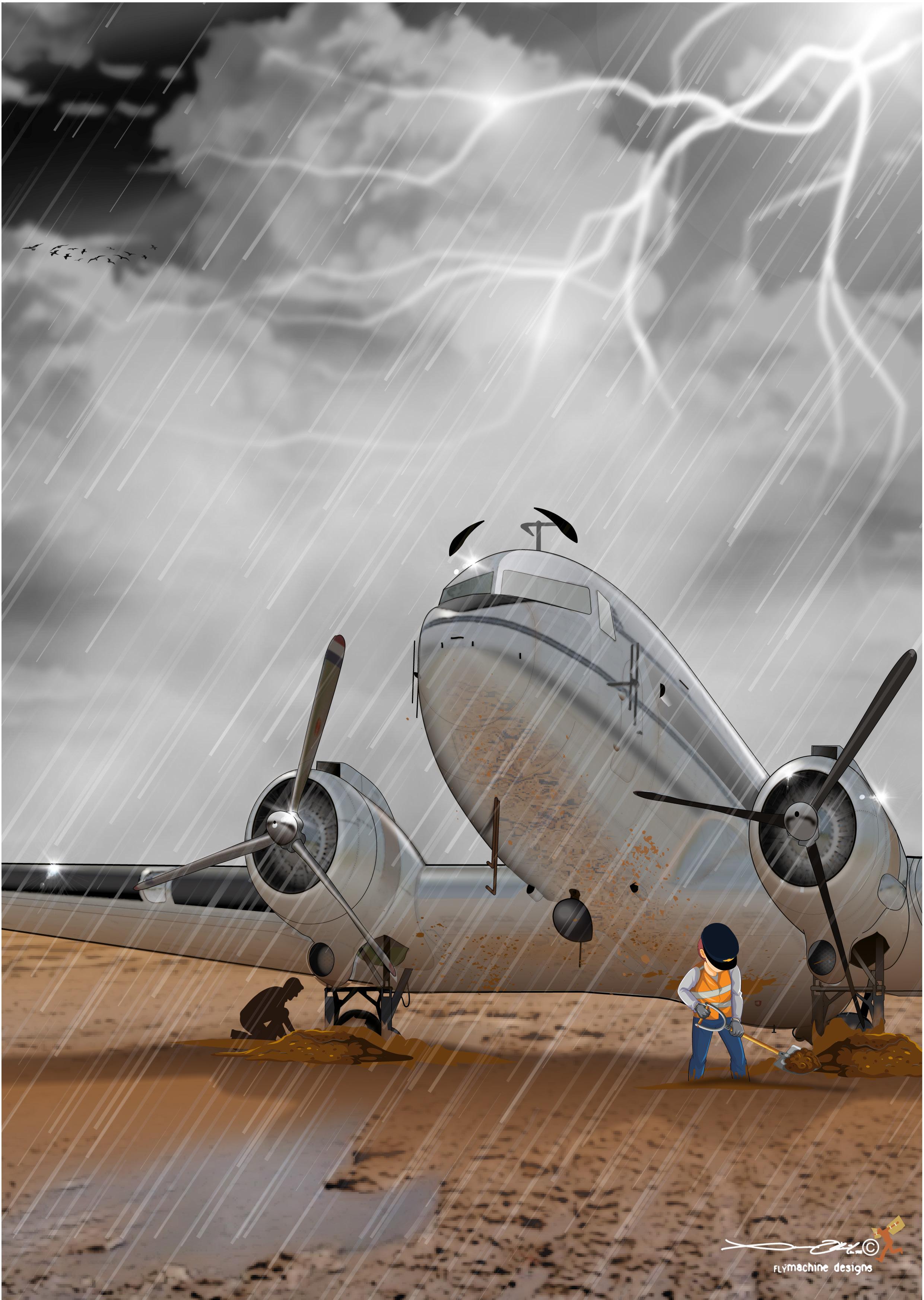
assessment was not a task for the faint-hearted. Luckily, in Marina the UN had an individual who was not only stout-hearted but infinitely resourceful.
After she was dropped off by the four-by-four she quickly erected her tent and got a fire going. In a remarkably short space of time she had established a surprisingly comfortable home from home. The local chief placed an armed guard to look after Marina’s little camp, while she toured the area on foot by day.
It was on day three that Marina met her match. The rains arrived and the surrounding countryside disappeared under water. She had to move her camp to a low rise under a mahogany tree. Any thought of rescue was out of the question. The tracks which the car had followed to get her to Ayod had simply disappeared.
She managed to make ends meet until day eleven then she broke silence and called for emergency supplies to be dropped to her by air.
As we overflew the flooded landing area, the same thoughts applied to Marina. How was she able to survive in conditions like these?
Such thoughts provoked a determination in my mind that we should not just drop supplies to her...we should make a special effort to try and get her out and back to a hot shower, a decent meal and clean sheets.
I knew Ayod well. Unlike large areas of the Sudd, Ayod was not sitting on a morass of Black Cotton soil, the thick, cloying, black goo which could be up to thirty feet deep and swallowed aircraft wheels if there was even a sniff of rain in the area.
God’s Gift to Aviation
The duty flight crew consisted of an English pilot, called Brian, and myself. Brian fancied himself as God’s Gift to Aviation and to members of the opposite gender and made sure that everybody knew about it!
Our aircraft was that iconic twin engined bush plane, the De Havilland DHC-6 300 Twin Otter which was capable of transporting twenty passengers and their baggage in and out of impressively confined spaces.
We loaded the essentials aboard the aircraft and got airborne. It was my turn to fly and Brian rather reluctantly played second fiddle in the right hand seat.
After just over an hour we arrived overhead Ayod and true enough, the whole area was under water, with small islands raising their heads hesitantly through the floods, providing precarious support to local houses above the water. Many of the ubiquitous thatched domes had succumbed to the floods, leaving us to wonder where the inhabitants now rested their heads.
On one occasion a DC-3 from Nairobi flew up to Bentiu, on the border between North and South Sudan, intending to return to Nairobi the same day. Bentiu is true Black Cotton country. They arrived in Bentiu, after refuelling in Juba. The crew ran into the little cafe near the runway for a quick comfort stop and coffee break. They hardly noticed the rain. They were only intending to spend a quarter of an hour on the ground, but by the time they returned to the parking area, the water was up over the axles of the main gear wheels and they weren’t going anywhere in the foreseeable future. They finally got back to Nairobi a month later, by barge, on the Nile, via Juba.
The last time I saw the aircraft it had been dragged into the middle of town, on its guts when they closed the airport to make room for an army camp. The sad carcass sat there for some years until it finally disappeared, presumably to become pots and pans.
Ayod, on the other hand was firm hard sand, even when it was wet. No problem for a Twin Otter. True enough, the arrival would make good cinema for the spectators on the ground and keeping the aircraft straight through the water might present an interesting little challenge to the crew, but the trusty old Twin Otter could be relied upon to take the job in her stride.
8 FlightCom: May 2023
The landing was smooth and directional control was easy to maintain with judicious use of differential reverse thrust from the two engines. Right at the end of the landing roll I eased the old girl onto a raised piece of ground off the side of the strip, closed the engines down and opened the cockpit door.
A waft of warm, damp air invaded the cockpit and the silence was broken by a yelp of delight. I looked in the direction of the cry and observed running figures splashing through the water towards us. The one in the lead was unmistakably Marina. I jumped down onto the ground and walked over to meet her. Her greeting was unexpectedly amusing.
“Did you bring toilet paper?”
I just cracked up. “Of course I did!” I laughed and reached back into the cockpit. We always kept two or three rolls under the pilots’ seats. I handed her a roll and suddenly found myself in a passionate embrace. Marina kissed me and whispered into my ear, “I knew you guys would come!”
Brian was visibly put out that an old grey head like me should receive all the attention. It was one of the high points of my aviation career!
Marina wrapped up her belongings, bade farewell to her new-found friends and jumped aboard for the return to the ‘civilisation’ of our camp in Rumbek. It promised to be a very amusing reunion!
AME Doctors Listing

FlightCom: May 2023 9
Regular Class 2, 3, 4 Senior Class 1, 2, 3, 4 On site Specialist tests Off-site Specialist tests FAA registered EASA registered Other countries SURNAME FIRST NAME LOCATION TEL NO E-MAIL Britz Rudi Wonderboom Airport 083 422 9882 rudiavmed@gmail.com ✗ ✗ ✗ ✗ Church Belinda Valhalla 079 636 9860 churchbs@live.com ✗ ✗ Du Plessis Alexander Athlone Park 031 904 7460 dex.duplessis@intercare.co.za ✗ ✗ ✗ Erasmus Philip Benoni 011 849 6512 pdceras-ass@mweb.co.za ✗ ✗ Govender Deena Umhlanga Rocks 031 566 2066/7 deena@drdg.co.za ✗ ✗ Ingham Kenneth Midrand 011 315 5817 kaingham@hotmail.com ✗ ✗ ✗ ✗ Marais Eugene Mossel Bay 044 693 1470 eugene.marais@medicross.co.za ✗ ✗ Opperman Chris Pretoria Lynnwood 012 368 8800 chris.opperman@intercare.co.za ✗ ✗ ✗ Tenzer Stan Rand Airport & JHB CBD 083 679 0777 stant@global.co.za ✗ ✗ ✗ Toerien Hendrik White River, Nelspruit 013 751 3848 hctoerien@viamediswitch.co.za ✗ ✗ ✗ Van Der Merwe Johann Stellenbosch 021 887 0305 johann.vdmerwe@medicross.co.za ✗ ✗
The sad carcass sat there for some years
PART 1
IRIS EARLY YEARS.
Laura McDermid continues her stories of Iris McCallum’s flying exploits.
IN MAY 1986 I found myself back in Tanzania, where my story begins. How my family came to be in Tanzania begins with my grandparents, all four of whom were born and raised in South Africa.
Having lost everything after the second Anglo-Boer War, my maternal grandfather John Hamman, said goodbye to his young bride Maria Magdalena, and in 1903 headed for German East Africa, with lofty ideas of making a fortune hunting the big five.
At that stage Tanganyika was under German colonial control until the end of World War I, when they were defeated and German colonies were transferred to other powers under the Treaty of Versailles.
In 1919, Tanganyika became a British protectorate, and it remained under British rule until it gained independence in 1961. The modern nation of Tanzania
formed in 1964 when Tanganyika merged with Zanzibar in 1964.
In 1905 Maria Magdalena and her small son boarded a ship in Durban and sailed off to Dar es Salaam to find her errant husband. Two months later, the family of three were reunited on the slopes of Mount Meru and began their lives afresh in a country that offered respite from the turbulence that had beset South Africa.
Ten years later my grandfather set off on foot to South Africa’s capital, Pretoria via the Congo, Zambia and Botswana, where he was appointed as a guide to the British forces destined once more for German East Africa. Due to his extensive local knowledge of Tanganyika, he was seconded to his Majesty’s forces as an intelligence officer and was awarded a military cross during his tenure.
10 FlightCom: May 2023
Growing up in Africa during the post-colonial transition was a fascinating experience for anyone. But for a family as adventurous as Iris McCallum's it was a lifetime of experiences which provide unique insights into Africa.
PILOTS
LAURA MCDERMID
The Maasai were not impressed
It was another two years before my grandparents were once again reunited. My grandfather was employed by the British Colonial officer for the Serengeti, Loliondo and Ngorongoro areas, where he was stationed in the crater amongst the Maasai as a veterinary officer where his main job was to inoculate their cattle against the Rinderpest and other diseases.
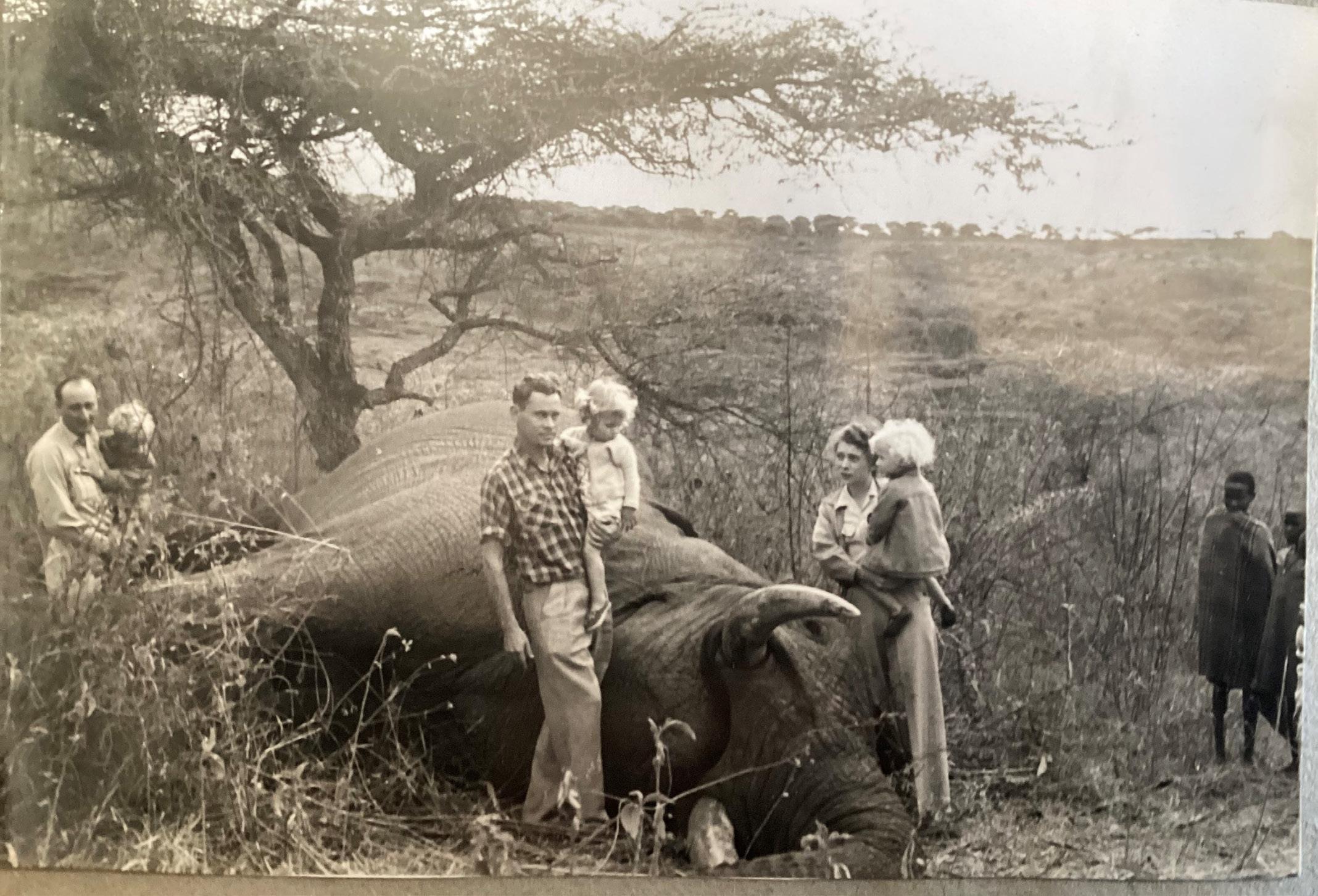
The Maasai were not impressed with the ‘white man’s muti’ and would continually move their herds. Unfortunately for them, many of my grandfather’s crew were ex-intelligence officers, and they were always one step ahead of the herdsmen, earning my grandfather the nickname ‘Rashi-Rashi’ which meant ‘here, there and everywhere’.
Their six children, which included my mom Lea, were sent off to boarding school in Arusha, which meant a trek of 240km each way.
Later in life, whenever any of us children would complain about something, my mother never tired of reminding us how they had to follow their Maasai guide through dense forest, dodging lion and buffalo.
My paternal grandfather Lt. Alec McCallum aka ‘Mac’, was an engineer on the Lunatic Express, which was the railroad that connected the Kenyan port of Mombasa with the inland city of Kampala in Uganda, a distance of close to 1000km.
The nickname ‘Lunatic Express’ was reportedly given to the railway because of the high cost and the difficulties involved in its construction, as well as the perception that only a lunatic would undertake such a project.
The Great War came. Mac enlisted and ended up being wounded at the battle of Longido. He spent the remainder of the war convalescing in the Norfolk Hotel in Nairobi where he met Lady Emerson, whom he married.
They had four children, two girls from Lady Emerson’s previous marriage, and two boys, one of whom was my dad Owen.
They moved to western Kenya where Mac tried his luck at gold mining, which was all the rage at the time.
FlightCom: May 2023 11
Iris and her dad at an elephant hunt.
Unfortunately my grandmother died of blackwater fever and the mining proved fruitless, and so Mac threw in the trowel, and turned his attention to hunting.
He made enough money to buy a farm in Oldeani, Tanganyika where he began a coffee plantation. Thus the two families were acquainted in Tanganyika – and fate bought my mom and dad together.
The Second World War arrived and my dad went to fight in Abyssinia, Somalia and then Malaya and India. Somewhere between the desert and India my parents got married.

After returning from the war, my dad joined a company called Safariland where he started off as a hunting apprentice, with the eventual aim of becoming a Professional Hunter (PH). Safariland offered mainly hunting safaris, with the occasional photographic safari, to wealthy Americans, British and Europeans who paid top Dollar for the “Out of Africa” experience.
A couple of years later his boss died in a tragic
shooting accident whilst cleaning one of his weapons, leaving my dad at a loose end.
In the 1950’s crocodile skin was all the rage on the catwalks of Milan and Paris and hunting these animals for their gnarly hides was a big business. My dad was enticed by an army friend to help him hunt crocodiles in the remote area of Lake Rukwa, a freshwater lake located in southwestern Tanzania, near the border with Zambia.
This 4,800 km2 lake was notable for its extensive hippo and crocodile population and being the adventurous spirit that my dad was, he jumped at the opportunity, dragging his reluctant pregnant wife and two small sons with.
My mother went with on condition that they would travel to Arusha for my birth. I was born Iris Magdalena McCallum on 2 June 1951 in a hospital called ‘The Boma’ in northern Tanganyika, close to the Serengeti and the Ngorongoro crater.
12 FlightCom: May 2023
PILOTS
Young Iris with her dad Owen on the shores of Lake Rukwa.
For the first two years of my life we lived a very simple but challenging existence in Lake Rukwa. As a baby I was confined to a mobile cot under a mosquito net due to the constant threat of malaria and sleeping sickness.
Fresh food was very scarce and as a result I was raised on tins of condensed milk, whilst my parents and brothers ate crocodile and the local tilapia grahami, interspersed with occasional game meat.
After her stint in Lake Rukwa, my mother refused to eat fish until the day she died, citing an ‘allergy’ to anything with scales.
The area around Lake Rukwa was incredibly hostile, there was literally something around every corner that could kill you. It was home to a multitude of insects and animals that had the propensity to bite, gore or sting.
BUMPPPFFF:

It was here that my mother earned the nickname ‘mama shotgun’ for her knack of being able to blast poisonous snakes to smithereens at close range with a 12-gauge shotgun.
The place was subject to cloying humidity and incredibly violent thunderstorms. The seemingly hundreds of jagged lightning bolts would reflect off the lake’s surface and light up the sky as though it was daylight. The earth would shake and thunder would reverberate through the valley, sounding like the devil himself had loosed all the demons from hell simultaneously.

FlightCom: May 2023 13
be continued…
To
Does the fan on the roof power the Tesla?
Smart move to avoid a storm
BY JOHN BASSI
CHIP DETECTOR RULES PART 4
In the first part of this gripping story, John shared the anticipation and preparation for Rhino dehorning flights. Then he had unwelcome mechanical drama when his JetRanger began to make alarming grinding noises from deep within the engine. In Part 3, John described how the Eng. Chip light in his Bell JetRanger had illuminated and with his heart in his mouth, John had to call off the dehorning and risk flying his beloved JetRanger to a safe haven where the necessary maintenance could be done.
ONCE BACK IN THE AIR, I wanted this over so I did not waste any time climbing as high as practical in the hope that I may see a road within reach. Nothing. Just undulating bush.
Twenty minutes is very long. It leaves you with ample time to think about what your truthful reaction will be if the light were to illuminate. The GPS didn’t seem to be showing any reduction in ETA, and I realised I was treating the caution panel as if it were a black mamba.
Halfway back the warning light flickered slightly, catching my full attention. My heart sank, gut tightened, and eyes searched in vain for a safe landing site.
I grappled with the dilemma, that it was very faint
flickering; not full on. To land in the bush, far away from anything, did not appeal to me, but to ignore the light was dumb.
The light flickered and went out again. I was very relieved, but the kilometres were just not passing under me fast enough, and there was still another ten long minutes to base.
The chip light taunted me by flickering faintly again. My mouth went dry and my mind cleared instantly of all distracting thoughts except getting the aircraft safely onto the ground. Right here and now – in the bush.
The safety of a hangar, my car, and all the luxuries of
14 FlightCom: May 2023
life was just three miles away. Such a pity. Wind check, T’s and P’s good, I focused on a grassy patch within reach if the turbine went. And then the light went out again.
From then on it was almost an anti-climax. With one eye firmly fixed on the Chip Light I headed straight for the hangar and with huge relief landed and shut down uneventfully. But this was just a foretaste of things to come.
My helicopter was seriously sick, but the rhino population is dying. The demand for my helicopter’s abilities for dehorning rhinos is ever-growing.
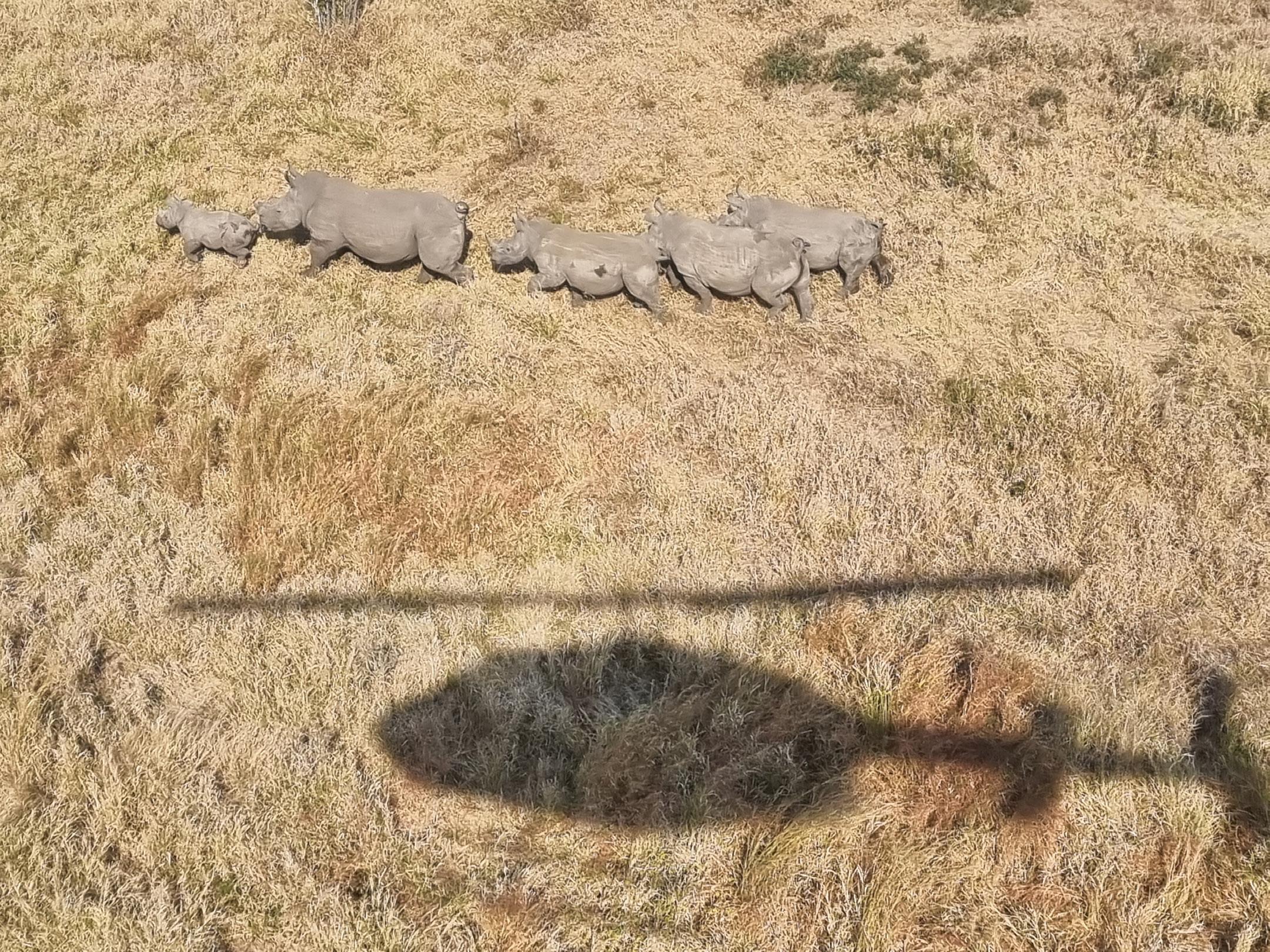
As rhino numbers across the country continue to decline, conservation efforts focus on proactive approaches to stop poachers before rhino are killed. The goal is to protect some of the country’s key rhino populations in their network of protected areas. Helicopters are not cheap to operate, and the problem as always is the need for additional resources to ensure these interventions reach their full potential.
In the greater scheme of things, both the black and white rhino populations in Southern Africa continue
Unfortunately, ‘the man in the street’ seems to be under the impression that poaching is not really a problem anymore. This may be because the media’s big hype from a few years ago has become bored with the topic, and the public have become punch drunk from
FlightCom: May 2023 15
to face unrelenting pressure from poaching syndicates who look to trade their horn to consumers, primarily in Asian markets.
my instincts knew this was the danger zone
An increasingly rare sight, a group of rhino together.
all the bad news. But still the rhinos continue to be decimated.
Meanwhile, having made it back to base and safely on the ground in one piece, the engineers assessed the situation and efficiently removed the engine accessory gearbox.
In the process it had been determined that the No 2.5 bearing was in the process of failing, but astoundingly, had already done 9000 hours. It is a component that is only opened ‘on condition’. This meant having to send the gearbox to the USA for a full overhaul and refurbishment.

Thankfully, within two days we were back in action, flying with a nice new loaner unit. Parting words from the AMO were that within the next 5 to 10 hours I should expect another chip light, due to metal residue within the oil system.
Being back in the air after such an event made me a more than a little wary - and with a heightened consciousness of engine limitations. It focuses the attention; one eye is always monitoring gauges.
But being back in the bush, in our happy place, with no unusual readings and no chip light for 15 hours, I confess that I started to relax. What I had noticed however, was that after every flight there was a never before seen, small smudge of oil blowing onto the front bottom engine cowling’s starboard side. The bleed air from the bleed valve was most likely concentrating an oil residue from somewhere onto that spot. Yet, on careful inspection there was no sign of any oil leak or seepage. In hindsight, unfortunately, I was advised to just keep it clean and monitor it, (this would be a key indicator).
Strangely, when the Eng. chip light did eventually illuminate, at around 16 hours, I eyed it with both a small part of relief, but a greater part with fear. On inspection of the chip detector, I expected to find just a few specs of fuzz, not another splinter covered magnet.
Feeling a bit forlorn and a hint of Déjà vu, I followed the engineer’s instructions to clean the detectors, fly and monitor. If they illuminated within 1 hour, then stop operations. That was a long hour, as was the next. After five hours I started feeling OK, by ten hours I was more confident and relaxing. Then suddenly, while operating 20 mins from base, and as usual, above thick bush, a bright amber Eng. warning chip light flashed ON.
Needless to say, in my nervous state of mind, I landed immediately, found cellphone signal, and discussed all options with the AMO. An inspection of the plugs revealed little chunks of shiny metal. My heart sank. This was going to be expensive, not to mention all the familiar emotions of fear, once again being on the very sharp and unconfutable horns of the dilemma of trucking the helicopter out or flying it out of the bush, to the safety of a hangar.
Once again, we were in the middle of no-where, a most impractical place to reach, let alone to remove a turbine. What were the rules for a chip light in the middle of the bush?
16 FlightCom: May 2023
The lower magnetic chip detector with its tell tale slithers of metal.
This was going to be expensive

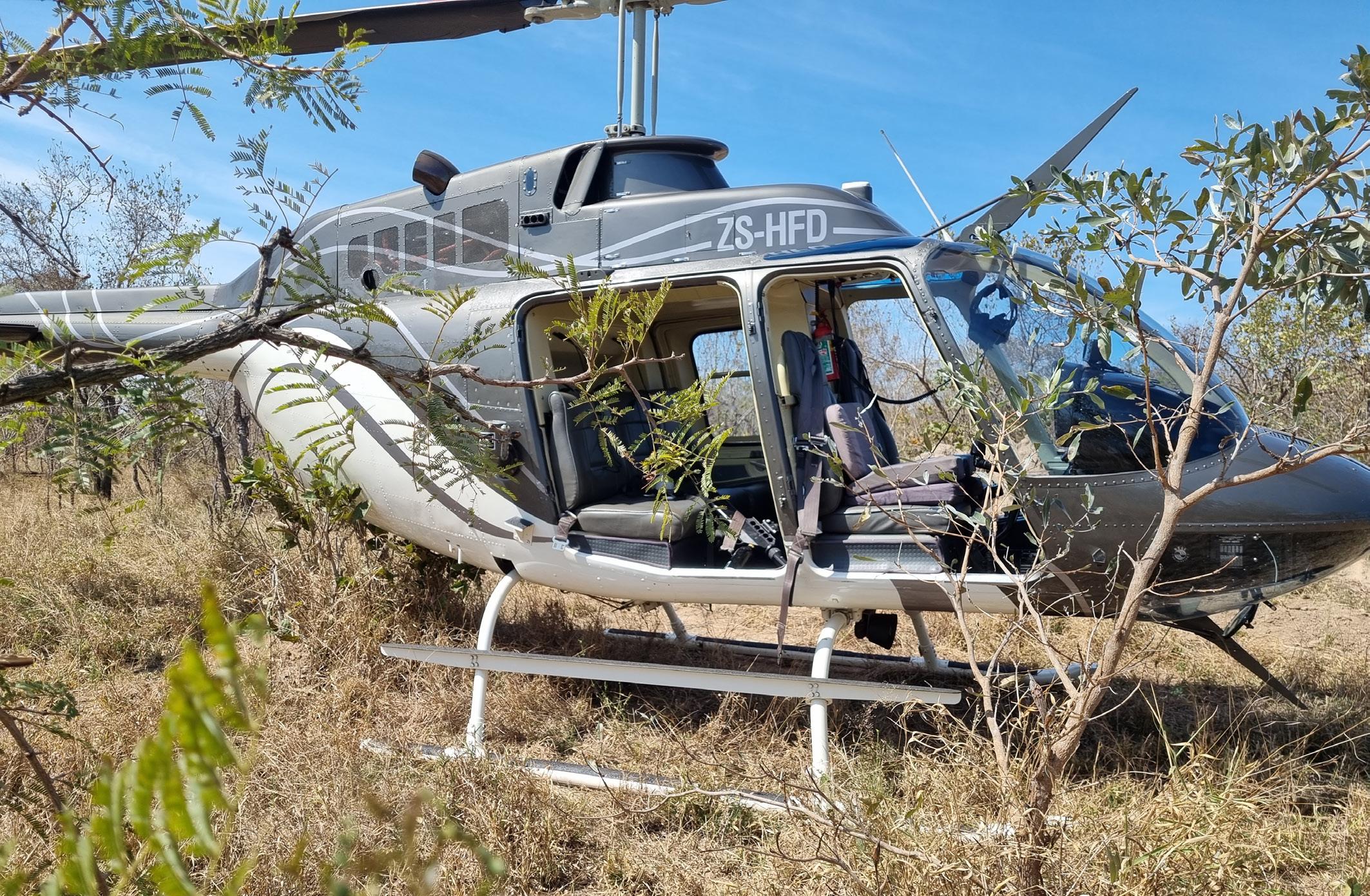
FlightCom: May 2023 17
An old bullet wound on a rhino cow. Her calf is in the background. It incredible how these animals survive such wounds.
Rhino don’t particularly care about falling asleep in the open. Confined landings become the norm.
Our full team on a rhino dehorning operation. To be more efficient we had two vet teams, a mobile ground crew and our A22 Foxbat spotter.
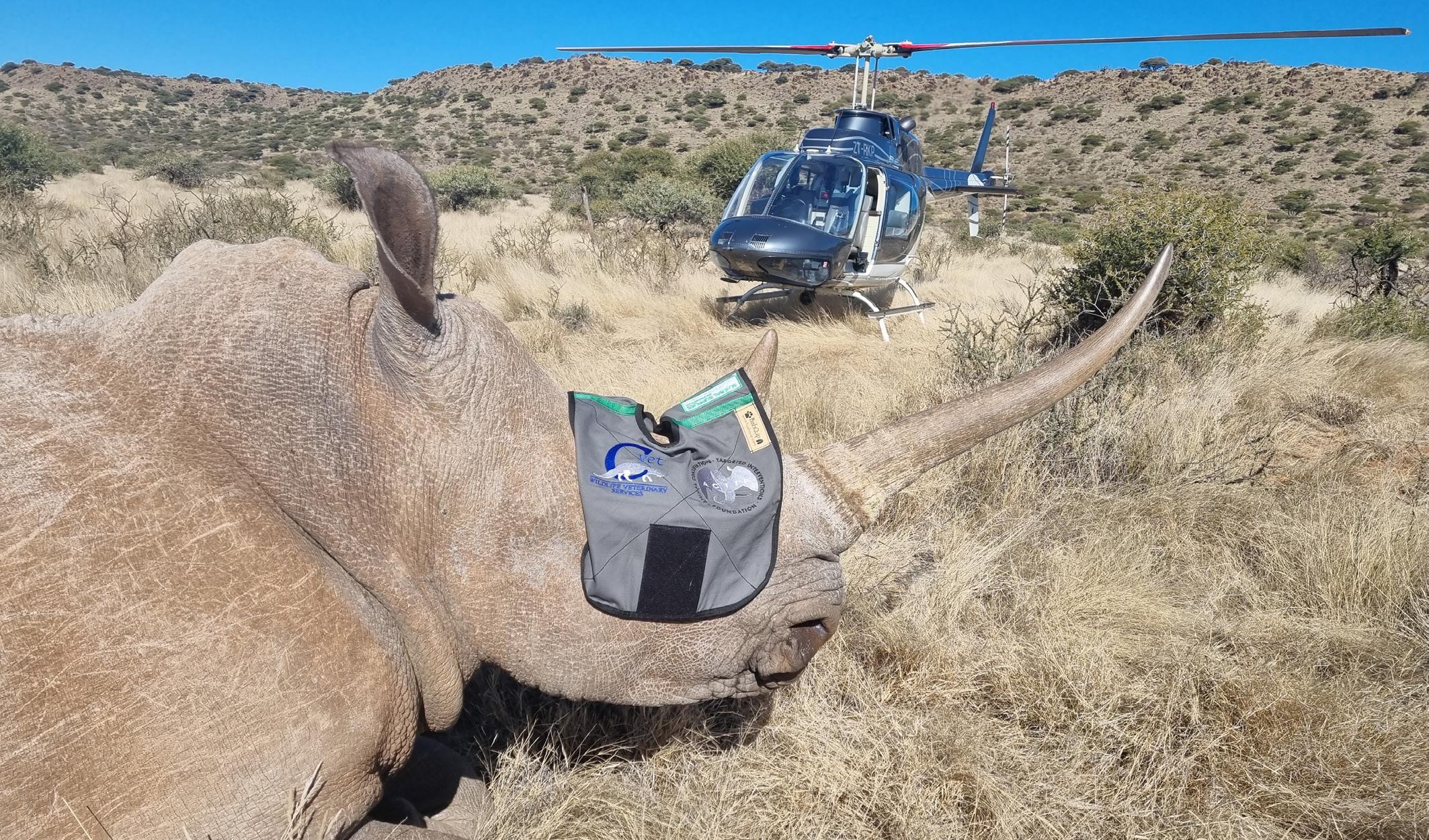

I decided to hover for a few minutes whilst monitoring everything and if after 5 minutes all looked good, to climb out, heading directly for base, a fifteen-minute flight over bush, but with a clear mind that at the first indication of change, the slightest flicker of the warning light, I would perform an immediate landing and shut down.
My heart was in my mouth, the kilometres dragged by. I desperately hoped the trip would be uneventful and over.
The airfield finally became visible. Just a few more minutes to go; all was still looking good.
I joined onto a long final approach, feeling so elated that the nightmare was almost over, set up now on a descending constant angle approach. And then again, the light glaringly illuminated.
All my instincts knew this was the danger zone, all I had to do was slow the aircraft, flare, stabilise and land, but it felt like an eternity.
As I flared, slowing into a hover, the sky around me disappeared in a cloud of white smoke. Burning oil blown by the rotor downwash enveloped the helicopter. But we were safe on the ground.
[to be continued]
18 FlightCom: May 2023
It is demoralizing and criminal to be at a point where we are mutilating such beautiful animals in order to try and save them from certain death.
SOUTH AFRICA GETS 92% ICAO SCORE.
SOUTH AFRICA DID NOT attract a significant safety concern and received an overwhelming effective implementation (EI) score of 92% in the audit.
In the last audit conducted more than five years ago, ICAO gave South Africa a score of 87.39%.
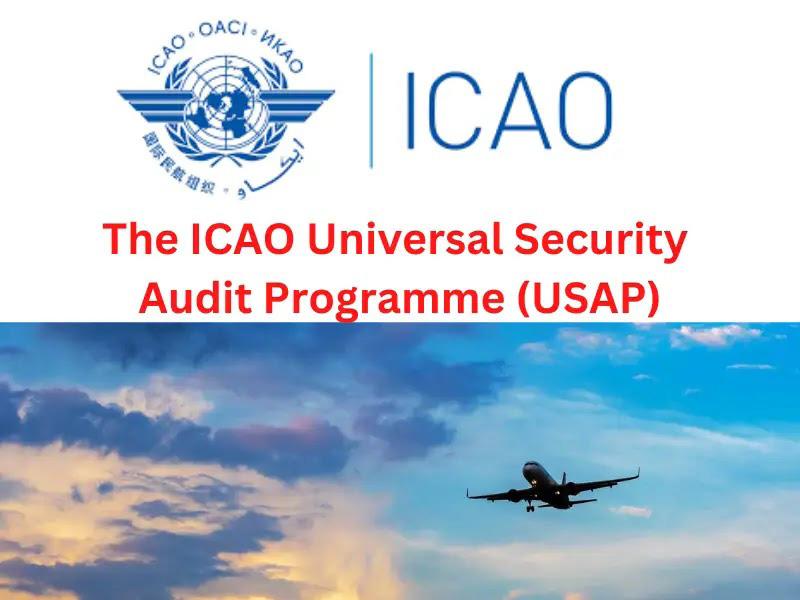
Poppy Khoza, the Director of Civil Aviation at the South African Civil Aviation Authority (SACAA), has welcomed the ICAO preliminary aviation safety audit results which showed an improvement on the audit conducted five years ago. “We now rank among the best in the world and on the continent we rank number one,” she said.
The SACAA is waiting for the final report in less than five months. The regulator says it is attending to the minor findings contained in the preliminary report to close the gaps identified.
South Africa is a signatory to the Chicago Convention on International Civil Aviation and a member state of ICAO since 1944. The country is obligated to comply with prescribed international civil aviation standards and recommended practices.
Khoza said “The audit we just completed last week is a safety audit that is at the entire safety value chain of our civil aviation.”
She said the international organisation examined several audit areas, including whether there was an adequate legislative framework to ensure proper regulation. “They will look at personal licences, they
will look at aircraft airworthiness. They will look at the general flight operations, they will look at the issues of craft accident investigations and they will also look at the organisation in terms of the structure. Those are the main pillars, underneath all those auditing areas, are what we call protocol questions. They look at the entire process.”
She said ICAO will also check if there are empowering provisions in their legislation. For example, to ground an aircraft or take enforcement measures if an airline, operator or airport is non-compliant. “They go to the industry, they do the industry visit based on the operations they have sampled and they then check whether we as a regulatory authority are doing the right thing in terms of regulating the civil aviation industry effectively.”
FlightCom: May 2023 19
NEWS
South Africa scores well in ICAO's Universal Security Audit Programme.
In early April, the International Civil Aviation Organisation (ICAO), under its Universal Safety Oversight Audit Programme — Continuous Monitoring Approach (USOAPCMA), concluded a 12-day audit of South Africa’s aviation oversight system.
BY GUY LEITCH
SANSA: SUPPORTING MOON SHOTS AND WATER RESOURCES
The South African National Space Agency (SANSA) has become a world class resource for aviation and space missions. SANSA is now supporting projects as diverse as the first Arab moon landing to monitoring water resources in the Eastern Cape.
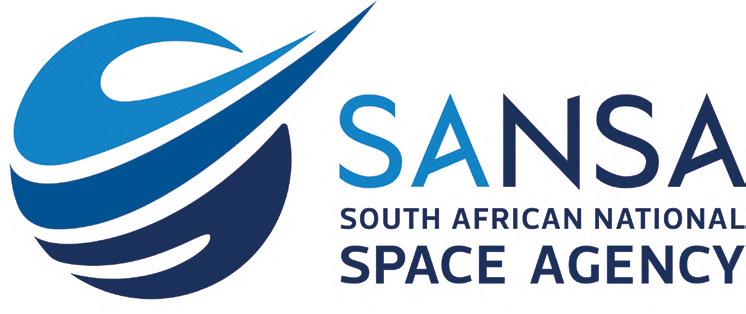

20 FlightCom: May 2023
SANSA is a key provider for space weather impacts on aviation.
SANSA’S SPACE WEATHER capability has been developed in response to the International Civil Aviation Organisation (ICAO) 2021 selection of SANSA as one of two ICAO-designated Regional Space Weather Centers.
The implications of this designation meant that a full operational capability that meets the ICAO requirements needed to be put in place by 2023 to provide advanced research capabilities in the space weather field. The regional centres provide space weather services, including solar storm forecasts and warnings to the global aviation sector.
The Space Weather Centre
SANSA has been operating a Space Weather Centre for the past 12 years in Hermanus in the Western Cape. It has worked on monitoring the sun and its activity, and providing space weather forecasts, warnings, alerts
and environmental data on space weather conditions, all of which are critical to aviation safety.
Space weather can interfere with satellite electronics, communications and GPS signals, amongst other things. With the growing need to monitor space weather and its impact on communities and technology, SANSA is a member of the International Space Environment Service and contributed this service as the Regional Warning Centre for space weather in Africa
Of note is SANSA forecasting the G4 magnetic sun storms that disrupted aviation worldwide in March 2023. To enable data and resource gathering SANSA is requesting all pilots and other involved in aviation to provide feedback on any space weather phenomena they encounter – and specifically how it effects their flights.

FlightCom: May 2023 21
SANSA is updating the Geo Magnetic map every year.
SANSA’s Space Cooperation
SANSA also has a role in international space cooperation,. For example, SANSA is supporting the Mohammed Bin Rashid Space Centre’s mission to land their Rashid Rover on the moon on 25 April 2023. The Rashid Rover is the first Lunar mission by the United Arab Emirates’ and was launched by a SpaceX Falcon 9 rocket from the Kennedy Space Center in Florida on 11 December 2022.
SANSA’s Hartebeeshoek Ground Station will establish direct communication between the Rashid Rover and the ELM Control Centre, which is located at MBRSC facilities in Dubai, as the Rover lands on the moon’s surface. To track and communicate with the spacecraft, SANSA will commission two antennae – a 12-meter S-band antenna for uplink transmissions and a 26-meter parabolic antenna for downlink transmissions.
SANSA is also working with NASA to establish a deep space tracking and telemetry station in Matjiesfontein in support of future lunar exploration on the Moon.
support of future lunar exploration on the Moon.
Aviation Services
SANSA provides other essential services to aviation. Of specific interest is the agency’s magnetic capability. Compasses are still an essential component of aircraft navigation equipment. Electrical systems may fail, but the Earth’s magnetic field never does. However, it is continuously changing and that requires constant monitoring to determine the degree of compass variation at any specific place.
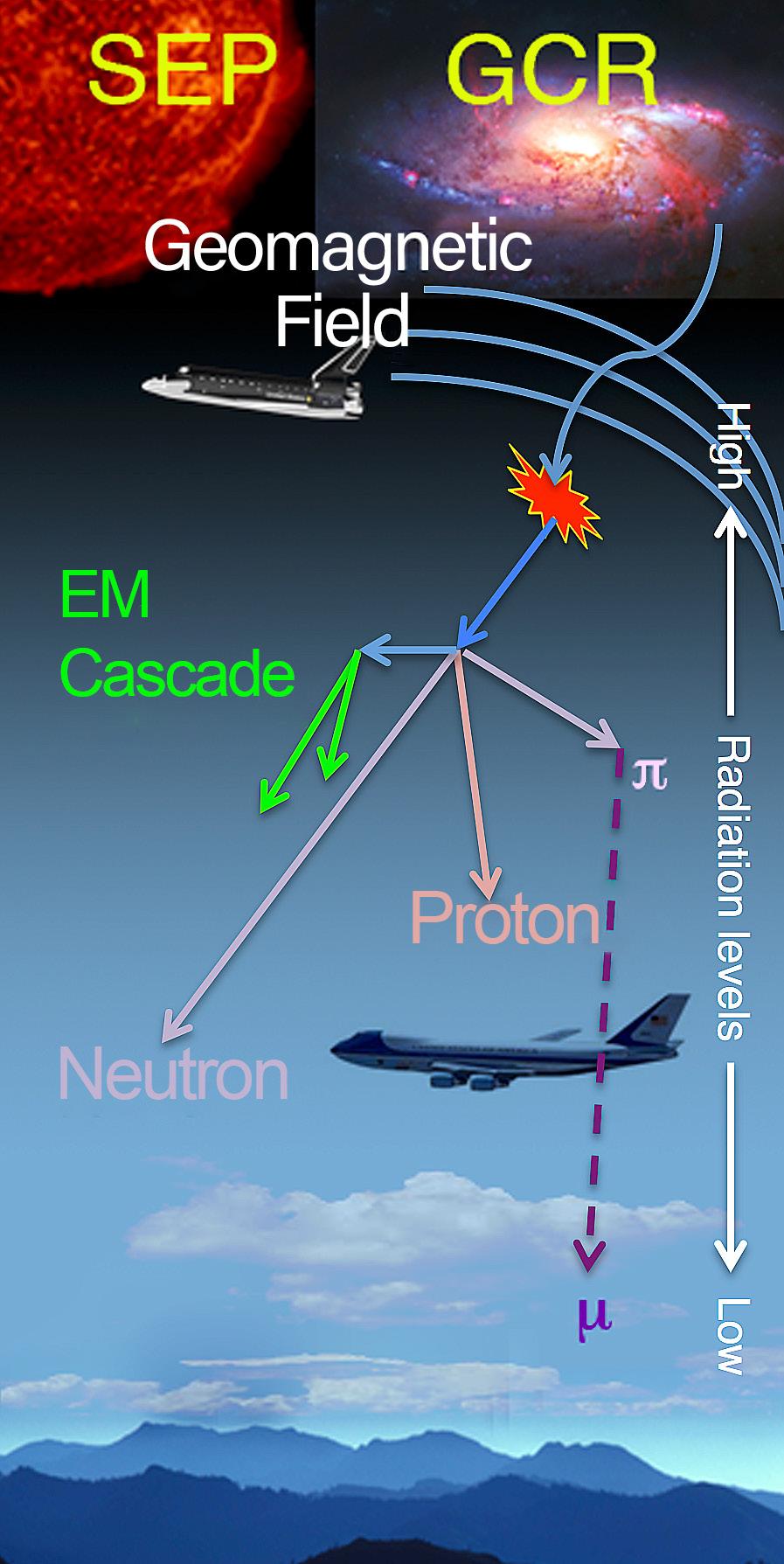
A proper compass swing procedure is necessary to determine how to compensate for the magnetic field of the actual aircraft, which will cause a deviation to the compass reading, due to the proximity of steel or iron components and by the effects of current flowing in nearby electrical circuits.
A properly conducted compass swing requires a reference compass calibrated by SANSA, which must be done in a magnetically clean environment – free of steel structures, underground cables, or equipment that produces magnetic fields – to assure it is free of interference.
The Earth’s Magnetic Field
Another key magnetic capability is SANSA’s annually produced Geo Magnetic Map. The Earth’s magnetic poles are continuously moving with consequent changes in magnetic variation. Globally, maps of variation are only updated every five years, but SANSA is updating the Geo Magnetic map every year.
22 FlightCom: May 2023
Solar radiation's effect on aircraft.


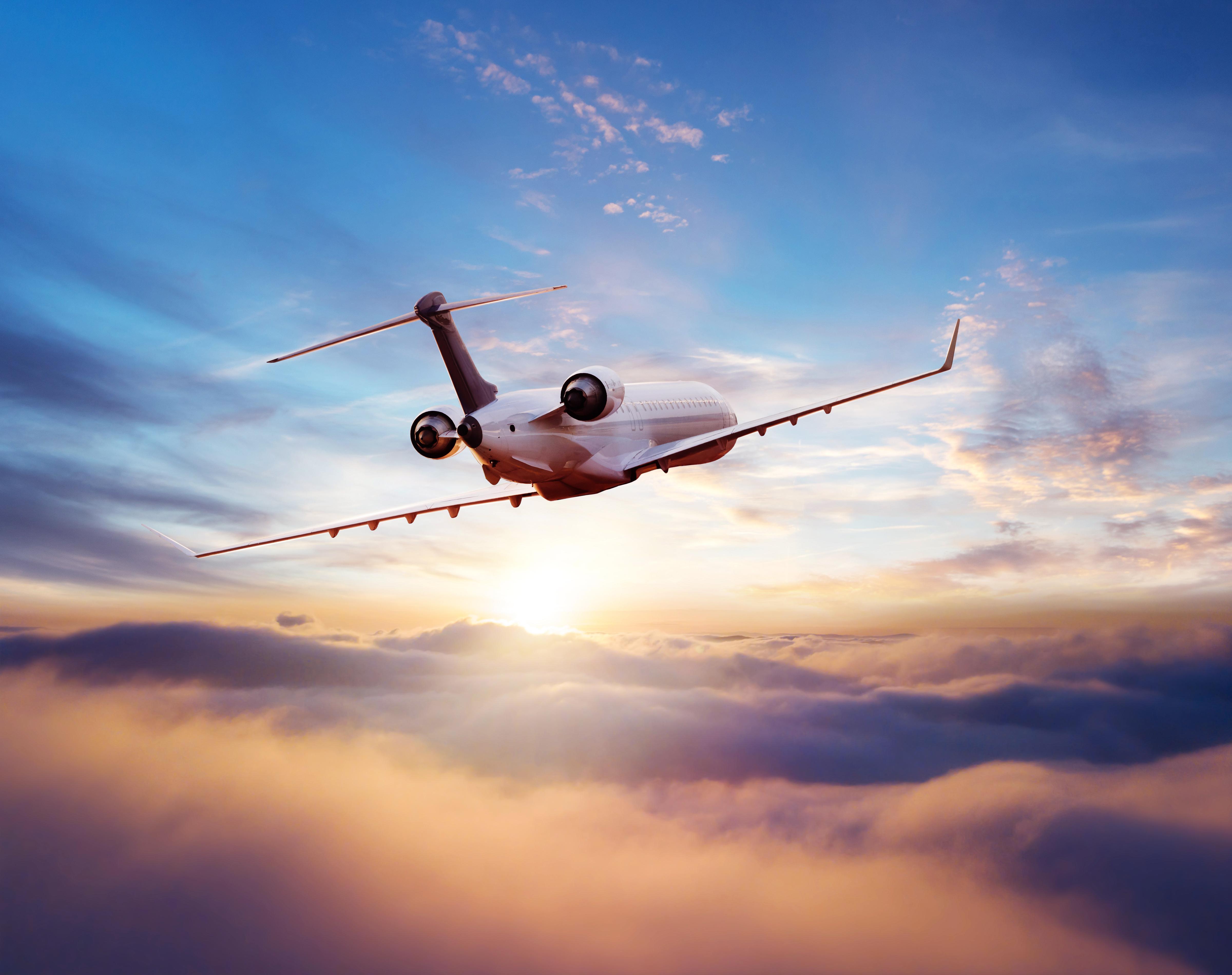


FlightCom: May 2023 23
Solutions for Aviation
magnetic technology facilities
24/7
African National Space Agency (SANSA) offers: www.sansa.org.za
Space
Unique
Compass calibration and maintenance Compass swing facilitation and training
space weather monitoring Space weather warnings, alets and training South
THE LONG JOURNEY OF A MISSION PILOT
Eivind Lindtjørn is a typical Mission Aviation fellowship pilot flying in Africa, in that he combines a higher calling with a passion for flying.

24 FlightCom: May 2023
TEXT: ODD ARILD NESSA, TRANSLATION: CLARE WILSHAW, IMAGES: SVEIN-ROBERT SOLBERG

FlightCom: May 2023 25
Eivind Lindtjørn flying a typical Mission Aviation fellowship mission in Africa
EIVIND IS DRIVEN by a deep desire to see sick people living in remote areas be healed, and to see hearts changed by God´s love.
“Africa is in my blood. My grandparents travelled out as missionaries in 1948 – they were some of the first Norwegian missionaries in Ethiopia. My father was educated as a doctor, and my mother was a nurse. I was only five months old when they followed in their parents´ footsteps to Ethiopia,” he says.
During his childhood in Ethiopia, his dad, Bernt Lindtjørn, used to take the children down to the local airstrip. It was there that Eivind first met MAF. “I remember MAF very well. We also took a tour over the mission station in Helimission´s helicopter – that made a huge impression on me! It was unbelievably exciting. I remember that even then, I had the thought ´When I´m grown up, I´ll go to Africa and be a MAF pilot!”
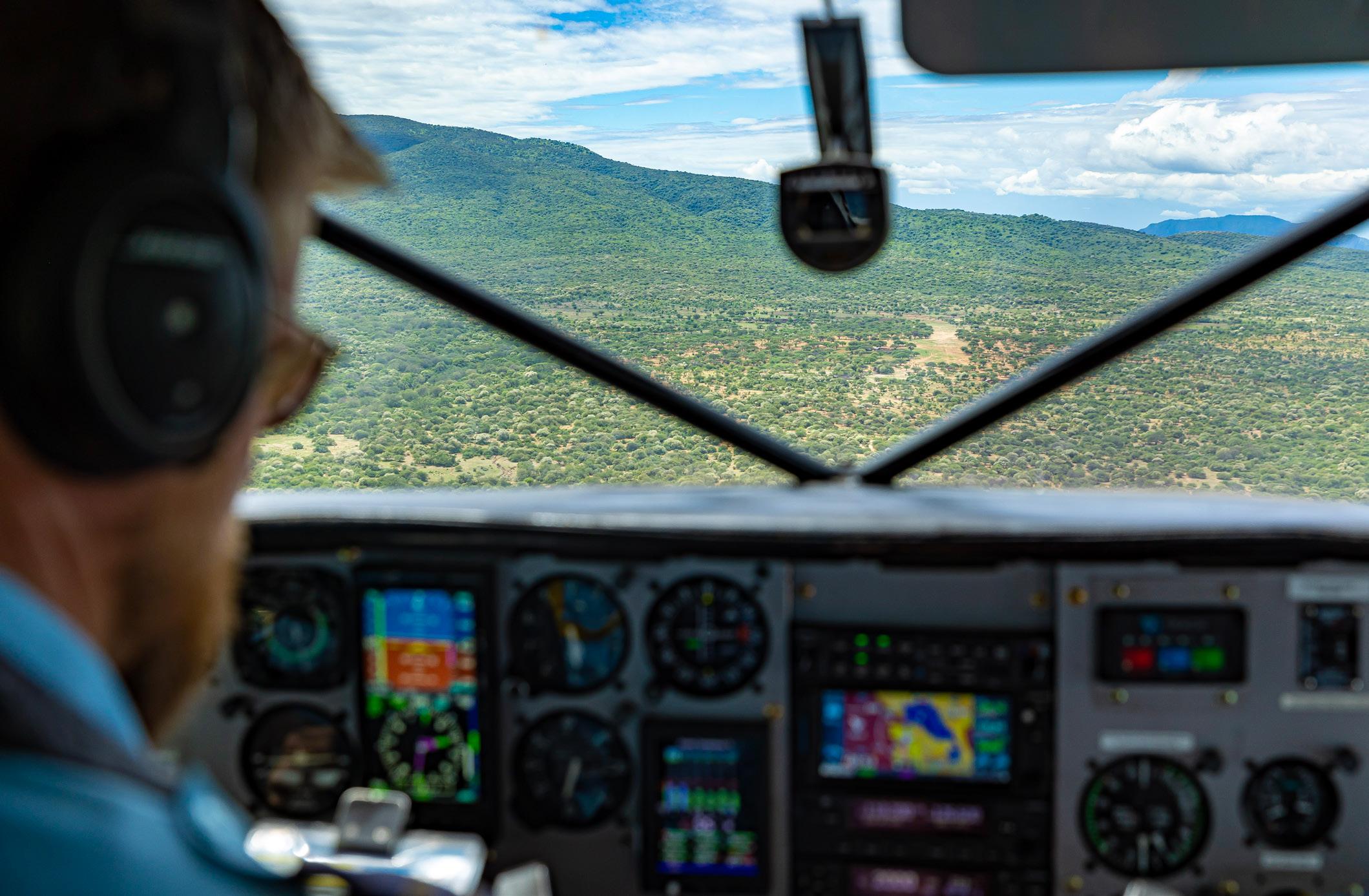
Norway was difficult for him. He couldn´t settle down, and he missed Africa. His first year at Danielsen High School in Bergen was one of the most difficult years.
“I felt that I didn´t fit in and hated it; I got really low. I sat on the school bench and dreamed myself back to Africa while I failed in several subjects.
Eivind took odd jobs and scraped together money to learn to fly. Attending aviation studies at Sagavoll Folk High School, he got as far as his sixth solo flight towards the end of the year.
Africa is in my blood
After eight years in Ethiopia, divided into three separate periods, Eivind came home to Norway as a sixteen-year-old. Adjusting from Africa to cold
“I´m pretty sure I was the most serious student in Sagavoll´s history. I´d found my motivation and path, and with my goal in mind I was studying every single day”, remembers Eivind.
After Sagavoll, he contacted MAF and asked what he needed to become a MAF pilot. He noted down qualification as an aircraft mechanic, a Commercial Pilot License, Bible school and at least 500 flight hours.
26 FlightCom: May 2023
MAF routinely operates into many challenging airstrips.
“So the plan was clear”, says Eivind. “My next ´checkpoint´ was qualification as an aircraft mechanic. I ended up at Tryggheim High School. I worked hard and was very focused, and got the top grades, which say a lot about how motivated and driven I was. I knew what I wanted to be.”
By 2006 he was 28 years old and had all his flying hours and certificates, as well as seven years´ experience as an aircraft mechanic with SAS. So Eivind packed up all he owned and travelled to Tanzania to start the job he had been working towards for twelve years.
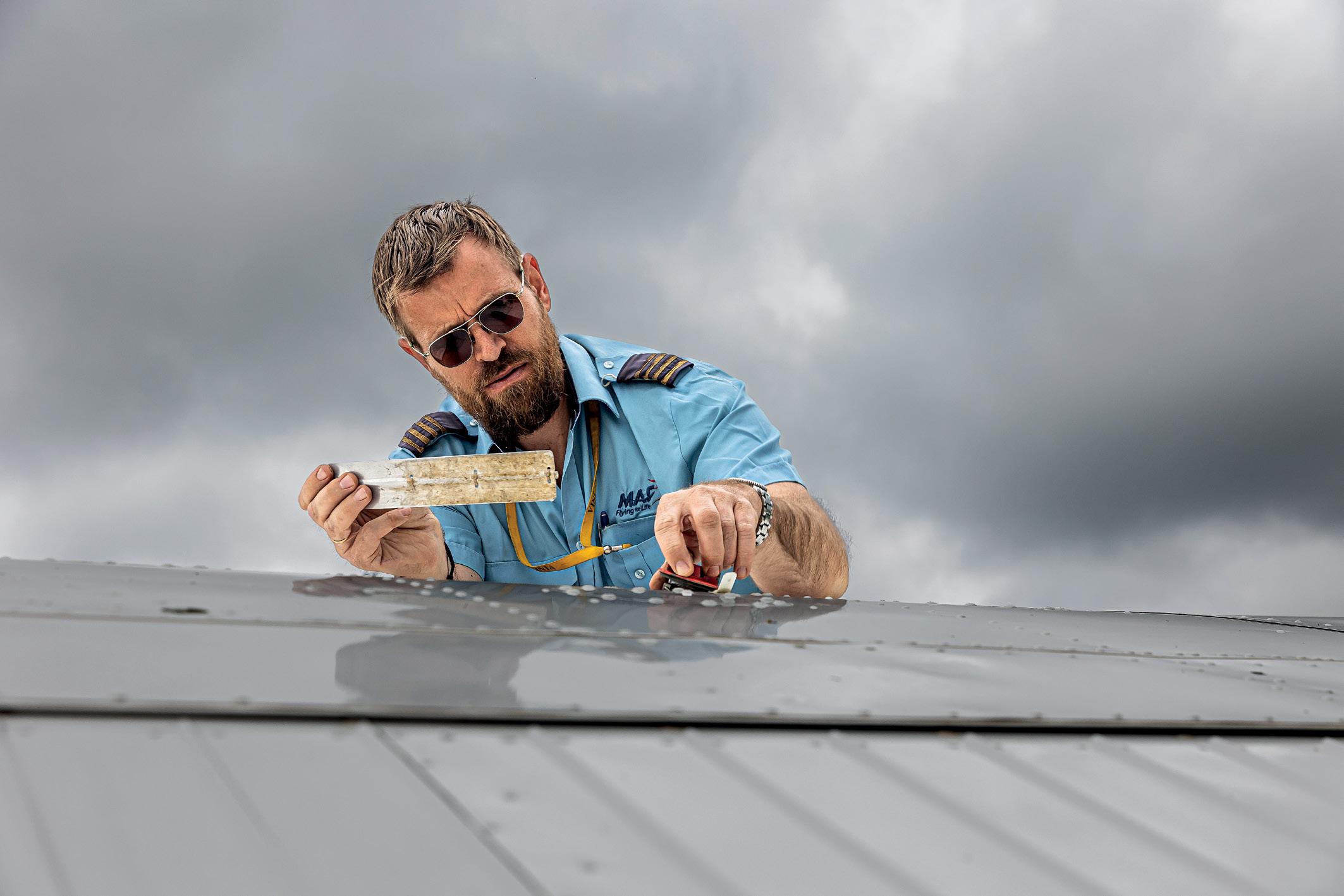
a potential son-in-law for his daughter, living in the USA.
The daughter is Nadia, and she acted on her gut feeling and looked up Eivind on Facebook. Their communication grew and grew. Nadia travelled to Tanzania, where she worked as a volunteer for a childrens´ home. Eivind and Nadia married in 2010 and they moved to the USA.
plenty of such experience
“After a lot of hard work, I was finally a mission pilot. I had some wonderful years out in the bush! MAF based me in Kigoma; I operated a Cessna 206 and flew sick people, health workers and missionaries. I was living out my calling and my dream”, he says.
He helped a father and son get back to Israel. At the time Eivind didn´t realise it, but the father saw him as
Eivind says, “I have all my papers in order, so I can fly in the US, but I´ve never had ambitions to be a regular airline pilot or fly people on holiday trips. For my part, I´d be happy with a Cessna 206 for the rest of my life.”
About a year ago, Eivind received an enquiry from MAF International as to whether he could contribute as a relief pilot in Tanzania. Tanzania needed an experienced pilot who could serve the districts; Eivind has plenty of such experience.
FlightCom: May 2023 27
Eivind preflights the Cessna 206 with his fuel dip stick.
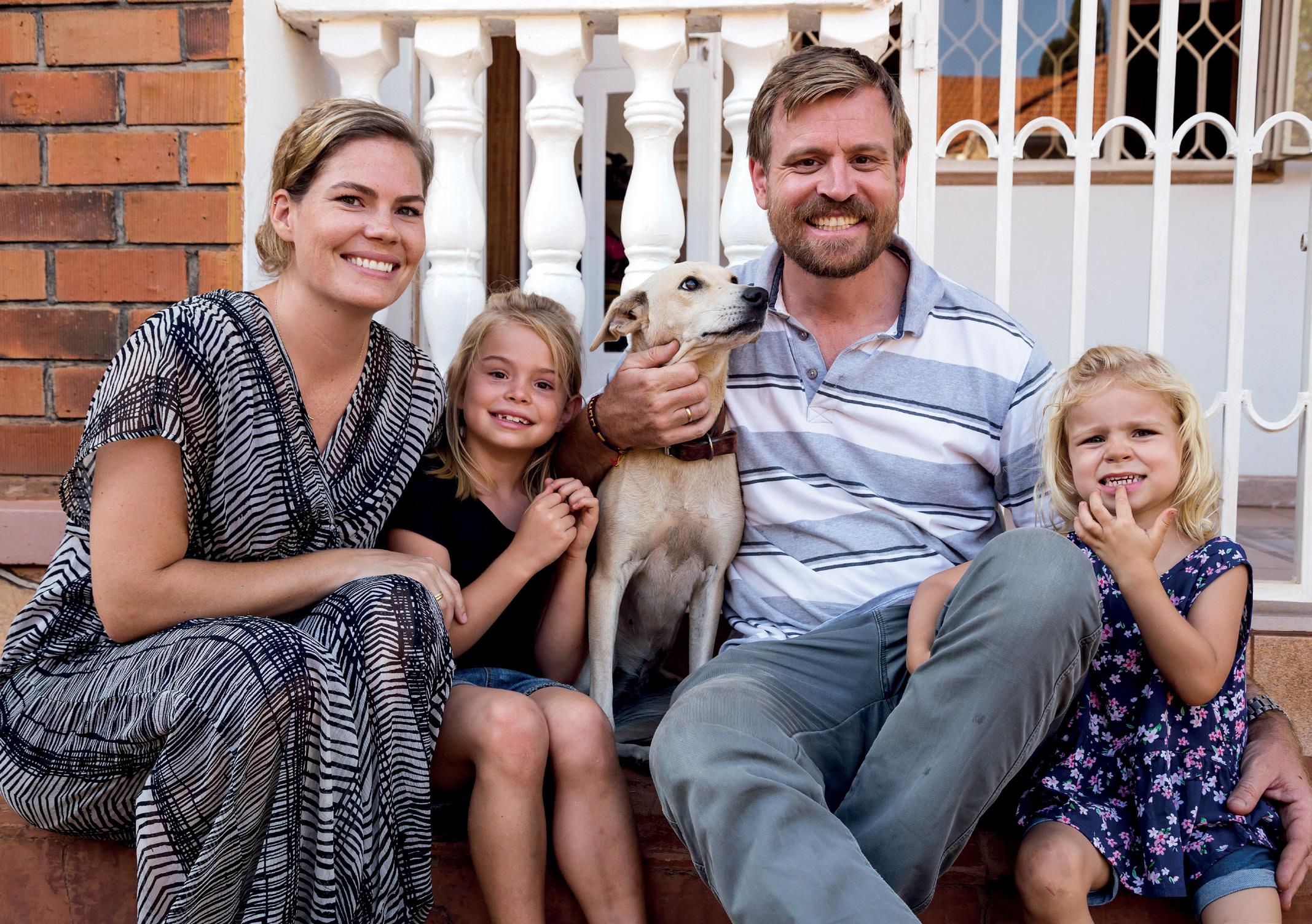

28 FlightCom: May 2023
Eivind is a family man who has flown to some of Africa´s most remote places. Wife Nadia, daughters Eliyah and Anava and son Netanel.
Eivind helps a passenger strap in to a Cessna 206.
“I had to pinch myself and answered that email within thirty seconds. There´s no other place in the world where I feel so at home as I do in Tanzania. That´s being a mission pilot with a capital M – it´s an exact fit with my calling and with what I´m good at. I look forward to every day and every flight,” says Eivind, while we can almost glimpse the African plains in his eyes.
Eivind´s next journey to the field will take him away for over a month. It is always a bit challenging to be away from his family for six weeks. Both he and his family know the job he does but point out that the family always comes first. The aim is for the family to be happy, so his time at home is important and valuable.
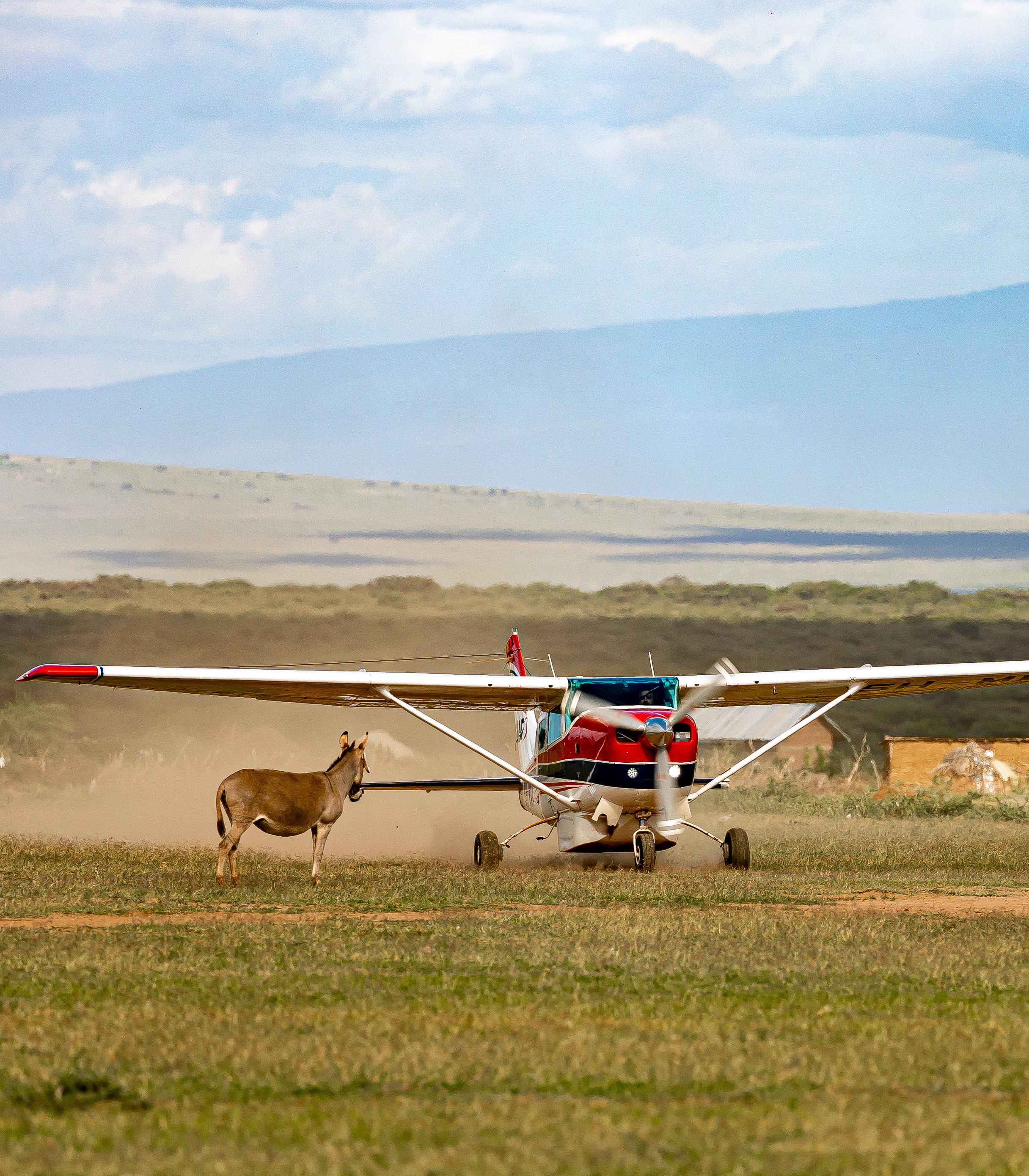
FlightCom: May 2023 29
Dodging the ubiquitous donkeys on African airstrips.
“Having children at home, I also experience a different sort of love for those that I serve out in the field. Now, I see my own children in those who are suffering, and that gives my service even more meaning.
“We don´t just meet one need, but the whole person, and the plane makes that possible. If MAF didn´t fly in Tanzania, measles would have popped up again, and women would have died in childbirth. Nurses vaccinate, measure and weigh, while evangelists hold meetings in the shadow of the plane´s wings. We won´t

get closer to the mission statement,” he says with complete conviction.
Once, a nurse came running with a little girl, just a few months old. Her mother couldn´t manage to feed the child, which was just skin and bone and could die any time. A ten-minute flight saved that tiny, sick child. That is what my job is about. There are countless such stories, and it´s such a privilege to get to serve in this way,” says Eivind.

30 FlightCom: May 2023
Flying in Africa provides unique sights such as Mt Ol Doinyo Lengai.
The arrival of a MAF aircraft is always a day of great excitement - especially for local children.
He feels nearer to God in the clouds. With thousands of flight hours and long flights over Africa, Eivind knows the mountains and valleys better than most, and in the air, his thoughts and reflections can flow freely. The spectacular landscape puts everything into perspective.
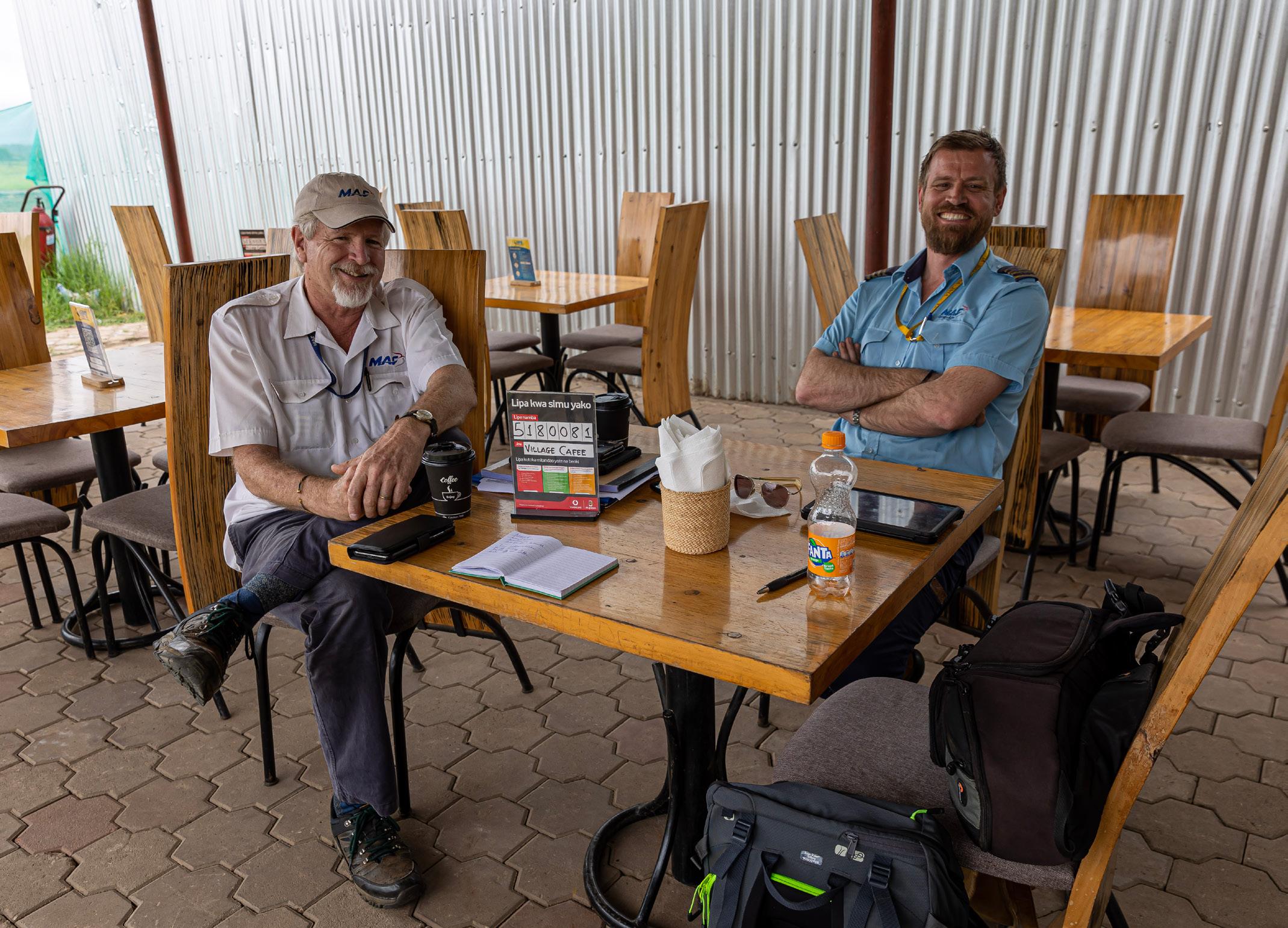
“Africa has such a varied and exciting landscape, and from the plane, I can look down and see traces of water. The whole world is scarred and shaped by water. I think back to Genesis and the flood, and see how water formed the landscape with enormous dykes, valleys, mountains and lakes. God has promised that such a punishment will never fall on humanity again, because he loves us so much. We live in the age of grace, where the mission is to fly to the ends of the earth and tell of His love. I feel that God is close to me when I have this view,” reflects Eivind.
“I love classical music, and especially Grieg. Once, I have flown over the countryside and looked down at the villages and huts and thought about the great needs of those communities.
He feels nearer to God in the clouds
It became clear to me what the gospel does when it takes root in a society. It begins with the hearts, just as it did in Europe more than a thousand years ago. We´ve been through challenging times in Europe, too, but Christianity has formed our civilization through people who have lived God-fearing lives. Our healthcare system started with people who wanted to serve God by helping others. I have no ambitions to try and change a country in Africa. I care about individuals. One heart at a time. That´s how individuals, families, societies and countries flourish,” concludes Eivind.
Up above the clouds, he also has time to listen to worship music, and Edvard Grieg is on that playlist.
FlightCom: May 2023 31
Relaxing after a hard day's flying with South African pilot and MAF Ops Director Mark Liprini.
UPDATE: THE CAPE WINELANDS AIRPORT
The Cape Winelands’ Airport
firming up
THE EMERGING ‘NEW’ airport sees itself as a key Alternate Airport for the Western Cape.
The challenge facing airlines operating into the Western Cape is that Cape Town International is the only large airport 200 nautical miles from Cape Town. Should Cape Town International’s runway be blocked, or the weather be below minimums, there is no Alternate airport closer than George.
Nick Ferguson, the Managing Director of Cape Winelands Airport holding company rsa.AERO, points out that they are keen to make the airport available as a nominated alternate for Part 121 Operations. This will save airlines a huge amount in terms of fuel carried for Alternate airports for flight planning.
Ferguson points out that on a long-haul flight, an airliner will burn four tons of fuel to carry 10 tons of fuel. The reduced fuel load from being able to nominate a closer Alternate will be a large saving to the airlines, and thus ultimately to travellers.
Ferguson also points out that the airport is aiming to
achieve international status and thus serve as a hub for regional, as well as domestic flights.
Deon Cloete is the new Managing Director of the Cape Winelands Airport. He reminds us that the airport is not really new but is in fact 80 years old. He says, “It is a grand old lady, ready for redevelopment. Construction work on the first phase is expected to commence in early 2024.” This includes the development of a new runway with a Category 3 ILS.
Cloete says there will be a 3,500m long runway with no restrictions and a Code E classification. It will thus be capable of accepting long haul widebody aircraft.
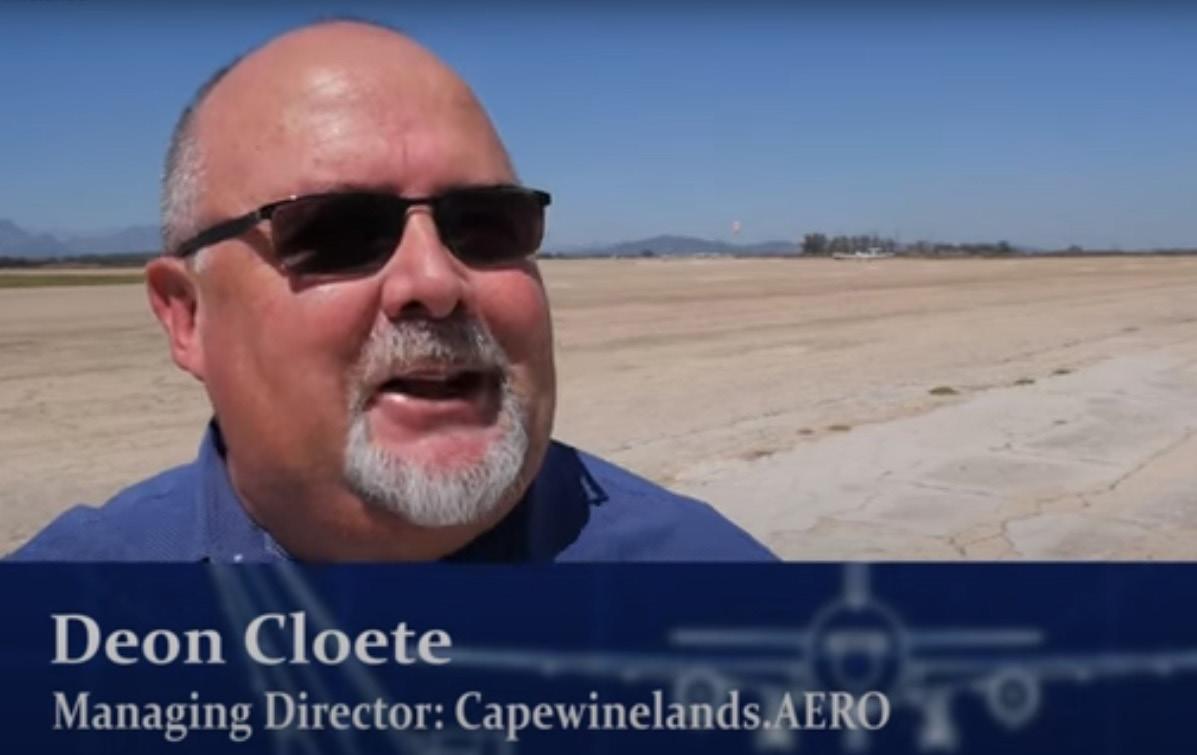
32 FlightCom: May 2023
STORY AND IMAGES ROBIN RABEC
is
its vision for the future….and its vision is big and bold.
Deon Cloete, formerly of ACSA is the new head of the Cape Winelands Aiport.
General Aviation will not be squeezed out. There will also be a cross runway for smaller aircraft.
The terminal buildings and infrastructure will be on the western side of the airport. Cloete says they are planning to start operating the first phase of the airport from 2027.
For more information – click on the attached link to see the detailed video produced by Robin Rabec: https:// saflyer.com/latest-news-on-the-huge-cape-winelandsairport-plans/



FlightCom: May 2023 33
Cape Winelands airport location as an alternate to Cape Town International.
CLICK image to play video.
Nick Ferguson in the MD of rsa.AERO, the Cape Winelands holding company.
Balloon Pilot Training Facility Do it in style!
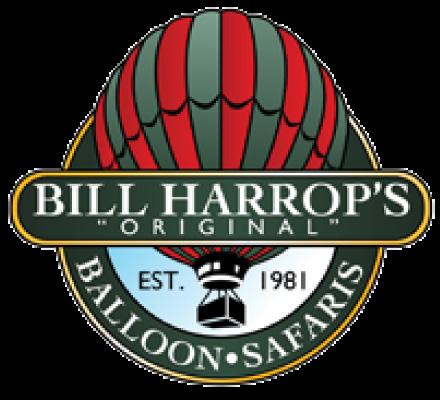
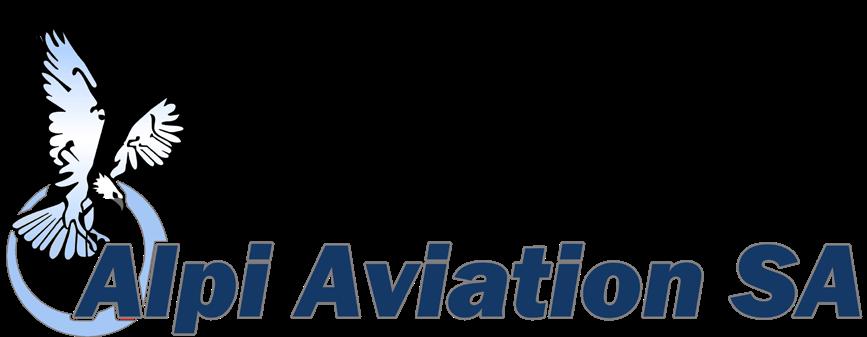
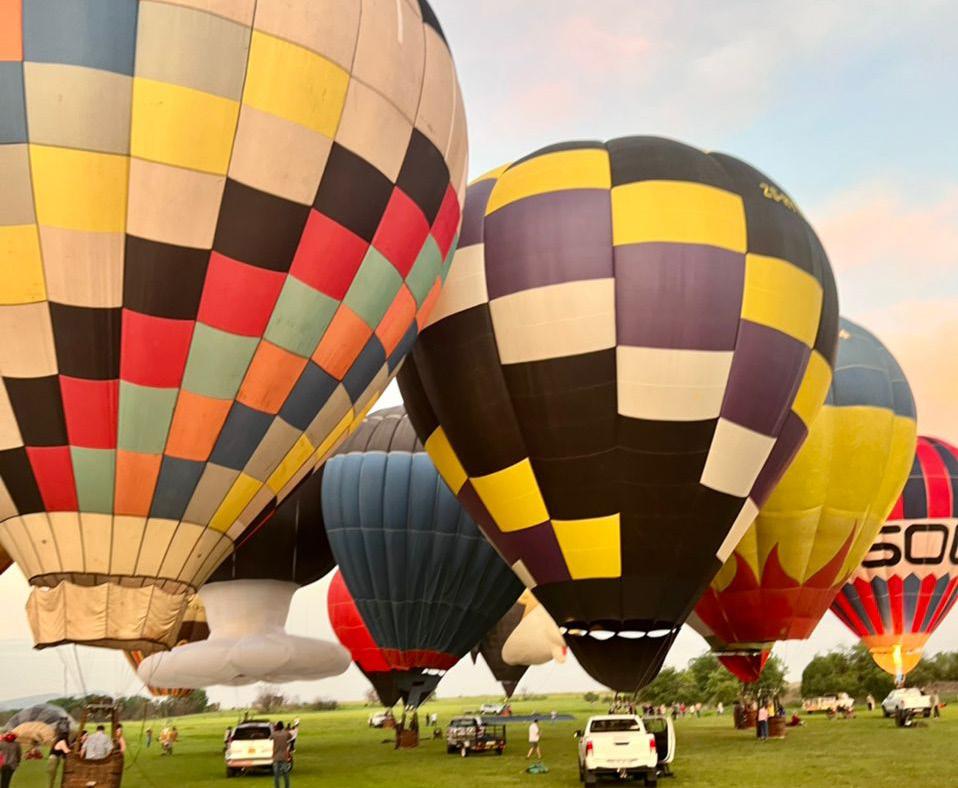
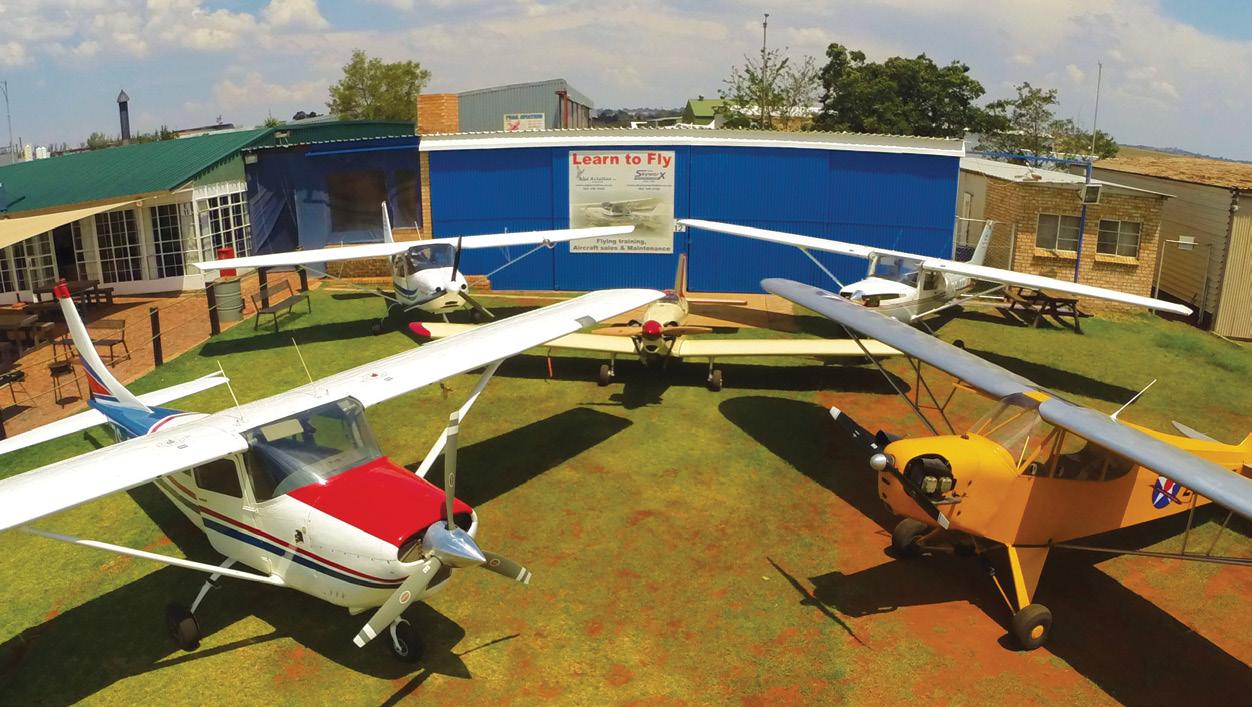
34 FlightCom: May 2023 www.alpiaviation.co.za TurbineGS Training Ab-Initio Training Single Engined Multi Engine Night Rating IF Rating Instructors Rating Simulator Training Conversions CPL Theory CPL Practical Helicopter Training Tail Draggers Pilot Shop Conferences Hire and Fly Charters Aerobatic Training Beginners/Advanced Gyro-Copter Training Microlights & Ferry Flights Accommodadtion Aircraft/Heli Sales Club Facilities Drones NAME OF SCHOOL CODE TEL NO FAX NO BEAUFORT WEST AIFA (044) 272 5547 info@aifa.co.za j j j j j j j j j j j BRAKPAN BENONI FABB Titanium Air (011) 914-5810 083-292-0978 j j j j DURBAN Starlite Aviation Training Academy (031) 571-6600 www.starliteaviation.com j j j j j j j j j j j j j j j j j j j j j j j EAST LONDON Border Aviation Club (043) 736-6181 086-516-8475 j j j j j j j j j j j j j j j GEORGE AIRPORT AIFA (044) 272 5547 info@aifa.co.za j j j j j j j j j j j Savannah Helicopter Training (044) 876-0096 j j j j j j j j j j j GRAND CENTRAL Superior Pilot Services (011) 805-0605 805-0604 j j j j j j j j j j j j j j j j j KRUGERSDORP Alpi Flight Academy (082) 556-3592 086-605-8948 j j j j j j j j j j j j j j j j j LANSERIA AIRPORT / RANDBURG Aeronav Academy (011) 701-3862 701-3873 j j j j j j j j j j j j j j Skyhawk Aviation (011) 701-2622 701-2623 j j j j j j j j j j j j j j j j MOSSEL BAY Starlite Aviation Training Academy (044) 692-0006 www.starliteaviation.com j j j j j j j j j j j j j j j j j j j j j j j PANORAMA Johannesburg Flying Academy (064) 756 6356 j j j j j j j j j j j j j PORT ELIZABETH Algoa Flying Club (041) 581-3274 086-461-7067 j j j j j j j j j j j j j j j RAND AIRPORT Johannesburg School of Flying (011) 827 9827 info@jsf.co.za j j j j j j j j j j j j j j j U Fly Training Academy (011) 824-0680 390-1738 j j j j j j j j j j j j j j j VEREENIGING AIRPORT Bird Aviation (016) 556-1007 info@birdaviation.co.za j j j j j j j j j j j j j j j j j WINDHOEK - EROS AIRPORT Desert Air (PTY) LTD +264 61 228101 +264 61 254 345 j j j j j j j j j j j WONDERBOOM AIRPORT / AEROPARK / RHINO PARK - PRETORIA Blue Chip Flight School (012) 543-3050 543-1826 j j j j j j j j j j j j j j j j j j j Loutzavia (012) 567-6775 543-1519 j j j j j j j j j j j j j j j j j j j Legend Sky (083) 860-5225 086-600-7285 j j j j j j j j j j j j j j j j j Powered Flight Training (078) 460-1231 086-666-2077 j j j j j j j j j j j j j j j j j Vortx Aviation Training (072) 480-0359 086-524-0949 j j j j j j j j j j j j j
FROM NPL THROUGH TO CPL www.balloon.co.za


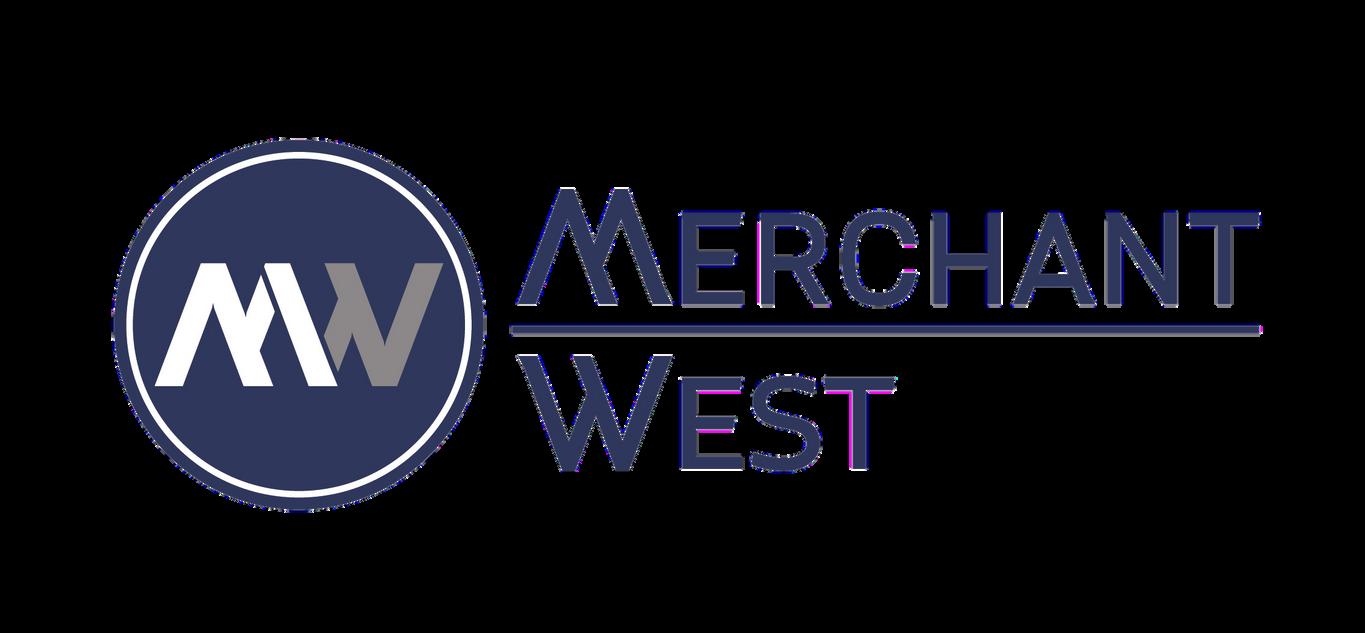
CHARTER DIRECTORY < 20 pax > 20 pax Biz-Jets V.I.P Long-Range Freight Helicopter Special Events Safari Charters Contracts Aircraft Sales Surveys Maintenance Aerial Photography Aircraft Leasing Security Based (armed) Line Inspections Lodge Transfers Export Docs & Clearing Hangarage Dangerous Goods NAME OF CHARTER CODE TEL NO FAX NO BRAKPAN FABB Titanium Air (011) 914 5810 083 292 0978 j j j j j CAPE TOWN ExecuJet South Africa (021) 934 5764 934 2087 j j j j j j j j j j j j j j j j Streamline Air Charter (011) 395 1195/8 j j j j j j j j DURBAN KZN Aviation (031) 564 6215 564 6222 j j j j j j j j j j j GRAND CENTRAL Pambele Aviation (011) 805-0652/82 805-0649 Dreams Treasury | Working Capital | Asset Management | Wealth
South Africa


Fixed Wing Helicopter Avionics Piston Engines Turbine Engines Propellers Weight / Balance Paint Interior Sheet Metal Rebuilds Overhauls Electrics NDT Testing Refurbishments Structural Repairs Inspections NTCA Aircraft Seat Belts Instruments NAME OF AMO CODE TEL NO FAX NO CAPE TOWN ExecuJet South Africa (021) 934 5764 934 2087 j j j j j j j j j j j j j j j DURBAN BAC Aviation (035) 797 3610 797 5341 j j j j j j j j j j GRAND CENTRAL AIRPORT Astwood Aircraft Electrical (011) 315 9605 315 0094 j Superior Rotorworx (076) 595 2120 j j j j j j j j j j j j j j j j j KRUGERSDORP Skyworx Aviation (082) 346 0150 086 697 9096 j j j j j j j j j j j LANSERIA AIRPORT ExecuJet South Africa (011) 516 2300 011 659 1071 j j j j j j j j j j j j j j j Gem Air (082) 905 5760 011 701 2653 j j j j j j Lanseria Aircraft Interiors (011) 659 1962 j j j j j j Plane Maintenance Facility (011) 659 2204 pmf@myconnection.co.za j j j j j j j j j j j j j SkySource International SA (011) 900 4300 j j j j j j j j j j j j j j The Propeller Shop (011) 701 3114 086 543 7988 j Tynay Aviation (082) 088 6663 011 659 1157/8 j j j j j j j j CAPE WINELANDS AIRPORT Diepkloof Aircraft Maintenance (083) 454 6366 j j j j j j j j j j j j NELSPRUIT Aircraft Maintenance International (013) 741 8221 082 787 0415 j j j j j j j j j j j j j Leading Edge Helicopters cc (013) 741 5582 741 8188 j j j j j j NEW TEMPE BLOEMFONTEIN Ferreira Aviation (051) 451 1682 451 1683 j j j j j j j j j j j OR TAMBO INTERNATIONAL AIRPORT Nevergreen Aircraft Industries (010) 003 3747 manager@nevergreen.co.za j j j Star Air Maintenance (011) 395 2201 973 4761 j j j j j j j j j RAND AIRPORT1 AMKA Aviation Pty (Ltd) (084) 710 0864 j j Aerospace Electroplating (011) 827 7535 827 9896 j j j j j j j j Aviation Rebuilders CC (011) 827 2491 lyn@aviationrebuilders.com j j j j j Clifton Electronics (011) 383 2024 086 689 5645 j j j Dynamic Propellers (082) 445 4496 086 548 2651 j j AMO LISTING AMO 1427 www.skysourcesa.com
PTY Skysource International SA, Hangar 203, Lanseria International Airport
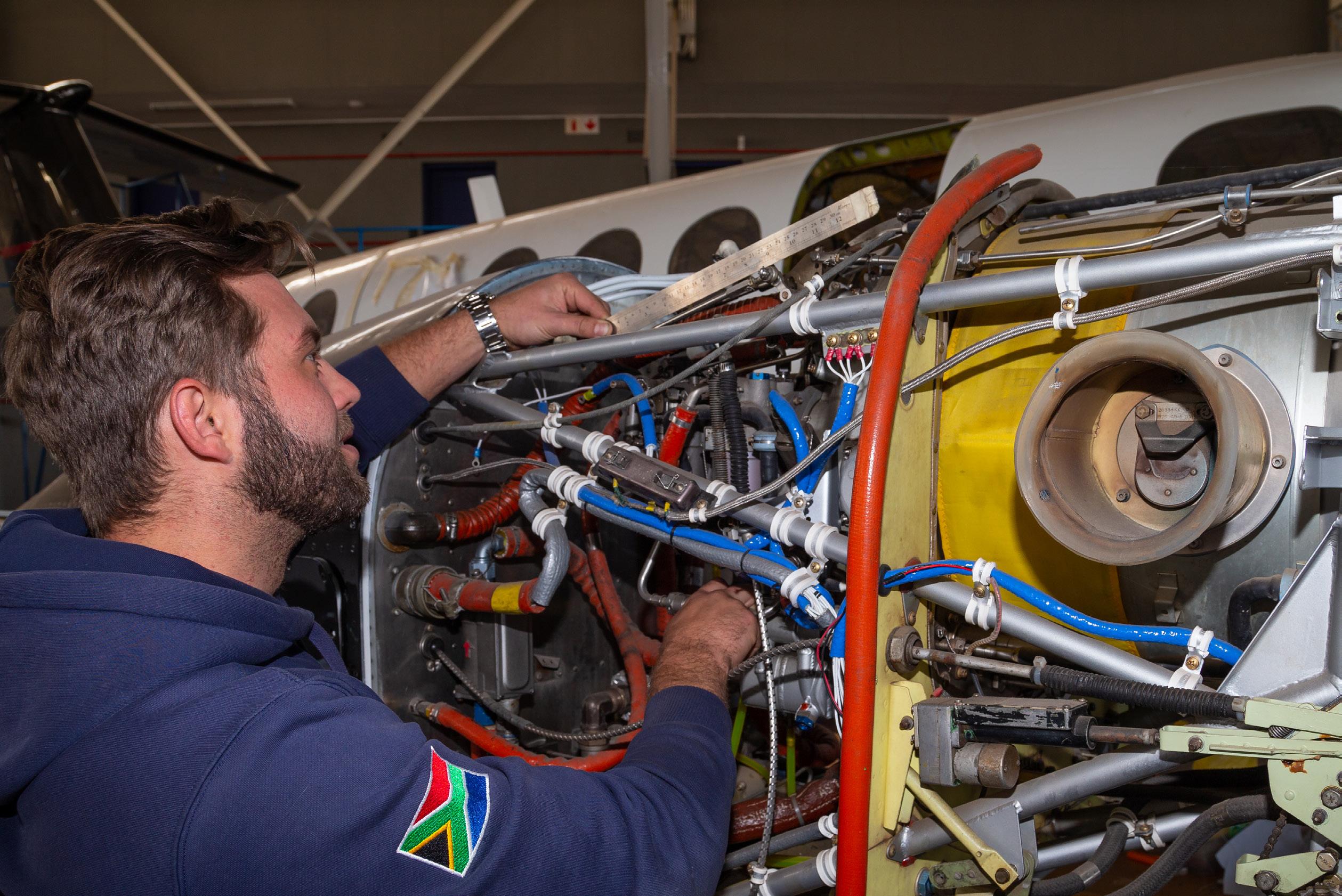
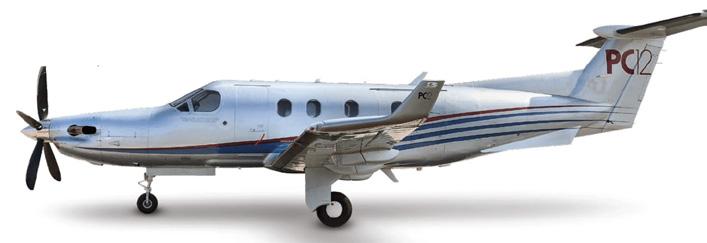
NAME OF AMO CODE TEL NO FAX NO Fixed Wing Helicopter Avionics Piston Engines Turbine Engines Propellers Weight / Balance Paint Interior Sheet Metal Rebuilds Overhauls Electrics NDT Testing Refurbishments Structural Repairs Inspections NTCA Aircraft Seat Belts Instruments Composite Manufacturing RAND AIRPORT CONTINUED Emperor Aviation (082) 497 1701 j j j j j j j j j j j j j j j FLYONICS (Pty) Ltd (082) 686 2374 michael@flyonics.co.za j j j Heli-Afrique cc (011) 827 8632 086 503 1870 j j j j j j j j j j SPRINGS AIRFIELD Legair Maintenance (083) 736 3969 086 508 6010 j j j j j j j j j j j j j j j j j WONDERBOOM AIRPORT - PRETORIA 208 Aviation 083 744 3412 j j j j j j Aerocore (012) 110 4033 082 565 2330 j j j Aircraft Maintenance @ Work Pty Ltd (012) 567 3443 j j j j j j j Aerotric (087) 802 1347 aerotric@aol.com j j j j j Aero Engineering & Powerplant (012) 543 0948 543 9447 j j AviSys Aviation Systems (083) 442 5884 086 618 6996 j j j j j APCO Pty Ltd (012) 543 0775 567 3630 j j j Breytech Aviation cc (012) 567 3500 086 643 0122 j j j j j j j j j j j j j j NIGERIA - MURTALA MUHAMMED INTERNATIONAL AIRPORT ExecuJet Aviation Nigeria Ltd +2341 295 5110 j j j j j j j j j j j j JOHANNESBURG F Gomes Upholsters (011) 614 2471 614 9806 j j j j j PRETORIA M&N Acoustics Services Pty (Ltd) AMO LISTING AIRCRAFT MAINTAINENANCE AND REFURBISHMENT QUALITY IS OUR PASSION CALL US NOW FOR ALL OF YOUR AVIATION NEEDS! info@skysourcesa.com +27 10 900 4300 • +27 72 036 3433 WE SPECIALIZE IN: Pilatus PC-12 Beechcraft 90 Series Beechcraft 200 Series Beechcraft 350 Series Beechcraft 1900D Series Cessna Caravan C208 Series Aircraft info@skysourcesa.com +27 10 900 4300 • +27 72 036 3433
BACKPAGE DIR ECT ORY
208 Aviation
Ben Esterhuizen +27 83 744 3412 ben@208aviation.co.za www.208aviation.com
A1A Flight Examiner (Loutzavia)
Jannie Loutzis 012 567 6775 / 082 416 4069 jannie@loutzavia.co.za www.loutzavia.co.za
AES (Cape Town)
Erwin Erasmus 082 494 3722 erwin@aeroelectrical.co.za www.aeroelectrical.co.za
AES (Johannesburg)
Danie van Wyk 011 701 3200 office@aeroelectrical.co.za www.aeroelectrical.co.za
Aero Engineering & PowerPlant Andre Labuschagne 012 543 0948 aeroeng@iafrica.com
Aeronav Academy
Donald O’Connor 011 701 3862 info@aeronav.co.za www.aeronav.co.za
Aeronautical Aviation
Clinton Carroll 011 659 1033 / 083 459 6279 clinton@aeronautical.co.za www.aeronautical.co.za
Aerospace Electroplating
Oliver Trollope 011 827 7535 petasus@mweb.co.za
Aerotric (Pty) Ltd
Martin den Dunnen 082 449 8895 martin@zandspruit.co.za www.zandspruit.co.za
Aerotel
Richard Small 083 488 4535 aerotric@aol.com
Aviation Rebuilders cc Lyn Jones 011 827 2491 / 082 872 4117 lyn@aviationrebuilders.com www.aviationrebuilders.com
AVIC International Flight Academy (AIFA)
Theo Erasmus 082 776 8883 rassie@aifa.co.za
Air 2000 (Pty) Ltd
Anne Gaines-Burrill 011 659 2449 - AH 082 770 2480 Fax 086 460 5501 air2000@global.co.za www.hunterssupport.com
Aircraft Finance Corporation & Leasing
Jaco Pietersen +27 [0]82 672 2262 jaco@airfincorp.co.za
Jason Seymour +27 [0]82 326 0147 jason@airfincorp.co.za www.airfincorp.co.za
Aircraft General Spares
Eric or Hayley 084 587 6414 or 067 154 2147 eric@acgs.co.za or hayley@acgs.co.za www.acgs.co.za
Aircraft Maintenance International Pine Pienaar 083 305 0605 gm@aminternational.co.za
Aircraft Maintenance International Wonderboom Thomas Nel 082 444 7996 admin@aminternational.co.za
Air Line Pilots’ Association Sonia Ferreira 011 394 5310 alpagm@iafrica.com www.alpa.co.za
Airshift Aircraft Sales Eugene du Plessis 082 800 3094 eugene@airshift.co.za www.airshift.co.za
Alclad Sheetmetal Services
Ed Knibbs 083 251 4601 ed@alclad.co.za www.alclad.co.za
Algoa Flying Club Sharon Mugridge 041 581 3274 info@algoafc.co.za www.algoafc.co.za
Alpi Aviation SA Dale De Klerk 082 556 3592 dale@alpiaviation.co.za www.alpiaviation.co.za
Apco (Ptyd) Ltd Tony/Henk + 27 12 543 0775 apcosupport@mweb.co.za www.apcosa.co.za
Atlas Aviation Lubricants Steve Cloete 011 917 4220 Fax: 011 917 2100 sales.aviation@atlasoil.co.za www.atlasaviation.co.za
AVDEX (Pty) Ltd Tania Botes 011 954 15364 info@avdex.co.za www.avdex.co.za
Aviatech Flight Academy Nico Smith 082 303 1124 viatechfakr@gmail.com www.aviatech.co.za
Aviation Direct Andrea Antel 011 465 2669 info@aviationdirect.co.za www.aviationdirect.co.za
BAC Aviation AMO 115
Micky Joss 035 797 3610 monicad@bacmaintenance.co.za
Blackhawk Africa Cisca de Lange 083 514 8532 cisca@blackhawk.aero www.blackhawk.aero
Blue Chip Flight School Henk Kraaij 012 543 3050 bluechip@bluechip-avia.co.za www.bluechipflightschool.co.za
Border Aviation Club & Flight School
Liz Gous 043 736 6181 admin@borderaviation.co.za www.borderaviation.co.za
Breytech Aviation cc 012 567 3139 Willie Breytenbach admin@breytech.co.za
Celeste Sani Pak & Inflight Products Steve Harris 011 452 2456 admin@chemline.co.za www.chemline.co.za
Cape Town Flying Club Beverley Combrink 021 934 0257 / 082 821 9013 info@capetownflyingclub.co.za www.@capetownflyingclub.co.za
Century Avionics cc Carin van Zyl 011 701 3244 sales@centuryavionics.co.za www.centuryavionics.co.za
Chemetall Wayne Claassens 011 914 2500 wayne.claassens@basf.com www.chemetall.com
Chem-Line Aviation & Celeste Products Steve Harris 011 452 2456 sales@chemline.co.za www.chemline.co.za
Clifton Electronics cc CJ Clifton / Irene Clifton 079 568 7205 / 082 926 8482 clive.iclifton@gmail.com
Comair Flight Services (Pty) Ltd Reception +27 11 540 7640/FAX: +27 11 252 9334 info@flycfs.co.za www.flycfs.co.za
Corporate-Aviators/Affordable Jet Sales Mike Helm 082 442 6239 corporate-aviators@iafrica.com www.corporate-aviators.com
C. W. Price & Co Kelvin L. Price 011 805 4720 cwp@cwprice.co.za www.cwprice.co.za
Dart Aeronautical Jaco Kelly 011 827 8204 dartaero@mweb.co.za
Dart Aircraft Electrical Mathew Joubert 011 827 0371 Dartaircraftelectrical@gmail.com www.dartaero.co.za
DJA Aviation Insurance 011 463 5550 0800Flying mail@dja-aviation.co.za www.dja-aviation.co.za
Dynamic Propellers Andries Visser 011 824 5057 082 445 4496 andries@dynamicpropeller.co.za www.dynamicpropellers.co.za
Eagle Flight Academy Mr D. J. Lubbe 082 557 6429 training@eagleflight.co.za www.eagleflight.co.za
Execujet Africa 011 516 2300 enquiries@execujet.co.za www.execujet.com
Federal Air Rachel Muir 011 395 9000 shuttle@fedair.com www.fedair.com
Ferry Flights int.inc. Michael (Mick) Schittenhelm 082 442 6239 ferryflights@ferry-flights.com www.ferry-flights.com
Fireblade Aviation 010 595 3920 info@firebladeaviation.com www.firebladeaviation.com
Flight Training College Cornell Morton 044 876 9055 ftc@flighttrainning.co.za www.flighttraining.co.za
Flight Training Services Amanda Pearce 011 805 9015/6 amanda@fts.co.za www.fts.co.za
Fly Jetstream Aviation Henk Kraaij 083 279 7853 charter@flyjetstream.co.za www.flyjetstream.co.za
Flying Unlimited Flight School (Pty) Ltd Riaan Struwig 082 653 7504 / 086 770 8376 riaan@ppg.co.za www.ppg.co.za
Flyonics (Pty) Ltd Michael Karaolis 010 109 9405 michael@flyonics.co.za www.flyonics.co.za
Gemair Andries Venter 011 701 2653 / 082 905 5760 andries@gemair.co.za
GIB Aviation Insurance Brokers Richard Turner 011 483 1212 aviation@gib.co.za www.gib.co.za
Guardian Air 011 701 3011 082 521 2394 ops@guardianair.co.za www.guardianair.co.za
Heli-Afrique cc Tino Conceicao 083 458 2172 tino.conceicao@heli-afrique.co.za
Henley Air Andre Coetzee 011 827 5503 andre@henleyair.co.za www.henleyair.co.za
Hover Dynamics Phillip Cope 074 231 2964 info@hover.co.za www.hover.co.za
Indigo Helicopters Gerhard Kleynhans 082 927 4031 / 086 528 4234 veroeschka@indigohelicopters.co.za www.indigohelicopters.co.za
IndigoSat South Africa - Aircraft Tracking Gareth Willers 08600 22 121 sales@indigosat.co.za www.indigosat.co.za
International Flight Clearances Steve Wright 076 983 1089 (24 Hrs) flightops@flyifc.co.za www.flyifc.co.za
Investment Aircraft Quinton Warne 082 806 5193 aviation@lantic.net www.investmentaircraft.com
Jabiru Aircraft Len Alford 044 876 9991 / 044 876 9993 info@jabiru.co.za www.jabiru.co.za
38 FlightCom: May 2023
Jim Davis Books
Jim Davis 072 188 6484 jim@border.co.za www.jimdavis.co.za
Joc Air T/A The Propeller Shop
Aiden O’Mahony 011 701 3114 jocprop@iafrica.com
Kishugu Aviation +27 13 741 6400 comms@kishugu.com www.kishugu.com/kishugu-aviation
Kit Planes for Africa
Stefan Coetzee 013 793 7013 info@saplanes.co.za www.saplanes.co.za
Kzn Aviation (Pty) Ltd
Melanie Jordaan 031 564 6215 mel@kznaviation.co.za www.kznaviation.co.za
Lanseria Aircraft Interiors
Francois Denton 011 659 1962 / 076 810 9751 francois@aircraftcompletions.co.za
Lanseria International Airport
Mike Christoph 011 367 0300 mikec@lanseria.co.za www.lanseria.co.za
Legend Sky 083 860 5225 / 086 600 7285 info@legendssky.co.za www.legendsky.co.za
Litson & Associates (Pty) Ltd
OGP/BARS Auditing & Advisory Services & Aviation Safety Training
Email: Phone:enquiries@litson.co.za 27 (0) 8517187 www.litson.co.za
Litson & Associates Risk Management Services (Pty) Ltd
eSMS-S™/ eTENDER/ e-REPORT / Aviation Software Systems
Email: Phone:enquiries@litson.co.za 27 (0) 8517187 www.litson.co.za
Loutzavia Aircraft Sales
Henry Miles 082 966 0911 henry@loutzavia.co.za www.loutzavia.co.za
Loutzavia Flight Training
Gerhardt Botha 012 567 6775 ops@loutzavia.co.za www.loutzavia.co.za
Loutzavia-Pilots and Planes Maria Loutzis 012 567 6775 maria@loutzavia.co.za www.pilotsnplanes.co.za
Loutzavia Rand Frans Pretorius 011 824 3804 rand@loutzavia.co.za www@loutzavia.co.za
Lowveld Aero Club Pugs Steyn 013 741 3636 Flynow@lac.co.za
Maverick Air Charters
Lourens Human 082 570 2743 ops@maverickair.co.za www.maverickair.co.za
MCC Aviation Pty Ltd Claude Oberholzer 011 701 2332 info@flymcc.co.za www.flymcc.co.za
Mistral Aviation Services Peter de Beer 083 208 7249 peter@mistral.co.za
MH Aviation Services (Pty) Ltd Marc Pienaar 011 609 0123 / 082 940 5437 customerrelations@mhaviation.co.za www.mhaviation.co.za
M and N Acoustic Services cc Martin de Beer 012 689 2007/8 calservice@mweb.co.za
Metropolitan Aviation (Pty) Ltd Gert Mouton 082 458 3736 herenbus@gmail.com
Money Aviation Angus Money 083 263 2934 angus@moneyaviation.co.za www.moneyaviation.co.za
North East Avionics
Keith Robertson +27 13 741 2986 keith@northeastavionics.co.za deborah@northeastavionics.co.za www.northeastavionics.co.za
Orsmond Aviation 058 303 5261 info@orsmondaviation.co.za www.orsmondaviation.co.za
Owenair (Pty) Ltd Clive Skinner 082 923 9580 clive.skinner@owenair.co.za www.owenwair.co.za
PFERD-South Africa (Pty) Ltd
Hannes Nortman 011 230 4000 hannes.nortman@pferd.co.za www.pferd.com
Plane Maintenance Facility Johan 083 300 3619 pmf@myconnection.co.za
Precision Aviation Services
Marnix Hulleman 012 543 0371 marnix@pasaviation.co.za www.pasaviation.co.za
Rainbow SkyReach (Pty) Ltd
Mike Gill 011 817 2298 Mike@fly-skyreach.com www.fly-skyreach.com
Rand Airport Stuart Coetzee 011 827 8884 stuart@randairport.co.za www.randairport.co.za
Dr Rudi Britz Aviation Medical Clinic Megan 066 177 7194 rudiavmed@gmail.com Wonderboom Airport
SAA Technical (SOC) Ltd
SAAT Marketing 011 978 9993 satmarketing@flysaa.com www.flysaa.com/technical
SABRE Aircraft
Richard Stubbs 083 655 0355 richardstubbs@mweb.co.za www.aircraftafrica.co.za
Savannah Helicopters De 082Jager 444 1138 / 044 873 3288 dejager@savannahhelicopters.co.za www.savannahhelicopters.co.za
Scenic Air
Christa van Wyk +264 612 492 68 windhoek@scenic-air.com www.scenic-air.com
Sheltam Aviation Durban Susan Ryan 083 505 4882 susanryan@sheltam.com www.sheltamaviation.com
Sheltam Aviation PE Brendan Booker 082 497 6565 brendanb@sheltam.com www.sheltamaviation.com
Signco (Pty Ltd)
Archie Kemp Tel 011 452 6857 Fax 086 504 5239 info@signco.zo.za www.signco.co.za
Sling Aircraft Kim Bell-Cross 011 948 9898 sales@airplanefactory.co.za www.airplanefactory.co.za
Solenta Aviation (Pty Ltd) Paul Hurst 011 707 4000 info@solenta.com www.solenta.com
Southern Energy Company (Pty) Ltd
Elke Bertram +264 8114 29958 johnnym@sec.com.na www.sec.com.na
Southern Rotorcraft cc Mr Reg Denysschen Tel no: 0219350980 sasales@rotors-r-us.com www.rotors-r-us.com
Starlite Aero Sales Klara Fouché +27 83 324 8530 / +27 31 571 6600 klaraf@starliteaviation.com www.starliteaviation.com
Starlite Aviation Operations
Trisha Andhee +27 82 660 3018/ +27 31 571 6600 trishaa@starliteaviation.com www.starliteaviation.com
Starlite Aviation Training Academy
Durban: +27 31 571 6600 Mossel Bay: +27 44 692 0006 train@starliteaviation.com www.starliteaviation.com
Status Aviation (Pty) Ltd
Richard Donian 074 587 5978 / 086 673 5266 info@statusaviation.co.za www.statusaviation.co.za
Superior Pilot Services Liana Jansen van 0118050605/2247Rensburg info@superiorair.co.za www.superiorair.co.za
The Copter Shop Bill Olmsted 082 454 8555 execheli@iafrica.com www.execheli.wixsite.com/the-coptershop-sa
Titan Helicopter Group 044 878 0453 info@titanhelicopters.com www.titanhelicopters.com
Top Flight Academy Nico Smith 082 303 1124 topflightklerksdorp@gmail.com
TPSC Dennis Byrne 011 701 3210 turboprop@wol.co.za
United Charter cc Jonathan Wolpe 083 270 8886 jonathan.wolpe@unitedcharter.co.za www.unitedcharter.co.za
United Flight Support Clinton Moodley/Jonathan Wolpe 076 813 7754 / 011 788 0813 ops@unitedflightsupported.com www.unitedflightsupport.com
Velocity Aviation Collin Pearson 011 659 2306 / 011 659 2334 collin@velocityaviation.co.za www.velocityaviation.co.za
Villa San Giovanni Luca Maiorana 012 111 8888 info@vsg.co.za www.vsg.co.za
Vortx Aviation Bredell Roux 072 480 0359 info@vortx.co.za www.vortxaviation.com
Wanafly Adrian Barry 082 493 9101 adrian@wanafly.net www.wanafly.co.za
Windhoek Flight Training Centre Thinus Dreyer 0026 40 811284 180 pilots@flywftc.com www.flywftc.com
Wings n Things Wendy Thatcher 011 701 3209 wendy@wingsnthings.co.za www.wingsnthings.co.za
Witbank Flight School Andre De Villiers 083 604 1718 andredv@lantic.net www.waaflyingclub.co.za
Wonderboom Airport Peet van Rensburg 012 567 1188/9 peet@wonderboomairport.co.za www.wonderboomairport.co.za
Zandspruit Bush & Aero Estate Martin Den Dunnen 082 449 8895 martin@zandspruit.co.za www.zandspruit.co.za
Zebula Golf Estate & SPA Reservations 014 734 7700 reception@zebula.co.za www.zebula.co.za
FlightCom: May 2023 39







































































 2019 – Cayenne Tiptronic Including Maintenance Plan, 95,000 km, White, Black Leather, R995 000
2019 – Cayenne S Tiptronic Including Maintenance Plan, 69,600 km, Carrara White Metallic, Black Leather, R1 395 000
2020 – 718 Boxster Spyder Manual Including Maintenance Plan, 6,000 km, Racing Yellow, Black Leather & Alcantara, R1 745 000
2011 – 911 Carrera GTS PDK Including Maintenance Plan, 49,500 km, Carrara White , Black Leather & Alcantara, R1 149 000
2019 – Cayenne Tiptronic Including Maintenance Plan, 95,000 km, White, Black Leather, R995 000
2019 – Cayenne S Tiptronic Including Maintenance Plan, 69,600 km, Carrara White Metallic, Black Leather, R1 395 000
2020 – 718 Boxster Spyder Manual Including Maintenance Plan, 6,000 km, Racing Yellow, Black Leather & Alcantara, R1 745 000
2011 – 911 Carrera GTS PDK Including Maintenance Plan, 49,500 km, Carrara White , Black Leather & Alcantara, R1 149 000



















































































































































































































































































































































